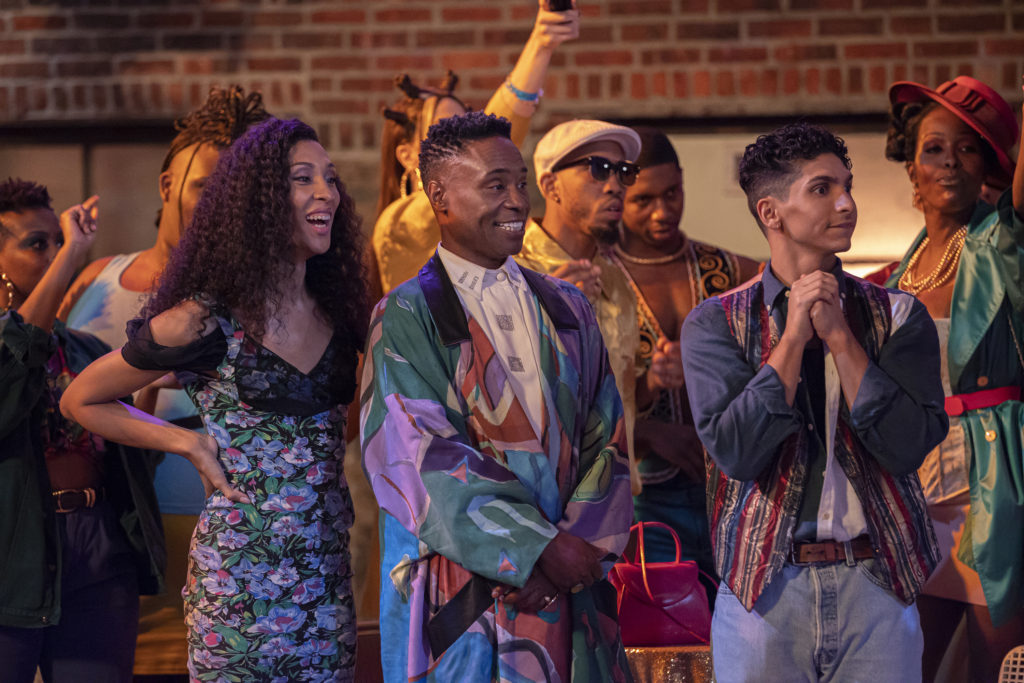Search
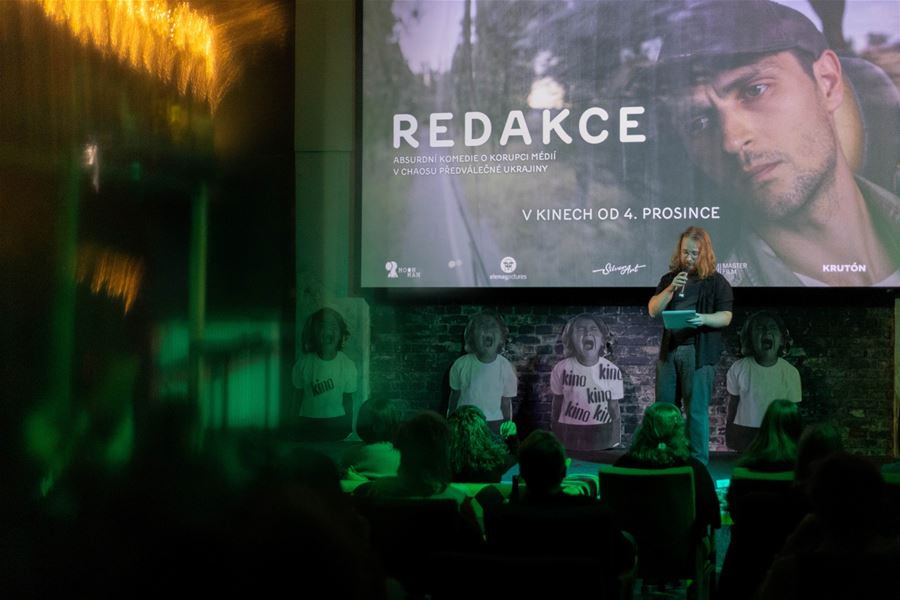
PHOTOGALLERY: Film & Brunch pre-premiere of film Redakce
The pre-premiere concluded with a discussion with Dominika Perlínová, editor of Respekt magazine, who spoke about the structure of the media environment in Ukraine, investigative journalism, and comparisons between Czech and foreign media, placing the film's themes in a real-world context based on her professional experience.
We would like to thank all viewers and look forward to seeing you at future screenings in Prague and the regions!

Submit your film to the 20th anniversary edition of the Pavel Koutecký Award 2026
PAVEL KOUTECKÝ AWARD FOR FEATURE-LENGTH DOCUMENTARY
The Pavel Koutecký Award for the first and second feature-length documentary film by a Czech director or a film produced in the Czech Republic is awarded to the director of the film and comes with a cash prize of CZK 50,000.
PAVEL KOUTECKÝ AWARD FOR SHORT DOCUMENTARY
The Pavel Koutecký Award for a short film by a Czech director or a film produced in the Czech Republic is awarded to the director of the film and comes with a cash prize of CZK 25,000.
WHEN AND WHERE?
February 9–11, 2026
Kino Kavalírka, Plzeňská 210, Prague 5
HOW TO SUBMIT YOUR FILM?
Via Filmfreeway or Google Form.
By submitting an application, the applicant confirms that they have read the Statute of the competition and agree with it.
If you have any questions, contact us at program@kinokavalirka.cz.

LOOKING FOR: Audiovisual Connect LAB Project Manager
Audiovisual Connect LAB is a European project led by the KRUTÓN association in cooperation with European partners. The project focuses on developing film literacy in Czechia and Europe. It focuses on working with data, concentrated testing of methodologies, teacher development, links with the film industry, and the implementation of a web platform.
What you will do
- Comprehensive project management in cooperation with the association's management: plan, milestones, budget in cooperation with the financial manager, cash flow, risks, reports (including documentation for the EU/Creative Europe).
- Coordination of European partners (SK, PL, HU, DE, NL, GR, UA) – regular online meetings, write-ups, agreements, monitoring of outputs.
- Implementation in CZ and SK: programming activities, production supervision, contracts, orders, accounting documentation.
- Organization of events in cooperation with production: workshops, trainings, network meetings, screenings, symposiums; logistics, production, subsequent billing.
- Administration in cooperation with the financial manager: data collection, monitoring of indicators, evaluation, archiving, grant obligations, EU publicity.
- Communication in cooperation with PR: with partners, lecturers, schools, and institutions; basic coordination of PR outputs.
- Content coordination: cooperation on methodologies and educational formats (audiovisual education). Expertise in this area is not required.
Who we are looking for
- You have experience in project management (ideally international/cultural-educational) and are able to monitor budgets and deadlines.
- You are able to write and read grant administration documents, prepare accounting documents and final reports in cooperation with the financial manager.
- You are strong in organization, independent, reliable, and able to handle multiple tasks at once.
- Languages: fluent Czech/Slovak and English (meetings, emails, minutes).
- You enjoy working with audiovisual education and are eager to connect schools, festivals, and experts.
- Plus points: experience with Creative Europe/EU projects, production of educational events, working with spreadsheets/databases.
What we offer
- Meaningful work in the Kavalírka and BOO team, professional growth.
- Cooperation for 2 years (30-40 hours/week), with the possibility of extension if both parties are satisfied.
- Access to a network of European partners, free admission to our events, and the opportunity to participate in other projects.
- A friendly team, financial remuneration commensurate with the cultural sector.
How to apply
Send your CV and a short cover letter (max. 1 page) to office@krutonfilm.cz.Please include your approximate availability (from when, how many hours per week) and a link to 1–2 relevant projects.
The selection process is ongoing. We will contact selected candidates to arrange an interview (in person at Kino Kavalírka).
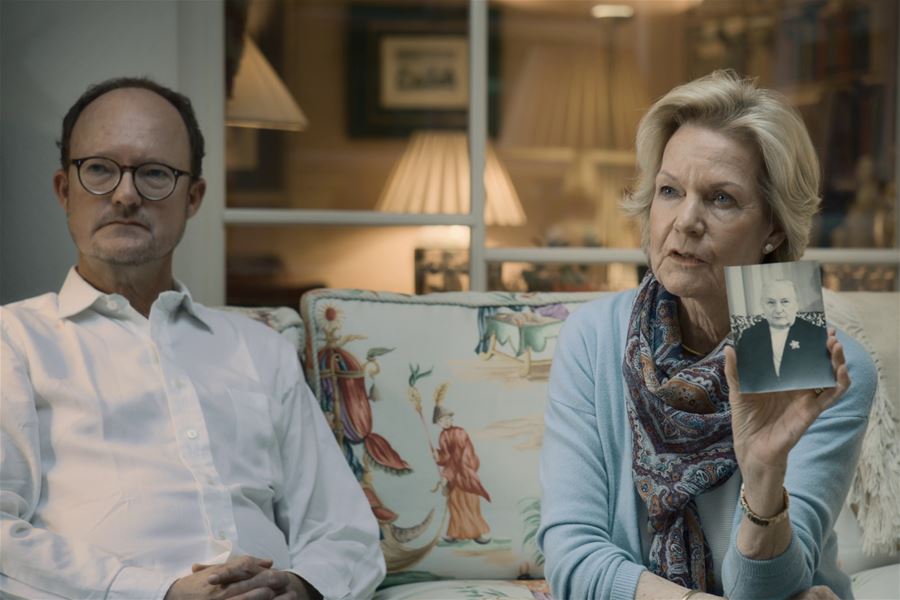
KINGDOM OF SOUP BUBBLES
The rise and fall of the entrepreneurial Schicht family, founders of the Soap with the Stag brand
The film tells the story of the legendary soap with the stag brand and its founders, the entrepreneurial Schicht family, who over the course of three generations built a major soap and food production empire in Ústí nad Labem, contributing significantly to the development of the city and the entire region. It is also the story of their descendants, who search for their roots and a relationship to a city where none of them currently live, yet together they have purchased the neo-Baroque villa of their ancestors. The film reflects Czech-German history in the Ústí nad Labem region, recalling industrial growth and the pre-war coexistence of Czechs and Germans.
directed & screenplay by: Taťána Marková camera: Petr Vejslík sound: Vojtěch Knot sound design: Vladimír Chrastil music: Petr Tichý, Anna Romanovská editing: Šárka Sklenářová dramaturgy: Rebeka Bartůňková, Ivo Bystřičan, Katja Dringenberg executive producer: Jan Bodnár produced by: Jarmila Poláková (F&S), Martina Šantavá (ČT) co-produced by: Česká televize, krutón
About the director:
Taťána Marková is the director of three documentaries produced by Film & Sociologie – Revolution Girls (2009, One World, AFO, Doc Europe III Portugal, shown on Czech Television), What to Tell the Kids? (2014, Febiofest Bratislava, shown on HBO ČR) and Libussa Unbound (2019, 8th Indian Cine Film Festival and 5th Indian World Festival Honorable Jury Mentions, shown on Czech Television).

We call him BOO. Our new film festival released its programme!
The BOO International Short Film Festival will take place for the first time this November! You can look forward to films from Berlinale, Sundance, Clermont-Ferrand, and Cannes, Oscar-winning titles, new formats, and interactive programmes.
The main part of the festival will take place from 3 to 9 November at Kino Kavalírka, MeetFactory, DOX Centre for Contemporary Art, and other venues. This will be followed by school screenings at Kino Kavalírka from November 10 to 14.
The festival programme includes an overview by day, location and type of event – from film screenings and industry meetings to accompanying formats.
The complete programme, including information on accreditation, can be found at www.boofest.cz.
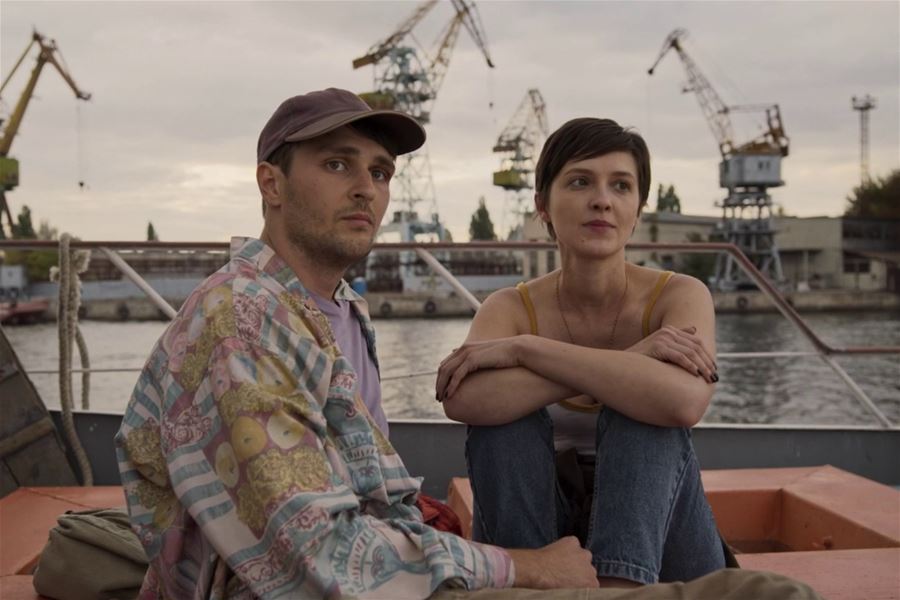
REDAKCE
After a forest is set on fire, a young scientist becomes a journalist to uncover the truth behind the flames.
directed by: Roman Bondarčuk screenplay: Roman Bondarčuk, Darja Averčenko, Alla Ťuťunnyk camera: Vadym Ilkov music: Anton Bajbakov editing: Viktor Onysko, Nikon Romančenko sound: Serhij Stepansky production: Darya Bassel (Moon Man), Darya Averčenko (South Films) co-produkce: Tanja Georgieva-Waldhauer (Elemag Pictures), Katarína Krnáčová (Silverart), Dagmar Sedláčková (MasterFilm)
About the director:
A graduate of Kyiv National University of Theater, Cinema, and Television, Roman has directed short films, documentaries, music videos and the feature film Volcano (2018), which premiered at the Karlovy Vary International Film Festival, screened at more than 50 festivals worldwide, and won 12 awards, including the Shevchenko National Prize, the highest state prize of Ukraine for works of culture and the arts. Roman’s feature-length documentary Ukrainian Sheriffs won the Special Jury Prize at International Documentary Film Festival Amsterdam (IDFA) in 2015, Grand Prix of the IDFF Docs against Gravity, and was selected as the Ukrainian submission to the Academy Awards for Best Foreign Language Film. His second documentary, Dixie Land (2016), premiered at the Full Frame Documentary Film Festival in the USA and received a Golden Duke Award for Best Ukrainian Film at the Odesa International Film Festival.
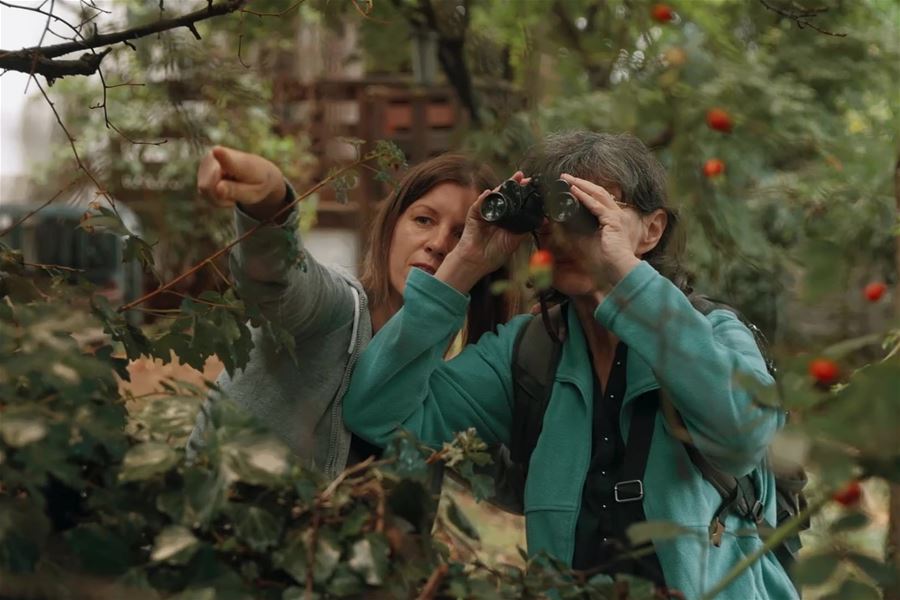
VTÁČNIK
Capitalism from a bird's perspective
Vtáčnik is a small hill on the outskirts of Bratislava, which a few decades ago was decorated with vineyards and forests. For the director, like the other locals living there, it once represented a picturesque oasis of peace where birds took refuge. Today, however, it is being transformed beyond recognition by the cranes and excavators of property developers. Told from a detailed human and bird's eye perspective, this personal documentary composes an impartial mosaic of diverse, often conflicting accounts and ideas of what life in such a place should be like. Questions about economic concerns and the pursuit of a quality life in harmony with nature collide with the author's memories of her childhood.
directed by: Eva Križková dramaturgy: Martin Gogola ml. camera: Martin Jurči music: Martin Ožvold editing: Hana Dvořáčková sound: Tobiáš Potočný production: Silvia Panáková (dayhey) creative production: Biba Bohinská co-production: Jarmila Poláková (Film & Sociology)
SCREENINGS:
About the author
Eva Križková studied film studies at the Academy of Performing Arts in Bratislava. She is the co-founder of the film magazine KINEČKO and the distribution company Filmtopia. She is currently the director of the festival One World Slovakia. In 2018, she made the short film Fight as part of the Fest Film Lab workshop in Lisbon.

Satan Kingdom Babylon ON TOUR: pre-premiers in regions
Before the film's distribution premiere on October 16, 2025, we are organizing several exclusive regional screenings across the country, where the film will be personally presented by the director duo Marie & Petr Šprincl.
At each stop, Satan Kingdom Babylon Diaries will be available for purchase – a brochure consisting of notes from director Petr Šprincl's diary containing insights and experiences from filming among the hate groups.
September 22 from 8:30 p.m. – Kino Kavalírka (Prague 5, Plzeňská 210)
There will be a welcome drink on site, and the evening will be moderated by Ladislav Čumba. The screening will be followed by a discussion with the director duo Marie & Petr Šprincl.
Tickets on sale
Facebook Event
September 24 from 6:00 p.m. – Biograf Kotva (České Budějovice, Lidická tř. 2110)
The director duo Marie & Petr Šprincl will be present at the screening.
Tickets on sale
Satan Kingdom Babylon – Tickets on sale
Moravia, O Fair Land III – Tickets on sale
Facebook Event
September 30 from 8:00 p.m. – Kino Art as part of the Brno16 festival (Brno, Cihlářská 643/19)
The director duo Marie & Petr Šprincl will be present at the screening. The screening is part of the Brno16 festival program.
Tickets on sale
The director duo Marie & Petr Šprincl will be present at the screening.
Tickets on sale
The director duo Marie & Petr Šprincl will be present at the screening.
The director duo Marie & Petr Šprincl will be present at the screening.
Tickets on sale

Check out the interviews from Visegrad Audiovisual LAB
In September, as part of the Visegrad Audiovisual LAB Online project, we created a series of video interviews with experts from the Czech Republic, Hungary, Poland, and Slovakia specializing in audiovisual education and audience development, which is also the focus of a large part of the program at the upcoming BOO International Film Festival.
The guests share their experiences with developing a relationship towards film among children, young people, and adult audiences, educational approaches that connect film, art, and digital culture, as well as how to work with audiences across generations and media.
Milan Šimánek presents how Kino Art and the BRNO16 festival work with their audiences. He shares his experiences with audience changes and ways to reach new groups–from young people to seniors–without losing regular visitors. He also presents ways of collaborating with communities and schools, the importance of accompanying events, and how to create an original and attractive cinema or festival programme that attracts both new and regular viewers.
Karolina Śmigiel talks about the LET'S DOC festival and shares her experiences with film and audiovisual education. She also presents the value of documentary films for children and young people, the challenges of engaging young audiences, and the benefits that working with film brings not only to young people but also to teachers. She describes her approach to film education, her collaboration with young audiences at the festival, and the current challenges in film education in Poland and Europe.
Nóra Lakos shares her vision for developing film culture among children and young people in Hungary as part of the Cinemira festival. She describes the differences between creating and curating films for young audiences, working with audiences, including involving children and teenagers in co-creating festival activities. She presents strategies for audience development, cooperation with schools, and the educational benefits of workshops. She also talks about the role of filmmakers in shaping a film-literate generation and what is lacking in the field of supporting films for young audiences in the Visegrad countries.
Michal Kučerák shares his vision of digital and data literacy and its connection to film and audiovisual education. He describes the use of art and curatorship to better understand the digital environment, working with young audiences, and ways to engage audiences in educational activities. He presents strategies for making digital literacy accessible and interesting, collaboration between institutions, art, and film, and the benefits of these activities for audience development. He also talks about the challenges of working with educators and institutions and the future of audience engagement in the era of algorithms, platforms, and data.
The project is co-financed by the governments of Czechia, Hungary, Poland and Slovakia through Visegrad Grants from the International Visegrad Fund. The mission of the fund is to advance ideas for sustainable regional cooperation in Central Europe.

PHOTOGALLERY: Pre-premiere of Satan Kingdom Babylon in Venuše ve Švehlovce theater
On Sunday, August 24, the director duo Marie & Petr Šprincl presented their film Satan Kingdom Babylon to a full hall at the Venuše ve Švehlovce theater.
The evening was moderated by Ladislav Čumba, who also directed the subsequent debate accompanied by a raffle. Audience members had the chance to win vouchers for mini golf, an escape room, a bar, a restaurant, or a spa.
Thank you all for a wonderful evening, and we look forward to more special screenings!

International Day of Audiovisual Education at Kino Kavalírka on August 27
In the informal atmosphere of Kino Kavalírka and its garden, we looked at the changes in the new Framework Educational Program for Primary Education, which will newly include film and audiovisual education in primary school teaching, attended a networking of festivals for children and young people, or presented various programs of audiovisual education. The special guest of the day was Slovenian director Klemen Dvornik, who, in addition to a discussion about youth films, also presented his film Block 5.
The organizer and initiator of this international event was the KRUTÓN Association and the Audiovisual HUB Prague.
International Audiovisual Education Day was also held at the Audiovisual HUBs in Jihlava and Brno, at the Andrzej Wajda Film Culture Center in Warsaw, at the National Film Institute Hungary in Budapest, and at the Úsmev Cinema in Slovakia. The project is part of the Visegrad Audiovisual LAB.
Check out the photos from the event!
The project is co-financed by the governments of Czechia, Hungary, Poland and Slovakia through Visegrad Grants from the International Visegrad Fund. The mission of the fund is to advance ideas for sustainable regional cooperation in Central Europe.
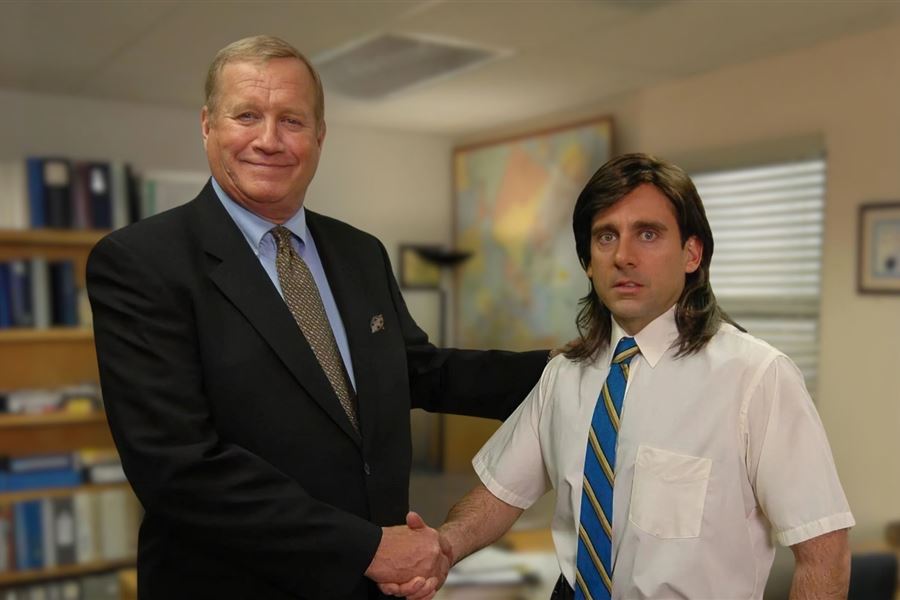
We are expanding our communications team! – Junior Social Media Manager / Creator
The KRUTÓN Association is expanding its communications team! For audiovisual education projects, film distribution, and partly also Kino Kavalírka, we are looking for someone who can communicate diverse projects in an imaginative, sometimes humorous, and occasionally slightly bizarre way.
What awaits you here:
– Managing and creating content for Facebook & Instagram.
– Taking photos and shooting videos (a cell phone is enough, but if you can also use a DSLR camera – great!)
– Creating and submitting graphics.
– Participating in the creation of plans and strategies and their subsequent evaluation.
Who are we looking for:
– You have a flair for managing social media (FB, IG).
– You know how to work in Canva and can edit simple videos.
– You are creative, have an eye for visuals, and enjoy experimenting and searching for new forms of content.
– You can switch between different communication tones depending on the target audience.
– You can organize your work and stick to a plan.
– You can work flexibly for about 10–15 hours a week at Kino Kavalírka.
What we offer:
– An atmosphere full of inspiration, great movies, humor, and nice people.
– Flexible working hours – ideal for students, freelancers, or anyone looking for a creative side job.
– The opportunity to participate in building the brand of our projects.
If you think you're the right person for the job, send us your CV and cover letter by September 12 to radovan@kinokavalirka.cz.

Jana Minaříková
About me:
I prefer TV series to movies. I have been a member of KRUTÓN since 2021. I came to work in the cultural sphere indirectly, via work in the non-profit sector and then in professional gastronomy. Filip Kršiak invited me to collaborate on the Kino Kavalírka project at the very beginning of its planning.
I started as the daily manager of Kino Kavalírka and gradually took over the entire operation. I graduated with a bachelor's degree in Historical and Literary Studies from the Faculty of Arts at the University of Pardubice.
My favorites:
Passionate mushroom hunter, flower grower, cook, lover of coffee, gastronomy, cats and long hiking trips.

Kačka Šafaříková
About me:
I graduated from the University of Economics in Prague and Film Studies in Brno, thanks to which I spent one semester at Stockholm University. I have been involved in film production since 2012, and in recent years I have participated in films such as Tonda, Slávka a kouzelné světlo and Karavan. I have been working with KRUTÓN with various breaks since its founding, and I have been in charge of finances since 2023.
My favorites:
Scandinavia, hiking, reading, I enjoy film festivals – both as a viewer and contributor, films – Lost in Translation or Eternal Sunshine of the Spotless Mind, guilty pleasure – Taylor Swift.

Radka Hoffman
About me:
My history at KRUTÓN began in 2019, when I started working as a dramaturg for Young Film Fest. I gradually made my way into the industry and held various positions. I studied radio and television dramaturgy and screenwriting at JAMU in Brno, where I am currently completing my doctorate focused on contemporary cinema for young people in a European context. I am a member of the board of the European Children's Film Association, I previously worked for the Franz Kafka Society, and as a screenwriter I have collaborated with Czech Radio, Slovak Radio and Television, Storylab Audio, and the Center for Architecture and Urban Planning in Prague.
My favorites:
The sea, dancing, apricots, walks, stories, details, films, and daydreaming.

Adéla Lachoutová
About me:
I have always enjoyed films, especially documentaries and good sci-fi feature films. However, my first contact with filmmaking happened by chance. While studying social and cultural anthropology, we had the opportunity to learn about ethnographic film and shoot several short student ethnographic films. I was thrilled by the connection between film and research.
At KRUTÓN, thanks to the leadership of the audiovisual education department, I was able to delve into the secrets of teaching film education programs for children, which opened up a whole new and inspiring world for me. What I enjoy most about art, not just film, is combining different genres and types, which film education programmes allow me to do. In the audiovisual education department, I also take care of all projects for kindergartens, elementary and secondary schools, and teacher training. Last but not least, I coordinate the Audiovisual HUB Prague, where I can once again combine research with film.
My favorites:
Fire in the stove, books, coffee. View from the window of my cottage. Theater and Zelená hora..
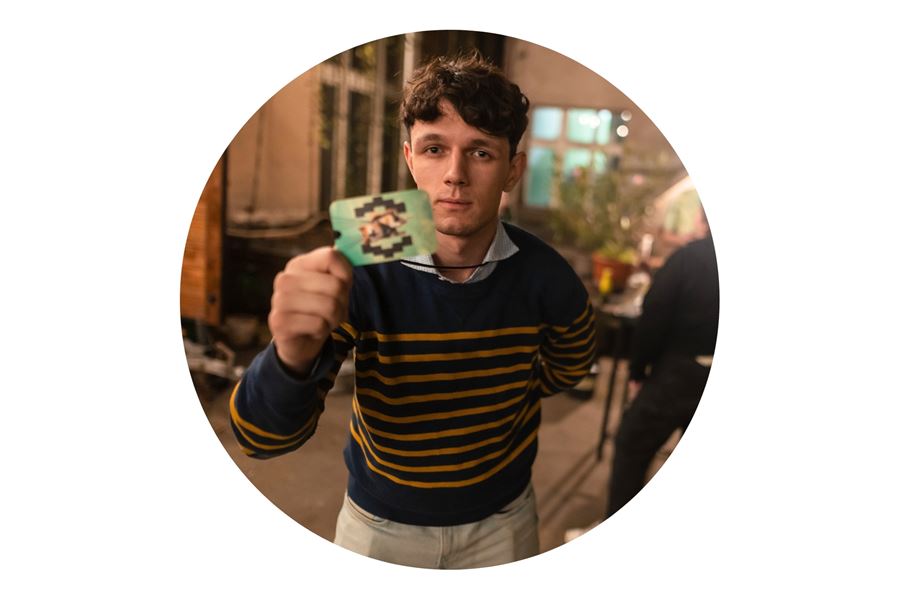
Radovan Zajíc
About me:
I am a big film enthusiast who works in film marketing and PR. I have been a member of KRUTÓN since 2023. I started as the social media manager for Kino Kavalírka and gradually began to participate in almost all of our projects. In addition, I also work in the press department of the Karlovy Vary International Film Festival. I graduated with a bachelor's degree in Arts Management from the Faculty of Business Administration at the University of Economics in Prague and am currently studying for a master's degree in Media Studies at the Faculty of Social Sciences at Charles University.
My favorites:
Hotels, collecting DVDs & CDs, tiramisu, Frank Ocean, Taiwan and Harry Potter.

Ellyn Černochová
About me:
At KRUTÓN, where I have been a member since January 2025, I take care of everything related to film distribution, primarily the educational audiovisual projects Young & Short and the international distribution project Cinemini. I participate in organizing events related to these projects, such as selection days and premieres, secure film licenses, and coordinate promotional activities. I am also gradually getting involved in the feature films we distribute, currently Satan Kingdom Babylon.
I studied Film Theory and History at Masaryk University in Brno, followed by a master's degree in Production at FAMU.
My favorites:
I love long car trips, camping, and white chocolate. I can't pick just one favorite film, but it would be something by Truffaut, Tati, Spielberg, Kubrick, or Jodorowsky.
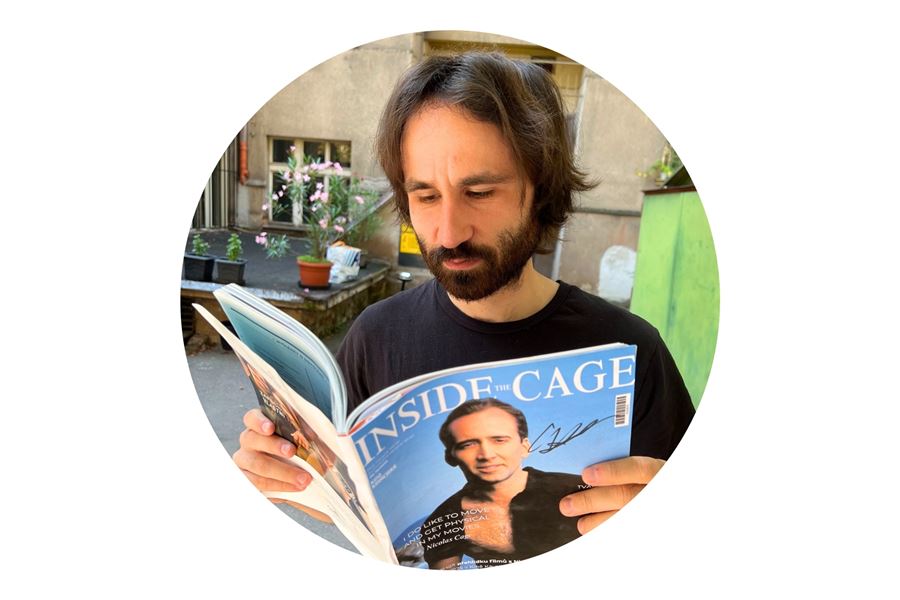
Vojtěch Novotný
About me:
I have been intensely interested in films since childhood – both as a viewer and creator. I completed two semesters of film studies at Charles University's Faculty of Arts, then studied feature film directing at FAMU. I have been involved in KRUTÓN's activities since 2020.
My favorites:
Films, football and literature.

Eliška Šimková
About me:
My interest in film began in childhood, when my parents wouldn't let me watch the Disney Channel, so I watched things like Sophie's Choice instead. I have been a member of KRUTÓN since 2024. I started as an internee at the ELBE DOCK festival, where I was in charge of the accompanying programme. I got into cultural work through volunteering at festivals and mainly thanks to my studies. I graduated in International Relations from the University of West Bohemia in Pilsen and am currently studying Production at FAMU.
My favorites:
I have too many houseplants, I like to go to the mountains with my green backpack, and my not-so-guilty pleasure is Ústí nad Labem, where I come from.

Lenka Grussmannová
About me:
I studied French philology at Charles University and the University of South Bohemia, spent almost six years in administration at the French Lycée in Prague, and then took another six years of parental leave.
My favorites:
Trips, maps and tourist signs, photography, public transport, Lieutenant Columbo, blueberries with Salko, black tea with lemon, theater for children, occasional music productions.
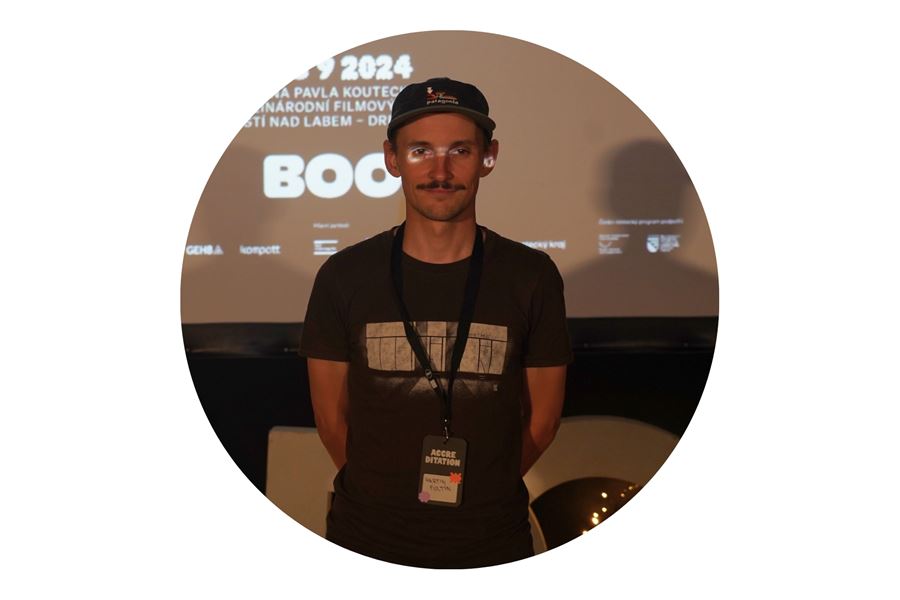
Martin Foltýn
About me:
After many years of occasional collaboration with the KRUTÓN, I accepted the challenge of becoming a full member of the team in January 2025. Since my student years, I have been straddling the worlds of IT and cultural events in the field of film festivals. After studying computer science at the University of Economics in Prague, I moved to Brno, where I earned a bachelor's degree in Theory and History of Film and Audiovisual Culture at the Faculty of Arts of Masaryk University.
My favorites:
Listening to music on the tram, at concerts, and at festivals. Trips to the countryside on foot, by bike, with a sleeping bag, for an evening campfire, to balance out the busy city life. "Kde je v tomto meste výberová káva?"

Anna Puklová
About me:
I have been attracted to films since I was a child, so I ended up working in this field, at least partially. I started at KRUTÓN in 2023 as a distribution coordinator, but it soon became clear that I preferred working with children and on projects for children. I mainly lecture the Cinemini project for young audiences. Not only for this project, I prepare materials for teaching lessons and coordinate other teachers.
I studied International Relations and Media Studies at Charles University, and I try to work in both fields.
My favorites:
I love traveling and walking in the quiet woods, but I can't imagine living anywhere other than in the city. You'll usually find me with a book in one hand and a cup of coffee in the other, or by the pool.

Jan Patzak
About me:
I have been working at KRUTÓN since the beginning of 2023 – I started as a screener, then I was involved in the technical support of festivals and gradually became a permanent member of the team. I studied Film and Television Production at SPŠ ST Panská and am currently continuing my studies at VOŠ of Journalism. I make short films, work on various audiovisual projects, and dream of a career as a film director. I also do tattoos.
My favorites:
I love metal and techno, play bass guitar, and occasionally paint. My favorite directors are Lars von Trier and Darren Aronofsky–I have a soft spot for dark, emotionally charged films with a distinctive visual style.
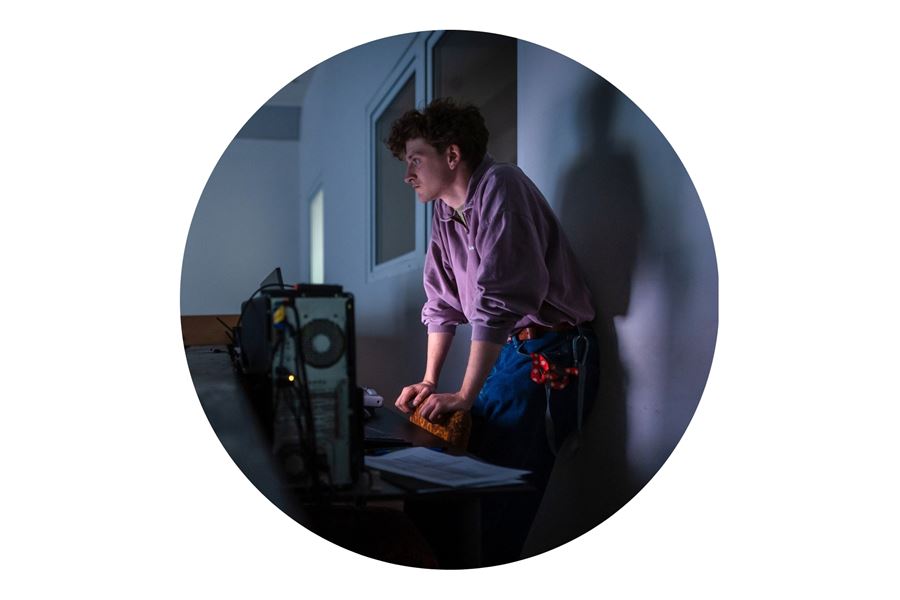
Zbyněk Neumann
About me:
I joined the KRUTÓN in the summer 2023, when I was burned out from working in a corporate café and looking for a change. At that time, I had already worked as a projectionist in another Prague cinema and missed the cinema environment. I wanted to return to it, and quite by chance, I joined through a friend, as a position in cinema operator had become available, and we managed to combine my love for films, gastronomy, and drinks.
My favorites:
Climbing a hill in my native Krkonoše Mountains and watching the stars. Taking analog photos of nature. Long debates and film analyses where I can use fancy words like prism and discourse. Impulsive midnight cooking while watching anything from Anthony Bourdain to Cooking History. Making a half-liter of filter coffee from good quality beans in the morning, drinking it on an empty stomach, and wondering why I feel heavy...

Michaela Kubátová
About me:
I graduated in humanities and am currently studying comparative literature at Charles University. I have been a member of the KRUTÓN since 2023, where I first worked as a bartender at Kino Kavalírka and after less than a year I started working as an office manager.
When it comes to the world of film, I usually prefer books to film adaptations. I tend to seek out more demanding works in books, but when it comes to film, I prefer relaxing nostalgia, which for me means romantic comedies from the turn of the millennium.
My favorites:
Antique shops and second-hand stores, tea, yoga, piano, and dogs.

Martin Novotný
About me:
I graduated in Czech literature and social sciences from the Faculty of Education at Charles University, and I am currently studying social anthropology at the Faculty of Humanities at Charles University.
I have been part of KRUTÓN since 2023, when I started working as a bartender at Kino Kavalírka. One thing led to another, and I gradually began to take care of the websites of the projects that KRUTÓN runs and the newsletters.
My favorites:
I like bizarre Czech bands, spontaneous trips, cucumbers, and dogs. My guilty pleasure in movies is spaghetti westerns.

Anna Dočkalová
About me:
I studied Czech language and literature at Charles University and am continuing my studies in the same field. I have based my personality somewhat on literature – I like to give my friends little lectures on Kafka, or I often refer to Walter Benjamin, even though I don't really understand him.
My favorites:
When it comes to movies, I love The Graduate. I also like wine and hanging out in cafés, and I enjoy traveling. When I'm not talking about literature, I like to remind everyone how brilliant David Bowie is.
A brief story about how KRUTÓN came to be
When Filip Kršiak, Tereza Bonaventurová and Pepa Vičar founded KRUTÓN in 2015, the idea was simple: to create quality programmes - camps, workshops and smaller school projects - that would develop creativity and critical thinking in children and young people through working with film.
We started without great ambition, but with great commitment. We were united by the belief that film is an extraordinary tool - it offers a space for discovery, reflection and understanding of the world around us. We have been engaged in similar activities since 2010, and the creation of KRUTÓN was a natural continuation of this journey.
Krutónpolis and the key question
In 2016-2017, we opened Krutónpolis, a pop-up space for film education and a meeting place for film professionals in Prague's Vinohrady district, which lasted just over a year.
At the same time, we have been working on alternative distribution of European films, building a network of colleagues and started asking ourselves a fundamental question:
"Will KRUTÓN remain a small association or can it become a platform with a real impact?"
The decision was not an easy one - there was a lack of facilities, stable finances and it required personal sacrifices.
Friends asked us at the time, "Are you really going to make a living off rolls to do programs for kids?"
No one could imagine the future then. But as it happens with us, we decided to take the (most) difficult path - and started systematically building a professional and organizational foundation.
Tereza has since become a curator, Pepa a doctor - but both remain founding members and important advisors of the association.
What has changed since then?
- We created and ran the International Film Festival for Children and Youth Young Film Fest (Prague).
- We co-created the ELBE DOCK International Short Film Festival (Ústí nad Labem, Dresden).
- In 2025 we merged these two festivals into the BOO International Film Festival.
- Since 2021, we have been running the intimate boutique cinema Kavalírka.
- We participate in European projects and initiate our own - including systemic programmes aimed at long-term change in the field of audiovisual education.
- And much more...
KRUTÓN nowadays
Today, KRUTÓN is built on a solid team of experts who lead the various areas - from pedagogy, dramaturgy and industry programmes to international cooperation.
The key figures are Jana Minaříková, Executive Director, and Radka Hoffman, who develops international projects and relations with European partners. Our internal team, consisting of 15 colleagues and dozens of collaborators from all over the Czech Republic and Europe, also plays a crucial role.
Get to know OUR TEAM.
What remains
We have grown from a small initiative into an open platform that connects pedagogy, culture, research and practice - and offers new models of collaboration in the field of audiovisual education.
KRUTÓN continues to learn, transform and find new ways - rarely the simplest ones, often the ones that present real challenges.
And one thing remains: we always work for children, students, audiences, educators, professionals and audiovisual - with real commitment and an undying passion for the cause.

SATAN KINGDOM BABYLON
An experimental documentary by Petr and Marie Šprincl delves into the darkest corners of America’s hate-fueled subcultures, confronting the viewer with a visceral, sensory experience. Through a haunting mosaic of raw footage and interviews with cult leaders, the story follows a fictional detective investigating the disappearance of a young woman in a post-apocalyptic hotel. His search leads him deep into the world of the Ku Klux Klan, ultra-Orthodox Jews, Black Hebrews, and other religious movements of Trump’s America. The end is here.
directed by: Marie & Petr Šprincl screenplay: Marie Šprincl camera: Jan Vidlička music: Wojciech
Kucharczyk produced by: Marek Novák, Xova Film
About the directors
Marie & Petr Šprincl began their artistic collaboration during their studies at Václav Stratil's Intermedia Studio at the Faculty of Fine Arts in Brno. Today, they are a highly distinctive creative duo with a very characteristic style. Their work is characterized by unsettling poetics, drawing on the dark side of reality and working with 8mm film material or VHS tape, where the typical characteristics of the recording material, especially visual errors usually caused by wear and tear or structural damage, are objectified, aestheticized, and even fetishized. The audiovisual aspect of their work is usually complemented by rich iconography that transcends the medium of the moving image, which is given space for presentation within their creative platform Flesh&Brain. Their work balances on the border between fiction, documentary, and experiment, with a common feature being the exploration of various social forms of evil, often hidden beneath the thin veneer of everyday reality. They are the authors of the trilogy Moravia, O Fair Land (2015–2019), Vienna Calling (2018), or the current film Satan Kingdom Babylon (2024). In addition to films, they also work on music videos, theater performances, and gallery installations.
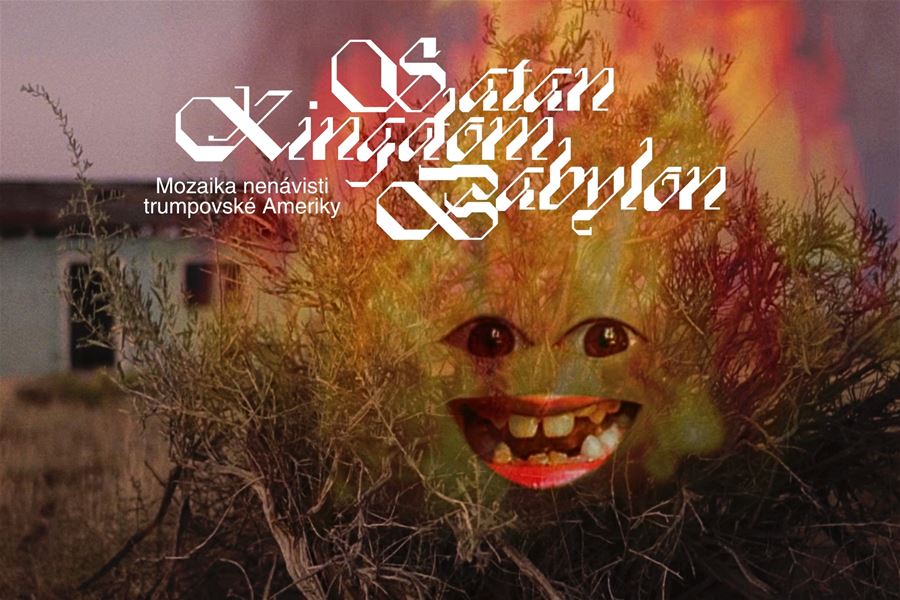
Satan Kingdom Babylon is Coming! Attend the Pre-premiere of New Experimental Documentary.
On Sunday, August 24, at 7 p.m., the unique Venuše ve Švehlovce theater will host a pre-premiere of Marie & Petr Šprincl's film Satan Kingdom Babylon.
An experimental documentary by Petr and Marie Šprincl delves into the darkest corners of America’s hate-fueled subcultures, confronting the viewer with a visceral, sensory experience. Through a haunting mosaic of raw footage and interviews with cult leaders, the story follows a fictional detective investigating the disappearance of a young woman in a post-apocalyptic hotel. His search leads him deep into the world of the Ku Klux Klan, ultra-Orthodox Jews, Black Hebrews, and other religious movements of Trump’s America. The end is here.
The gloomy atmosphere of the film will be complemented by the rondocubist interior of the historic theater hall. The screening will be accompanied by a discussion with the filmmakers, who spent two months among hateful groups in North America while shooting the film.
The evening will conclude with a raffle hosted by Ladislav Čumba. The prizes will vary and will not be related to the mood of the film. They will range from raw meat to mini golf vouchers.
🗓️ When: Sunday, August 24, 2025, at 7 p.m.
📍 Where: Venuše ve Švehlovce (Slavíkova 22, Praha 3)
🖇️ Follow the event on Facebook
About the directors
Marie & Petr Šprincl began collaborating as artists during their studies at Václav Stratil's Intermedia Studio at the Faculty of Fine Arts in Brno, and today they are a highly distinctive creative duo with a very characteristic style. Their work is characterized by unsettling poetics, drawing on the dark side of reality and working with 8mm film material or VHS equipment, where the typical characteristics of the recording material, especially image defects usually caused by wear and tear or structural damage, are objectified, aestheticized, and even fetishized. The audiovisual aspect of their work is usually complemented by rich iconography that transcends the medium of the moving image, which is given space for presentation within the Flesh&Brain creative platform. Their work balances on the border between fiction, documentary, and experiment, with a common feature being the exploration of various social forms of evil, often hidden beneath the thin veneer of everyday reality. They are the authors of the trilogy Moravia, Oh Fair Land (2015–2019), Vienna Calling (2018), or the current film Satan Kingdom Babylon (2024). In addition to films, they also work on music videos, theater performances, and gallery installations.

Cinetots in cinemas across the whole Czech Republic
And what makes our Cinetots selection so unique? First and foremost, because the films were selected by young film enthusiasts themselves! We have only selected films that have been successful at prestigious film festivals in recent years and then left the choice entirely up to our audience. This ensures that the line-up consists of films that really engage and entertain the audience and that we reflect current trends.
However, Cinetots is not just a selection of short films. We have also prepared worksheets that offer specially designed activities for each film, working with children's creativity and imagination to further deepen the experience of the film and help to place it in a wider educational context.
More information about the Cinetots, including free downloadable worksheets, can be found HERE.
Watch the documentary-making workshop with Barbora Chalupová
On 22 February 2025, an intensive half-day workshop for primary and secondary school teachers on the topic of genres in documentary film took place at the Kino Kavalírka. The workshop was led by Barbora Chalupová, co-director of the film Caought In the Net.
In addition to the theoretical preparation, the participating female teachers also tried to make their own short documentary film about the Kino Kavalírka within various documentary genres. Film posters were also created for each mini-documentary. The workshop ended with a reflection on the whole process and a screening of the films.
Film Academy: teach (with) film is part of the EU-funded international project FilmED which aims to promote audiovisual and film education in Central and Eastern Europe.

We are looking for a school projection coordinator and producer
Coordinator and producer of school screenings
Scope: a min of 0,5 time
Main task: coordination and organisation of school screenings for kindergartens, primary and secondary schools and production activities in the Audiovisual Department of the Kino Kavalírka
- communication with schools - teachers, principals, educational staff and school psychologists
- organisation of school screenings
- organisation of accompanying discussions, workshops and other activities
- co-creation of the film programme for schools
- taking care of established cooperation and establishing new contacts
- taking care of the film catalogue
- cooperation with internal and external lecturers
- cooperation on the promotion of school screenings
- production of school screenings
- participation in the programmes of the Audiovisual Education Department in other events (festivals, international events, etc.)
Advantage:
- orientation in film education or art education
- active interest in film and audiovisual culture
- good relationship with teachers, children and young people of all ages
- orientation in Czech education
- diligence and excellent communication skills
- openness to further education
Are you interested? Contact Adéla Lachoutová at edukace@krutonfilm.cz.

We also keep in mind the youngest CINETOTS: Young & Short 2025
For the first time ever, we have prepared a series of films for the youngest viewers aged 4 and up as part of the Young & Short project. The films were selected by young film jurors aged from 4 to 7 with the help of experienced lecturers. This ensures that Cinetots is not just a selection of films that caught the attention of jurors at international film festivals (Berlinale, Annecy, ECFA Award, DOK Leipzig, Clermont-Ferrand, etc.), but that they accurately reflect what young viewers enjoy and are interested in.
The program is suitable for families with children aged 4 and up, kindergartens, and all enthusiasts of children's and animated films.
For kindergartens and other educational institutions, we have also prepared worksheets that offer a wide range of creative activities for each film and provide methodological support for working with children's audiovisual experiences. In addition, we also organize interactive workshops and discussions at Kino Kavalírka. If you are interested, please write to us at edukace@krutonfilm.cz.
So what films can you look forward to? A Lynx in the Town shows what it's like when playfulness and curiosity collide with the "adult" world, where everyone just stares apathetically at their mobile phone screens, while Mr. Night Has a Day Off playfully depicts the changing parts of the day. Pond takes us on an underwater adventure, Black and White shows on cartoon sheep how far prejudice can take us, The Kite sensitively deals with the theme of the passing of a loved one, Hoofs on Skates teaches us that appearances can often be deceiving, and Fruits of Clouds depicts a story full of friendship and bravery.
Everything about the program, including the films, can be found HERE.

Exploring Hidden Worlds and bridging The Abyss: Young & Short 2025
The Hidden World programme was created by the young jurors themselves, aged 12 to 14. What was the main theme for them and why is the band called this? The common denominator of all the films is that they focus on exploring worlds that normally escape our eye. Either because of how distant they are to us, or simply because we don't think to look at things around us from a different angle.
The young jury has thus selected the most interesting short films that contemporary cinema has to offer and which have been successful across prestigious film festivals. The film A Body Called Life links the exploration of microscopic organisms with self-discovery, the colourful On the 8th Day develops environmental themes, Swimming with Wings gives a glimpse into the lives of Dutch migrant children through novel animation, Girls Move Mountains captures the incredible courage of Pakistani girls in their struggle for emancipation, and Touching Darkness through a special animation technique gives an insight into the lives of children with disabilities.
The Abyss strip is reflecting period of turbulent life changes at the turn of childhood and adulthood, when the teenage person gets to know themselves, but at the same time often faces the most difficult challenges of life so far and for the first time fully confronts existential questions. Young people aged 15 to 19 helped us to create the entire series, choosing from films that have attracted the attention of juries at leading festivals around the world (Berlinale, Clermont-Ferrand, Ottawa, as well as Oscar nominations, etc.).
The series thus reflects the theme of overcoming these imaginary life chasms, whether it is racial hatred shown in Butterfly, existential anxiety in Wander to Wonder, coping with the passing of loved ones in Phoenix, the self-discovering journey in Blood and Flowers, or the devastating effects of war depicted in I Died in Irpin.
The strips can be used as a whole, or you can create individual strips from the films based on their thematic focus, as well as combine them with strips from previous years (What If? and Carousel of Emotions).

DEADLINE for submission of visual identity proposals postponed to May 30
GRAPHICS TASKS
- festival poster
- mascot design - any kind of cow or ghost
- post on Instagram (the type of post is up to you, it can be a reveal of some part of the program, introduction of the creator or a guest of the festival, teaser to the festival site...)
- non-traditional format of your choice - it can be an interactive element, merch design, motion graphics, physical object, spatial installation or other creative way of visual communication of the festival
OPEN CALL PROCESS
- The deadline for submission of proposals is postponed to 30 May 2025.
- We will meet personally with the author of the selected proposal to discuss the terms of cooperation.
- The author of the selected proposal will receive a reward of 25.000 CZK for the delivery of the final concept and all necessary documents.
- Other participants will not be honoured.
- We reserve the right not to select any of the proposals if none of them corresponds to our ideas.
Please send your proposals to: julie@boofest.cz.
The full detailed specification and all information can be found HERE.

Invitation to the Speed Networking of Audiovisual Education
What can you expect?
- Quick and effective meetings in short blocks ("speed dating")
- Sharing of best approaches, challenges and ideas for collaboration
- Space for networking
- The event is free and open to all who want to develop audiovisual education together and are looking for partners for future projects, teaching or sharing experiences.
📅 When: May 15
📍 Where: Audiovisual HUB in Kino Kavalírka (Plzeňská 210, Prague 5)
🕓Time: 3:00 pm - 5:00 pm (+ aditional space for further networking after the event)
📝 Advance registration required. Please e-mail us on: edukace@krutonfilm.cz by May 12, 12:00 p.m.
💬 Come network - briefly, intensely and meaningfully.
We look forward to seeing you!

OPEN CALL for visual identity concept for BOO IFF
BOO FESTIVAL AND WHO IS BEHIND IT
The BOO International Short Film Festival was created through the transformation of the ELBE DOCK International Film Festival and the Young Film Fest International Film Festival for Children and Youth. The festival focuses on short cinema, audience development and audiovisual education. The first edition will be held in November 2025 in Prague and will take place in several venues, such as the Kino Kavalírka.
The association krutón is behind projects such as Young Film Fest, Young & Short, Kino Kavalírka or Cinemini - a film programme for children aged 4 and up. All of our activities are united by an emphasis on quality, cultural and social overlap, and a desire to bring film closer as a tool for knowledge, sharing and entertainment. We support non-profit projects that change the way we see the world through film, film education and audiovisual culture. Our projects are characterized by playfulness, unique humor and a desire to reach audiences of all generations.
As part of this open call, we are looking for a graphic designer or graphic artist who will conceptualize the visual identity of the festival - i.e. create the main graphic style, including mascots, logotype, color scheme and typography - while delivering easy-to-understand deliverables, templates and handouts for our in-house graphic designer to work with. He will take care of the concrete application of the visual across all outputs during the preparation and the festival itself.
GRAPHICS TASKS
- festival poster
- mascot design - any kind of cow or ghost
- post on Instagram (the type of post is up to you, it can be a reveal of some part of the program, introduction of the creator or a guest of the festival, teaser to the festival site...)
- non-traditional format of your choice - it can be an interactive element, merch design, motion graphics, physical object, spatial installation or other creative way of visual communication of the festival
OPEN CALL PROCESS
- The deadline for submission of proposals is 18 May 2025 (extended to 30 May).
- We will meet personally with the author of the selected proposal to discuss the terms of cooperation.
- The author of the selected proposal will receive a reward of 25.000 CZK for the delivery of the final concept and all necessary documents.
- Other participants will not be honoured.
- We reserve the right not to select any of the proposals if none of them corresponds to our ideas.
Please send your proposals to: julie@boofest.cz.
VISUAL IDENTITY CONCEPTUAL MEASUREMENT
Key Elements:
- We want the visual identity of the festival to include a mascot that reflects the name BOO. We are considering two options - a cow or a ghost, or creatively combining them into one element. The mascot should be a distinctive but not primary symbol of the festival.
Another key element of the visual is the festival logo, which should serve as a unifying element across communications. It already exists in its basic form, but its shape and colour scheme is not finalised, so we are open to new suggestions, modifications and original interpretation within the overall visual concept.
VISUAL IDENTITY APPLICATION
The visual identity of the festival will primarily focus on the online environment and digital marketing. Graphic communication on social media and other digital platforms will play a key role.
We also want the visual to be consistent across print and electronic materials such as:
- tickets and accreditation
- posters and printed materials
- social media graphics (posts, stories, reels)
It is important that the visual style unifies all these formats and creates a coherent visual impression of the BOO Festival.
Target groups:
The BOO Festival appeals to a wide range of audiences across generations - from 3 to 99 years old. Therefore, we want the visual identity to be universal enough to appeal to different age groups.
At the same time, we are considering the possibility of creating multiple variations of the visual identity that would be:
- Linked by a single element to keep the festival visually cohesive.
- Personalised for individual target groups, if it will be meaningful.
We leave the decision whether to differentiate the visuals to the graphic designers.
WHAT DO WE WANT TO AVOID?
Predictability
- We don't want the visual to look too generic or clichéd.
- Although we work with a cow or ghost, we still want the visual to be original and surprising.
Unintentional associations
- It's important to avoid visual similarities with well-known brands such as Milka or dating app Boo.

Cinemini on Czech Radio
Cinemini is a globally unique film education project for children aged 3 to 6, which will be implemented in our Kino Kavalírka from mid-2023. It is a combination of short, unconventionally conceived films and specially developed activities that will stimulate children's imagination and enhance their experience of the film. In a fun and meaningful way, we explore the world of film and audiovisual with children, developing their creativity, critical thinking and positive relationship to film from an early age.
Are you interested in what this looks like in practice? Listen to the report on the Czech Radio or visit the Cinemini project website.
Child Protection Policy - KRUTÓN
1. Introduction and values
The Krutón Association, as an organization operating in the field of audiovisual education and cultural education for children and young people, is committed to protecting children from all forms of violence, abuse, neglect, and other inappropriate treatment. The Child Protection Policy (hereinafter referred to as the "Policy") defines the principles, rules, and procedures that ensure a safe environment in all activities of the Krutón Association, especially in direct and indirect work with children.
The Policy is in accordance with the Convention on the Rights of the Child (Sb. z. č. 104/1991), the Charter of Fundamental Rights and Freedoms, the Act on Social and Legal Protection of Children (Sb. z. č. 359/1999 Sb.) and the general principles of the GDPR.
The krutón association promotes an approach based on the dignity of the child, their right to be heard, respected, and protected. The principles set out in this Policy are binding for all employees, associates, lecturers, volunteers, temporary workers, and external contractors who come into contact with children during the association's activities.
2. Definitions
Child:
A child is considered to be any human being under the age of 18, unless they have reached the age of majority earlier under the legal system.
Child protection:
A set of preventive and intervention measures and procedures aimed at ensuring the safety, dignity, and healthy development of children and preventing their abuse, neglect, or other endangerment.
Direct contact:
Physical presence at activities where there is interaction with a child (e.g., leading a workshop, discussion, filming, training, mentoring).
Indirect contact:
Mediated contact with a child through media, email, forms, photographs, or access to their personal data.
Child abuse:
Any intentional or unintentional behavior that may cause harm to a child's health, dignity, or development. It is divided into:
- physical (hitting, choking, burning, etc.),
- psychological (humiliation, intimidation, isolation, coercion),
- sexual (any sexual contact or proposition that a child cannot understand or give informed consent to),
- neglect (long-term neglect of care, nutrition, safety, and support).
Risk situation:
Any activity, environment, or relationship that could potentially expose a child to the above forms of harm.
3. Unacceptable behavior
When working with children, it is strictly prohibited to:
- engage in any form of physical, psychological, or sexual violence,
- treat children in a disrespectful, mocking, or humiliating manner,
- establish personal or private relationships with children outside the scope of professional contact,
- photographing or filming children without the express and informed consent of their legal representative,
- sharing or otherwise misusing children's personal data without authorization,
- leaving a child alone without adult supervision,
- exploiting imbalances of power or trust for personal gain,
- give children alcohol, addictive substances, or medication without medical indication,
- be alone with a child in a closed space without the presence of another adult or without
- ensuring that the interaction can be observed (e.g., open doors, visibility from the hallway, etc.).
4. Safe recruitment of employees and protection of personal data
4.1 Selection and verification of employees
Every person (employee, instructor, volunteer, external contractor) who participates in the activities of the krutón association and has direct or indirect contact with children must:
- sign a declaration of integrity (or provide a criminal record extract if required by the nature of the cooperation),
- sign a commitment to comply with this Policy and the Code of Conduct of the krutón association,
- undergo a personal interview to verify their knowledge of child protection principles,
- be familiar with the procedures for reporting incidents and suspected abuse.
The selection process is transparent and emphasizes the candidate's experience, competence, and values in relation to working with children.
4.2 Personal data protection (GDPR)
The Krutón Association protects the personal data of children and their legal guardians in
accordance with EU Regulation 2016/679 (GDPR). The organization:
- ensures that only designated persons handle children's personal data,
- obtains informed consent from parents or legal guardians for the processing of data, photographs, or audiovisual recordings,
- stores data in a secure manner (both electronically and physically),
- shares personal data only when required by law or when necessary to ensure the safety of the child.
5. Training and education
5.1 Initial training
Every new employee, instructor, volunteer, or other collaborator with direct or indirect contact with children must complete training on the following before starting work:
- the principles and objectives of the Child Protection Policy,
- recognizing forms of abuse and neglect,
- safe communication and interaction with children,
- the code of conduct of the Krutón association,
- procedures in case of suspected child safety violations (including the practical use of forms and reporting schemes).
5.2 Regular awareness-raising and refresher training
- Long-term collaborators shall undergo refresher training at least every two years.
- In the event of changes in legislation or updates to the Policy, special training will be provided to all affected persons.
- Internal trainers or the responsible person (see section 7) keep records of the persons trained and the dates of the training.
6. Revision of the document
This Child Protection Policy is subject to regular review to ensure that it remains up to date and is implemented effectively.
- Regular reviews of the Policy take place at least every three years, or sooner if there are changes in the law, significant events or incidents that require a change in procedure.
- The Child Protection Officer (see section 7) is responsible for the review in cooperation with the management of the krutón association.
- All employees, lecturers, volunteers, and partners affected by the change will be informed of the review and its results.
7. Responsible person – Child Protection Officer (CPO)
The person appointed by the association's management – the Child Protection Officer – is responsible for the implementation, training, monitoring, and evaluation of compliance with the Policy.
Responsibilities of the responsible person:
- ensures the training of new and existing employees,
- serves as the main contact person for consultation and reporting of suspicions or incidents,
- processes and archives reports of child safety violations,
- initiates reviews of the Policy and proposes amendments,
- actively monitors compliance with the rules and culture of safety within the krutón association,
- is listed in all places where contact with children occurs, including the organization's website.
The contact details of the responsible person will be publicly available online and at the venues where activities take place.
8. Procedures for reporting, complaints, and incident resolution
8.1 Duty to report
Every employee, instructor, volunteer, or external collaborator has a duty to immediately report any suspicion of abuse, inappropriate behavior, violation of rules, or other threat to a child.
Reports shall be submitted:
- to the person responsible for child protection,
- or the association's management if the responsible person is suspected of misconduct.
8.2 Forms of reporting
- Verbal reports must be immediately followed up with a written incident report form.
- The Policy includes a clear procedure diagram (algorithm) on how to proceed in such situations (Appendix 1).
- All documents are kept confidential, secure, and in accordance with the GDPR.
8.3 External protection systems
In serious situations or if a criminal offense is suspected:
- the organization is required to inform the relevant authorities (OSPOD, Czech Police),
- it may be recommended to contact the Safety Line, crisis centers, or other specialized services.
Emphasis is always placed on the best interests of the child, their safety, and trust.
9. Cooperation with external actors
The Krutón Association is part of a wider network of entities involved in child protection. If necessary, it cooperates with the following institutions:
- Social and Legal Protection of Children Authority (OSPOD)
- Czech Police
- Crisis centers and helplines (e.g., Safety Line 116 111, White Circle of Safety)
- Schools, school counseling facilities
- Non-governmental organizations focused on prevention and assistance to children
In the event of serious suspicion that a child is at risk, the organization will actively cooperate with the relevant authorities, provide the necessary information, and strive to protect the child as quickly and effectively as possible.
The association also seeks partnerships for training, methodological development, and prevention of risky behavior with organizations that share the values of children's rights.
10. Availability of the document
10.1 Public access
This Policy will be:
- published in full on the Krutón Association website,
- available in printed form at all locations where activities with children take place,
- included in the introductory information package for new employees, lecturers, and volunteers.
10.2 Child friendly version
The krutón association will create a simplified and visually appealing version of the document for children and young people, which will:
- explains their rights, how to protect themselves, and who to turn to,
- be available in print and online,
- be presented to children at the beginning of each longer activity or program.
In this way, the association ensures that children not only have a protected environment, but also access to information and the confidence to express their concerns or suggestions.
Form for reporting suspected child protection violations, adapted for the krutón association and including the name of the responsible person:
📝 ANNEX 1: RECORD OF SUSPECTED CHILD PROTECTION VIOLATIONS
This form is used for internal recording of suspected threats to the safety or rights of children within the activities of the krutón association. The completed form must be forwarded immediately to the person responsible for child protection.
1. INFORMATION ABOUT THE PERSON MAKING THE REPORT
(name, position in the association, contact details – email or telephone)
.........................................................................................
.........................................................................................
2. DATE AND TIME OF THE RECORDED EVENT / SUSPICION
Date: .......................................................
Time: ...........................................................
3. PLACE OF THE EVENT (if known)
.........................................................................................
4. DESCRIPTION OF THE EVENT / SUSPICION
(what happened, what was said or observed – as specifically as possible, without speculation)
..............................................................................................................................
..............................................................................................................................
..............................................................................................................................
5. WHO WAS PRESENT AT THE EVENT / WITNESSES
(names, positions – if known)
.........................................................................................
.........................................................................................
6. STEPS ALREADY TAKEN
(e.g. contacting parents, calming the situation, taking the child to safety, etc.)
.........................................................................................
.........................................................................................
7. RECOMMENDATIONS / SUGGESTIONS FOR FURTHER ACTION (optional)
.........................................................................................
.........................................................................................
8. SIGNATURE OF THE PERSON MAKING THE REPORT
.............................................................
(name and date)
THIS FORM WILL BE DELIVERED TO AND KEPT BY THE PERSON RESPONSIBLE FOR CHILD PROTECTION:
Jana Minaříková, Executive Director of the Krutón Association (jana@krutonfilm.cz)
BINDING DECLARATION OF ACKNOWLEDGEMENT OF THE CHILD PROTECTION POLICY
Krutón Association – organization for audiovisual education and upbringing of children
I, the undersigned, hereby declare that:
- I have been familiarized with the document Child Protection Policy – krutón association and have thoroughly familiarized myself with its contents.
- I understand the rules and principles set out in the Policy, including the Code of Conduct, the definition of inappropriate behavior, and the procedure to follow in case of suspected child safety violations.
- I agree to follow all the rules and principles set out in the Child Protection Policy and will always act in the best interests of the children.
- I agree to cooperate with the responsible person, especially if there is a suspicion of child endangerment or other risky behavior.
- I solemnly declare that I have not been convicted of any criminal offense against a child or of any offense related to sexual freedom, violence, or child neglect.
- I agree that, if necessary, I will provide an extract from the Criminal Register or other proof of good character if required by the nature of my cooperation with the krutón association.
Date: .................................................
Full name: .............................................................
Position / Role in the krutón association:: .................................................
Signature: .............................................................
I confirm that I have signed this document voluntarily and truthfully.
This record is kept and archived by the person responsible for child protection:
Jana Minaříková, Executive Director of the krutón association
I HAVE THE RIGHT TO BE SAFE
Information for children and young participants in krutón association activities
📌 Your rights
When participating in krutón association activities (e.g., workshops, filming, screenings, or
games), you have the right to:
- feel safe,
- be respected and listened to,
- speak up if something makes you uncomfortable,
- be protected from bullying, harm, or humiliation.
❗ What is inappropriate behavior?
If someone behaves in the following ways, it is not okay:
- shouts at you or ridicules you,
- wants to be alone with you and you don't want to be alone with them,
- touches you in a way that makes you feel uncomfortable,
- does not want to let you go home or prevents you from contacting your parents,
- tells you not to tell anyone about something.
🗣️ What can you do if something makes you feel uncomfortable?
- Tell an adult you trust – for example, a leader or instructor.
- If you are afraid or unable to do so, write a message or ask a friend to accompany
you.
👩💼 Who you can contact directly:
Jana Minaříková
Child Protection Officer
📧 jana@krutonfilm.cz
❤️ Remember:
💬 Your opinion matters.
🙋 If something is wrong, you can speak up.
🛡️ Everyone has the right to be safe – including you.

Prague Audiovisual HUB opened
Audiovisual education is one of the most dynamically developing trends in contemporary education. According to a Safer Kids Online survey, almost two-fifths of teenagers spend between 4 and 9 hours a day on audiovisual content. One of the concrete steps to respond to this trend is the opening of the Audiovisual HUB in the Kino Kavalírka in Prague, which was established in pilot mode on 1 August 2024 and is now opening up to a wider professional and pedagogical community and joining the emerging network of regional HUBs across the Czech Republic.
The Audiovisual HUB will serve as a centre for methodological support, research, teacher training, examples of good practice and advocacy. In connection with the newly prepared Framework Educational Programmes, it will assist schools in introducing new forms of media and cultural literacy into teaching - in addition to music and art education, it will also now include film, drama and dance.
Behind the creation of the Audiovisual HUB is the association krutón, which runs the Kino Kavalírka, distributes short films for children and youth, implements the international educational projects Cinemini and FilmED, and is the organiser of the new BOO International Film Festival. The Audiovisual HUB is the result of two years of research into foreign approaches and methodologies, taking inspiration from, for example, the Dutch Film HUB network.
"We spent two years researching models of good practice abroad. We have created a place that is dedicated not only to film, but also to broader audiovisual education - from short films to video games to testing methodologies. The HUB will also serve as a contact and methodological centre for educators and experts from Prague," says Filip Kršiak, chairman of the krutón association.
Jana Minaříková, executive director of the krutón association, adds: “The HUB in Prague is primarily a place of cooperation and search for systemic solutions - we translate and adapt foreign methodologies, share examples of good practice, provide advice to schools and establish partnerships with representatives of the film and video game industry.”
The project has a strong international dimension thanks to Radka Hoffman, Head of International Relations and Industry Programmes at krutón, who has been newly elected to the board of the European Children's Film Association (ECFA), Europe's most prestigious children's film organisation. Her task is now to actively connect Czech and European actors in the field of film and audiovisual education and to create a space for joint projects, sharing experiences and mutual inspiration.
The opening of the HUB is part of a broader strategy for the development of film and audiovisual education coordinated by the Association for Film and Audiovisual Education. The project was created in partnership with the krutón association and the Documentary Film Centre in Jihlava and was supported by the Ministry of Culture of the Czech Republic. The Minister of Culture Martin Baxa signed a memorandum of cooperation with the Association for Film and Audiovisual Education, which enables further systematic development of audiovisual education across regions and institutions and its deeper embedding in the education system. In addition to Prague, other HUBs are currently being established in Jihlava and Brno.

Kino Kavalírka cinema
Prague's one-screen boutique cinema with a unique atmosphere and comfortable retro armchairs five minutes by tram from Anděl metro station.
The Na Zámečnici cinema was established in the 1930s and closed down in the early '90s. In 2021, our association krutón, z.s. managed to revive the cinema, and since 2022 it has been open all year round. We have renamed the cinema to Kino Kavalírka , referring to the former film studios in Kavalírka.
The programme includes contemporary film news, special screenings combining films with a gastronomic experience or creation (FILM & DRINK, FILM & DEGUSTATION, FILM & CRAFT), bizarres and internet phenomena, as well as thematic film cycles, showcases and film festivals. Even the youngest ones will find something to do here, for whom, in addition to the standard distribution screenings, we also organise a regular CINEMINI club. We also offer our Young & Short film education programmes for kindergartens, primary and secondary schools.
The cinema also has a bar with a wide range of gins from Czech distilleries, alcoholic and non-alcoholic drinks made from quality ingredients, non-alcoholic beers, but you can also enjoy draft beer specials, wines from Czech winemakers or the best Czech cidre. In the summer months, the bar moves outside to the courtyard garden, where you can relax in the shade of full-grown chestnut trees. You can have a drink just like that or take it with you to the cinema to watch a movie.
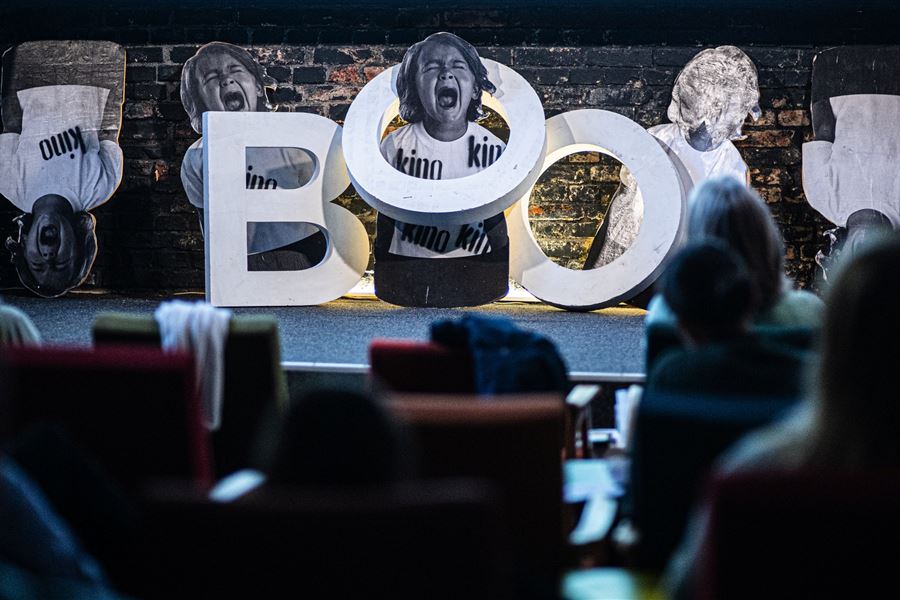
BOO International Short Film Festival
More about the BOO IFF can be found HERE.
The BOO International Short Film Festival was created by merging two International Film Festivals ELBE DOCK and Young Film Fest and its first year will take place from 3 to 9 November 2025 in Prague.
The festival's dramaturgy is based on a selection of films from the most prestigious film festivals (Cannes, Venice, Locarno, Clermont-Ferrand, Berlinale, Sundance, Toronto, Oscar nominations), but also gives space to emerging talents. In addition, the industry programme will also play an important role, focusing on short films and audiovisual education.
You can look forward to a total of six competition categories in which contemporary short films will compete. The two main competition categories are the pan-European and Czech-German sections, which follow the tradition of the ELBE DOCK festival, in which the Czech-German programme had a special place alongside the pan-European programme. In addition to these two categories, films can also compete in the categories for children aged 3 years and older, two categories for young people (12-14 and 15-19 years), as well as in the category of films for seniors.
What makes BOO different from other film festivals? First of all, its approach to the audience, which tries to involve them as much as possible and actively lead them to an open dialogue, while also placing great emphasis on the peer-to-peer method, which consists in sharing experiences between members of the same age or professional group.
Another thing in which BOO excels is its industry program, where it will bring a rich industry program focused on short film. And most importantly, a pan-European program focusing on audiovisual education and best practice examples from abroad. So you can look forward to a wide range of topics from the worlds of audiovisual education and short film, presented by leading experts from all over Europe.
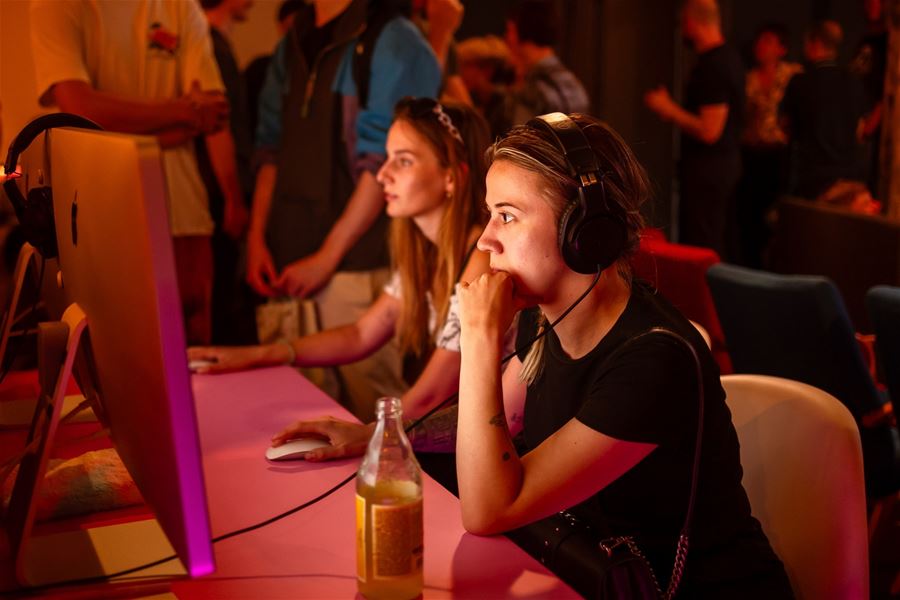
KRUTÓN LAB
KRUTÓN LAB is a living ecosystem: we explore new methods and formats, test them directly with students and teachers, share our know-how with cultural institutions, and engage creators and experts. We work with data to better understand the needs of audiences and the professional sphere, and contribute to systemic changes in the field of audiovisual literacy.
What does KRUTÓN LAB encompass?
- Audiovisual Centre (2021–2025) – support for professionals, formerly known by the longer name Centre for Innovation and Cultivation of the Audiovisual Environment
- Audiovisual HUB (from 2024) – a project to support teachers and infrastructure in the field of film education
- Visegrad Audiovisual LAB – international cooperation within the V4 countries. The project includes the key International Day of Audiovisual Education.
- FilmED (2024–2025) – European project for the development of methodology for teachers and cultural workers
- Audiovisual Connect LAB (2026–2027) – European project exploring literacy, linking education with professional practice.
Our goals
- To develop film and audiovisual literacy among children, young people, and adults;
- to support teachers, creators, cinema operators, festivals, and cultural professionals;
- to bring European film and audiovisual content into schools and public spaces;
- to create a sustainable model of education and professional cooperation based on research and data.

Cinemini
Cinemini is a globally unique project that was originally created in 2019 in the Netherlands and Germany and which we brought to the Czech Republic in 2023. The project deals with film and audiovisual education for preschool children aged 3 - 6 years.
What to imagine by this? Our lecturers will show several short films to the children, which represent a variety of cultures and approaches to film. After each screening, the children share together, under the guidance of the tutor, the feelings, impressions and thoughts that the film has evoked in them. The discussion is then followed by activities that have been prepared specifically for each film to further enhance the experience of the film.
And why is this so important? Children today come into intense contact with audiovisual content on a daily basis from an early age, so it is important that they learn to think critically about it and to name the feelings it evokes in them. Moreover, the pre-school age is a time when children, thanks to their unique imagination, perceive audiovisual stimuli very intensely and in a very different way from later in life, and this age is therefore crucial for the development of their imagination and fantasy.
We organize screenings for kindergartens and first grade all over the country and also in our Kino Kavalírka cinema, where we also organize a regular child club for the public from February 2025. If you are interested in school screenings or registering for a club, please contact us at edukace@krutonfilm.cz.

Audiovisual Centre
About the project
In 2021, we established the Center for Innovation and Cultivation of the Audiovisual Environment, which operated under this name until 2022 and was supported by the EEA and Norway Grants. In 2023, the name was shortened to Audiovisual Center.
It is a platform that offers film and video game professionals, critics, and the public guidance in the ever-changing audiovisual industry. Workshops, lectures, industry brunches, and conferences are held here.
The Audiovisual Center focuses on connecting the film and video game industries, strengthening networks, associations, and platforms, supporting women and marginalized groups in the industry, short film production, debuts, production for children and youth, and audiovisual education (films, new media, video games).
The Audiovisual Center at Kino Kavalírka is a place for reflection on the latest trends and phenomena in audiovisual media and for generating discussion. It is a platform that offers professionals, critics, and the public guidance in the ever-changing discourse of the audiovisual industry. The aim is to create a collective awareness of connections and cultivated feedback within all sectors of the audiovisual industry, whether it be communication between producers and creators, critics, cinemas (including galleries and video game institutions) and distributors, or between individual interest groups.
Current program
November 29, 2025
SUMMONING GAME DESIGN: INDIE GAME SHOWCASE
December 9, 2025
INDUSTRY NETWORKING: ASSOCIATION IN AUDIOVISION
Recently held
November 7, 2025
APA: WHERE HAVE THE VIEWERS DISAPPEARED TO? (BOO IFF)
November 3-7, 2025
WORKSHOP: HOW TO WRITE ABOUT SHORT FILMS (BOO IFF)
November 6, 2025
INTIMACY IN FILM (BOO IFF)
November 6, 2025
CASE STUDY: MONYOVÁ (BOO IFF)
November 6, 2025
SPEED NETWORKING (BOO IFF)
History of Audiovisual Center events
At the AV Center, we have successfully organized several networking meetings. Industry Night for representatives of a wide range of associations and platforms in the Czech audiovisual industry, who had the opportunity to present their current projects and future challenges. As part of Industry Night, we focused on data collection and evaluation and wellbeing in the Czech film industry.
Other types of networking events, lectures, and seminars were created thanks to cooperation with platforms such as film-animation-theory, Girls in Film, Association of Cinema Operators, New Cinema, Association for Film and Audiovisual Education or the international project FilmED. For the latter, we organized a workshop as part of the first official meeting of the project partners (Goethe-Institut, Wajda Film Centre, krutón, National Film Institute - Film Archive Hungary, Kino Úsmev, and Kinoteka North Macedonia).
In collaboration with the Pitch podcast, a live recording took place with sales agent Daniel Vadocký, Deputy Minister of Culture Michal Šašek, and Heleen Rouw, then director of Cinekid, the largest film and media festival for children in Amsterdam.
In the past, the AV Center's program also included informal industry brunches focused on specific audiovisual topics, such as television dramaturgy, experimental film, the sustainability of film festivals, contemporary TV production, and sales. Guests included Tomáš Feřtek, Michal Reitler, Michaela Čajková, Tereza Nvotová, Julie Marková Žáčková, and Dagmar Sedláčková.
The Audiovisual Center has also long been dedicated to the topic of women's representation in audiovisual media. Tereza Czesany Dvořáková presented the pilot results of a study by the Association of Audiovisual Producers focused on the position of women in the Czech film industry. Subsequently, together with the Carl Data Company research team, they presented the final presentation of a follow-up three-year research project on the representation and attitudes of women in key film professions in Czech feature films. Gilles Fontaine (Head of the Department for Market Information, European Audiovisual Observatory) also participated in the program, presenting a long-term mapping of the situation of female filmmakers in Europe.
In cooperation with Young Film Fest, we presented the current reality of the film industry in Ukraine. We focused on how it is possible to keep the industry running during the war and what role women play in it. The guest of the discussion was Sasha Prokopenko, film dramaturge and program director of the International Short Film Festival in Kiev.
The Audiovisual Center also hosted several film festival industry programs, such as Das FilmFest, which focused on the female perspective on the film industry in German-speaking countries. The main guests included Heleen Gerritsen (goEast – Festival of Central and Eastern European Film), Marija Milovanovic (LEMONADE FILMS, Vienna Shorts, Berlinale Generation), Nicole Biermeier (First Hand Films), and Fiona Ziegler (screenwriter and director).
Other festival collaborations included a case study of the film Rituals with producer Martina Netíková and film publicist Pavel Sladký at the FOFR festival, and the ELBE DOCK – FILM INN industry program at the IFF, which included workshops for aspiring screenwriters and producers from the V4 countries, masterclasses, round-table discussions, and networking. Guests of the program included: Nicoló Galio (Alphapanda, TorinoFilmLab Audience Design Fund), Anne Gensior, Alexandra Gramatke (Kurzfilm Agentur Hamburg), Hrönn Marinósdóttir (Reykjavik International Film Festival), Birgitte Weinberger (OFF - Odense International Film Festival), Liisa Nurmela (Göteborg International Film Festival), Gudrun Sommer (DOXS RUHR), Rebekka Garrido (Manderley Films), Dagmar Sedláčková (Masterfilm, Girls in Film) and Tereza Czesany Dvořáková (FAMU).
An important event organized by the AV Center in cooperation with Young Film Fest was the International Forum for Audiovisual Education – the largest industry program focused on audiovisual education in the Czech Republic, which provided a space for networking among key European players.
Guests of the program: Heleen Rouw (Cinekid Festival), Samira Jakobi (Deutsches Filminstitut & Filmmuseum), Anne Schultka (KIDS Regio), Lisbeth Juhl Sibessen (Danish Film Institute), Eveline van Stuijvenberg (Film Education Network in the Netherlands & Filmhub Zuid-Holland), Amelie Jennequin (Quai10), Emese Erdös (National Film Institute – Film Archive, Hungary), Karolina Śmigiel (Andrzej Wajda Film Culture Center), Karin Spišáková (Kino Úsmev), Šimon Bauer (Documentary Film Center), Martin Peroutka (Aeroškola), and Tomáš Machek (Sladovna Písek).
At the Audiovisual Center, we have also been focusing on videogames for a long time, as evidenced by the Summoning Game Design series. As part of regular lectures and showcases, personalities from the field of indie game design were introduced, along with games by students from FAMU, VOŠ Scholastika, and independent developers. During the Young Film Fest, the Summoning Game Design program focused on the use of video games in education, with the participation of an international guest from the video game department of the Quai10 cinema in Charleroi, Belgium. The AV Center also organized final exams for students of the Department of Game Design at FAMU.
We also regularly organize workshops for students of FAMU and the Department of Film Studies at Charles University, focusing on topics such as sales and distribution (Daniel Vadocký), the history and methodology of computer games (in collaboration with the Game Archive), and the creation of lecturer introductions to films (David Havas and Viktor Licek).
Since 2025, we have been expanding our activities to include regular Speed Networking events, which we organize in cooperation with Girls in Film, for example. These meetings serve as a space for quick and effective networking between filmmakers across professions. The aim is to promote new collaborations and the sharing of contacts and experiences in a friendly and informal atmosphere.
Audiovisual Center Coordinator: Eliška Šimková – eliska@krutonfilm.cz
The operator is bujón s.r.o. in cooperation with the krutón, z.s.
The project is supported by the Ministry of Culture of the Czech Republic.
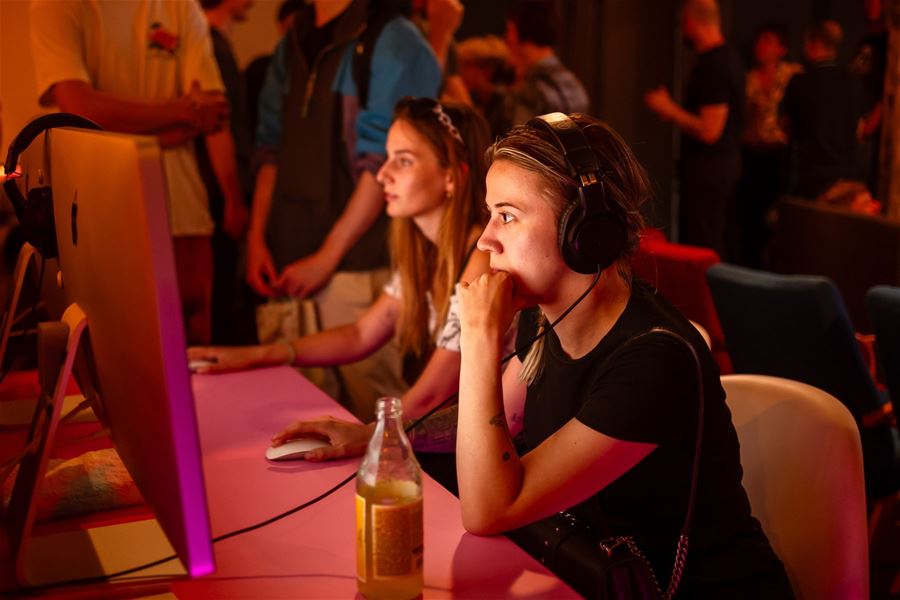
Audiovisual HUB
Audiovisual education is one of the world's most important trends, reflecting the enormous impact of audiovisual on children and young people and society as a whole. The development of critical thinking, aesthetic perception, diversity of opinion, the transmission of experience, but also resistance to elements of manipulation and the promotion of democratic processes, as well as new possibilities for personal expression and creativity, are absolutely essential for the future of society as a whole.
That is why the Audiovisual HUB was created in Kino Kavalírka for teachers, representatives of organisations, school principals and all others concerned with audiovisual education.
Audiovisual HUB Prague provides:
- Access to foreign methodologies,
- Examples of good practice in the Czech Republic and abroad (experts, lecturers, foreign teachers),
- Promotion of the concept of regional HUBs,
- Wider information about the project for founders, teachers, principals, schools in the region,
- Audiovisual workshops,
- Contact centre for methodological support for teachers,
- Formatting lessons for children, students and teachers.
The operation of the Audiovisual HUB is part of a wider network of Audiovisual HUBs, which are part of the strategic development of film education, under the auspices of the Association for Film and Audiovisual Education, in cooperation with the Documentary Film Centre in Jihlava. The project is supported by the Ministry of Culture of the Czech Republic.
Other audiovisual education projects in Prague and the Czech Republic can be found in the interactive map.
If you are interested in cooperation or consultation, please contact the Head of the Audiovisual Education Department and HUB Coordinator Adela Lachoutová via e-mail edukace@krutonfilm.cz.
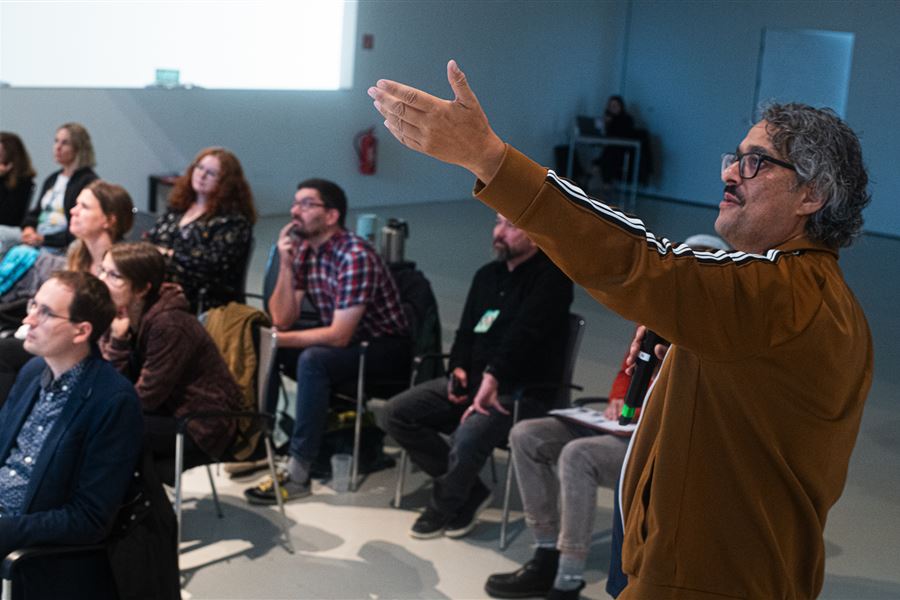
FilmED
FilmED (Film Education for All) is an international project supported by the European Union to encourage audiovisual and film education in Central and Eastern Europe and to make it accessible to educators, cultural and educational organisations, and through them to children and young people who encounter audiovisual works at every turn.
Audiovisual and film education is one of the most important and necessary global trends of today. It reflects the enormous impact of the omnipresent audiovisual world on children, youth and society. It teaches us to understand it, to grasp the intentions of its creators and to look at it critically. It increases resistance to the elements of manipulation and develops creativity, aesthetic perception and democratic debate.
FilmED supports audiovisual and film education on two levels. The first level focuses on teaching the art, technique and history of filmmaking with an emphasis on cinematography, editing, directing, producing and scriptwriting. The second level focuses on education and training that uses film to understand social and political issues and to develop critical thinking skills.
The FilmED project aims to develop practical educational and training tools that fill a gap in film education within the school curriculum. These tools can be used by educators, teachers and educational organisations or institutions. Through the project, we also want to reach students in Central and South-Eastern Europe, broaden their knowledge of European cinema and enable their deeper understanding of the social and political context, as well as encourage cultural exchange and promote European values.
Between 2024 and 2025, in cooperation with Czech and international partners from Poland, the Czech Republic, Slovakia, Hungary and Northern Macedonia, we are analysing and bringing together the best existing European methodologies for film education and creating our own methodologies for working with films that teachers can implement in their daily practice. To support this effort, an interactive website is being developed to collect the forthcoming materials and to provide practical support and advice to all interested parties. At the same time, we are implementing our own film education activities for all those interested in audiovisual and film education who want to teach (with) film, experience or directly start with film and audiovisual education.
Funded by the European Union. Views and opinions expressed are however those of the author(s) only and do not necessarily reflect those of the European Union or the European Education and Culture Executive Agency (EACEA). Neither the European Union nor EACEA can be held responsible for them.
Within the framework of FilmED we organize the Film Academy: Teach (with) Film for educators, filmmaking workshops for children and youth, meetings of foreign and Czech educators and experts on the topic of film and audiovisual education and many other activities.
PROJECT PARTNERS:
Goethe-Institut e.V. (Czech Republic)
krutón, z. s. (Czech Republic)
Centrum Kultury Filmovej im Andrzeja Wajdy (Poland)
National Film Institute Hungary (Hungary)
National Institution Cinematheque Of Republic Of North Macedonia (North Macedonia)
Kino Úsmev (Slovakia)
FilmED is supported by the Creative Europe.
Funded by the European Union. Views and opinions expressed are however those of the author(s) only and do not necessarily reflect those of the European Union or the European Education and Culture Executive Agency (EACEA). Neither the European Union nor EACEA can be held responsible for them.
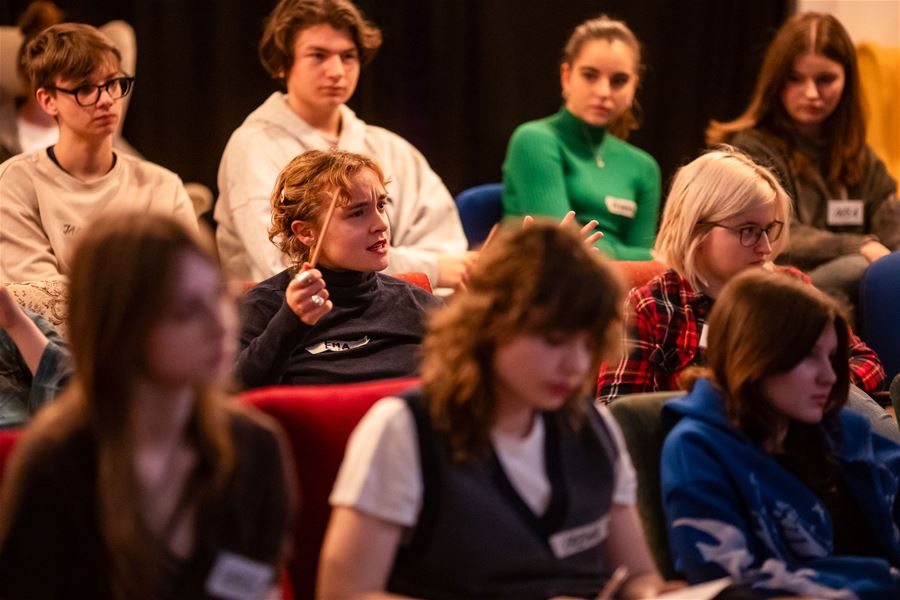
Young & Short
Young & Short is a distribution film series that characterizes its generation. It is a collection of short films depicting themes that are important to young people and that they enjoy.
Each year, young people in the 12-14 and 15-19 age categories select films not just for their peers. They will represent their generation with five short films selected from the best that European short cinema for young people has to offer. We then distribute the Young & Short series to Czech cinemas and schools, offering them not only a quality film experience, but also a specially created programme with lecturers' introductions, discussions, interesting guests or workshops.
Contemporary cinema for young people is quite difficult to reach its target audience - individual films are usually only sporadically presented at film festivals and often do not even make it into mainstream cinema distribution, especially in the Czech environment, for various reasons.
With its format, the Young & Short project tries to disrupt this tendency. It will present the best festival shorts to young viewers in a weekend programme and, after expertly guided discussions, let them decide which films they want to include in Czech distribution.
Young & Short confronts the traditional concept of cinemas and gives young people the opportunity to become an active part of the Czech film environment. The series is put together by young jurors who have been selected on the basis of their motivation, their relationship to film and their proven ability to think about and reflect on film in a complex way. This results in a unique film strand that responds to a contemporary world dominated by audiovisual content, the quality and selection of which is otherwise generally not influenced by young people.
The aim of the project is to bring to young audiences short films selected from the most prestigious European film festivals - such as Cannes, the Venice International Film Festival, Sundance, Berlinale or the Clermont-Ferrand International Short Film Festival. We complement the top European short cinema with prominent Czech film representatives. All this across genres, cultures and film approaches.
Thanks to this, we are able to develop critical and aesthetic thinking in young people in an unconventional and entertaining way. At the same time, we give them the opportunity to inspire each other with their opinions and attitudes on a peer level.
For 2024, we have created the bands WHAT IF? and CAROUSEL OF EMOTIONS and for 2025 the bands CINETOTS, HIDDEN WORLD and THE ABYSS.
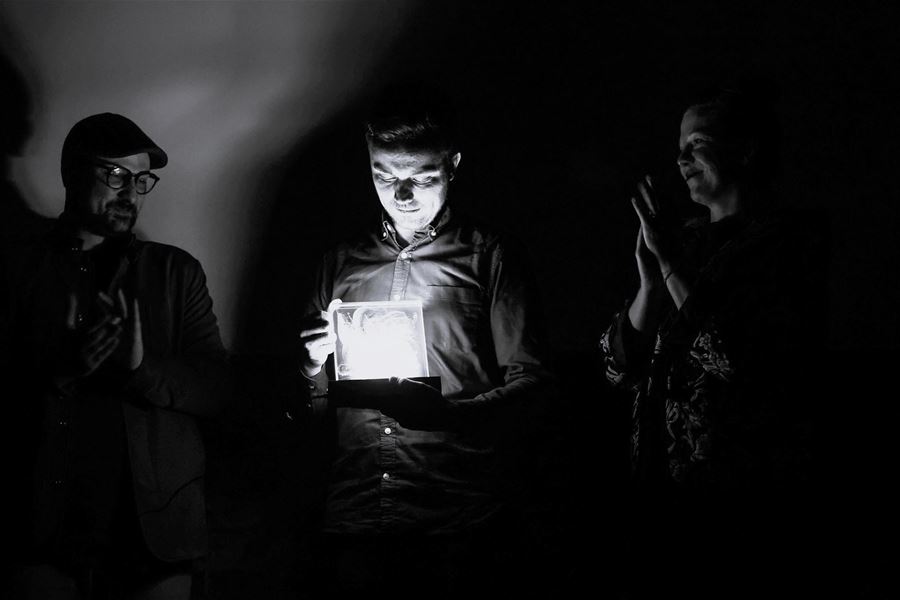
Pavel Koutecký Award
The Pavel Koutecký Award is one of the most prestigious awards for documentary films and is intended for emerging documentary filmmakers. It is an award for the best Czech documentary film of the previous year and is presented in two competition categories – short documentary film and feature-length documentary film.
PAVEL KOUTECKÝ AWARD FOR FEATURE-LENGTH DOCUMENTARY by a Czech director or produced in the Czech Republic is awarded to the film's director and comes with a cash prize of CZK 50,000.
PAVEL KOUTECKÝ AWARD FOR SHORT DOCUMENTARY by a Czech director or produced in the Czech Republic is awarded to the director of the film and comes with a cash prize of CZK 25,000.
The award has been given since 2007 in honor of the late director Pavel Koutecký. Between 2018 and 2024, the Pavel Koutecký Award was closely linked to the ELBE DOCK IFF, where it was also presented. In 2025, it moved back to Prague, which also brought with it a change in date to February and an expansion of the supporting program, which now includes workshops for teachers and film school students.
The winning films are selected by a jury composed of prominent figures in cultural life with a reach beyond the film sphere. In the past, the jury has included, for example, journalist and screenwriter Ondřej Štindl, literary critic and journalist Jiří Peňás, dramaturge of the Jeden svět festival Zuzana Raušová, journalist and screenwriter Irena Hejdová, playwright, screenwriter, and director Petr Zelenka, animated film producer Barbora Příkaská, director and cinematographer Miroslav Janek, writer Radka Denemarková, theater director Jana Svobodová, director Radim Špaček, writer Jaroslav Rudiš, writer Petra Hůlová, anthropologist Sara Polak, actor and director Jiří Havelka or director Drahomíra Vihanová. In recent years, representatives of the younger generation have also begun to appear on the jury, such as journalist Janek Rubeš, artist Kateřina Šedá, performer Kamil Bartošek (Kazma), director Ivan Zachariáš, moderator Emma Smetana, artistic director of the Signal Festival Richard Loskot, film editor Marek Kráľovský, director Michal Hogenauer, screenwriter Štěpán Hulík, and the wife of a film critic. Ukrainian artists Alexandra Bryksa, Marharyta Golobrodska, Alexandr Kozlov, and Olga Krykun were also members of the jury. Last year's jury included director Markus Krug, Moving Station founder Roman Černík, traveler and writer Eva Kubátová, and deputy director of the Nad Kavalírkou High School Jan Novák.

Audiovisual sauna
The Audiovisual Sauna is part of the project "Kritický pařník" and aims to connect art critics, audiences and creators.
The purpose of the project and its activities is to strengthen audiovisual criticism and connect with creators and audiences through a series of lectures, discussions, workshops and the involvement of art critics in festival practice. Its theme is audiovisual art in a broad sense. Another activity of the projekt "Kritický pařník" is a workshop focused on the development of young dramaturgs Semaine de la critique in Czech.
The aim of the project is to change the mind-set of art criticism, which is often oriented without overlapping to other art forms. Informing the public about the possibilities of new attitudes, changing the common discourse with artists about thinking about art. All of this fulfils the notion of critical thinking and the development of critical discussions, which has been our organisation's focus for a long time.
It is art criticism that is a possible principle of connection with practice and its further development towards the audience, not only through textual and audiovisual outputs, but through direct communication with the audience. The implementation of new practices from the project activities for other cultural organisations is then another goal of the project. Thus, the development focuses mainly on art criticism, but its overlap is to the whole society and the creation of a new discourse concerning the reflection of art and its feedback to art and for art mediators.
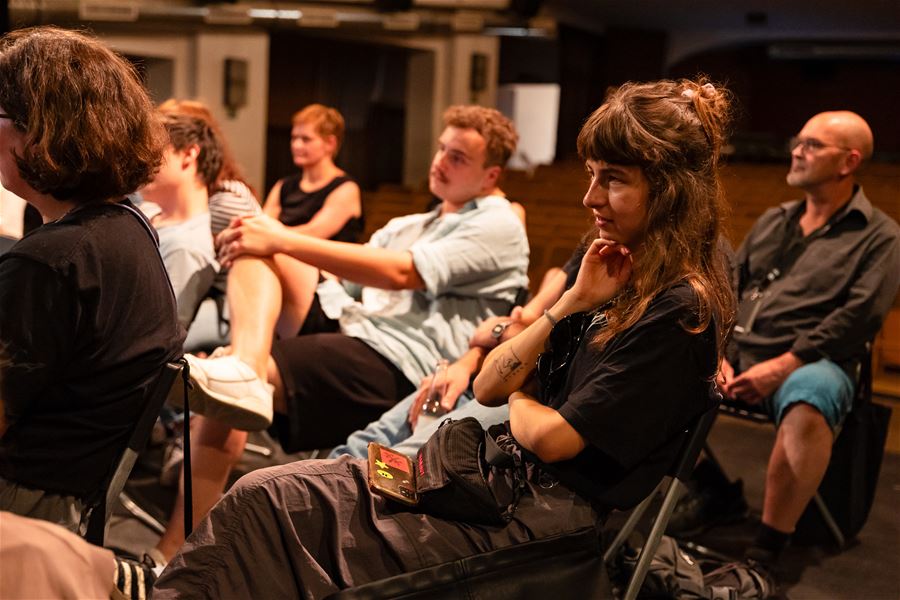
Visegrad Audiovisual LAB
Past events:
Industry programme of the BOO International Short Film Festival /CZ/ – November 3–9, 2025
Workshop: Understanding your audience + Focus group: Insights into audience perception /PL/ – October 15, 2025
International Day of Audiovisual Education /CZ, SK, PL, HU/ – 27. 8. 2025
Workshop: Understanding your audience + Focus group: Insights into audience perception /HU/ – 2. 6. 2025
Partners:
Boiler (SK)
Fundacja Edukacji Kulturalnej "Ad Arte" (PL)
Centrum Kultury Filmowej im. Andrzeja Wajdy (PL)
Nemzeti Filmintézet Közhasznú Nonprofit Zrt – Filmarchívum Igazgatóság (HU)
Cinefil (SK)
bujón (CZ)
The project is co-financed by the governments of Czechia, Hungary, Poland and Slovakia through Visegrad Grants from the International Visegrad Fund. The mission of the fund is to advance ideas for sustainable regional cooperation in Central Europe.

CINETOTS
If you are interested in ordering films from our distribution, please contact us at program@krutonfilm.cz.
The films from this band can be individually combined with the films from the other Young & Short bands.
Total duration is 60 minutes.
The program is suitable for children aged 4 and up, their parents, kindergartens and primary schools.
The lynx lives its everyday life in the forest. One evening, however, the lights of a nearby town catch his attention and awaken his curiosity. So Lynx sets off into an unfamiliar environment. He crawls between apartment blocks, traffic lights and playgrounds. But then he falls asleep in a car park and wakes up in the morning in the middle of a group of people...
People think that night and day alternate because of the rotation of the Earth. But it's actually quite different! Every evening, Mr. Night comes, turns the whole world black and turns off all the lights.
A huge school of herring sails through the ocean together. But during an attack by seagulls, one small herring wanders off and gets stuck in the lagoon. There he encounters all sorts of strange and often frightening aquatic creatures. Can the diverse group of animals unite and together fight off the attack of the seagull, which is already grinding its beak on them?
A flock of white cartoon sheep live peacefully on a page of paper. One day a black sheep appears among them. But the others are shy and shy away from her because she is different. Everything changes at night when a scary predator flies in and kidnaps the defenceless sheep. While the others cower in fear, the black sheep is the only one who dares to stand up to the predator.
A little boy goes to visit his grandfather, with whom he spends his free time flying a kite. One day, however, the wind takes his grandfather away forever. In the spring, the boy returns to the abandoned house and tries to fly a kite by himself. Suddenly, the wind picks up and carries the kite and the boy above the clouds, where he meets his grandfather, at least for a while.
It's a clear winter day and on a frozen lake in the middle of a snowy landscape, Piglet is teaching his best friend Cowgirl to skate. However, the merry play together is unexpectedly interrupted by a large fish that appears under the ice. However, during their hasty escape, they forget their skates on the ice and have to return for them and together overcome their fear of the scary fish. But is the fish really that scary?
In a small clearing surrounded by a dark forest live hairy creatures whose only food is seeds that turn into glowing fruits. But the animals are often hungry, because the seeds rarely come to them. One of them overcomes his fear and decides to do something no one has dared before - enter the forest.
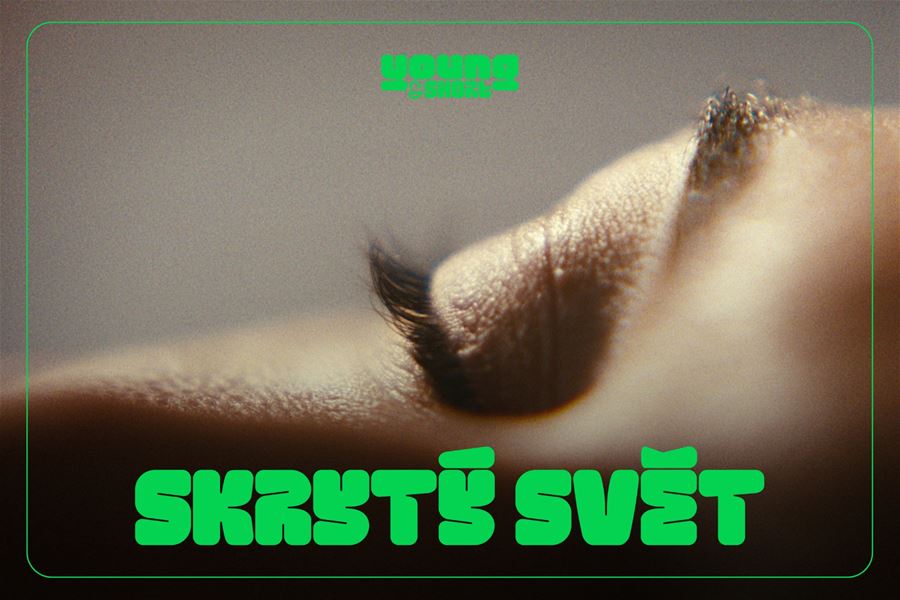
HIDDEN WORLD
If you are interested in ordering films from our distribution, please contact us at program@krutonfilm.cz.
The films can be individually combined with the films from The Abyss, What If? and Carousel of Emotions.
Total duration is 57 minutes.
The program is not age-restricted (recommended age is 12 to 14 years). Recommended for secondary schools.
James is living a dual life. On the internet, he creates videos about the microscopic world that have tens of thousands of views. But in real life he lives a lonely, self-contained life, trying in vain to cope with the trauma caused by his abusive father in his childhood. So he spends nights going out to collect samples for his experiments, and days lingering over a microscope, isolated from everything around him. Will he ever find his place in the world, or is he doomed to eternal solitude?
Chocolate milk. Grandparents and aunt. Beaches and sun. What do the children of immigrants who have come from different parts of the world to Western Europe miss most? The animated document uses real testimonies and combine them with animation depicting children as penguins. By doing so, it presents their everyday problems and allows us to reflect on how the experience of being uprooted from their homeland affects them.
The creation of the world took seven days. But it only takes one to upset its delicate balance. An animated world woven from colourful threads is thus swallowed up before our eyes by a destructive, all-consuming black thread, through which the film shows what can happen if we break the eternal bonds and let one force overwhelm everything else.
Ten-year-old Vítek has extraordinary abilities - he can feel and hear what others cannot. The documentary uses an experiment technique of sand animation to bring the world of a blind boy closer to the audience, raising the question of whether the absence of one of the senses must necessarily be an obstacle.
A seemingly peaceful area in Pakistan, where time passes according to established patterns and customs handed down for generations. But on the football fields, an emancipatory battle is being fought. A tournament is being prepared in which not only female players will stand against each other, but also the idea of gender equality and emancipation against the conservative views of religious leaders.
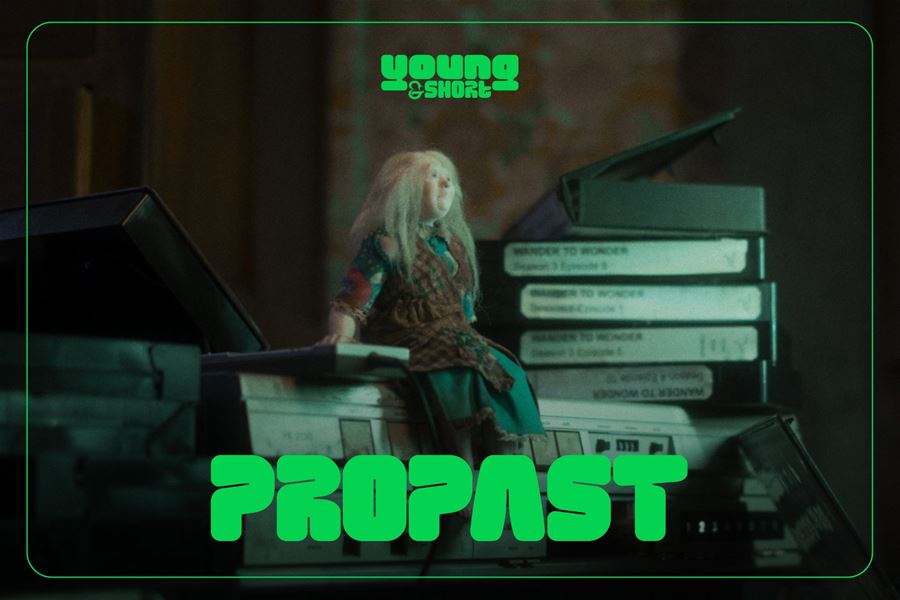
THE ABYSS
If you are interested in ordering films from our distribution, please contact us at program@krutonfilm.cz.
The films can be individually combined with the films from Hidden World, What If? and Carousel of Emotions.
Total duration is 84 minutes.
The programme is recommended for audiences aged 15 and over and adults. Recommended for high schools.
For Artem, water is everything. At a young age, thanks to the support of his mother and friends, he was able to overcome the fear he felt towards it and he discovered his extraordinary swimming talent, which helped him become one of the best swimmers of his time and also helped him find the love of his life. But everything is torn apart by the Nazi occupation and racial hatred, which not only robs him of his career but also of those closest to him because of his Jewish heritage. For Artem, water becomes a source of strength to survive the war and cope with the trauma left behind.
Mary, Billybud and Fumbleton are characters featured in the children's TV show "Wander to Wonder". After the death of the show's main creator, they are left alone in the studio where they continue to make increasingly strange episodes with their slowly disintegrating costumes and growing hunger. Frustration, madness and a pile of dead flies grow. An existential fairy tale that has won over 40 awards at prestigious film festivals or an Oscar nomination.
Caring for the dying and their families is, at first glance, a bleak occupation. Workers in this field must soothe both the pain of the dying and the grief of their nearest and dearest as they struggle to come to terms with the passing of their loved ones. The documentary finds solace in the eternal symbols of birds, messengers of the unspoken, showing that even death can bring many sighs of relief.
Once upon a time there was a Girl who had had enough of everything. So she decided to kill everyone she knew and set out with the spirit of her beloved dog on a spontaneous journey of self-discovery, during which she straddles the line between profound and humorous, dealing with her emotions as well as her persecutors and finding her inner strength.
The first days of the Russian invasion of Ukraine. Fear and uncertainty about what will happen next. Escape from Kiev, which became the main target of Russian troops, to a boyfriend's parents in nearby Irpin. Fear of bombing makes the house a prison from whose suffocating grasp it's impossible to escape. The autobiographical film thus shows that behind all the numbers of evacuees, dead and wounded, there are actual human stories, each one completely changed by the war.
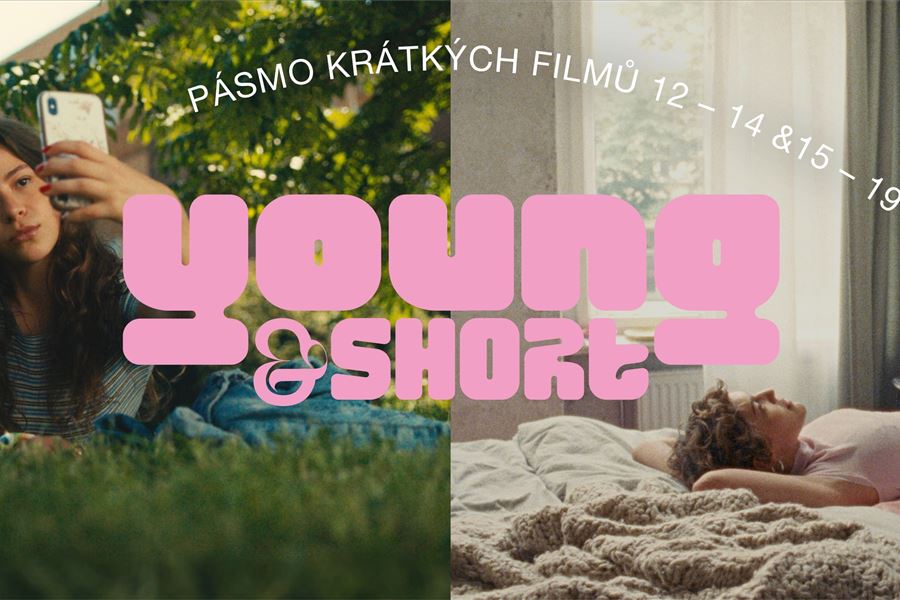
CO KDYBYSTE S NÁMI ROZTOČILI KOLOTOČ EMOCÍ?
Do distribuce vstoupily 3. 10. 2024 dvě pásma krátkých filmů Young & Short: CO BY, KDYBY? / Young & Short: KOLOTOČ EMOCÍ.
Obě pásma jsou k dispozici k objednání v DISFILMU.
Kromě připravených pásem nabízíme také možnost kombinací jednotlivých filmů. Kombinovat je možné i s filmy z loňského ročníku Young & Short (12 – 14 let / 15 – 19 let).
Stačí napsat nebo zavolat a můžeme pásmo společně sestavit z dostupných filmů podle Vašich představ a možností.
Filmy nejen pro své vrstevníky každý rok vybírají mladí lidé ve věkových kategoriích 12 – 14 a 15 – 19 let. Výběr z toho nejlepšího, co evropská krátkometrážní kinematografie nabízí, mladou generaci vystihuje, ale je zajímavý nejen pro ně, ale i pro ostatní diváky. Ideální příležitost vzít do kina rodiče i prarodiče!
Všechny zařazené filmy jsou doplněny pracovními listy, které zpracovala Lucie Hlavicová ve spolupráci se samotnými mladými porotci.
Pracovní listy obsahují kromě obecného úvodu o audiovizuální výchově vždy anotaci a poznámky k vybranému filmu doplněné otázkami a různými aktivitami, jako jsou práce se zvukem, hra s filtry či rozvíjení vlastních scénářů.
Young & Short: CO BY, KDYBY? (12 – 14 let)
Tragikomická animovaná bajka o energetické nenasytnosti, vizuálně strhující dokument o migrujících mrožích, sociální drama o hledání identity, napínavá severská detektivka i roztomilý animák o Edgarovi a jeho krávě.
Filmy: Prase, Tající kry, Změna, Počkej a Jmenuji se Edgar a mám krávu
Young & Short: KOLOTOČ EMOCÍ (15 – 19 let)
Jak se zachovat při zjištění šokující informace na prvním rande? Co předchází nástupu autoritářských režimů? Jaké nástrahy dnes čekají na mladé ženy? Jak obstát v extrémně kompetetivním prostředí a neztratit přitom tvář? A jak přežít fyzické napadení a ještě z něj vyjít jako vítěz?
Filmy: Nejsme v osmdesátkách, Nejkrajší kút v šírom svete, Napiš, až dorazíš domů, Losos a Přes střepy.
V případě zájmu o projekci nás můžete kontaktovat na e-mailu program@krutonfilm.cz.

FILM AND SOCIOLOGY
Citizen Havel (dir. Pavel Koutecký, Miroslav Janek, 2007, 119 min, Czechia)
Olga (dir. Miroslav Janek, 2014, 87 min, Czechia)
Seekers of a Fixed Point (dir. Pavel Koutecký, 2001, 115 min, Czechia)
Where's the Truth? (dir. Pavel Koutecký, 1999, 57 min, Czechia)
The Sportsman (dir. Pavel Koutecký, 1994, 11 min, Czechia)
Oh, What a Struggle It Was (dir. Pavel Koutecký, 1992, 7 min, Czechia)
The End of Czechoslovakia in Parliament (dir. Pavel Koutecký, 1993, 75 min, Czechia)
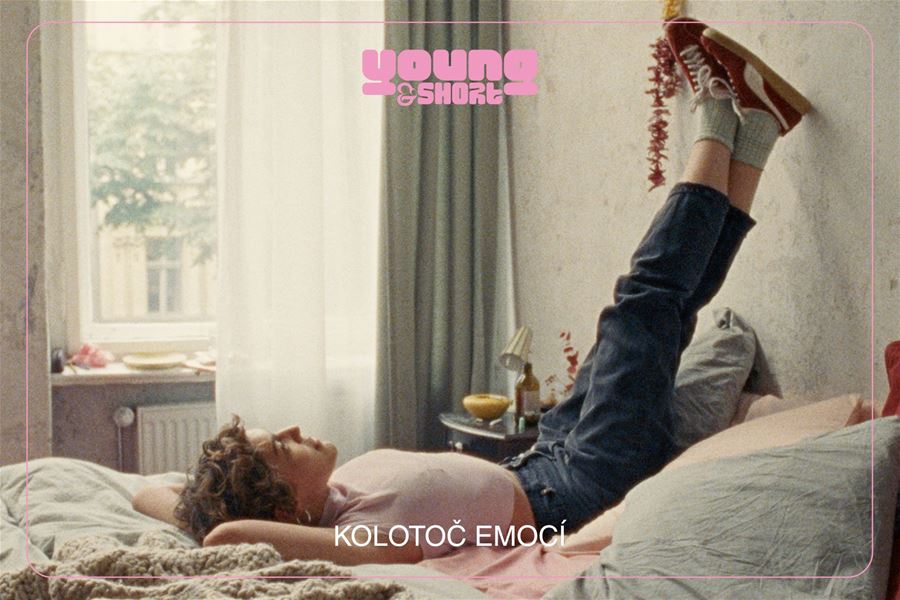
CAROUSEL OF EMOTIONS
If you are interested in ordering films from our distribution, please contact us at program@krutonfilm.cz.
The films can be individually combined with the films from Hidden World, The Abyss and What If?
Total duration is 80 minutes.
Rising Above (dir. Natálie Durchánková, 2023, 4 min, Czech Republic)
The Most Beautiful Corner in the World (r. Robert Mihály, 2022, 25 min, Slovakia)
Salmon (dir. Mattis Heurlin, 2023, 23 min, Denmark)
Text Me When You Get Home XX (dir. Niklas Bauer, 2022, 11 min, Germany)
Not the 80s (dir. Marleen Valien, 2022, 17 min, Germany)
Ulice, stromy, lampy. Rána, tupé lupnutí zlomeného žebra, exploze bolesti. Extrémně sugestivní ale decentně animovaný film ukazuje z pohledu oběti zkušenost s drastickým znásilněním. Když už chcete v zoufalství odvrátit zrak, vyprávění se otočí a ukazuje především neskutečnou sílu, která stojí za překonáním takového traumatu. Posilující snímek Natálie Durchánkové byl nominován na Studentského Oscara.
Co je to fašismus? Reportérka fiktivní televize, původem z Ukrajiny, navštěvuje nejrůznější události, aktéry a veřejné protesty, ve snaze pochopit slovenskou společensko-politickou realitu. Naráží na neschopnost reflektovat vlastní jazyk i historii a zachycuje vyhrocené společenské nálady vedoucí ke vzniku nového autoritářství. Dokumentární esej nastavuje zrcadlo nejen současnému Slovensku, ale i okolním státům, které může brzy postihnout podobný osud.
V jedné severské michelinské restauraci usilují o naprostou dokonalost každý den. Ale dokonalost nikdy nebyla tak zásadní jako právě dnes u stolu sedmnáct. Jediná chyba a všechno se může zhroutit. O tom se přesvědčí i mladý kuchař, který zrovna teď dostal příležitost, na kterou celou dobu čekal. Vyhrocené lososové drama odkrývá nejen fungování špičkových restaurací, ale i nejběžnějších lidských selhání. Protože mnohdy největší chybou není chyba samotná, ale zoufalá snaha ji zakrýt.
Mladá žena uprostřed noci na cestě domů taxíkem. Nevinná konverzace se rychle stáčí k intimnějším tématům a atmosféra postupně houstne. Pár obratných zkratek a auto se brzy kodrcá na odlehlé silnici kdesi na periferii. Co je záměr a co náhoda? Film Napiš, až dorazíš domů je jedním z příspěvků k nekonečné, ale stále velmi aktuální debatě o sexualizovaném násilí.
Dva lidé, jedna restaurace, pár předsudků, trochu ryb a hodně chyb. Nervozitu z prvního rande rychle rozptýlí spontánní polibek. Následuje však nečekané přiznání. Mladá dívka se musí rychle rozhodnout, jak na danou situaci zareaguje. Mezitím číšník prosí o recenzi na Yelp. Situace začíná být bytostně nepříjemná úplně pro všechny. Nejnovější snímek úspěšné mladé režisérky Marleen Valien bravurně buduje trapno na hranici únosnosti a zároveň předkládá důležitá témata. Především nás ale nutí se zamyslet, jak bychom v takovém momentě zareagovali my?
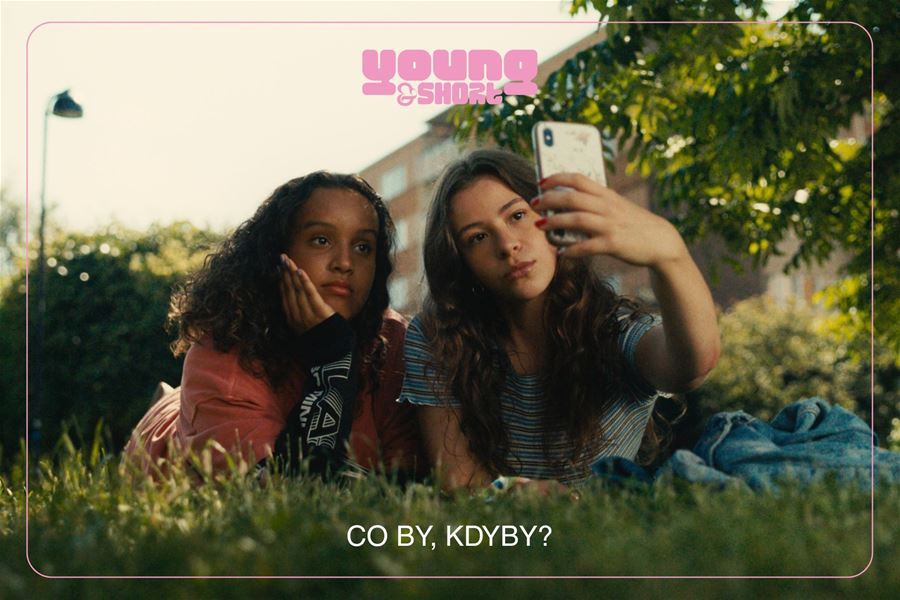
WHAT IF?
If you are interested in ordering films from our distribution, please contact us at program@krutonfilm.cz.
The films can be individually combined with the films from Hidden World, The Abyss and Carousel of Emotions.
Total duration is 69 minutes.
My Name is Edgar and I Have a Cow (dir. Filip Diviak, 2023, 7 min, Czechia/Slovakia)
Wait (dir. Martin Jenefeldt, 2023, 11 min, Sweden)
Pig (dir. Jorn Leeuwerink, 2022, 8 min, Netherlands)
Haulout (dir. Evgenia Arbugaeva, Maxim Arbugaev, 2022, 25 min, United Kingdom/Russia)
The Shift (dir. Amalie Maria Nielsen, 2022, 18 min, Denmark)
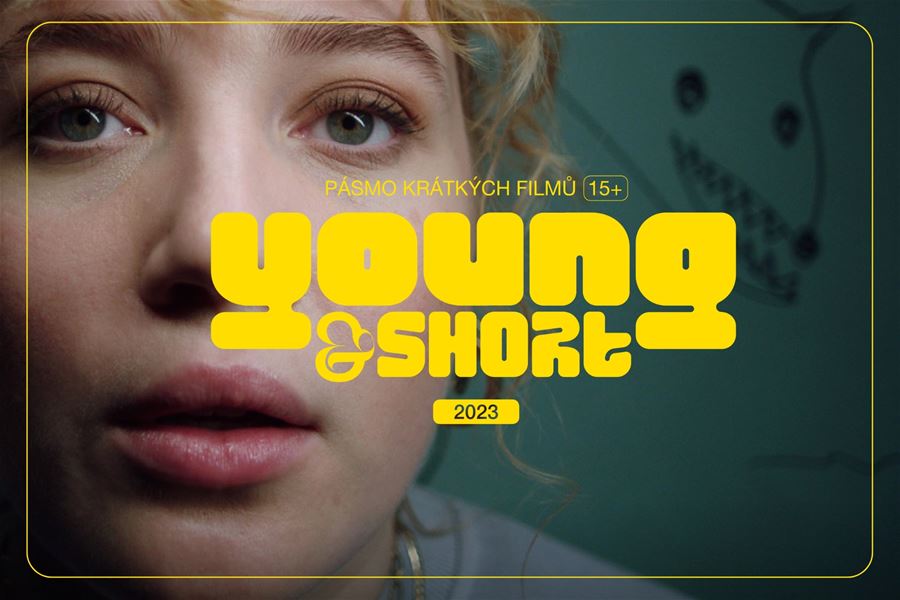
YOUNG & SHORT 2023 (15–18 years)
Catcave Hysteria (dir. Angelika Abramovitch, 2021, 20 min, Sweden)
By Flávio (dir. Pedro Cabeleira, 2022, 27 min, Portugal/France)
It's Nice in Here (dir. Robert-Jonathan Koeyers, 2022, 15 min, Netherlands)
Lighthouse (dir. Filip Kraus, 2022, 11 min, Czechia)
Rites (dir. Damián Vondrášek, 2022, 16 min, Czechia)
If you are interested in ordering films from our distribution, please contact us at program@krutonfilm.cz.
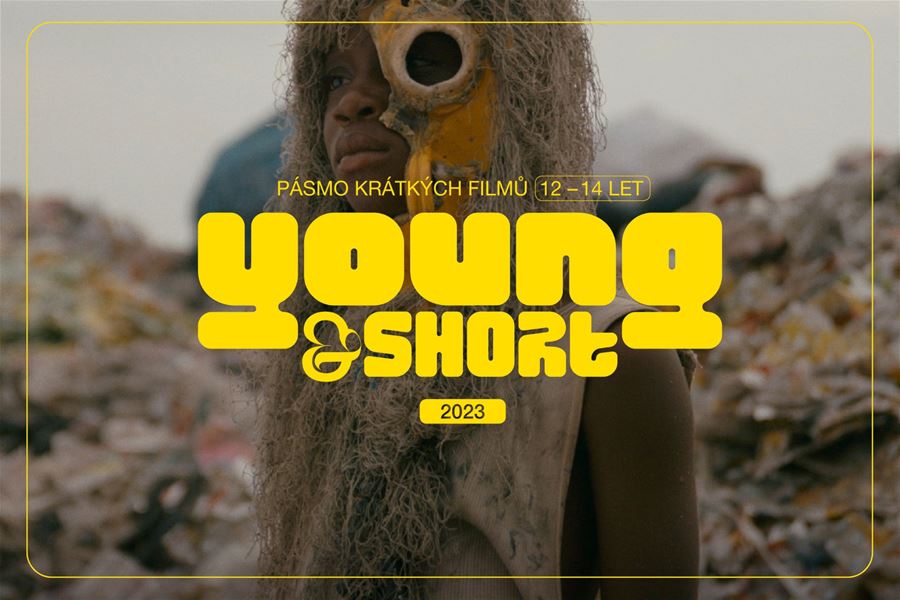
YOUNG & SHORT 2023 (12–14 years)
Bgirl Badli (dir. Charlotte De Kort, 2022, 15 min, Belgium)
Yeah, I'm Good Thanks (dir. Hannah Lau-Walker, 2022, 2 min, Great Britain)
Louis I. King of the Sheep (dir. Markus Wulf, 2022, 9 min, Germany)
Last Weekend with Jenny and John (dir. Jimmy Olsson, 2023, 16 min, Sweden)
Tsutsue (dir. Amartei Armar, 2022, 12 min, France/Ghana)
Yung Michal (dir. Štěpán Vodrážka, 2022, 17 min, Czechia)
If you are interested in ordering films from our distribution, please contact us at program@krutonfilm.cz.
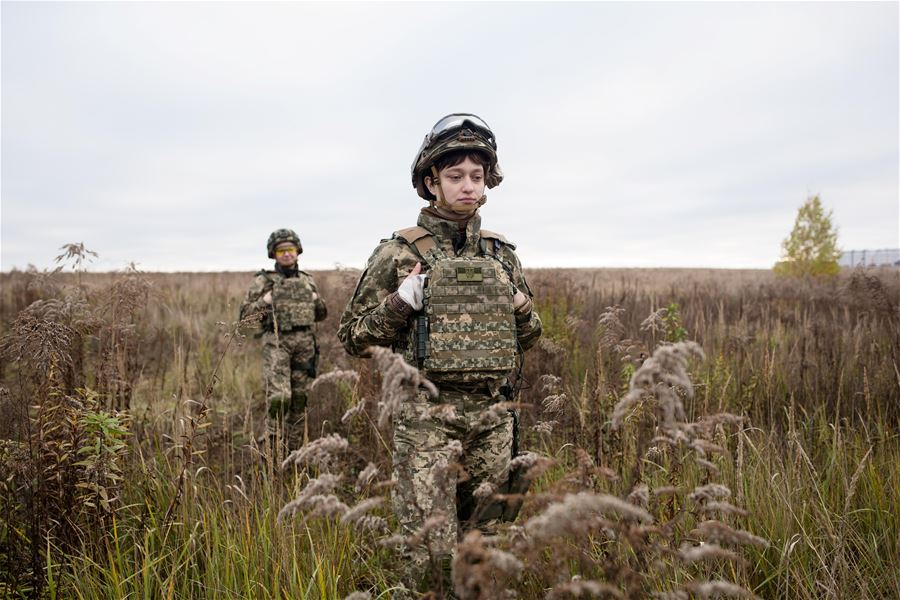
BUTTERFLY VISION
If you are interested in ordering films from our distribution, please contact us at program@krutonfilm.cz.
Soldier Lilja returns from several months of captivity in Donbas, where she was held by separatists. The harsh treatment has caused trauma that haunts her in tormenting dreams. As an expert in aerial reconnaissance, she saw events on the front from the perspective of a drone - as a civilian wife, she now sees the world around her with similar distance. Richness of feeling has been replaced by cluelessness, humanity has been replaced by machine-like behaviour. But when you just want to get on with your life, a bird's eye view may not be the best. Maksym Nakonevny's debut tells the story of a wandering woman who stubbornly refuses the role of victim, and sensitively questions how oppressive existence can be in a society plagued by war.
The film was awarded at the Odessa International Film Festival 2022, the Saint-Jean-de-Luz International Film Festival 2022, the Dream City International Film Festival in Rivne 2022, and the Ukrainian Film Academy 2023 Awards for Best Editing and Best Sound. In addition, he has also appeared at the Cannes Film Festival 2022 and the Karlovy Vary International Film Festival 2022.
Maksym Nakonechnyi is a Ukrainian director and producer. He studied directing at the Kyiv National University of Theatre, Film and Television Karpenko-Kary (2012). He has worked on various television projects and co-founded Tabor, an independent production company that produces documentaries, feature films, theatre productions, and commercials. Maksym directed the short feature films Invisible and New Year with Family. His feature debut Butterfly Vision premiered at Cannes 2022 in the Un Certain Regard section.
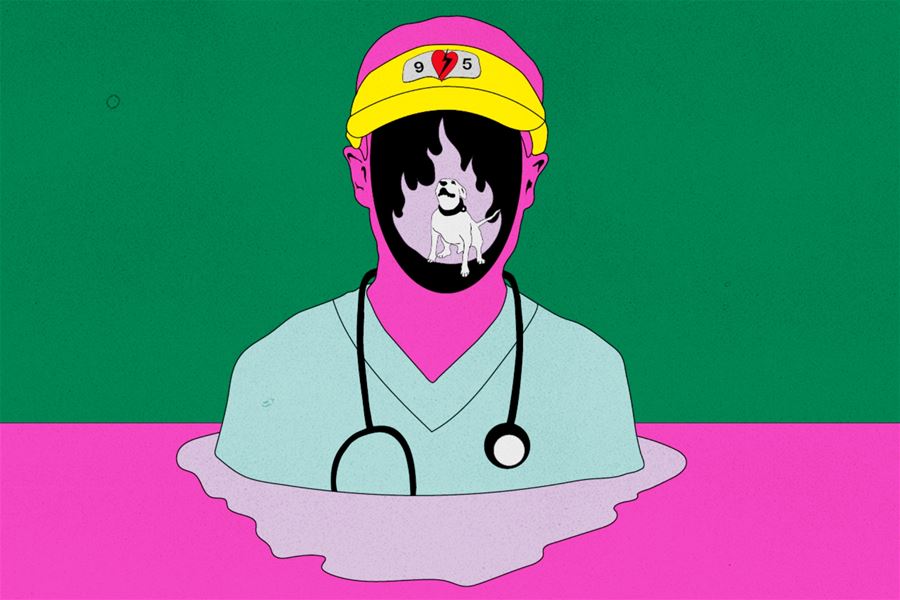
NOT TO BE ALONE
If you are interested in ordering films from our distribution, please contact us at program@krutonfilm.cz.
Credentialing (dir. Jan Hecht, 2023, 20 min, Czechia)
Love, 9 to 5 (dir. Jakub Jirásek, 2022, 16 min, Czechia)
Rites (dir. Damián Vondrášek, 2022, 16 min, Czechia)
Yung Michal (dir. Štěpán Vodrážka, 2022, 17 min, Czechia)
Paradise on Earth to See (dir. Vojtěch Novotný, 2022, 27 min, Czechia)
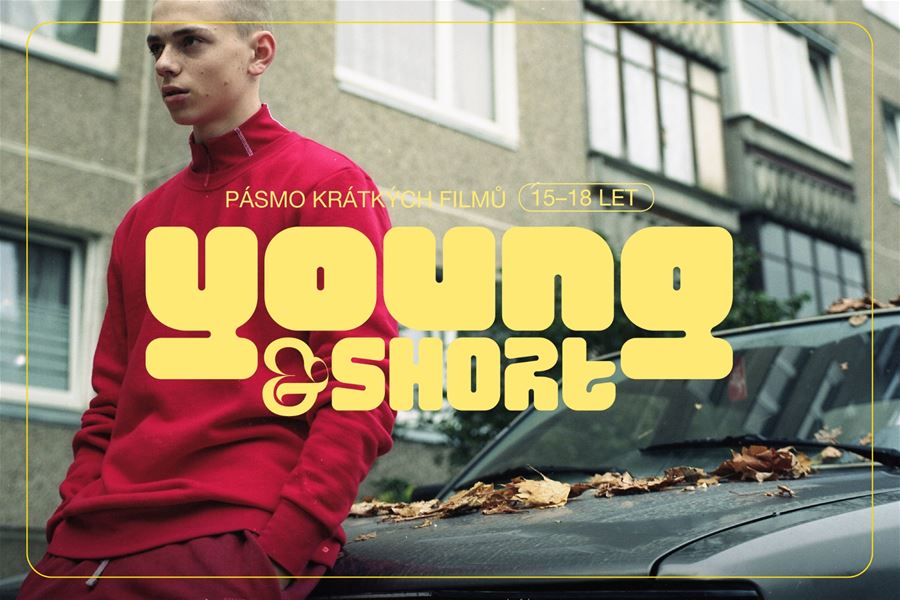
YOUNG & SHORT 2022 (15–18 years)
If you are interested in ordering films from our distribution, please contact us at program@krutonfilm.cz.
Johana (dir. Ondřej Pilát, 2020, 9 min, Czechia)
Techno, Mama (dir. Saulius Baradinskas, 2021, 18 min, Lithuania)
Wild Minds (dir. Hannah Elbke, 2021, 29 min, Denmark)
Iriy (dir. Agnieszka Nowosielska, 2020, 20 min, Poland)
The Criminals (dir. Serhat Karaaslan, 2020, 23 min, France/Romania/Turkey)
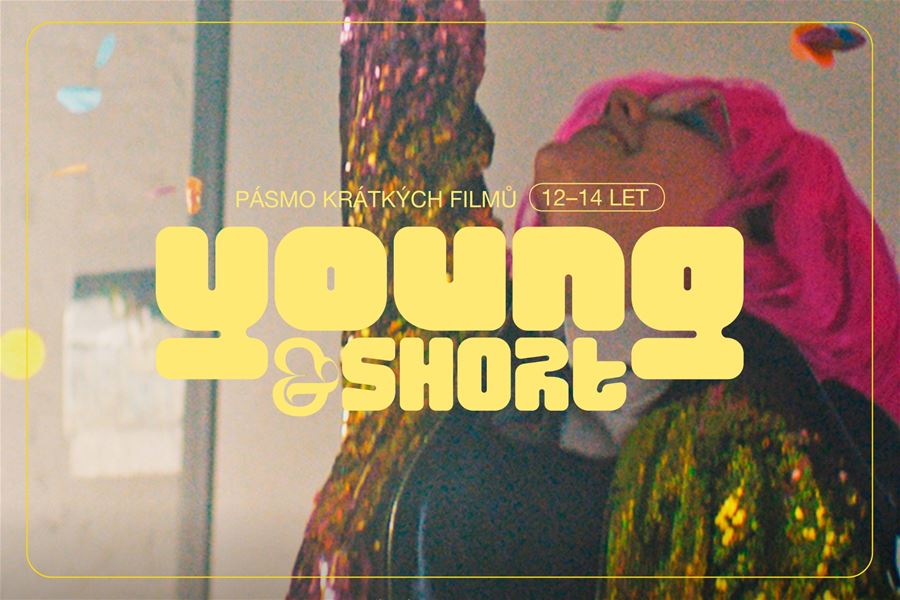
YOUNG & SHORT 2022 (12–14 years)
If you are interested in ordering films from our distribution, please contact us at program@krutonfilm.cz.
Sanctuary (dir. Eva Matejovičová, 2021, 5 min, Czechia)
Dalia (dir. Brúsi Ólason, 2020, 16 min, Island)
Run (dir. Emma Miranda Moore, 2021, 13 min, Great Britain)
Thea & Tuva (dir. Kristian B. Walters, 2020, 23 min, Norway)
toni_with_an_i (dir. Marco Alessi, 2019, 12 min, Great Britain)

FEINKOŠT 2022
The band is currently not available for distribution.
Animot (dir. Juliana Moska, 2021, 18 min, Czechia)
Donbas Days (dir. Philipp Schaeffer, 2021, 16 min, Germany/Ukraine)
Glückspfad (dir. Jakob Werner, Thea Sparmeier, Pauline Cremer, 2021, 5 min, Germany)
Love, Dad (rdi. Diana Cam Van Nguyen, 2021, 13 min, Czechia/Slovakia)
My Identity (dir. Vojtěch Petřina, 2021, 17 min, Czechia)
Sirens (dir. Ilaria Di Carlo, 2022, 13 min, Germany/Italy)
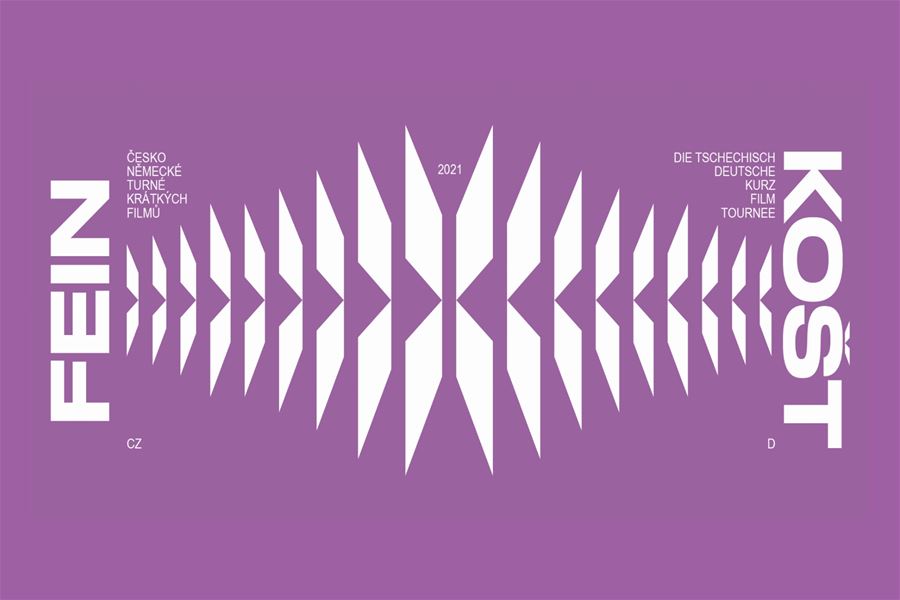
FEINKOŠT 2021
The band is currently not available for distribution.
27 Steps (dir. Andrea Schramm, 2021, 21 min, Germany)
Johana (dir. Ondřej Pilát, 2020, 9 min, Czechia)
Mrs. Happy (dir. Nikola Klinger, 2020, 15 min, Czechia)
The One Who Crossed the Sea (dir. Jonas Riemer, 2020, 11 min, Germany)
Inside (dir. Viktorie Štěpánová, 2020, 6 min, Czechia)
Top Down Memory (dir. Daniel Theiler, 2021, 13 min, Germany)
Topless (dir. Hannah Jandl, 2020, 11 minut, Germany)
Railings (dir. Barbora Sommersová, 2020, 6 min, Czechia)
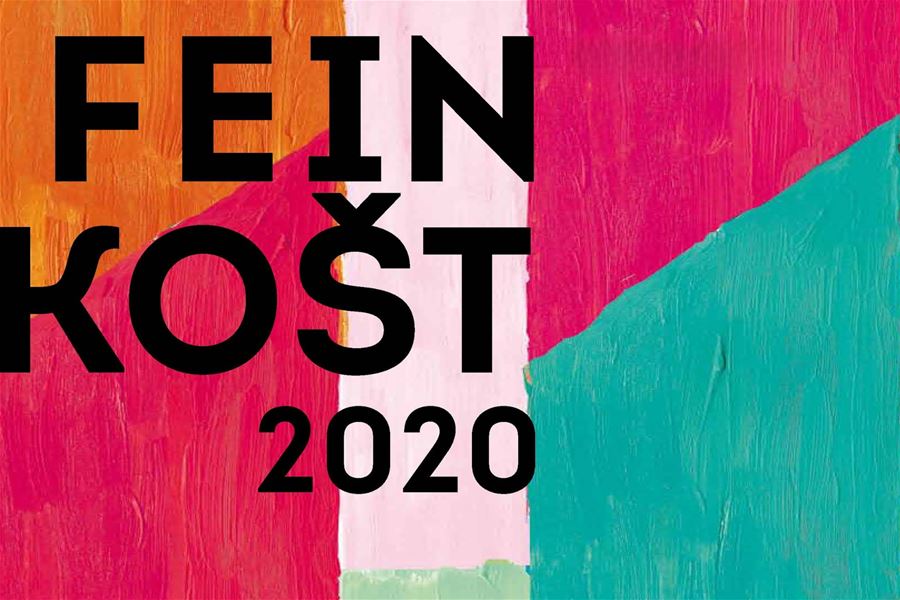
FEINKOŠT 2020
The band is currently not available for distribution.
Apparatgeist (dir. Marie-Magdalena Kochová, 2019, 11 min, Czechia)
Eadem Cutis: The Same Skin (dir. Nina Hopf, 2019, 6 min, Germany)
Daily Manure (dir. Nikola Krutilová, 2019, 24 min, Czechia)
Forget Me Not (dir. Adela Križovenská, 2019, 7 min, Czechia)
S P A C E S (dir. Nora Štrbová, 2020, 8 min, Czechia)
Navigatour (dir. Carsten Knoop, Dorit Kiesewetter, 2019, 3 min, Germany)
The Fire (dir. Alexander Lahl, Jan Koester, 2019, 5 min, Germany)
Keep shiftin' (dir. Verena Wagner, 2019, 21 min, Germany)
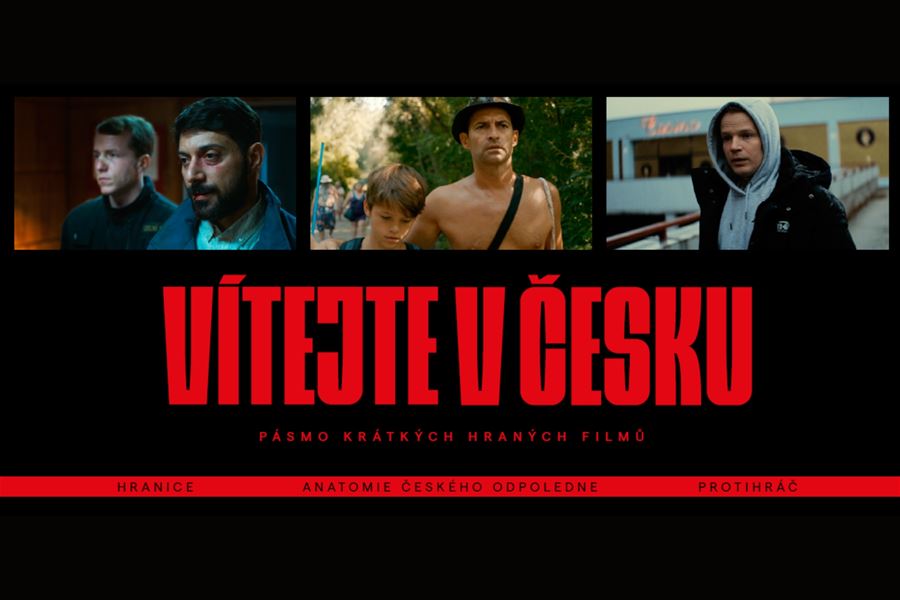
WELCOME TO CZECHIA
The band is currently not available for distribution.
Anatomy of a Czech Afternoon (dir. Adam Martinec, 2020, 22 min, Czechia)
Frontier (dir. Damián Vondrášek, 2020, 29 min, Czechia)
Opponent (dir. Ondřej Erban, 2020, 17 min, Czechia)
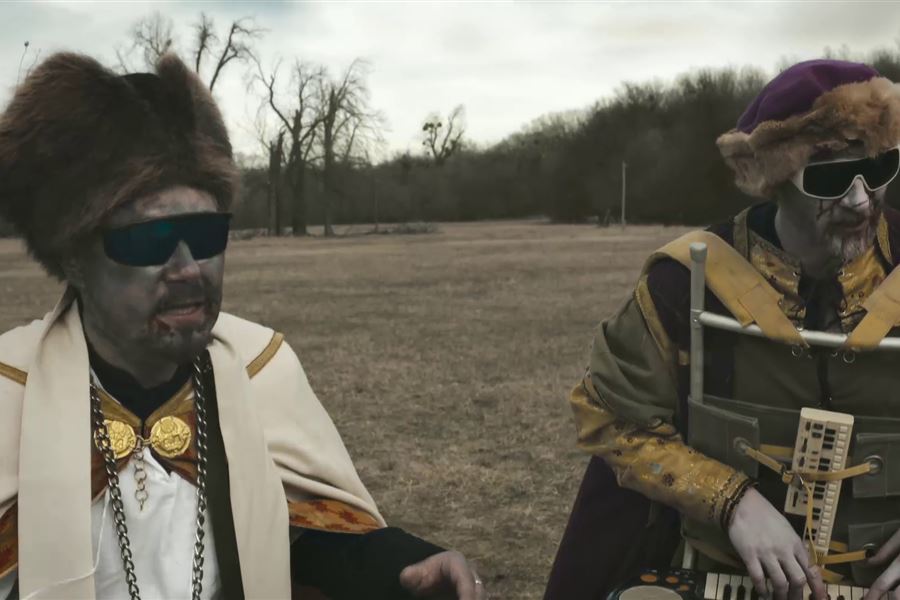
MORAVIA, O FAIR LAND III
What do folklore, black metal and zombies have in common?
Ivana Slabáková, guru of Moravian brass band, announces a historical event - the discovery of the Mikulčice Manuscript, which reveals the historical significance of the Great Moravian Empire. Slabáková brings together Moravian patriots, a brass band, a clerofascist, a Brno Satanist and a group of retired amateur musicians to celebrate this sensation with a spectacular Moravian musical. In Rohatec, the heart of Moravian Slovácko region, a great Moravian drama is being diligently rehearsed, but it brings back to life the dead from the Old Slavic burial grounds. But even in the epic clash of cultures, the brass band continues to play in Moravia, zombies trim the vineyard and hope for a better harvest next year.
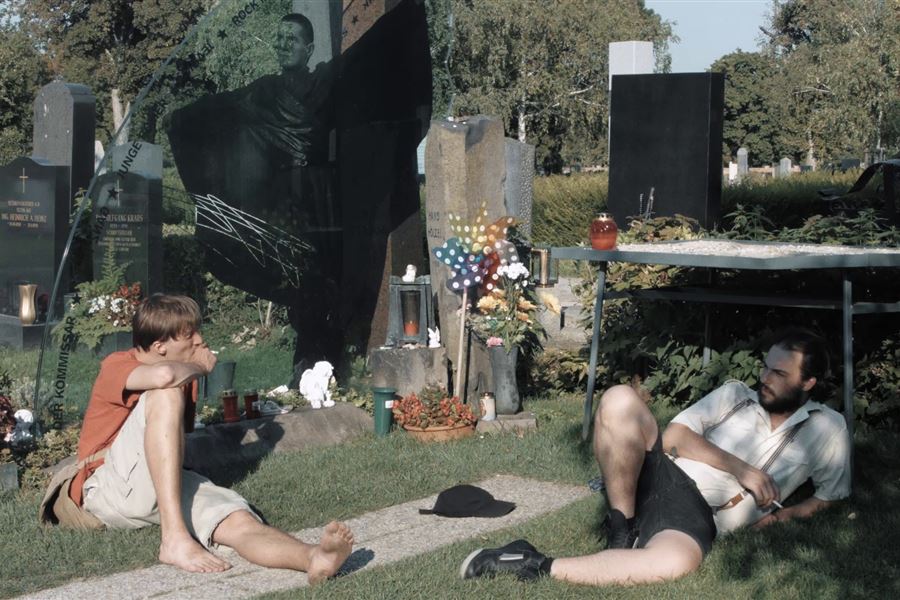
VIENNA CALLING
Contemporary society deals with the death in its own way. On the one hand, we admire it in computer games and pop culture films, on the other hand, society is pushing it out of real life. Dying is no longer a natural part of life, but rather a technical problem that science and doctors are trying to solve or even stop. For the main character of the documentary Vienna Calling, Ondřej Jajcaj, death is different. He is fascinated by it, he admires it. In the past, he has not been shy about stealing the teeth of Johann Strauss and Johannes Brahms. He made his living as a grave robber.
"Jajcaj's goal is to rid society of the fear of death. To do this, he embarks on a bizarre journey with a morbid mobile museum - a marquee of death, decorated with skulls, a collection of dental prosthetics and his paintings. With a handful of henchmen, Jajcaj and his traveling parade of bizarreness make their way across the countryside, confronting society with the phenomenon of death during feast time. The destination is Vienna, where Jajcaj plans to officially present the dental remains of Johann Strauss Jr. and Johannes Brahms to Austrian officials," the director says of the film.
The experimental documentary Vienna Calling presents one of the phenomena of our time - the fear of death. It's a subject so fundamental, the execution so bizarre and Jajcaj himself so eccentric that we thought it appropriate to support him on this journey through our distribution.

OKHWAN’S MISSION IMPOSSIBLE
The main character of Okhwan's Mission Impossible is a Korean lawyer, cyclist, naive dreamer and passionate activist all rolled into one - Okhwan. He has chosen a mission that is close to impossible: to cycle around the world to draw attention to the issue of the division of his own country by the meaningless border between North and South Korea. A kidnapping, an extreme hunger strike in front of the London parliament during the parliamentary recess or completing the Prague Marathon without any preparation are just a small list of the many misfortunes that haunt Okhwan during his symbolic struggle. A struggle that has grown to absurd proportions and has also shown that even a naive idea can have a purpose with great courage and determination.
The film had its festival premiere at the Pilsen Finale Film Festival 2017, where it was included in the Golden Kingfisher competition.

FC ROMA
Last season a new team entered the lowest Czech football competition. FC Roma is a club from Děčín, which is composed mostly of Roma players. "If I don't like someone, I will want to beat them," says coach Pavel Horváth. But his opponents see it differently and most of them are boycotting the Roma club. So it's a bit of a strange season for FC Roma. Sometimes it plays, sometimes it doesn't play, nothing is certain ahead of time and the club wins most of its matches by default. But the FC Roma players do not lose their sense of humour and fight both on and off the pitch. But sometimes it's harder than they imagined: they lose balls, players indulge in marijuana, fans shout at them to go to work. But the club is moving higher and higher up the table.
The chronicle of FC Roma, whose members have to persuade other "white" teams in the third league to play them at all, turns into an excursion through various forms of everyday Czech xenophobia. The unobtrusive observational approach of the filmmakers allows the speeches of the charismatic coaches to stand out, who with a healthy ironic detachment gloss over a society that gives them almost no chance. It is the speeches of the various protagonists that are the most striking element of this riveting yet hopelessly resonant documentary. Racism is shown to be an absurdity that is often unintentionally comic, but often chilling at the same time.
The film was awarded the Czech Joy Award at the Ji.hlava International Documentary Film Festival 2016 and was nominated for the 2016 Czech Lion and the 2016 Czech Film Critics Award for Best Documentary.

MORAVIA, O FAIR LAND II
The second part of the endless series about Moravia called Moravia, Oh Fair Land II offers an even darker descent into the soul of Moravia, which is as addictive as a slightly delirious state after a sip of wine and chewing a lump of mother earth. A visually disjointed pilgrimage focused on the undercurrents of Moravian identity, the echoes of which even Friedrich Nietzsche would not want to hear, for the wine and the cheering are but a husk of violence. The essence of Slovicism and true Slavism may have been almost swept away on the Slovak ziggurat, but the temple of Moravian culture and scholarship produced by AZ kvíz saves the day. Hopefully forever.

TRUE LOVE
The band is currently not available for distribution.
Mr. Spider's Anatomy (dir. Vojtěch Kiss, 2014, 27 min, Czechia)
Happy End (dir. Jan Saska, 2015, 6 min, Czechia)
Pérák: Shadow over Prague (dir. Marek Berger, 2016, 13 min, Czechia)
Prague! (dir. Matyáš Trnka, 2015, 15 min, Czechia)
In the Garden (dir. Ondřej Dolejší, 2014, 8 min, Czechia)

MORAVIA, O FAIR LAND
This experimental western-horror film from the Moravian Slovácko region brings a new perspective on the legend of St. Václav. Against the backdrop of a folk feast, the mythical Prince Boleslav, a zombie from the wine cellar, struggles with his brother Václav over the nature of Czech statehood and a plate of tomato sauce. This film essay on the myths of Czech and Moravian nationalism is a sarcastic depiction of the hollowed-out tribal rituals that affirm national identity but sharply define themselves against otherness. The sanctity of folklore is sabotaged in the film by archaic film and video formats with many errors and blemishes, a muddled mix of brass music and counterpoint in the commentary.

GOTTLAND
"The resemblance to real events or persons is not coincidental." Gottland presents an unconventional view of the 20th century by FAMU students and recent graduates. The short story film presents peculiar fates - the love affair of actress Lída Baar with Joseph Goebbels, the story of the flying writer in the service of communist secret police Eduard Kirchberger, the Bata idea of belt production and the tragic decision of Zdeněk Adamec to burn himself to death in protest against the functioning of the social system.
The film was nominated for the 2014 Czech Film Critics' Award in the Best Documentary category.

Přihlašování do Young & Short poroty je prodlouženo do 29. února!
Mladí diváci ve věku 12–14 a 15–19 let, kteří se chtějí stát letošními porotci, se do projektu mohou nově hlásit až do 29. února.
Chtěli byste si vyzkoušet roli filmového porotce, zhlédnout zajímavé festivalové kraťasy a sestavit vlastní filmové pásmo, ale nestihli jste první uzavírku přihlášek? Prodlužujeme příležitost se do projektu Young & Short přihlásit až do 29. února.
__________
PŘIHLASTE SE PŘES TENTO FORMULÁŘ
__________
Víkend pro porotce proběhne v sobotu 2. března pro věkovou skupinu 12 – 14 let od 9:30 do 17:00 a v neděli 3. března pro porotce ve věku 15 – 19 let od 9:30 do 18:00. Oba dny se potkáme v Kině Kavalírka (Plzeňská 210, Praha 5).
To nejlepší z evropských filmových festivalů, diskuze s filmovými profíky a parta lidí, kterou baví to co tebe. Přidej se mezi ně a buď u zrodu unikátního filmového pásma, které se dostane na plátna českých kin.
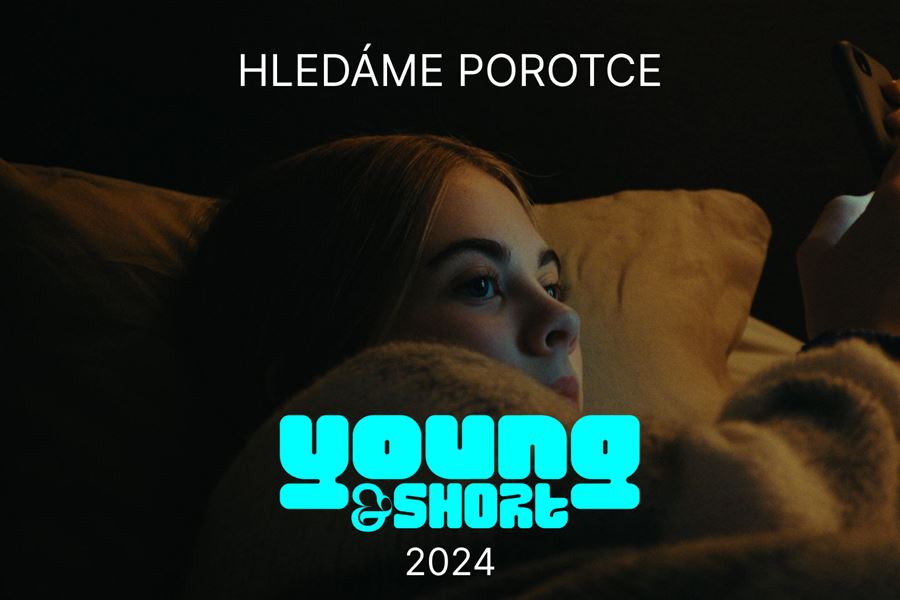
Jak se zapojit jako porotce do Young & Short 2024?
Již potřetí dáváme příležitost vám, mladým divákům, zhlédnout filmy z předních evropských filmových festivalů a vybrat z nich pět, které se díky vám dostanou do českých kin. Pokud chcete stát u zrodu jedinečného filmového pásma a být těmi, kdo o složení filmů v Young & Short rozhodnou, čtěte dál.
__________
Do projektu Young & Short hledáme mladé diváky ve věku 12–14 a 15–19 let, kteří jsou do filmu zapálení a vidí ve filmovém průmyslu svou profesní budoucnost. Pokud se navíc hlásíte na filmové školy, mohlo by vám u přijímacího řízení pomoci naše osvědčení o účasti v programu, kterým budete u přijímaček prokázat svůj zájem o film.
Přihláška
Účast na Young & Short je totiž výběrová. V přihlášce proto budeme chtít, abyste projevili svou motivaci se programu zúčastnit a sdělili nám názor na poslední film, který jste viděli. Bude nás totiž zajímat váš vztah k filmu a vaše schopnost nad filmem přemýšlet (a je přitom jedno, zda se vám film líbil, nebo ne!).
__________
EDIT:
PŘIHLÁŠKY NOVĚ PRODLUŽUJEME AŽ DO 29.ÚNORA!
PŘIHLASTE SE PŘES TENTO FORMULÁŘ
__________
Co díky účasti získáte?
Nejenže budete mít možnost zhlédnout 10 výjimečných krátkých filmů z filmových festivalů, ke kterým byste se jinak neměli možnost dostat – dokonce z nich po diskuzích s filmovými odborníky a ostatními budoucími filmaři sestavíte vlastní filmové pásmo, které objede celou republiku. Současně našim odborníkům pomůžete vytvořit metodické materiály pro speciální projekce a získáte i příležitost se jich sami zúčastnit, svůj výběr filmů před diváky obhájit a projekci s diskuzí vést společně s našimi odborníky. Díky účasti v programu od nás dostanete osvědčení o absolvování, což vám může pomoci ve výběrových řízeních na filmové školy.
Proč Young & Short děláme a považujeme za důležité?
Filmové pásmo Young & Short je totiž určené pro distribuci do českých kin a škol, ve kterých se s festivalovými snímky jen tak nesetkáte, a většinou už vůbec ne s těmi krátkými. A to je velká škoda, protože nám mají takové filmy hodně co předat. To bychom proto s vaší pomocí chtěli změnit.
Kdy a kde probíhá výběr filmů do pásma?
Kde: Kino Kavalírka (Plzeňská 210, Praha 5)
- 12 – 14 let: sobota 2. března 9:30 - 17:00
- 15 – 19 let: neděle 3. března 9:30 - 18:00
Program je v obou případech celodenní a pro vybrané porotce zdarma, oběd je pro účastníky zajištěn.
Filmy jsou buď v češtině a nebo doplněné o české titulky.
_________
Přihlaste se do Young & Short co nejdříve, nejpozději však do 16. února. Těšíme se na vaše přihlášky a na setkání s vybranými porotci o prvním březnovém víkendu. A díky za to, že chcete být součástí distribučního filmového pásma, které charakterizuje svou generaci!
PŘIHLÁŠKA
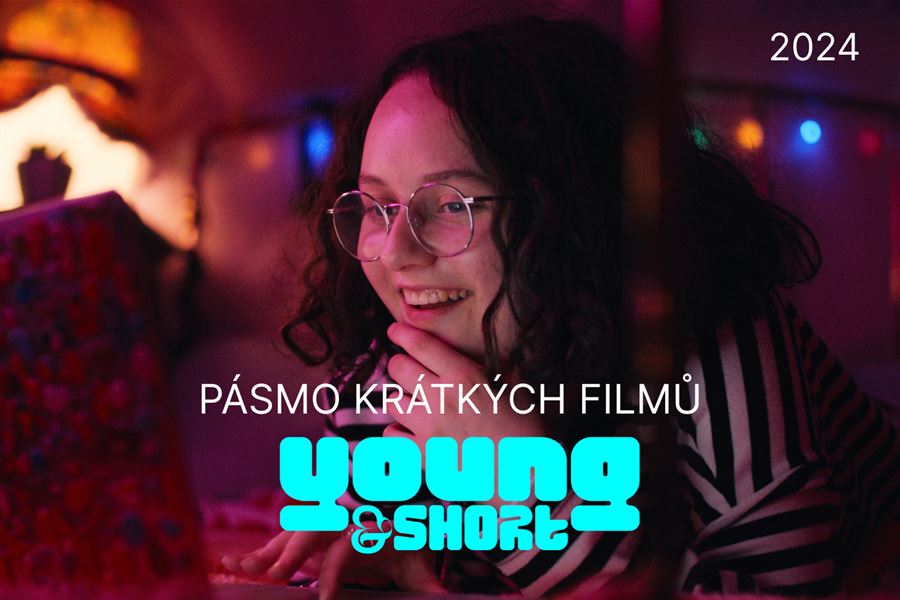
Young & Short 2024
Evropské filmové festivaly na svých plátnech opět představily ty nejkvalitnější filmové počiny z Evropy i ze světa. Dramaturgická rada Young & Short byla u toho a pro letošní ročník projektu z těchto festivalových favoritů vytipovala 10 nejzajímavějších, ze kterých mladí porotci již potřetí sestaví distribuční pásmo Young & Short ve dvou věkových kategoriích.
_________
Mladí diváci ve věku 12–14 a 15–19 let, kteří se chtějí stát letošními porotci, se mohou hlásit do 16. února 2024. V přihlášce mají za úkol projevit svou motivaci, zájem o film a schopnost formulovat vlastní názor na poslední zhlédnutý film.
Mladá porota zasedne o víkendu 2. až 3. března, přičemž v sobotu 2. března je připraven filmem a diskuzemi nabitý program pro věkovou skupinu 12–14 let a v neděli 3. března čeká tento celodenní program porotce ve věku 15–19 let. Filmy jsou buď v češtině a nebo doplněné o české titulky. Účast v projektu je pro vybrané účastníky zdarma.
__________
EDIT:
PŘIHLÁŠKY NOVĚ PRODLUŽUJEME AŽ DO 29.ÚNORA!
PŘIHLASTE SE PŘES TENTO FORMULÁŘ
__________
Sestavené pásmo Young & Short 12+ a Young & Short 15+ nabídneme do distribuce kin v květnu letošního roku. Pro kina a školy připravujeme speciální programy a projekce, při kterých za doprovodu metodických materiálů budou mladí diváci o filmech diskutovat společně s odborníky. Ve třech případech budou moci svůj výběr před diváky obhájit sami porotci a vést s nimi o pásmu dialog.
Těšíme se, se co letošní ročník přinese. Buďte u toho s námi a sledujte cestu kvalitních krátkých filmů z festivalů až do českých kin a škol.
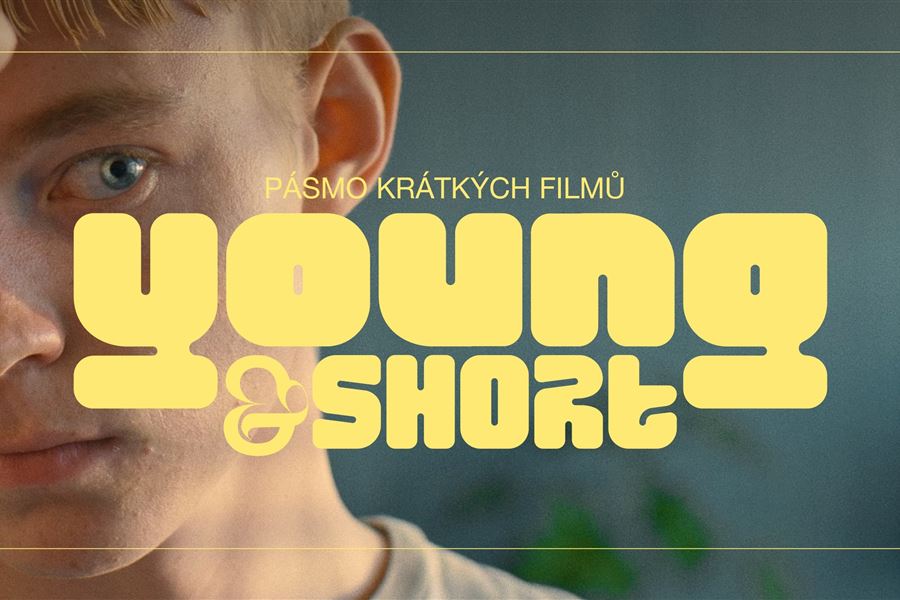
How are the films for the Young & Short selected?
The Dramaturgical Board first selects the 10 most promising festival films for young people, from which it creates shortlists for the 12-14 and 15-19 age groups. From these films, the young jury will then select 5 final films for their age group, from which, after a peer discussion, they will compile a distribution list, which we will distribute to Czech cinemas and schools, offering not only a quality film experience, but also a specially created programme with lecturers' introductions, discussions, interesting guests or workshops.
The organisers of the project will select the most active young people from the applicants through a selection procedure, from which they will form a film jury. In making their selection, the organisers are interested in their motivation, their relationship to film and their opinion of the last film they saw. This not only helps them to find out what films these young people watch, but also tests their ability to reflect on and reflect on the film. In collaboration with experts, they will discuss each of the ten films they have seen, evaluating the individual components of the film as well as its aesthetic quality and originality.
At the same time, the young jurors will participate in the creation of methodological materials that will be used by lecturers and young viewers in special film screenings in Czech cinemas and schools. Three of the selected films will be screened and discussed together with experts by our young jury, who will go to the cinemas to defend their selection. In this way, we will take full advantage of the film-educational potential that lies in this unique film series.
The aim of the project is to bring to young audiences short films selected from the most prestigious European film festivals - such as Cannes, the Venice International Film Festival, Sundance, Berlinale or the Clermont-Ferrand International Short Film Festival. We complement the top European short cinema with prominent Czech film representatives. All this across genres, cultures and film approaches.
Thanks to this, we are able to develop critical and aesthetic thinking in young people in an unconventional and entertaining way. At the same time, we give them the opportunity to inspire each other with their views and attitudes on a peer level.
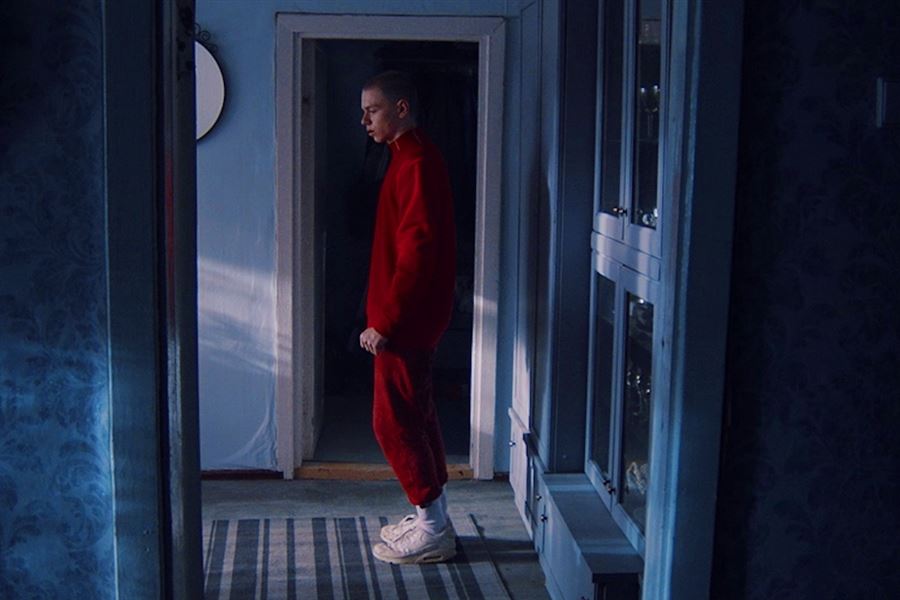
What do the teachers say about the Young & Short? We're glad to hear your feedback!
”Hi, I will try to summarize the student evaluations.
The overall evaluation - in terms of the number of students evaluating and the overall tone of the evaluation - is very good.
The vast majority were positive about the format itself, i.e. short films that had a flow, dealt with different topics and “didn't get boring”. In general, the music of the films was also very positively evaluated, and there was surprise that the films were of a high quality (cinematography, editing, acting, etc.).
All agreed on the excellent evaluation of the films “Criminals”, where the story itself was paralysing, the realism, the tension and the great acting were impressive, as well as “Techno, Mom”, where the theme was perhaps the most “urgent”, raw and convincingly handled, allowed us to identify with the protagonist, and we liked the music of J very much (here we also talked for the longest time about the “message” of the son's departure/escape from his mother), “Wild Minds” was rated as extremely ‘nice’ and touching (here we talked about, among other things, the “wild minds”). We were also very happy to discuss the “minds of the minds” (the main character's “breakthrough”, what the scene with his parents in the shop meant, why/if the son feels responsible for his parents, etc.).
Where the students' opinions differed, as expected, was in the first and last films, which were somehow out of sync with the overall composition (I personally and some others thought this was intentional). I was surprised that, although we are an art school, some were not impressed by Johanna in particular - they described this film as a documentary that “had no story”. The other half of the students, however, understood it and, on the other hand, evaluated the way the film was handled (ala the old Czech documentary) very positively, as if it had been tailor-made for our students - a nice way to start. The last film “Zásvětí” did not allow some of them to “dive” into the story as much as the previous films - the magical-realistic touch was an obstacle, the idea was harder to grasp, there was no character they could identify with. But everyone liked the artfulness of the film.
The students also paid attention to the visual aspect of the films and talked about the colour symbolism (especially in the film “Techno, Mom”). There were also opinions that there could have been more films and some of them deserved a separate film.
Only a few individuals said that the films did not appeal to them at all, as it was not their ‘cup of coffee’ - but these students generally cannot empathise with roles and issues that they do not know and experience themselves, or find uncomfortable (discussed on another occasion).
In conclusion, thanks to all those who participate in YaS - it makes sense.
Best regards and wishing you beautiful and fulfilled days
Markéta Plšková
SUPŠ sklářská Valašské Meziříčí
PS: I know I am not the target group, but I feel the need to say that I was pleasantly surprised and I am not afraid to say - delighted by the level of the films."

The CINEMINI project for children aged 3-6 got its own website
Our project has finally gotten enough space on the web: www.cinemini.cz.
If you are a teacher, parent or tutor, we have a wonderful program for preschoolers.
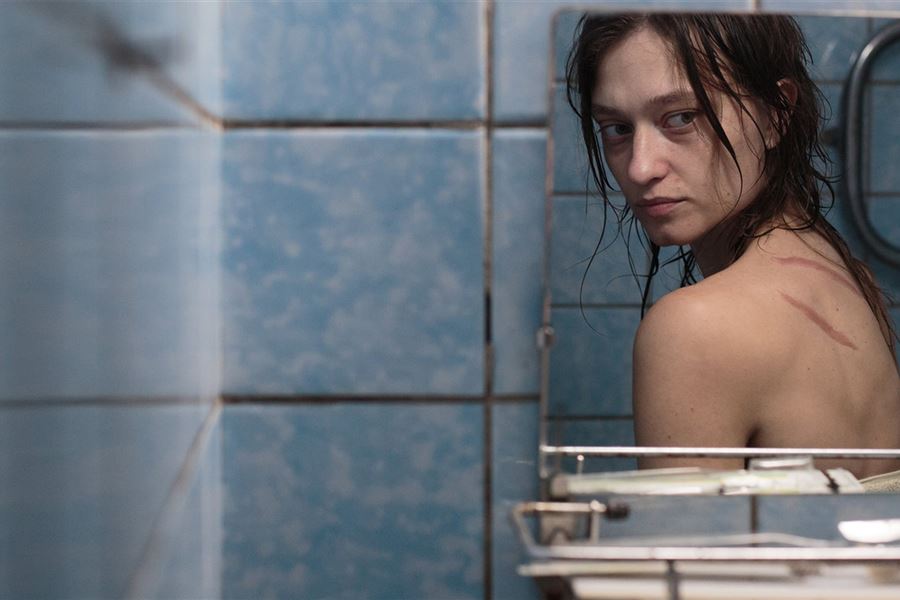
Idealizace obětí je jednodušší, pokud jsou mrtvé, říká režisér filmu o sexuálním násilí ve válce
Pohled motýla jste poprvé představil v sekci Un Certain Regard na festivalu v Cannes minulý rok. Tehdy jste pro magazín Variety uvedl, že se filmový průmysl staví nejen k otázce ruské invaze na Ukrajinu, ale i dalším společenským problematikám (genderovým nerovnostem či rasismu) „elitářsky a pokrytecky“. Jak bychom si to jako diváci po více než 1,5 roku trvající válce měli vyložit?
Reagoval jsem na pokrytectví hnutí MeToo a cen Akademie, uvedly totiž nejzářnější příklad toho, jak se myšlenka a realita ve filmovém průmyslu odlišují.
Oscaři stále opakují, jak se snaží o genderovou a rasovou rovnost, ale reálné číslo žen a osob barevné pleti, které cenu získaly, říká něco jiného. Stále to tak zůstává jen u slov.
U hnutí MeToo je to podobné, taky často zůstane jen u lajkování postů s přiznáním obětí. Harveyho Weinsteina to k soudu dostalo, ale pro oběti je stále náročné získat podporu v boji proti násilníkům a obtěžování od celé branže.
A paralela s válkou na Ukrajině? Pro Hollywood bylo mnohem snazší vyjádřit soustrast a podporu Ukrajině než přestat do Ruska distribuovat filmy.
Vy jste nápad na film dostal po vyslechnutí rozhovorů několika ukrajinských vojaček, které zmínily, že „je lepší pro ženu umřít než padnout do ruského zajetí“. Podobný statement slyšíme ostatně i ve filmu z rádia. Stavěl jste Lilianin příběh na konkrétních, specifických událostech?
Lila nemá žádný konkrétní předobraz v žádné osobě. Je to spíš kolektivní obraz ukrajinských žen-vojaček, který je znázorněn i unikátním zprostředkováním herečky Rity Burkovské.
Pozorovali jsme naše přátele, sledovali mnoho vojaček na sociálních sítích, potkali se s nimi a mluvili. Zažili různé věci, které ve filmu zažívá i Liliana. Nehledali jsme prototypy na kopírování, ale spíše inspirativní paralely. Nejvíc pro nás znamenala autenticita.
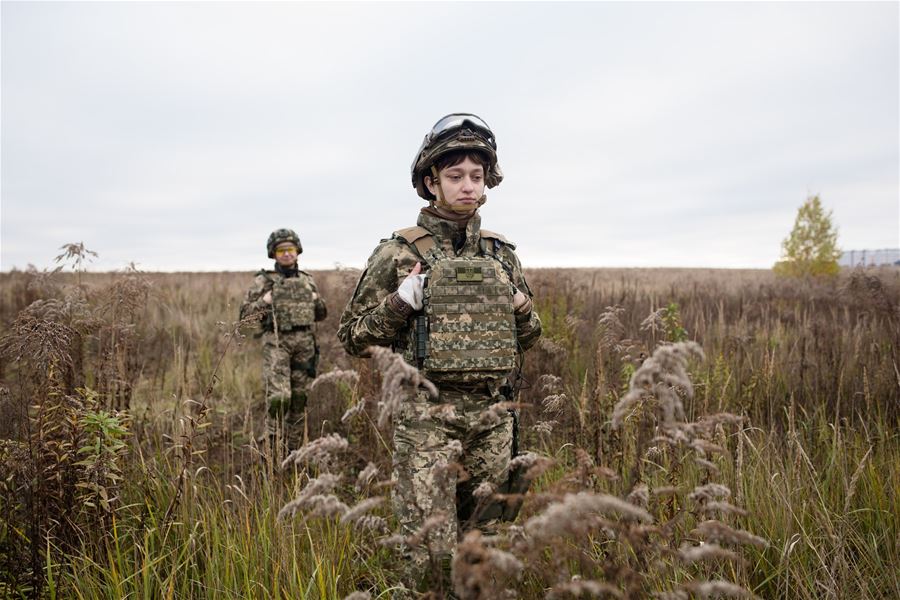
Butterfly Vision vstupuje do kin 14.9.
Ukrajina 2022 | 107 minut | české titulky | přístupný od 12 let | DCP, MP4 | premiéra: 14. září 2023 | konec monopolu: 31. ledna 2033
■ originální název: Бачення метелика (Bachennya metelyka) ■ žánr drama
■ režie Maksym Nakonechnyi ■ scénář Maksym Nakonechnyi, Iryna Cilyk ■ kamera Khrystyna Lizogub
■ hrají Rita Burkovska, Natalija Vorožbyt, Daria Lorenci, Ljubomyr Valivoc, Miroslav Gai
■ programace Anna Puklová, +420 732 350 322, program@krutonfilm.cz, online objednávky v portálu Disfilm
■ synopse
Vojačka Lilja se vrací z několikaměsíčního válečného zajetí na Donbase, kde byla držena tamními separatisty. Kruté zacházení jí způsobilo trauma přepadávající ji v mučivých snech. Jako expertka na vzdušný průzkum viděla dění na frontě z perspektivy dronu – jako manželka v civilu nyní podobně distancovaně vnímá celý okolní svět. Bohatství citů vystřídala bezradnost, lidskost nahradilo strojové chování. Jenže když toužíte jen dál žít svůj život, nemusí být ptačí perspektiva tou nejlepší. Debut Maksyma Nakonečného vypráví příběh tápající ženy, která sveřepě odmítá roli oběti, a citlivě se táže, jak tísnivá může být existence ve společnosti sužované válkou.
■ festivaly
Film získal 5 cen a 26 nominací na renomovaných filmových festivalech.
Ceny:
2022 - Golden Duke na Odesa International Film Festival
2023 - Cineuropa Prize z Trieste Film Festival
a další
V roce 2022 byl film uveden mj. na Cannes Film Festival nebo na Filmovém festivalu v Karlových Varech.

Cinemini 2023
Projekt Cinemini je světově unikátním projektem zaměřeným na předškolní mládež ve věku 3 až 6 let. Původně holandsko-německý projekt poprvé realizujeme v Česku v Kině Kavalírka s mezinárodními partnery. Cílem Cinemini je nabídnout kvalitní krátké a netradičně pojaté filmy pro danou věkovou skupinu a podporovat dětskou imaginaci prostřednictvím speciálně vytvořených aktivit. Cílem doprovodných aktivit je prohloubit dětskému diváku zážitek z filmu a rozvíjet dialog nad jejich pocity a myšlenkami.
Aktivity jsou určeny primárně pro děti ve věku 3 až 6 let.
Jsem učitel*ka
Učíte ve školce nebo vedete kroužky pro děti? Přijďte s dětmi k nám do Kina Kavalírka na Praze 5 na program, který povede zkušený lektor či lektorka. Projekce filmů včetně doprovodných aktivit má 1,5 hodiny, pro max. 20 dětí. Po domluvě lze čas i kapacita přizpůsobit vaším představám. Pro školky rovněž nabízíme možnost navazujících setkání, kdy dětem představíme další filmy a aktivity Cinemini.
Napište nám, že máte o program zájem a domluvíme se na společném termínu!
Jsem rodič
V Kině Kavalírka pořádáme Cinemini i pro rodiče, babičky, dědečky s dětmi. Program trvá 1,5 hodiny a je vedený zkušeným lektorem či lektorkou. Míra zapojení závisí pouze na vás, oceníme však, když budete po ruce s obtížnějšími kreativními či pohybovými aktivitami.
Sledujte program kina a přijďte nás s dětmi na speciální projekci Cinemini navštívit!
Proč je dobré začít s filmovou výchovou již u předškoláků?
Děti v předškolním věku vnímají obrazy a filmy pomocí jedinečné dětské imaginace mnohem intenzivněji. Nechávají je působit na své smysly a při správně zvolené aktivitě si mohou filmový zážitek ještě umocnit.
Je důležité, aby si děti již v útlém věku osvojily komunikaci a přemýšlení nad audiovizuálními díly, se kterými přichází do interakce na denní bázi. Toho se Cinemini snaží docílit filmy odlišných světových produkcí a kultur, které pracují s různorodým vizuálem či technikou. Nejedná se vždy o narativní snímky, ale například abstraktní či experimentální. Chceme, aby si děti zvykly o filmech přemýšlet a mluvit, dokázaly pojmenovat své dojmy, ale rovněž i formální a obsahové prvky.
Tento věk je pro vývoj dítěte a jeho imaginace klíčový. Existuje málo filmově výchovných aktivit pro tuto věkovou kategorii, přestože se s audiovizí setkávají každý den. Tak proč je neučit filmové výchově již od mala? Cinemini pracují s dětským entuziasmem a snaží se udržet rezonující zážitek z filmů pomocí speciálně vyvinutých aktivit. Klademe důraz i na vzájemnou interakci dětí mezi sebou.
O Cinemini Europe:
V roce 2019 vznikl světově unikátní projekt zaměřující se na filmovou výchovu pro děti ve věku 3–6 let. Jedná se o projekt Cinemini a Česká republika se v roce 2023 zařadí mezi několik málo zemí, kde je projekt realizován. Od roku 2019 byl projekt pilotně vyvíjen v Německu a Holandsku ve spolupráci s psychology, pedagogy a lektory a v roce 2020 a 2021 byl naplno realizován v Holandsku a Německu, dále také v Estonsku, Rakousku a Portugalsku. V roce 2019 se setkala nejvýznamnější německá organizace věnující se filmové výchově Deutsches Filminstitut & Filmmuseum e.V. (DFF) s holandským Eye Filmmuseum a Taartrovers a v pilotním roce vyvinuli s řadou odborníků metodiku, design „hracích“ karet (které nahrazují pracovní listy) a systém výběru filmů.
Jak vypadá program a jaké filmy promítáme?
Program probíhá u nás v Kině Kavalírka na Praze 5.
V Cinemini Europe máme k dispozici 26 krátkých filmů. Z tohoto seznamu pro vás sestavujeme vlastní různorodé balíčky.
Aktuální balíček promítaných filmů: Všemi smysly
- PLÁCEK (Tér), r. István Szábo, Maďarsko, 1971, 5min
- BAREVNÁ SKŘÍNKA (A Colour Box), r. Len Lye, Velká Británie, 1935, 3min
- MALÝ COUSTEAU, r. Jakub Kouřil, Česká republika, 2014, 8min
- ŠEST SESTER (Les six sœurs Dainef), r. Neznámý, Francie, 1902, 3min
- VĚCI (Dingen), r. Femke Schaap, Nizozemsko, 2005, 3min
- KLUBKOHRANÍ (Fadenspiele 2), r. Ute Aurand a Detel Aurand, Německo, 2003, 8min
- Program je veden kvalifikovaným lektorem či lektorkou, klademe důraz na dialog s dětmi a po každém promítnutém filmu následuje debata. Jak na vás filmy působí? Jak se teď cítíte? Jaké tam byly postavy a co dělaly? Dále je představena aktivita, která se obsahem či estetikou vždy váže k danému snímku.
Kontakt
Chcete o projektu vědět více info nebo se s námi domluvit na setkání?
Napiště koordinátorce filmové výchovy Nikole Micajové: edukace@kinokavalirka.cz

Hledáme: Vedoucí PR a marketingu + Koordinátor/ka filmové distribuce
Jsme parta lidí kolem spřátelených festivalů a kina. Provozujeme eventové Kino Kavalírka na Praze 5 s Audiovizuálním centrem, organizujeme Mezinárodní filmové festivaly ELBE DOCK a Young Film Fest, realizujeme malou filmovou distribuci. Uzavírka je 31.5. 2023.
Koordinátor/ka filmové distribuce
Hledáme člověka, který se bude aktivně podílet na distribuci krátkometrážních, dokumentárních i hraných filmů do českých kin a na alternativní místa.
Vedoucí PR a marketingu
Hledáme člověka, který se bude společně s vedením podílet na realizaci strategií pro jednotlivé projekty a tyto strategie úspěšně realizuje v online i offline světě (PR, sociální sítě, lehce marketing).
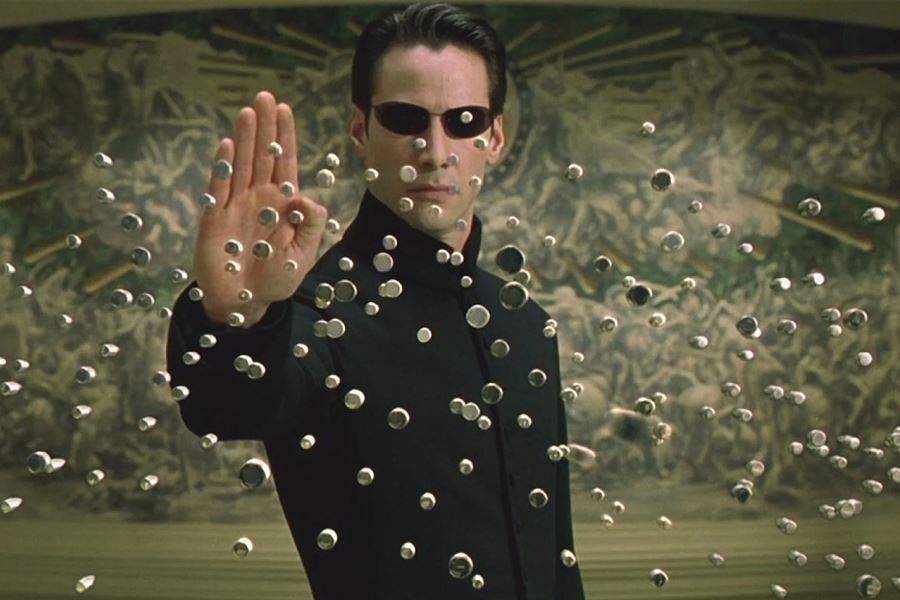
Hledáme: Vedoucí PR a marketingu + Koordinátor/ka filmové distribuce
Jsme parta lidí kolem spřátelených festivalů a kina. Provozujeme eventové Kino Kavalírka na Praze 5 s Audiovizuálním centrem, organizujeme Mezinárodní filmové festivaly ELBE DOCK a Young Film Fest, realizujeme malou filmovou distribuci. Uzavírka je 31.5. 2023.
Koordinátor/ka filmové distribuce
Hledáme člověka, který se bude aktivně podílet na distribuci krátkometrážních, dokumentárních i hraných filmů do českých kin a na alternativní místa.
Vedoucí PR a marketingu
Hledáme člověka, který se bude společně s vedením podílet na realizaci strategií pro jednotlivé projekty a tyto strategie úspěšně realizuje v online i offline světě (PR, sociální sítě, lehce marketing).
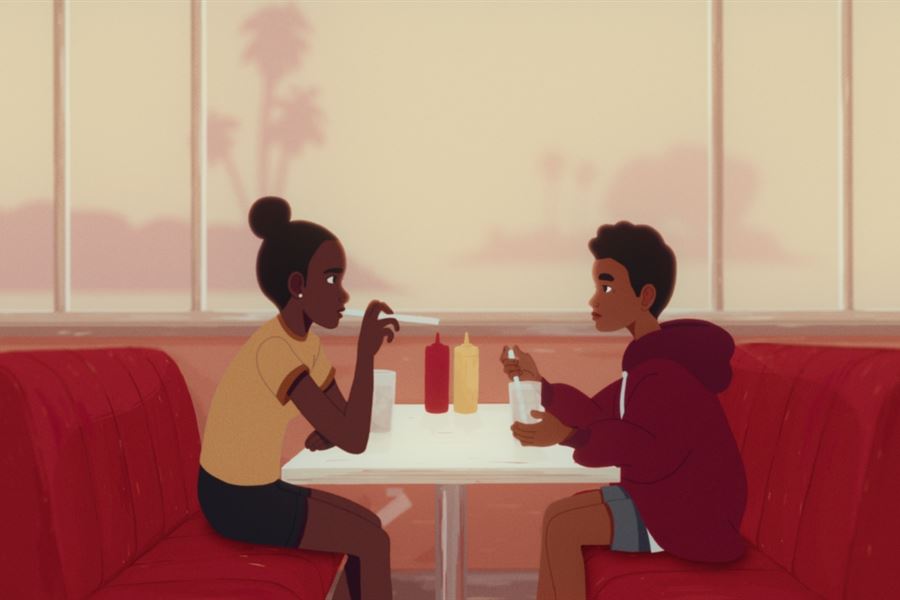
Nově v distribuci od 1.6.: Young & Short 15+
RITUÁLY (r. Damián Vondrášek, Česko, 2022, hraný, 16 min.) Michal se narodil s rozštěpem obličeje, Ondra je ze sociálně slabé rodiny. Oběma je dvanáct, nikdy moc nezapadali do kolektivu. Chtějí se už konečně vymanit z pozice outsiderů, a tak se rozhodnou podstoupit přijímací rituál do místního pouličního gangu. Společně mají jedno odpoledne na to, aby gangu dokázali, že si zaslouží jejich respekt. Lákavé dobrodružství se ale brzo změní v iniciační rituál do dospělosti.
JE TU HEZKY (r. Robert-Jonathan Koeyers, Nizozemsko, 2022, animovaný, 16 min.) Fragmentovaný portrét citlivého černošského chlapce Crimsona, který přijde při policejní střelbě o život. Vzpomínky nejlepší kamarádky se mísí s rozdílnými vzpomínkami střílejícího policisty a ukazují, že osudový okamžik v obchodě na rohu mají oba v paměti jinak…
FLÁVIO (r. Pedro Cabeleira, Portugalsko, 2022, hraný, 27 min.) Márcia je profík na sociální média a zná ty nejlepší pózy a filtry pro dokonalá selfie. S focením jí pomáhá synek Flávio. Přes Instagram se jednoho dne seznámí s populárním rapperem Da Reelem Chullzem, který ji pozve na rande. A přestože se nenajde nikdo, kdo by se o Flávia postaral, Márcia nehodlá odmítnout a synka bere s sebou.
BA-BINEC (r. Angelika Abramovitch, Švédsko, 2021, hraný, 20 min.) Když se do cesty postaví láska, je v sázce mnohé. Pouto mezi dvěma sestrami se přetrhává, když je odhaleno krvavé tajemství. Dívčí záchodky jako místo plné konfliktů, skrze něž se na povrch dere pravda.
MAJÁK (r. Filip Kraus, Česko, 2022, animovaný, 11 min.) Mladý muž je za nejasných okolností uvězněn na opuštěném ostrově v majáků plném knih. Ty jsou nyní jediným smyslem jeho života. Jen čtení ho může osvobodit.
Filmy jsou v distribuci od 1.6. 2023. Objednávat je můžete na emailu: kruton@krutonfilm.cz. Konzultace pro školy a kina v oblasti filmové výchovy a školní projekce v Kině Kavalírka objednávejte na edukace@kinokavalirka.cz.
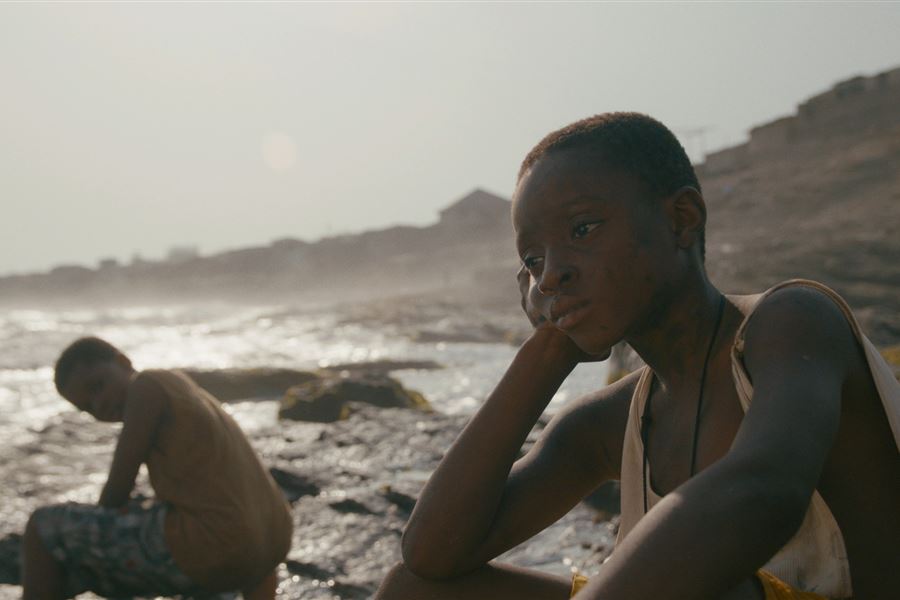
Nově v distribuci 1.6.: Young & Short 12+
YUNG MICHAL (r. Štěpán Vodrážka, Česko, 2022, hraný, 17 min.) Patnáctiletý Michal se na Instagramu prezentuje jako rapper, kterému ke slávě chybí už jen krůček. Ve skutečnosti ale tráví celé dny obracením hamburgerů na místě, ze kterého ještě nikdy nikdo neprorazil. Podaří se mu splnit si svůj sen během dnešního odpoledne?
POSLEDNÍ VÍKEND S JENNY A JOHNEM (r. Jimmy Olsson, Norsko, 2023, hraný, 16 min.) Je víkend a otec John míří s dcerou Jenny do Motaly na její basketbalový zápas. Je víkend, během něhož Johna vyhodí z práce. Je víkend, během něhož chce Jenny nadobro skončit s basketbalem a být více se svými přáteli. Je víkend, během něhož se vztah Johna a Jenny změní.
TSUTSUÉ (r. Amartei Armar, Francie, Ghana, 2022, hraný, 15 min.) Příběh sourozenců Sowaha a Okaie se odehrává v malém ghanském městečku na okraji velké skládky, která se rozprostírá až do oceánu. Chlapci se snaží vyrovnat se ztrátou svého nejstaršího bratra, který se nedávno utopil během rybářské výpravy.
DÍKY, MÁM SE DOBŘE (r. Hannah Lau-Walker, Velká Británie, 2022, animovaný, 2 min.) Dívka při online chatování váhá, jak moc být ve svých zprávách upřímná…
BGIRL BADLI (r. Charlotte De Cort, Belgie, 2022, dokumentární, 15 min.) Mali ví jednu věc jistě – tanec je její život! I když to znamená přestěhovat se do velkého města a změnit školu, bojovat proti překážkám se prostě musí! Mali bude tančit i snít dál.
LUDVÍK I., OVČÍ KRÁL (r. Markus Wulf, Německo, 2022, animovaný, 9 min.) Když se mu před kopyty vykutálí koruna, Louis, ovce jako všechny ostatní, ji popadne, nasadí a stane se králem. Od té chvíle dělá vše, co panovníci dělají, aby zahnali nudu a demonstrovali svou moc.
Pásmo šesti krátkých filmů představuje komplikované vztahy s rodiči, snahu prosadit se na sociálních sítích za každou cenu i poetiku africké kinematografie. Studenti ve věku 12 - 14 let vybrali nejlepší festivalové kraťasy pro své vrstevníky.
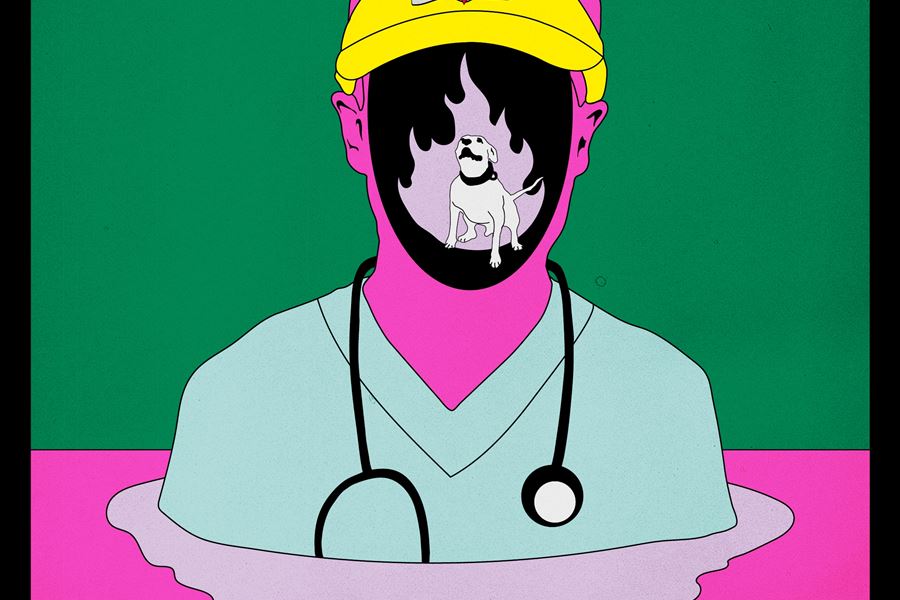
Nově v distribuci od 18.5.: Pásmo kraťasů Nebýt sám představí film oceněný Českým lvem
Pásmo představí filmy pětice nadějných režisérů, jejichž postavy bloudí světem a hledají spřízněné duše. Tato putování jsou plná absurdity, smutku, legrace i děsu… Film Rituály byl oceněn Českým lvem za nejlepší krátkometrážní film. Do kinodistribuce Nebýt sám vstupuje od 18.5.2023.
Atestace (r. Jan Hecht, 30 min.)
V předvečer vánočních svátků nastupuje mladý nezkušený lékař na svou první noční službu. Zkušenější kolegové odcházejí k rodinám a nic nenasvědčuje tomu, že se klidná noc stane bojem o dětský život a profesní i osobní atestací.
Láska od 9 do 5 (r. Jakub Jirásek, 16 min.)
Vyhazovač Riky, se kterým se nedávno rozešla přítelkyně, má před sebou další směnu „na dveřích". Přestože je úterý, tak je tato noc jiná – je Valentýn. Noc, kdy nikdo nechce být sám. Riky je rád, že ji stráví se svými kolegy, Modřínem a Matesem. Na práci toho mají dost. Nezletilí chtějí dovnitř, opilci nechtějí ven a všichni stále ztrácí lístky od šatny. Do toho všeho se objeví Rikyho bývalá přítelkyně a nepřichází sama.
Rituály (r. Damián Vondrášek, 16 min.)
Michal se narodil s rozštěpem obličeje, Ondra je ze sociálně slabé rodiny. Oběma je dvanáct, nikdy moc nezapadali do kolektivu. Chtějí se už konečně vymanit z pozice outsiderů, a tak se rozhodnou podstoupit přijímací rituál do místního pouličního gangu. Společně mají jedno odpoledne na to, aby gangu dokázali, že si zaslouží jejich respekt. Lákavé dobrodružství se ale brzy změní v iniciační rituál do dospělosti.
Yung Michal (r. Štěpán FOK Vodrážka, 17 min.)
Patnáctiletý Michal se na Instagramu prezentuje jako rapper, kterému ke slávě chybí jen krůček. Ve skutečnosti tráví celé dny obracením hamburgerů na místě, ze kterého ještě nikdy nikdo neprorazil. Podaří se mu splnit si svůj sen během dnešního odpoledne?
Zahrada ráje (r. Vojtěch Novotný, 27 min.)
Ukrajinec Matys je outsider, který se s touhou po lepším životě přistěhoval se sestrou do Česka. Situace však není ideální ani zde. Záblesk naděje přichází, když se konečně naskýtá příležitost uplatnění a Matys odjíždí pracovat na chatu v lesích. Její majitelka i magické prostředí ho okouzlí. Otázkou je, jak dlouho pocity radosti a štěstí vydrží…
Materiály pro online komunikaci (trailer, plakát, stills a soc.sítě) zde.
Filmy je možné objednávat na emailu kruton@krutonfilm.cz.

Jedna noc s Marion. Film Moja noc (Ma Nuit) ponúka nový pohľad na intimitu
Ako sa nájsť zmier so stratou blízkej osoby vo veku, keď človek hľadá hlavne sám seba? Debutový celovečerný film francúzskej režisérky Antoinette Boulat, ktorý mal premiéru v novej sekcii Orrizonti Extra na Medzinárodnom filmovom festivale v Benátkach v roku 2021, poskytuje sústredený pohľad na prežívanie zásadnej udalosti v živote osemnásťročnej Marion.
Film Ma Nuit (Moja noc, české uvedenie filmu prebehlo v rámci 5. ročníka Medzinárodného filmového festivalu ELBE DOCK pod anglickým názvem My Night) zobrazuje jeden deň a noc v živote Marion. Tento deň je výnimočný tým, že pripadá zrovna na výročie úmrtia jej sestry, čo je udalosť, s ktorou sa ešte spolu so svojou mamou nevyrovnala. Neprezrádza však za akých okolností Marionina sestra zomrela, sústredí sa len na to, ako táto udalosť poznamenala spôsob, akým Marion dospieva.
Kým je Marion na začiatku noci a kým na začiatku dňa?
V úvode filmu sledujeme konflikt medzi Marion a jej matkou. Tá pozvala kamarátov Marioninej sestry k nim domov, aby si tak spolu mohli pripomenúť toto výročie. So vzniknutou situáciou Marion nesúhlasí, ostro proti matke a jej nápadu vystúpi a nakoniec odchádza von za svojimi kamarátmi. Každá z nich potrebuje iný spôsob, ako sa vyrovnať so stratou blízkej osoby a je zrejmé, že Marion sa o tom nemá s kým porozprávať. Matka na ňu prenáša svoj smútok a nešťastie, ktoré priorizuje. Je to pochopiteľné nakoľko prišla o vlastné dieťa, čo je jedna z najťažších životných situácii, s ktorými sa človek stretáva, ale z pohľadu Marion, ktorá práve dospieva a to bez možnosti zmierenia sa so situáciou, je to nepredstaviteľné a sústredí sa na vlastný smútok a žiaľ.
Dej filmu sa odohráva počas horúceho letného dňa a hlavne noci v Paríži. Marion po čase strávenom v kruhu svojich kamarátov a známych opúšťa skupinu a vydáva sa sama do noci. Prázdne nočné ulice francúzskej metropoly podtrhávajú pocit osamelosti, ktorý Marion zažíva.
Nasleduje plot point, ktorý predstavuje stretnutie s neznámym mladíkom. Alex je na prvý pohľad jednoznačne extrovertný, mladý muž, ktorý si všimol, že Marion odchádza z párty. Alex pôsobí najprv trochu nedôveryhodne a Marion sa ho snaží ignorovať, nakoniec ju však presvedčí o svojich nezištných úmysloch a stáva sa jej sprievodcom, ktorý jej ako jediný dokáže poskytnúť potrebný pocit stability. Alex je pre Marion absolútnym cudzincom, no napriek tomu jej je počas tejto noci bližší než rodina a priatelia. V úvode ich stretnutia je Marion voči nemu obozretná, ale slobodomyseľnosť a dalo by sa povedať, že aj dobrodružná povaha Alexa, ju presvedčia o tom, že čas, ktorý chcela pôvodne prečkať osamote môže stráviť s niekým, kto sa snaží porozumieť jej vnútornému svetu a prežívaniu.
Podmanivá predstaviteľka hlavnej úlohy Lou Lampros
Herečka Lou Lampros vizuálne priťahuje pozornosť a je pomerne jednoduché sa nechať uniesť sledovaním jej prejavov, mimiky a gest. Ako herečka vystupuje prvý krát v hlavnej úlohe a darí sa jej stvárniť Marion v celej komplexnej melancholickej krehkosti. Lou Lampros pôsobí ako modelka a herečka a v jej prejave sa mieša dievčenská krehkosť so ženskou sebaistotou. Vo filme je častokrát zobrazovaná jej tvár v detaile, z ktorej len veľmi ťažko prečítať ďalšie, pridružené emócie, ktoré sa v postave odohrávajú. Zreteľnými znakmi sú však smútok, melanchólia a neschopnosť predstavy vlastnej budúcnosti, či prežívania radosti. Antoinette Boulat priznáva, že pôvodne Lou Lampros nezodpovedala jej predstavám o hlavnej hrdinke, ale že ju presvedčila svojou divokosťou a surovou energiou natoľko, že ju jednoducho chcela natáčať.
Tieto emócie a mentálne stavy sa stali v súčasnosti, ktorá je poznačená post-pandemickou a vojnovou situáciou na Ukrajine, pomerne univerzálnymi medzi mladou generáciou a prehovárajú tak silnejšie aj k ľudom, ktorí nemajú skúsenosť so stratou blízkeho človeka. Postava Marion je scenáristicky, ako aj herecky veľmi dobre postavená a je ideálna pre divácku observáciu. Stelesnenuje žiaľ, ktorý je možné v súčasnosti prežívať z rôznych dôvodov, nielen tých vnútorných, ale aj celospoločenských. Nemyslím, si však, že by Boulat vedome pracovala s obdobnou tézou alebo myšlienkou, ale prostredníctvom intímnej drámy sa jej darí poňať aj širšie tematické spektrum, než si možno pôvodne myslela.
V súvislosti s Ma Nuit by sa dalo hovoriť ako o intímnom lyrickom portréte. Príbeh filmu nie je uchopený podľa klasickej dramatickej štruktúry, ale sústreďuje sa na vnútorné pochody a mentálne stavy hlavnej hrdinky, ktorú má možnosť divák sledovať počas časovo ohraničeného obdobia.
Panta rhei
Vo filme zohráva úlohu aj rieka Seina, jeden zo symbolov Paríža, ktorý možno vnímať ako metaforu Marioninej noci, ako aj metaforu známeho panta rhei. Táto noc je prítomná, jedinečná, neuchopiteľná. Preteká obrazom a v každej časti filmu sa mení. Rovnako ako je Seina v každej časti svojho toku iná, tak sa mení spolu s prostrediami mení aj Marion. A nielen ona, ale aj ročné obdobie, čo je ale zrejme zapríčinené produkčnými problémami a nutnosťou vzniknutia niektorých scén ex post, než že by to bol zámer nakoľko sa to úplne vymyká kontextu celej snímky.
Miestami je jej plynulosť narušená ako napr. v úvodnej časti spoločnej cesty, keď sa Marion vymedzí a odlúči sa od Alexa, tak stretáva dvojicu mužov, ktorí ju začnú obťažovať. Alex sa vráti a pomôže Marion. Táto scéna je jedna z mála, ktoré tok deja násilne brzdí a to nielen agresivitou daných mužov, ale aj pomerne zbytočným umiestnením do príbehu. Akcentuje totiž fakt, že Alex sa ocitá v úlohe jej ochrancu. Jedná sa o príliš zjednodušené jednoznačné gesto, ktoré len podtrháva známe fakty a snaží sa ich zbytočne dovysvetliť. Pritom je evidentné, že samé, mladé dievča kráčajúce v noci mestom je častokrát cieľom obdobných pokusov o obťažovanie, či sexuálne napadnutie, avšak myslím, že takéto priamočiare upozorňovanie na tento fakt je v rámci celkového vyznenia filmu zbytočné.
Alex a Marion sa k tejto situácii vrátia v momente, keď Marion vysvetľuje fakt, že jej Alex zachránil život, čo môže byť pravda, ale v rámci toho, akým spôsobom bola scéna s agresívnymi okoloidúcimi zobrazená, tak trochu prehnaná. Môže to však poukazovať na to, akým spôsobom Marion prežíva interakcie s inými ľuďmi a ako nie je schopná ochrániť seba pred vonkajšími vplyvmi a udalosťami.
V scéne, ktorá na tieto situácie nadväzuje, hovorí Alex Marion, že je príliš seriózna. Marion oponuje „nie seriózna, ale opatrná“, je príznačnou a v skratke opisuje základ Marioninho charakteru. K opatrnosti by sa dala pridať ešte uzavretosť, ktorá ju oddeľuje nielen od vonkajšieho sveta, ale aj sveta svojich kamarátov.
Tom Mercier (známy z filmu Synonyma izraelského režiséra Nadava Lapida alebo seriálu stanice HBO Sme akí sme talianskeho režiséra Luca Guadagnina) poskytuje svojej postave Alexa chlapčenský šarm. Alex v jeho podaní je roztomilým mladým mužom, ktorý však má jasno vo svojich hodnotách a v tom, čo je pre neho v živote dôležité. Netápe ako Marion, prináša jej do života stabilitu, zázemie, ale aj veľkú dávku nekonvenčnosti a originálneho nazerania na svet. Poskytuje Marion bezpečie vďaka, ktorému sa môže uvoľniť a spontánne reagovať. Častokrát sú vo filme zrejmé odkazy na francúzsku novú vlnu a rannú tvorbu Jeana-Luca Godarda, obzvlášť tú zo 60. rokov, a to najmä v momentoch bezstarostnosti v uliciach, ale na rozdiel od jeho postáv vo filme Ma Nuit vidíme, že to Marion stojí veľa úsilia a námahy, len tak byť, bez toho, aby všetko dlho zvažovala.
Po fáze bezstarostného blúdenia mestom sa Marion, po tom, ako sa nechá presvedčiť, aby si potiahla z jointu, znovu ocitá v pasci vlastnej úzkosti. Privodí si zranenie a hoci to vyzerá, že je znovu sama, tak po chvíli sa k nej približuje Alex, aby ju opäť mohol zachrániť a pomôcť jej dostať sa do nemocnice. Alex neočakáva, že by za svoju prítomnosť pri Marion mal recipročne niečo získať, nie je vypočítavý a s ničím nekalkuluje. Záver filmu prezrádza, že je vysoko pravdepodobné, že práve vďaka nemu bude Marionio leto iné, než je zvyknutá, a že sa jej konečne podarilo nájsť niekoho, kto je ochotný a schopný poskytnúť jej potrebné zázemie.
Neskorý debut castingovej režisérky hviezdnych mien
Napriek tomu, že sa jedná o debutový film, Antoinette Boulat rozhodne nie je vo svete filmu žiadnym nováčikom. Časopis Variety ju dokonca označuje ako veteránku francúzskeho filmového priemyslu. Dlhé roky totiž pracuje ako castingová režisérka a spolupracovala s množstvom uznávaných režisérov a režisérok ako napr. Sofia Coppola, Oliver Assayas, Wes Anderson, Leos Carax, Mia Hansen-Løve alebo Lars von Trier. K vlastnému režijnému debutu sa však dostala až pomerne vo vysokom veku, čo však rozhodne nie je na škodu, skôr naopak. K svojim postavám pristupuje veľmi empaticky a vidieť, že sa rozhodla pokračovať v tradícii francúzskej kinematografie, keď stavia dialógy medzi svojimi postavami na filozofickú rovinu.
Boulat použila pre svoj film formát 1:37:1, ktorý korešponduje s jej zámerom sledovať svoje postavy v detaile, bez možnosti širokých záberov na prostredie, ktoré ich obklopuje. Poskytuje tak aj trochu inú perspektívu na mesto samotné, zbavené množstva ľudí, ktorí sa vyskytujú denne v jeho uliciach. Nočný Paríž dodáva filmu atmosféru a Ma Nuit je tak trochu aj jeho nocou so všetkými krásami a nástrahami, ktoré so sebou prináša.
Film Ma Nuit je hlavne štúdiou charakteru hlavnej hrdinky Marion. Je veľmi intímnou výpoveďou o mentálnom stave mladej hrdinky, ktorá nevie ako naložiť s vlastným životom, ktorý len prežíva. Poskytuje dostatok priestoru a času (aj napriek metráži 87 minút) pre pochopenie toho, kým Marion je a čo prežíva, dostatok času na ponorenie sa. Neposkytuje odpovede, skôr prehlbuje otázky. V tom tkvie jeho zaujímavosť, ktorá je však prístupná len empatickému divákovi, ktorý je ochotný si dané otázky klásť a nehľadať vo filme vysvetlenia.
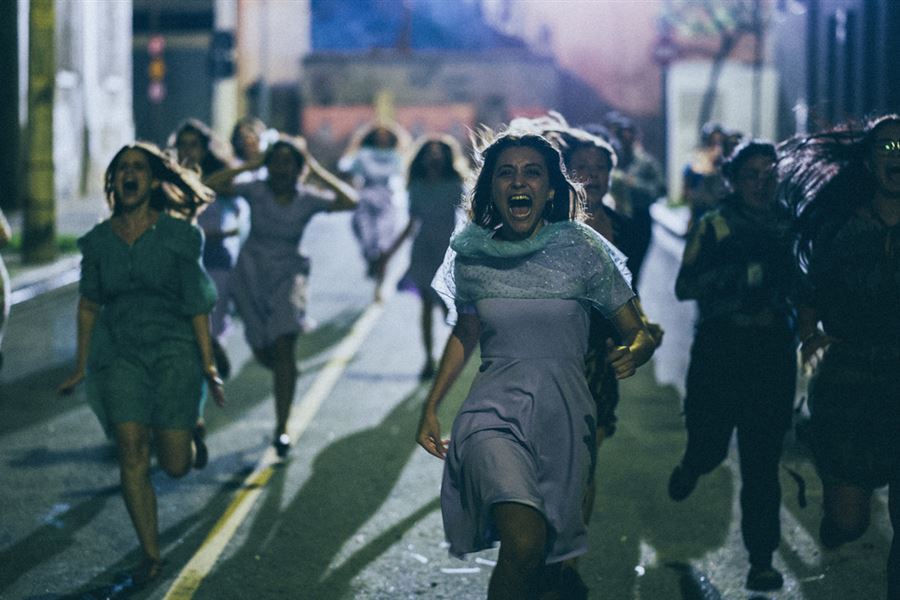
Diskotéka následníkov Ježiša Krista v neónovom osvetlení. Film Medusa je varovaním nielen pre Brazíliu.
Dystopické zobrazenie brazílskej spoločnosti nemá veľmi ďaleko od žitej súčasnej reality. Maskovaný pouličný gang zložený z mladých fanatičiek napadá vo filme Medusa iné ženy.
Obeťami útokov sa stávajú ženy, ktoré sa podľa ich presvedčenia vydali nesprávnym smerom, cestou hriechu a nemravného života. Svoje vyhliadnuté obete nasledujú v temných, nočných uličkách, nebránia sa fyzickému násiliu a nakoniec ich vždy donútia k verejnému priznaniu svojich hriechov natočením a zverejnením videa na sociálnych sieťach.
Druhý celovečerný film režisérky Anity Rocha Da Silveira sa pohráva so žánrami. Mieša horor s neónovým muzikálom a satirickou komédiou, ktorá miestami prechádza až do paródie. Úmerne je tomu prispôsobené aj herectvo hlavných protagonistiek, ktoré by za iných okolností pôsobilo prehnane a neprirodzene. V Meduse sa im však darí vypointovať bizár svojich životov, ktorý je na prvý pohľad úsmevný, avšak na konci má trpkú príchuť reality. Každý, kto má aspoň nejaké povedomie o súčasnej spoločensko – politickej situácii v Brazílii, ktorá sa pod vládou prezidenta Jaira Bolsonara stupňuje, vie, že to, čo Rocha Da Silveira vo svojom filme zobrazuje sa v najväčšej krajine Južnej Ameriky, už deje a napätie sa zvyšuje.
Kto je Medúza?
Názov filmu vychádza z inšpirácie gréckou mytológiou. Medzi Medúzou a Poseidonom malo dôjsť k sexuálnemu styku. Na základe toho sa Aténa rozhodla potrestať Medúzu za stratu jej čistoty a to aj napriek tomu, že zo strany Medúzy zrejme nešlo o dobrovoľný akt. K tomu však Aténa neprihliadala a premenila ju na príšeru s hadmi namiesto vlasov a každý, kto sa jej pozrel do očí skamenel. Medusa mala svetovú premiéru v sekcii Quinzaine des Réalisateurs na festivale v Cannes v roku 2021 a je aktuálne dostupný na platforme HBO Max.
Dvadsaťjedenročná Mariana je členkou náboženského zoskupenia a rovnako aj členkou gangu, ktorý vznikol na pôdoryse tohto kultu. Žije v povrchnom, umelom svete, ktorý sa snaží prezentovať ako ten najčistejší a najdokonalejší. Mariana nespochybňuje nariadenia, ktorými sa riadi a je tak plne oddanou veriacou. Pokorne prijíma aj to, že po tom, ako ju napadne žena, ktorú spolu s gangom prenasledujú, prichádza o prácu v ambulancii plastickej chirurgie. Dôvodom je totiž práve zranenie, ktoré má Mariana na tvári, a ktoré vytvára zlú vizitku pre ambulanciu. Nie je to teda len okruh fanaticky veriacich, kto je v svete, tak ako ho zobrazuje Rocha Da Silveira, prehliadajúci skutočné problémy a kto stavia na piedestál pomyselnú reprezentáciu nad tým, čo sa v spoločnosti a v ľuďoch naozaj odohráva.
Mariana sa v snahe nájsť herečku Melissu, ktorá po napadnutí pred niekoľkými desiatkami rokov ostala v kóme a ktorá sa stala svojim spôsobom urbárnou legendou, zamestná v liečebni dlhodobo chorých pacientov v kóme. Tam sa zoznámi s kolegom, ktorý reprezentuje umiernenú stranu spoločenského spektra a jazykom Mariany a jej kamarátok, ju zvádza na scestie. Mariana podľahne túžbe a príťažlivosti a pozvoľna začína nazerať na svoj život z iného uhla pohľadu. Dostáva sa do konfliktu s najlepšou kamarátkou Michele, ktorá sa vo svojom živote tiež dostala na pomyselnú križovatku a začína si uvedomovať, že život podriadený mužovi, ktorý je síce ukážkovým veriacim, avšak fyzické násilie, ktoré pácha na Michele mu nie je cudzie.
V závere filmu dochádza k prekvapivej revolte a fyzickému stretu medzi ženskými a mužskými nasledovníkmi kultu pastora Guilherma. Krik, ktorý je často v spoločnosti pripisovaný ženskej hystérii pôsobí v posledných minútach Medusy ako akt vyslobodenia, vymanenia sa zo stereotypu a mizogýnie, ktorá ich obklopovala. Ich pohyb v spojitosti s krikom vyjadruje zdesenie, stáva sa z neho nástroj na prezentovanie vlastnej hodnoty a sily.
Priznané inšpirácie hororovými filmami
Anita Rocha da Silveira sa netají tým, že ju pri vzniku filmu Medusa inšpirovali hlavne horory režisérov Brian de Palma a Daria Argenta. Zmieňuje konkrétne tituly ako Carrie (1976) a Suspiria (1977), ktorá sa stala hlavným inšpiračným zdrojom režisérky. Zmieňuje však aj Davida Lyncha. Medusa tak osciluje medzi inšpiračnými zdrojmi a ženskou výpoveďou o stave súčasnej brazílskej spoločnosti. Film má blízko aj nedávnemu brazílskemu festivalovému hitu Bacurau (r. Kleber Mendonça Filho, Juliano Dornelles, Cena poroty na MFF v Cannes 2019). Spája ich zobrazenie neútešnej budúcnosti, ktorá sa prelína so súčasnosťou a používa, aspoň v európskej kinematografii, nezvyklý obrazový jazyk a dejovú líniu. Bacurau je však vo svojom vyznení výraznejší a originálnejší než Medusa. Tematicky a vizuálne, napríklad štylisticky príznačným využívaním neónových svetiel má však film dosť blízko k snímke Boží láska (r. Gabriel Mascaro, 2019). Rozdiel medzi týmito filmami je hlavne v tom, že Medusa sa podľa slov režisérky odohráva v paralelnom vesmíre prítomnosti, tak dej Boží lásky je zasadený do roku 2027. Z tohto pohľadu by Medusa mohla byť predzvesťou Boží lásky v zobrazení prípravy na transformáciu spoločnosti v mene Ježiša. Obidva filmy však spája protest proti kresťanskému fanatizmu a politiky, ktorú aktuálne reprezentuje Jair Bolsonaro.
Medusa pracuje s mnohými znakmi a metaforami, prináša myšlienky, ktoré nie sú nové, ale v tejto zhustenej 127 minútovej podobe a v kontexte doby svojho vzniku, vytvárajú obraz súčasnej Brazílie, o ktorom sa u nás hovorí len okrajovo. Nie je to však film, ktorý by zobrazoval a pomenúval len lokálne brazílske témy, javy a problémy. Momentálna situácia na Slovensku je toho príkladom. Spojenie fanatizmu s tzv. tradičnými kresťanskými hodnotami a nacionalizmom eskaluje do takých rozmerov, kde príslušníci samozvaného „holubičieho národa“ fyzicky napádajú a vraždia ľudí, ktorí sa na základe týchto ideológií stávajú nepriateľmi a narušujú spokojný život v „našej“ krajine. Hlavné zdelenie filmu Medusa sa tak stáva univerzálnym naprieč kontinenatami a historickou skúsenosťou lebo pomyselné ohrozenie tradičných hodnôt a spôsobu života je aktuálne takmer všade.

Všade a nikde. Hlavná hrdinka filmu Zero Fucks Given neverí na zmenu
Debutový film režisérskej dvojice Marre a Lecoustre Zero Fucks Given je psychologickou drámou z prostredia nízkonákladovej leteckej spoločnosti a zároveň aj jej spoločenskou kritikou.
Originálny názov belgicko-francúzskeho filmu „Rien à foutre“ je len ťažko preložiteľný do slovenčiny, či češtiny, tak aby jeho preklad nevyznel príliš vulgárne. Anglický názov titulu, ktorý sa stal univerzálne používaným v súvislosti s týmto filmom je Zero Fucks Given a odzrkadľuje sa v ňom charakter hlavnej postavy Cassandry.
Cassandra je totiž na prvý pohľad stelesnením hesla zero fucks given a to v takom zmysle, že jej je ukradnutý celý svet v rovnakej miere, ako aj vlastný život. Pracuje ako letuška vo fiktívnej nízkonákladovej leteckej spoločnosti Wing a svoj voľný čas, v mieste konečnej destinácie jej letu, trávi na párty, Tinderi alebo vozením sa na elektronickej kolobežke po promenáde. Zdá, že ju nič netrápi, že nemá žiadne vízie, ani sny, ktoré by chcela v živote dosiahnuť na rozdiel napríklad od svojich kolegýň, pre ktoré je najvyššia životná méta byť letuškou v „naozajstnej“ spoločnosti Emirates. Cassandra sa javí byť spokojná tam, kde sa nachádza a v tom, čo robí. Avšak nie je tomu tak, spokojnosť je totiž tým posledným, čo z Cassandry vyžaruje. Je to skôr smútok, rutina a profesionálna deformácia v spojení s medziľudskou chladnosťou a vnútornou prázdnotou, ktorá paradoxne môže u niekoho budiť dojem spokojnosti.
Dokument v hranom filme?
Spôsob, akým je na Cassandru upriamená pozornosť kamery, ako aj celkového vyznenia, či atmosféry filmu je z veľkej miery dokumentárny. Voľba obsadiť herečku Adèle Exarchopoulos (známa hlavne vďaka filmu Život Adèle) však tento dokumentárny štýl neguje a výrazne podtrhuje, že sa jedná o hraný film. Adèle Exarchopoulos je na palube lietadla a v prostredí letiska jedinou profesionálnou herečkou, zvyšok obsadenia tvoria reálni zamestnanci leteckých spoločností.
Cassandrino správanie a vnímanie sveta v zmysle filozofie carpe diem alebo súčasného YOLO (You Live Only Once) prúdu vychádza zrejme zo smrti jej matky, ktorá zahynula pri dopravnej nehode. V spojení s touto udalosťou vyznieva Cassandrina reakcia na fakt, že by mala premýšľať o svojej budúcnosti zmysluplne, naberá na hlbšom význame, než by sa najprv mohlo zdať. Cassandrina skúsenosť s náhlou stratou blízkej osoby ju môže jednoducho utvrdiť v tom, že nemá význam a zmysel snažiť sa niečo dokázať v živote, ktorý je pominuteľný. Zároveň tu je aj akýsi tlak spoločnosti, ktorá od jedinca vyžaduje, aby sa snažil, vyvíjal a niekam to dopracoval, ale len v profesionálnej sfére, nie v tej osobnostnej.
Pre mňa je Cassandrino rozhodnutie stať sa letuškou sprevádzané túžbou uniknúť od bolesti, smútku a neuchopiteľného zmaru, v ktorom sa ocitla po smrti matky a hľadaní svojho postavenia v súčasnom svete. Priestor s jasne vymedzenými pravidlami, štruktúrou a zároveň nemožnosťou nadväzovať hlbšie osobné vzťahy k ľuďom a miestam, je pre Cassandru spôsob, ako sa odosobniť od vlastného prežívania. V konverzácii s kolegami si Cassandra uvedomuje, že je medzi zamestnancami spoločnosti Wing najdlhšie. Nevie to však z hlavy, musí to skontrolovať na svojom Instagrame, ktorý jej slúži ako vizuálny denník na zachytenie momentov z jej, doslova, rozlietaneho života.
Zero Fucks Given je celovečerným debutom režisérskej a scenáristickej dvojice Emmanuel Marre a Julie Lecoustre. Film mal svetovú premiéru v rámci Týždňa kritiky na festivale v Cannes 2021. Marre a Lecoustre spolupracovali už na stredne metrážnom filme „D’une chateau l’autre“, za ktorý v roku 2018 v Locarne získali ocenenie Pardino d’oro pre najlepší krátky film v sekcii Pardini di domani. V širšom ponímaní sú však neznámymi autormi a až filmom Zero Fucks Given dávajú o sebe vedieť, hoci stále len v rozpätí svetových filmových festivalov. Marre a Lecoustre sa rozhodli, že pri príprave filmu Zero Fucks Given chcú pracovať len s malým týmom a autentickým prostredím. Zhodujú sa na tom, že v rámci svojho režijného rukopisu preferujú skôr detail na zraniteľnosť, ktorá pohne divákmi nad technickou presnosťou a kontrolou.
Obrazy mladých žien 21. storočia?
Film Zero Fucks Given nie je len voyeurskou sondou do života letušky, ale zároveň taktiež portrétom mladej ženy, ktorá z rôznych dôvodov odmieta prijať zodpovednosť za svoj život.
V tomto vnímaní seba a svojej existencie je Cassandra v niečom podobná postave Marion z filmu Ma Nuit (r Antoinette Boulat, 2021), ako aj Julii z filmu Najhorší človek na svete (r. Joachim Trier, 2021). Spája ich určitá bezradnosť v navigovaní vlastného života. Julie je ale vo filme zobrazovaná v rôznych obdobiach svojho života, zatiaľ čo u Cassandry vidíme len určitý výsek, ktorý však podľa dostupných informácii a indícií netrvá krátko. Hrdinka Zero Fucks Given nehľadá stále nové podnety a zamestnania, ktoré ju v danej chvíli majú naplňovať a nepristupuje k životu, ako ku projektu, ale letargicky zotrváva pri rovnakej práci, ako aj spôsobe trávenia voľného času bez širšieho registra vonkajších znakov vlastných emócii. Cassandra však na prvý pohľad nepôsobí nešťastne alebo depresívne, jej životný postoj je skôr na myknutie plecom a v skratke by sa dal aj popísať ako „nejako bolo, nejako bude“ s prihliadnutím na to, že Cassandra nemá predstavu, ako by to malo byť lebo v jej živote nastala stagnácia a rezignácia na fakt, že sa môže uberať aj iným smerom.
Po lete 2022, keď nastal na európskych letiskách najväčší chaos a mnoho letov bolo zrušených, či omeškaných kvôli nedostatku personálu na letiskách a v jednotlivých nízkonákladových leteckých spoločnostiach, ktoré súvisí s predchádzajúcimi obmedzeniami v doprave a turizme podmienenými opatreniami proti šíreniu ochorenia covid-19, sa na film Zero Fucks Given môžem dívať s trochu inou optikou, než tomu bolo predtým. V scéne, keď štrajkujúci muži na letisku presviedčajú Cassandru a jej kolegyne, že by sa mali k štrajku pridať nakoľko aj ony majú nevhodné pracovné prostredie a podmienky, Cassandra hovorí, že neverí na zmenu, a že jej to je v konečnom dôsledku aj tak jedno nakoľko netuší, čo bude zajtra. Je to jedna z mála scén, v ktorej vidíme Cassandru hovoriť skutočne za seba. V časti deja, keď sa vracia domov do Belgicka totiž pred rodinou a známymi prezentuje prikrášlenú podobu svojho rozlietaného života.
Medzi oblakmi už nie je priestor pre osobný život
Režisérske duo Marre a Lecoustre vo svojom filme zobrazuje kritiku pomerov v nízkonákladových leteckých spoločnostiach subtílne, ale pritom priamočiaro a veľmi jasne. Prostredníctvom jednotlivých scén a obrazov približujú svet, do ktorého jeho zamestnanci nesmú prenášať žiadne emócie, ktoré vnútorne prežívajú (obzvlášť tie, ktoré letecká spoločnosť vyhodnocuje ako neradostné) a musia sa stať usmievavým maskotom značky, ktorú reprezentujú. Rozdiely medzi scénami z pracovného prostredia a súkromného života Cassandry sú zrejmé zo spôsobu snímania a použitia farieb, sú teplejšie. Cassandra je v nich zobrazená bez povinného pracovného make-upu a oveľa zraniteľnejšie, než v uniforme, ktorá ju istým spôsobom dehumanizuje.
V závere filmu sa Cassandra vďaka úspešnému pohovoru dostáva do súkromnej leteckej spoločnosti so sídlom v Dubaji. Pohovor prebieha online a spĺňa všetky klišé, ktoré s pracovným pohovorom súvisia. Počas neho je možné pozorovať Cassandrinu profesionalitu a znalosť daného prostredia a to najmä v podobe jej odpovedí, ktoré sú extrémne pro-klientské a pro-aktívne. Pohovor však v niektorých aspektoch prekračuje isté hranice, najmä v momente, keď je Cassandra vyzvaná, aby sa prešla pred kamerou alebo je postavená pred hypotetickú situáciu sexuálneho obťažovania zo strany klientov resp. hostí, ako ju počas pohovoru opraví predstaviteľ tejto súkromnej aerolinky.
Nemohla som sa ubrániť pocitu ľútosti, ktorý vo mne záverečná scéna Cassandry sledujúcej známu fontánu spolu s ďalšími návštevníkmi. Tento pocit pramení z toho, že si defacto nijako nepomôže, skôr pohorší tým, že sa už úplne stratí svoju osobitosť a osobnosť zároveň a zostane jej len úsmev a rýchle riešenie krízových situácii pre zbohatlíkov, Tinder a hotelové izby. Práve toto vierohodné vykreslenie duševného rozpoloženia hlavnej hrdinky robí zo Zero Fucks Gives pozoruhodný debut a z dvojice Marre a Lecoustre autory, ktorých sa môže vyplatiť sledovať.

Disorder Shorts: krátké filmy z festivalu v Göteborgu zrcadlí svět podle vlastních pravidel
Znuděný mladík v kostýmu ledního medvěda při kontrole teploty v thajském metru. Nemocná prasata u plotu mezi Dánskem a Německem. Radikální převýchova mladých mužů v růžovém matriarchátu. Tělo jako platforma traumatických zkušeností. Strasti a radosti dospívání ve stínu alkoholické matky. Pásmo krátkých filmů zkomponované dramaturgy filmového festivalu v Göteborgu vychází z jejich tematické sekce Focus: Disorder, která zkoumala vztah mezi řádem a jeho narušováním. Filmy (převážně) mladých tvůrců z Thajska, Dánska, Francie, Finska a Norska zároveň s nadhledem reflektují témata rezonující současnou společností.
Snaha o narušení zaběhnutých pořádků
Festival ve švédském Göteborgu je tradiční filmovou přehlídkou, která se zaměřuje na prezentaci nejnovějších filmů evropského a světového arthousu. Jelikož se jedná o největší skandinávskou filmovou akci, velký důraz je kladen na industry program a trh. Speciálního nebo doprovodného programu, či snad dokonce večírků, kde by se mohlo setkávat běžné publikum, tu je jako šafránu a festivalovou atmosféru připomínají hlavně úvody před filmy a občasné diskuze s tvůrci. Jedním z mála originálních programů je tak sekce Focus: Disorder, která tím trochu narušuje i řád samotného festivalu.
Sekce tematizuje přítomnost řádu a pravidel na úrovni společnosti, rodin i jednotlivců, a to i s ohledem na zkušenosti uplynulých let. Zkoumá vliv pandemie na svět i současnou kinematografii. Snaží se na chvíli pozastavit a zeptat se, kolik řádu v našich životech vlastně potřebujeme i co se děje těm, kteří jej záměrně narušují. Je příznačné, že se nad tím pozastavují právě ve Švédsku, kde řešili pandemii s ojedinělým minimem restrikcí. Demokratická společnost je zde zároveň již vyspělá a podobné úvahy si může dovolit. „Žijeme v době, kdy mnozí vidí řád a strukturu jako odpověď na všechno. Posledních pár let zároveň jedinečným způsobem poukázalo na to, jak je vlastně v různých společnostech udržován pořádek,“ popisuje dramaturgický záměr umělecký ředitel festivalu Jonas Holmberg.
Celovečerní část programu obsahovala snímky jako Smolný pich aneb pitomý porno (Babardeala cu bucluc sau porno balamuc , 2021) rumunského režiséra Radua Judeho, Land of Dreams (2022) od íránské fotografky Shirin Neshat, nebo rodinné tchajwanské drama The Falls (2022), jehož autorem je režisér Chung Mong-Hong. Jelikož se jedná o filmy, které by se pravděpodobně na festival dostaly i bez existence této sekce a jen do ní přirozeně zapadly, za zmínku stojí především blok krátkých filmů.
Nová realita kolektivní zkušenosti
Pásmo Disorder Shorts příhodně zahajuje film New Abnormal (2021), který kriticky i s humorem vystavuje vysvědčení thajské reakci na zmíněnou celosvětovou pandemii. V pečlivě komponovaných záběrech snímek předkládá humorné momenty související s každodenním životem za časů covidu. Jde například o setkání se známým na veřejných záchodcích, s kterým si musíte potřást rukou, i když jste si ji právě pracně vydrbali. Anebo sledujeme ostrahu metra měřící teplotu muži v kostýmu obřího ledního medvěda. Postupně se však přidávají temnější tóny. Motorkář s donáškou jídla skončí pod koly auta, protože se snaží stihnout večerku, svérázný muž bez domova popisuje, že vláda nabízí granty, pro které se musíte registrovat online, ale on nemá k internetu přístup a nakonec i samotná vláda, která cynicky vydává nařízení tak, aby pro ni byla co nejvýhodnější.
Po celou dobu si však snímek zachovává lehkost a nadhled a všechny vážné momenty nakonec obrátí v úlevný vtip, se kterým se obyvatelé zemí napříč všemi kontinenty nyní dokáží ztotožnit. Ze všeho nejvíce tak film thajského režiséra Sorayose Prapapana připomíná důležitost celosvětové kolektivní zkušenosti, které se s určitým odstupem času můžeme všichni společně zasmát.
Ploty mezi sny a skutečností
Nadějná mladá scenáristka a režisérka Hilke Rönnfeldt, která byla vybrána například mezi účastníky a účastnice Berlinale Talents 2021, se narodila v severním Německu, má dánsko-islandské kořeny, studovala ve Švédsku a nyní působí v Kodani. Hranice národních států tak přirozeně překračovala po celý život a nyní k jedné z nich upíná zvýšenou pozornost. Snímek Fence (2021) neboli Plot se zabývá konkrétním plotem mezi severním Německem a Dánskem, který zde byl vztyčen, aby oddělil nemocná divoká prasata od těch farmářských. Kontroverzní stavba se vkrádá do snů jedné ze dvou hrdinek, které snímek zachycuje. Podivný sen nutí Ebbu přemítat o reálných hranicích, hranicích reality i hranicích ve vztahu s její přítelkyní.
Civilně a velmi přirozeně zachycený vztah střídají snové, temně poetické až symbolické záběry prasat, bláta, plotů a okolní promrzlé krajiny. Celá situace je velmi specifická, a třebaže by snímek rád popisoval obecně platné emoce, mnoho prostoru pro vcítění se do děje během jedenáctiminutové stopáže nedává. Navíc je odvyprávěn ve velmi jemných a nejednoznačných náznacích. Tak jemných, až je za těžko odhadovat, jak silně dokáží na diváka zapůsobit.
Růžový fašismus jako zmatená reflexe patriarchátu
Potemnělou nejednoznačnost filmu Fence razantně střídá pastelová didaktika Hemale Education(2021). Mladíci v těsných stříbrných slipech, přísné ženy v růžových kostýmcích, jen pár kuliček hrášku denně, kobliha jako ultimátní trest a cvičení, cvičení, cvičení. Vyhrocená vize radikálního matriarchátu mladé norské režisérky Frøydis Fossli Moe ukazuje odpornou převahu jednoho pohlaví nad druhým. Extrémní, absurdní a úmornou. Ve své podstatě však ne nutně nepodobnou té, kterou ženy v reálném světě prožívají běžně, když si pod diktátem ideálu krásy musí dávat pozor na každé kilo a pod náporem sexuálního obtěžování i na každý pohyb. Alespoň to je sdělení, které autorka dle rozhovorů chtěla filmem předat. Výkladových rovin je tu však víc a ani jedna není úplně uspokojivá. Například růžový fašismus operující s širokými úsměvy a rafinovanými tresty působí jako velmi schematická odpověď na často diskutovanou otázku „Jak by to vypadalo, kdyby světu vládly ženy?“
Uprostřed barokního zámečku se v rytmickém střihu opakují stále stejné činnosti a vývojem prochází pouze platonický vztah dvou mladíků, který jediný jim doposud skýtal určitou útěchu. Jeden z nich však nesnesitelný a nesmyslný nápor nevydrží a zhroutí se. Tím upadá do deprimované letargie i ten druhý a postupně chřadne i on.
Nejjasněji tak ze snímku vyvstává, že síla přátelství či lásky je nezměrná a že fašismus v
jakékoliv podobě je špatný. V tomto barevně a kompozičně až fetišisticky vycizelovaném snímku bychom určitě našli i další vrstvy, ale všechny budou podobně povrchní a nepromyšlené. Ve výsledku tak dílo může působit jako lehce nevyspělá pseudo-feministická manýra, která se vyžívá v provokativně sladké estetice, ale hlubší reflexe této problematiky zatím není schopna.
Drásavý manifest proti útlaku
Žánrovou pestrost pásma potvrzuje zařazení audiovizuálního dílaScum Mutation (2020) od OV (hybridního umělce z Francie), které by mohlo být stejně přirozeně prezentováno i v galerijním prostředí. Experimentální dokumentární animovaný počin plně využívající expresivní jazyk současného umění zpracovává téma posttraumatické stresové poruchy a osobních i kolektivních traumat. Je zoufalým, agresivním i posilujícím výkřikem proti současným formám útlaku. Je skrz na skrz radikálním manifestem proti utrpení těla i duše. Je extrémně nepříjemným útokem na všechny naše smysly.
Scum Mutation za použití velké škály výrazových prostředků přibližuje téma i samotnou zkušenost s PTSD. Vypjatá audiovizuální koláž přes sebe vrství zvukové záznamy z demonstrací i zatýkání protestujících, v titulcích cituje necitlivé výroky policejních důstojníků i povzbudivé manifesty mnohých myslitelů a myslitelek. Vizuální složka pak chrlí a modifikuje vzdáleně antropomorfní zmutované a umučené tělesné schránky. Kamera si vypůjčuje pohyby i zaměřovače z videoherního prostředí a spolu se stále se stupňujícím noisově-industriálním zvukem zintenzivňuje až fyzickou nesnesitelnost diváckého zážitku.
Díla pracující s médiem pohyblivého obrazu a tematikou traumatické zkušenosti se v poslední době v galeriích objevují poměrně často, což odpovídá současnému progresivnímu levicovému diskursu, který se snaží (někdy až křečovitě) podobná témata otevírat. Málokteré audiovizuální počiny jsou však tak niterně radikální, naprosto nekompromisní a především drásavě upřímné. A právě díky tomu věřím, že Scum Mutation dokáže diváka (ať už je jeho pozice jakákoliv) skutečně hluboce zasáhnout.
Křižovatka poslušnosti
Vizuální vydechnutí přináší následující film finského režiséra Risto-Pekky Bloma The Human Torch (2022), který naopak pracuje s naprostým minimem výrazových prostředků. Statický šestiminutový snímek zachycuje přechod pro chodce uprostřed klidné noci na indiferentním finském maloměstě. Sleduje spořádané místní občany, kterak poslušně čekají, až jim naskočí zelená, i když je silnice úplně prázdná.
Symbolická jednozáběrovka na půdorysu obyčejné křižovatky rozvádí mnohovrstevnatou úvahu o vnímání (nepsaných) pravidel slušného chování a slušného života. Nenápadně ukazuje jejich slepé dodržování, zdravé narušování i úplnou ignoraci. Ale především zhmotňuje frustraci, která přichází, pokud máme pocit, že pravidla neplatí pro všechny stejně. The Human Torch se prostřednictvím vypravěče dotýká tématu soužití imigrantů a původních obyvatel a nastiňuje možný vývoj některých znepokojivých až nesnášenlivých myšlenek. Nakonec se ale může ukázat, že největší nebezpečí a narušení na nás číhá z vlastních řad.
Mezi námi opilými děvčaty
Pásmo zakončuje energický snímek Gym Party (2021), který vychází z tradice kvalitní skandinávské coming-of-age tvorby. Dánská režisérka Sif Lina Lambæk na ploše pětadvaceti minut rozehrává komplexní příběh o dospívání prosycený alkoholem, magickým realismem, úzkostí teenagerů a euforickou párty náladou.
První večírky, první lásky, první zvracení do klína. Dospívání je dost náročná záležitost sama o sobě. Sally navíc všechny ty radosti puberty prožívá ve stínu své alkoholické matky, ve kterou se sveřepě nechce proměnit. Ale zůstat střízlivý v přítomnosti pařících puberťáků je pro patnáctiletou dívku (i pro kohokoliv jiného) nadlidský úkol. A tak se Sally pod nátlakem vysněného kluka a pod náporem levného alkoholu začne ve svou matku skutečně proměňovat. Motiv záměny matky a dcery známý z několika verzí filmu Freaky Friday (Podivný pátek 1976, Freaky Friday 1995 a Mezi námi děvčaty 2003) je zde sice spíše symbolický, ale zato pracuje s mnohem temnějším kontextem, než je jen nespokojenost s vlastním životem.
Lambæk zde výborně pracuje s mladými herečkami a herci, kteří podávají velmi přirozené výkony, až máte skoro pocit, že jste se na ulepené oblastní diskotéce ocitli s nimi. Kdo naopak herecky pokulhává, je Charlotte Fich. Původně v roli věčně opilé matky a následně v roli poprvé opilé Sally působí na parketu mezi teenagery až příliš krkolomně a jinak kvalitně odvedené filmové práci trochu sundavá body.
Nadhled nebo naivita?
Celosvětová pandemie, problematické vztahy, genderová nerovnost, posttraumatická porucha, porušování pravidel a dopady závislostí. Ale také humor, poetika, sebejistá estetika a upřímný zájem o věc. Disorder Shorts nastavují zrcadlo současnému světu podle vlastních pravidel. Nepředkládají jen generický výčet aktuálních problémů, ale především poměrně přesně mapují způsoby a intenzitu kritiky ve společnosti. Někdo používá humor, jako obranný mechanismus, aby se nezbláznil. Další se introspektivně noří do vlastního vesmíru. Někteří se snaží na problém rafinovaně upozornit, ale moc jim to nejde a spíš někoho omylem urazí. A jiní zoufale křičí a bijí na poplach. Dohromady tak filmy ukazují různé možnosti individuálních i celospolečenských reakcí na krizové situace a zároveň i různé možnosti filmového zpracování. A stejně jako chybuje celá společnost, chybují občas i tvůrci. Každý z nich má ale svůj vlastní úhel pohledu a poctivě a s nadhledem se jej snaží předat. Některým se daří s publikem komunikovat lépe, jiným méně a někdy lze jejich nadhled dokonce chápat spíš jako naivitu a nevyzrálost. Nikoho ale nelze osočit z lenosti či laxnosti.
Disorder Shorts i celá sekce Focus: Disorder tak ze všeho nejvíc ukazují, že existují tvůrci, kteří se nebojí reagovat na zcela aktuální témata, což například v Čechách ještě do nedávna nebylo zvykem skoro vůbec. Snaha za pochodu reflektovat komplikovanou současnost se cení a občasný přešlap nebo řemeslná nedokonalost se dají lehce odpustit. Dramaturgové festivalu zároveň dokázali, že je možné složit pásmo krátkých filmů o palčivých problémech dneška a nebrat se přitom smrtelně vážně. (Což je poloha, která by například kurátorům současného výtvarného umění docela prospěla.)
DISORDER SHORTS
New Abnormal
Režie: Sorayos Prapapan, 15 min, Thajsko, Jižní Korea, Singapur, 2021
Fence
Režie: Hilke Rönnfeldt, 12 min, Dánsko, 2021
Hemale Education
Režie: Frøydis Fossli Moe, 18 min, Norsko, 2021
Scum Mutation
Režie: Ov, 10 min, Francie, 2021
The Human Torch
Režie: Risto-Pekka Blom, 6 min, Finsko, 2022
Gym Party
Režie: Sif Lina Lambæk, 26 min, Dánsko, 2021

Jim Cummings jako zástupce skutečně nezávislého amerického filmu představuje ideálního neurotika pro 21. století
Existenciální experiment The Beta Test mezi komorní festivalovou tvorbou posledních let působí jako zjevení. Jim Cummings se v tomto vzrušujícím satiro-dramedy-horor-thrilleru noří do prohnilých útrob současného Hollywoodu a coby novodobý Woody Allen na ketaminu povyšuje neuroticko-excentrické herectví na zcela novou úroveň.
Filmy v Čechách málo známého Jima Cummingse se od zbytku současné hollywoodské produkce odlišují minimálně dvěma základními faktory. Velmi neortodoxním přístupem k filmovým žánrům a extrémně vypjatým hlavním protagonistou. Ten je hysterický, nesnesitelný a neustále na pokraji nervového zhroucení. Tak jak to v dnešní době má být.
Zjednodušeně řečeno se Cummings se ve své tvorbě soustředí na dopady tlaku společnosti na jednotlivce a vytváří si pro tyto účely univerzálního hrdinu. Hroutit se pod náporem tlaku společnosti i vlastních démonů totiž nemusí jen zoufalec z maloměsta, ale i úspěšný hollywoodský agent s dokonale vykonstruovaných životem.
Pohřby, rozvody a vlkodlaci
Poprvé se diváci mohli s Cummingsovým neurotikem setkat v krátkém filmu Thunder Road (2016), za který získal Velkou cenu poroty na filmovém festivalu v Sundance. Dvanáctiminutový jednozáběrový snímek sleduje postupné expresivní zhroucení mladého policisty během projevu na pohřbu své matky. Maniakální balancování na úplné hraně trapnosti a lítosti zaujalo kromě festivalových porotců také mnoho filmových fanoušků, kteří pak Cummingsovu týmu pomohli vybrat prostředky na rozšíření snímku o celovečerní stopáž. Stejnojmenný Thunder Road (2018) zmíněným pohřbem začíná. Následuje útrpné snažení policisty a rozvedeného otce devítileté dcery udržet svůj život pohromadě, i když se zcela očividně rozpadá. Civilní sociální drama o rozpadu rodiny od podobných snímků odlišuje právě vyšinuté chování hlavního hrdiny, které však není samoúčelným ornamentem, ale jedním z hlavních katalyzátorů děje. Protagonista se dostává do začarovaného kruhu, kdy se hroutí, protože přichází o vše na čem mu záleží, ale zároveň o vše přichází kvůli svému maniakálnímu chování.
V následujícím The Wolf of Snow Hollow (2020) můžeme pozorovat velmi podobný vzorec. Nefunkční komunita amerického maloměsta, rozvedený policista snažící se o záchranu vztahu s dospívající dcerou, výbuchy vzteku v nejméně vhodný okamžik. Ale navíc tu útočí vlkodlaci! V Cummingsově druhém celovečerním počinu již totiž přichází na řadu jeho upřímná radost z mísení a překrucování žánrů. Absurdní situace a cholerické výbuchy v sobě nesou komediální potenciál, příběh na pozadí vykazuje znaky sociálního dramatu a hlavní zápletka se pokouší o krimi-thriller až horor s prvky fantasy. Hlavní leitmotiv filmu – policista přesvědčující své kolegy i členy místní komunity, že za drastickými útoky opravdu nestojí vlkodlaci, ale člověk – navíc pracuje s častým momentem tohoto žánru, kdy všechny postavy přijímají existenci nadpřirozených bytostí nepřirozeně rychle.
Rozpad osobnosti, iluzí i dokonalého chrupu
Nejnovější The Beta Test (2021) zachází v kombinování žánrů ještě dál. Cummings zde s obratností akrobata na speedu skáče od humoru k napětí, od násilí ke kýči, od stereotypů k hlubší analýze současné společnosti a ani na chvíli neujistí diváka, na co se to vlastně dívá.
V úvodní scéně sledujeme večeři manželského páru, při které dojde k nečekaně brutální vraždě, která svou razancí připomíná béčkové thrillery či úvodní scénu z Lynchovy Zběsilosti v srdci (Wild at Heart, 1990). Důvodem konfliktu je fialová obálka s pozvánkou k nezávaznému sexu v hotelovém pokoji s tajným ctitelem.
Následně dostává stejnou obálku také Jordan Hines. Hollywoodský agent s perfektním bytem, chrupem i životem absurdně vyhlížející pozvání přijímá a šest týdnů před svatbou se dostává do frenetického víru pátrání a losangeleských konspirací a s každou další indicií se řítí k naprostému šílenství. Pobaveně pozorujeme, jak se rozpadá jeho pečlivě vybudovaná iluze o vlastním životě i opečovávaný chrup. Mezi Jordanovými komicky explozivními monology a urputnou snahou o záchranu kariéry i vztahu dochází bez většího vzrušení k dalším vraždám nevěrných partnerů.
V polovině filmu se pomocí Jordanova nejlepšího kamaráda PJe dozvídáme, že je celý proces promyšleným podnikatelským záměrem postaveným na krádeži (či jen rafinovaném čtení) dat ze sociálních sítí. Zacílení na současné celospolečenské téma nepůsobí jako samoúčelná agitka za bezpečnější chování na internetu, ale jako přirozená součást problémů západního světa. Kde naopak můžeme cítit určitou scenáristickou nedbalost, je stereotypní zobrazení hackera, který za celou operací s fialovými obálkami stojí. Bledý asociál schovaný v potemnělém sklepě, který vydělává na nespokojených movitých snoubencích, působí v jinakprecizní psychopatické skládačce příliš schematicky a křečovitě.
Zábavně podvratným momentem je ale fakt, že konfrontace hlavního protagonisty a antagonisty není samotným vrcholem filmu a probíhá veskrze neuspokojivě. Zlý hacker sice od Jordona pár ran kladivem utrží, ale rychle se oklepe, Jordana zesměšní a ze svého ošuntělého suterénu ho nesmlouvavě vyhodí. Klimax celého filmu tak nepřekvapivě přichází v následném totálním zhroucení hlavního hrdiny.
Maniakální gejzír upřímnosti shrnující uplynulé trápení Jordanovy postavy (i všeho, co je na západní civilizaci špatně) se slzami v očích a zahradními nůžkami v ruce pozoruje Jordanova snoubenka. Namísto očekávaného brutálního útoku však přichází odpuštění. Rozervané doznání je tak možná jedinou věcí, která Jordana uchránila před zabitím. Anebo fakt, že jeho nastávající podlehla fialové obálce úplně stejně.
DIY Hollywood
Cynický happy end přesně vykresluje Cummingsovu touhu dělat filmy jinak. Přes své postavy nastavuje roztříštěné zrcadlo současné roztříštěné společnosti a v případě Beta Testu především současnému Hollywoodu. Kromě podvratného překrucování žánrů a klišé se přímo dotýká i samotného fungování největšího centra filmového průmyslu. Skutečností, že není úplně jasné, co Jordanova firma vlastně dělá a k čemu je to dobré, boří Potěmkinovy vesnice některých agenturních konceptů. Prostřednictvím arogantního machistického alfa samce se pak kromě samotných agentů obouvá také do sexismu a všudypřítomného pokrytectví.
Kritikou hollywoodských praktik se sám Cummings naštěstí většího pokrytectví nedopouští. The Beta Test vznikl díky masivní crowdfundingové kampani bez účasti velkého studia, podíleli se na něm autorovi přátelé a celý film stříhal sám ve vlastní garáži. Cummingse tak lze bez nadsázky označit za skutečně nezávislého tvůrce, který si kritiku Hollywoodu může dovolit. Ačkoliv místy působí cynicky, jeho způsob práce dává velkou naději, že s dostatečným odhodláním a upřímným nadšením může film natočit každý. Podobná tvrzení nám mohou připadat přehnaná či minimálně podezřelá, Cummings se však šíření této myšlenky kontinuálně věnuje. Za pomocí reálných příkladů z praxe se vytrvale snaží mladé filmaře motivovat (např. na svém twitterovém účtu), účastní se workshopů a webinářů a dokonce sepsal a zdarma poskytl jakýsi manuál, jak začít s natáčením od nuly (A Field Guide to Making Movies in 2018).
Navzdory výše zmíněným, v hollywoodském měřítku takřka polním podmínkám nelze Beta Testu po technické stránce nic vytknout. Naopak se formálně maskuje jako standardní film americké produkce a přítomnou podvratnost odkrývá postupně. Tím může docházet i k reálnému matení filmových fanoušků, kteří s přáním shlédnout obligátní horror, omylem dostanou infuzi existenciálního šílenství. Vyhrocený herecký projev, laxní přístup k logičnosti chování postav či příběh vyprávěný v přímočarých náznacích a přehnaných konturách určitě nemusí sednout každému. The Beta Test zkrátka funguje na základě série vlastních pravidel. Divák na ně buď přistoupí a zažije minimálně nevšední zážitek, nebo nepřistoupí a bude kroutit hlavou ještě týden.
Vyšinuté vize do českých kin
Cummings patří k autorům s unikátní vizí a nezaměnitelným rukopisem, kteří touží mít nad svými filmy kompletní tvůrčí kontrolu. Kromě ztvárnění role hlavní postavy se tak věnuje i tvorbě scénáře, režii a střihu. Svůj autorský rukopis si postupně vypracoval sérií krátkých filmů. Vypjaté jednozáběrovky (Thunder Road, Robbery, 2016; The Mountains of Mourne; It's All Right, It's Ok; Hydrangea, 2017 – dostupné legálně na Vimeo.com) spojuje ponor do různých sociálních témat i skrývaných lidských emocí a především silná pointa, která krátkým filmům často chybí.
Oproti svým předchozím snímkům však za Beta Testem Cummings výjimečně nestojí sám. Na scénáři a režii se podílel také PJ McCabe, který ve filmu ztvárnil Cummingsova nejlepšího kamaráda. Nejlepšími přáteli jsou i ve skutečnosti a tento nenápadný detail může být jedním z motorů elektrizující chemie mezi postavami i jednotlivými složkami filmu. The Beta Test je navíc oproti Cummingsovým předchozím snímkům o poznání mnohovrstevnatější a komplikovanější a rozložit síly v naprosté tvůrčí kontrole bylo jistě nasnadě. Spolupráce s McCabem Cummingsovým vyšinutým vizím jen prospívá a pokud tihle dva tvrdí, že nyní pracují na epickém viktoriánském horroru, který je zároveň komedií, můžeme se těšit, že do kin dorazí další obskurní alegorie překrucující filmové zvyklosti. A nezbývá než doufat, že na zmíněná pravidla hry bude ochotno přistoupit čím dál více lidí, včetně zdejších distributorů a filmy z dílny Jima Cummingse konečně dorazí i do českých kin.
THE BETA TEST
Režie: Jim Cummings, PJ McCabe
93 min, USA / UK, 2021
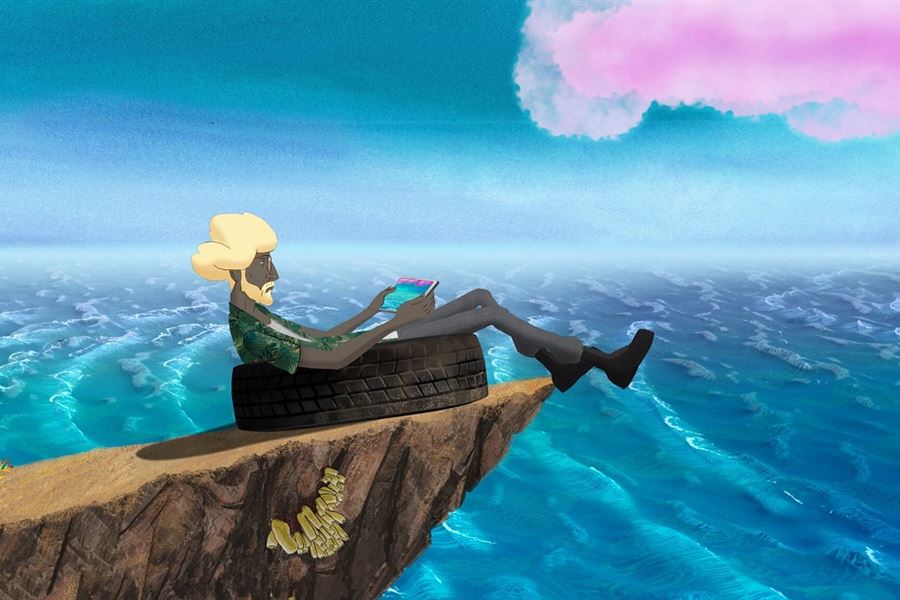
Bláznivý animovaný muzikál The Island přináší pestrobarevnou nálož lidského úpadku
Když se na libovolném evropském filmovém festivalu snažíte v množství komorních rodinných dramat najít něco trochu jiného, rumunský animovaný muzikál vás v programu zaujme na první pohled. A něco jiného skutečně dostanete. Hudební snímek The Island (2021) ukazuje, jak by asi vypadala psychedelická halucinace Robinsona Crusoe, pokud by to byl stárnoucí hipster s kompulzivní potřebou pomáhat tonoucím uprchlíkům. Surrealistická jízda plná symbolů, repetetivních rýmů a popkulturních odkazů vás vezme na vesele imaginativní výpravu za těmi nejhoršími problémy současného světa.
Popis nepopsatelného
Objektivní popis narativní linky díla, které je jedním velkým přeludem, může působit nesmyslně, nicméně jeho absurdnost dokáže asi nastínit nejlépe.
Tak tedy. Osamělý Robinson Crusoe v havajské košili objevuje v moři několik uprchlíků a jednoho z nich zachrání. Pojmenuje ho Pátek. Pátek je možná už dávno mrtvý. Možná ne. Robinson se o něj stará. Pátka láká do moře mořská panna, která není mořskou pannou. Z ostrova, který není vůbec pustý, ale plný odpadků, utonulých uprchlíků a surreálných výjevů se Doktor Robinson přesouvá do tovární nemocnice, aby „léčil“ rakovinné nádory malých dětí. V přilehlém baru potkává pitoreskní ženštinu, která se označuje za jeho matku, a jejího milence, piráta Pierra. Robinson se rozhodne pomoci jejich zakázané lásce a všichni tři se v kulatém růžovém obláčku vydávají hledat útočiště. Nebo ráj. Těžko říct. Pátek mezitím odklízí sníh, který tam není, čeká na mír na Blízkém Východě, který tam není, a pěstuje rajčata, která na písčité skále nemohou růst. Robinson, ženština a pirát přijíždějí suchozemskou lodí na místo připomínající festival Burning Man přehnaný o milion procent. Psychedelickou babylonskou věž plnou roztodivných pařících stvoření napadají modří piráti padající z nebes. Pátek sklidil rajčata a hned mu je zabavil fialový byznysmen v obrněném transportéru. Trojice prchá ze zajetí pirátů v útrobách obrovské červené babičky, která je nejdříve zlá, ale pak se promění v nachově růžový obláček a všichni z ní pletou ponožky. Pátek opouští ostrov, nalézá opuštěnou loď, ubrání se libyjské armádě a zachrání spoustu uprchlíků. Ženština a Robinson mezitím pro uprchlíky pletou zemi zaslíbenou. Obří iglú z měkoučkých ponožek v sobě však ukrývá uprchlický tábor s ostnatým drátem. Uprchlíci jej rozkopou, Robinson se vrátí na svůj ostrov, Pátek a mořská panna, která není mořskou pannou spolu mají hromadu dětí a Robinson spokojeně poletuje vesmírem.
Surrealismus z instagramu
Nemusíte se bát, že by tímto nesmyslně deskriptivním popisem niterně surrealistického díla došlo k vyzrazení zápletky nebo závěru filmu. Respektive ano, ale i tak je zmíněna sotva třetina motivů a postav, které se zde objevují a hlavně – na konkrétním ději příliš nezáleží.
Každá scéna obsahuje nespočet symbolů, metafor a alegorií a v každém jednotlivém záběru se zjevuje a multiplikuje obrovské množství fantaskních výjevů. Některé zvládnete dešifrovat poměrně snadno, na jiné (zejména v druhé polovině snímku) vám už možná nezbude síla a necháte se jen odevzdaně unášet.
Neustále se proměňující, tekoucí a těkající animace vychází z nejsoučasnějších ilustrátorských trendů a poměrně přirozeně kombinuje několik různých stylů a výtvarných technik. Kdybyste ji v kterýkoliv moment zastavili, dostanete obraz znázorňující, jak by to asi tak vypadalo, kdyby surrealismus vznikl dnes. Povrchní pestrobarevná změť plná uvědomělých symbolů a popkulturních odkazů rychle ubíhající v nekonečné smyčce insta stories.
Snímek se dotýká zásadních témat jako je imigrace, chudoba, vykořisťování, násilí na ženách nebo ekologie, ale i niternějších záležitostí jako jsou samota, nefunkční vztahy či spasitelský komplex. V podstatě je jen velmi málo aktuálně palčivých problémů, o které by se film alespoň letmo neotřel. A to je docela problém.
Maximalistické snahy dostat do snímku veškeré neduhy současného světa jsou spíše na škodu. Epileptická nálož komprimovaného lidského úpadku vás inspiruje tak možná k sebevraždě uprostřed oblastní diskotéky.
Exhibice imaginace
Reinterpretace a aktualizace jednoho z nejslavnějších literárních děl je sama o sobě určitě zajímavým, třebaže ne zcela originálním nápadem. Samotná linka představující vztah Robinsona a Pátka obohacená o uprchlický kontext, která se věnuje efemérnějším motivům samoty a pokryteckého samaritánství, by snad i stačila. V momentě, kdy Robinson, ženština a pirát vyrážejí na své putování, se nevzdalují jen od Pátka a jeho ostrova, ale především od samotné předlohy a vydávají se na nejistou plochu bezbřehé imaginace. Právě od tohoto momentu začíná být čím dál těžší rozpoznat co, a jestli vůbec něco, daný výjev znamená.
V druhé polovině filmu se objevuje velké množství bezobsažných ornamentů. V čistě vizuálním výtvarném díle by taková skutečnost nemusela vadit, ale vzhledem k tomu, kolik konkrétních témat a problémů se snímek snaží postihnout, může plejáda psychedelických motivů působit trochu rušivě. Podobný pocit propracované opulentní prázdnoty vyvolával například Futurologický kongres (2013), který se také snažil obsáhnout všechny zákruty vesmíru, ale ve výsledku byl jen vizuálně přitažlivě nezáživný.
Na jednu stranu můžeme nekonečnou fantazii autorů upřímně obdivovat. Takové dílo určitě nedokáže vytvořit každý. Ukočírovat explozi imaginace o síle jaderného výbuchu, ale není vůbec snadné. Výsledné dílo pak může působit jen jako její exhibice a diváka může dokonce začít nudit.
Nekonečný videoklip
Klíč k pochopení filmu paradoxně nabídnou až závěrečné titulky. Zkušená rumunská režisérka Anca Damian, mj. autorka celovečerních animovaných filmů Kouzelný vrch (2015) nebo Marona vypráví svůj příběh (2019), zde zmiňuje, že snímek byl inspirován hudebním albem The Island z roku 2011. To napsali a nazpívali rumunští písničkáři Alexandr Balanescu a Ada Milea. Písně použité ve filmu jsou s obsahem alba zcela totožné. V kontextu konceptuální hudební desky s volně plynoucím příběhem je přítomnost lehce iritujících cyklických rýmů a nonsensových snových veršů najednou lépe obhajitelná. K celému snímku pak lze přistupovat jako k 85 minut trvajícímu videoklipu. V takovém případě přebujelá manýra tolik nevadí a skutečně se můžete filmu plně odevzdat a jen čekat, do jakých sfér vás zanese.
Na druhou stranu možná existuje důvod, proč hudební klipy nemívají hodinu a půl. Pokud vás hudební složka nezaujme, nebo vám dokonce bude nepříjemná, může být sledování filmu trochu utrpením. Taková výtka by se samozřejmě dala vznést u jakéhokoliv hudebního filmu, nicméně filmové muzikály často vycházejí z přístupnějšího středního proudu, který je stravitelnější pro větší část publika. Zfilmování jednoho konkrétního experimentálního folkového alba je tak minimálně riskantním rozhodnutím.
Avšak mít možnost užít si svou oblíbenou desku takto originálním způsobem, je vážně skvělé. Přímo pro fanoušky desky The Island (kterých dle Spotify existují nižší desítky tisíc) tak musí být stejnojmenný snímek podobnou senzací jako byl Pink Floyd: The Wall (1982) pro fanoušky Pink Floyd. Kultovní film Alana Parkera byl ale senzací i pro mnohem širší publikum. Nejen z toho důvodu The Island jakékoliv další srovnání s The Wall neustojí.
Kratší stopáž či epizodické rozdělení do seriálu nebo série krátkých filmů dle jednotlivých písní by stravitelnosti snímku zřejmě prospěly. Případně se nabízí otázka, zda projekce v kině je pro tento sáhodlouhý videoklip ta nejvhodnější forma prezentace. Soustředěná pozornost v přítmí poloprázdného kinosálu působí proti snímku zvláštně strnule. Například zážitkové letní kino s dalším programem či tematickým občerstvením by nevyžadovalo stoprocentní pozornost diváků po celou dobu filmu, ale film by dobře dotvářel atmosféru dané události. Mohl by být také vhodným doprovodným programem některých hudebních festivalů.
Zajímavým způsobem však tvůrci s filmem pracovali v rámci instalace na interaktivní výstavě RADAR s podtitulem Metavers v Bukurešti. Na plátna potištěná krajinami z filmu mohli návštěvníci namířit své chytré telefony a pomocí rozšířené (AR) reality rozpohybovat postavy a motivy z filmu v reálném čase. AR filtry pro Instagram pak fungovaly i mimo výstavu a například modří piráti se mohli snášet z nebes uprostřed náhodné rušné ulice. Imerzivní instalace dokládá, že se více než o film jedná o objemné umělecké dílo, ale také, že tvůrci kladou možná až moc velký důraz na vizuální wow efekt.
Originální utrpení
Percepce tohoto mnohovrstevnatého opusu záleží na několika konkrétních faktorech. Pokud se vám zmíněná hudba i styl animace budou líbit, můžete si tuto surrealistickou jízdu náležitě užít a odcházet z kina obohaceni komplexním uměleckým zážitkem. V opačném případě ale písně působí drásavě otravně a přehršel vizuálních vjemů esteticky neatraktivně. Převládá pak pocit, že se brodíte světélkujícími zvratky duhového jednorožce.
Tak jako tak ale budete čelit útoku obrovského množství informací, který zejména v dnešní zahlcené době může působit spíše kontraproduktivně. Třpytivým depresivním bahnem se sice člověk nebrodí každý den a snímek skutečně nabízí originální zážitek, nelze však vyloučit, že se v něm nakonec budete chtít raději utopit.
THE ISLAND
Režie: Anca Damian
86 min, Rumunsko / Belgie / Francie, 2021
animovaný muzikál

Jsou movité důchodkyně novodobí kolonizátoři? Film Welcome to Luxor pokládá Západu nepříjemné otázky
Lákat ke shlédnutí filmu o nesnášenlivých a nesnesitelných důchodkyních není vskutku snadný úkol. Nenápadný sociálně-antropologický dokument Welcome to Luxor (2022) za to ale stojí. Zkoumá křehký svět expatek usazených v egyptském Luxoru a zachycuje jejich každodenní drobné konflikty. S okolním prostředím, místními návyky, se sebou navzájem a především se sebou samými. Snímek však zároveň otevírá důležitá témata postkolonialismu, sexuálního turismu či násilného importu vlastních představ do jiného prostředí. Postupně tak odkrývá mnohem víc, než jen ordinérní útrapy hašteřivých drben.
Citlivá sonda do světa outsiderů
Módní trend klobouků z bobří kůže, závody ve slalomu karavanů, minigolfisté či muži, co si hrají s vláčky. Švédská dokumentaristka Malin Skjöld ve své tvorbě často zkoumá jevy a komunity, kterým ostatní tolik pozornosti nevěnují. Podobně jako Werner Herzog nebo fotograf Martin Parr dokáže citlivě zachytit specifika různých marginálních lidských zájmů, aniž by se jim vyloženě vysmívala. Stejně jako Herzog a Parr bude na diváka maximálně lehce potměšile pomrkávat, ale výsledný závěr nechá na něm. Nejinak je tomu v případě Welcome to Luxor. Skjöld zde nechává uštěpačné ženy vyprávět a vyprávět, jednotlivé výpovědi vrství na sebe a přináší rozporuplný a zároveň ucelený pohled na komunitu expatek v současném Egyptě.
Sedíme a pomlouváme ty, které jen sedí a pomlouvají
Welcome to Luxor sleduje několik různých skupin žen. Na první pohled nám může připadat, že je spojuje snad úplně všechno. Pokročilý věk, původ z bohaté západní země, bílá barva kůže, touha strávit stáří ve slunném Egyptě. Ony samy by vám ale nejspíš řekly, že nemůžete být dál od pravdy. Do Luxoru přicházejí z různých důvodů, poměrů i zemí. S rozličným vkusem, vzděláním i představou o trávení volného času. Jedna skupina žen navštěvuje přednášky o starověkých faraonech, jiná zábavný program s diskotékou a Egypťany v kostýmech leprikónů. Jedny se snaží pěnu dní vyplnit navrhováním vlastních šatů, jiné se povalují u bazénu. Všechny si ale neustále na něco stěžují.
Jedna skupina pomlouvá druhou a sama popírá vlastní slova, z čehož Malin Skjöld nenápadně těží lehce komediální potenciál. Nespokojené promluvy navíc mnohdy slyšíme pouze z voiceoveru a komičnosti tak napomáhá fakt, že někdy ani nevíme, která žena zrovna pomlouvá kterou. Střihová skladba tak působí uvolněně a takřka nahodile, ve skutečnosti ale každá situace precizně navazuje na druhou a postupně buduje předkládaný obraz.
Bavit se s egyptskými muži? Proč bych to proboha dělala?
Ve chvílích, kdy si přítomné dámy stěžují na místní prostředí, a především tamní obyvatelstvo, získává snímek naléhavější tón a pokládá západnímu světu nepříjemné otázky. Umíme opravdu respektovat jiné kulturní prostředí? Jsme schopni a ochotni porozumět jiným návykům a tradicím? Nebo máme tendenci své vlastní představy násilně importovat kamkoliv?
Pokud bychom soudili pouze dle chování vyobrazených expatek, museli bychom na výše položené otázky odpovědět spíše negativně. Způsob, jakým komentují především egyptské muže, je až nepříjemný. Povýšené rychlé soudy, despekt a neporozumění. Aniž by byl divák znalý reálií a mohl hodnotit, zda se jejich odsudky zakládají na pravdě či nikoliv, cítí, že se expatky mužům porozumět ani nesnaží a raději si hermeticky chrání vlastní bublinu. Mezi řádky tak můžeme číst hluboko zakořeněné principy automatického odmítání neznámého či jiného, které silně ovlivňují například zvládání migračních krizí. V tomto případě je však situace přesně opačná. Nově příchozími jsou expatky z rozvinutějších zemí, a tak jejich nabubřelé počínání připomíná spíš chování rozpínavých kolonizátorů.
Takové přirovnání se může zdát přehnané a sám snímek podobně jednoznačný soud nevynáší. Pokud bychom chtěli být v hodnocení mírnější, můžeme se jeho prostřednictvím zamyslet i nad obyčejným masovým turismem. Často se říká, že cestování rozšiřuje obzory a pomáhá v pochopení jiných kultur. Je však otázkou, v jaké míře a zda vůbec k tomu u většiny turistů dochází, pokud dané destinace vnímají jen jako exotický lunapark plný „ušmudlaných domorodců“.
Hořkosladký fenomén sugar mamas
Ani despekt k místním mužům však ve snímku nevyznívá jednoznačně. Některé z žen si totiž mladé Egypťany pouští k tělu naopak velmi blízko. Film se tak dotýká i tématu ženského sexuálního turismu, o kterém se příliš nemluví. Například Thajsko má kolem mužské sexuální turistiky vybudován takřka samostatný průmysl, ale o výletech žen ze západního světa do Tuniska, Keni nebo právě Egypta za účelem vášnivého dobrodružství se ve veřejném prostoru stále běžně nedoslechnete. Jedním z mála filmových zpracování je výborné celovečerní drama Ráj: Láska (Paradise: Love, 2012) rakouského režiséra Ulricha Seidla, který jej zvládl ukázat mimořádně komplexně. Fenomén tzv. sugar mamas, tedy stárnoucích bohatších žen, které výměnou za sex a něhu finančně podporují mladšího muže z chudší oblasti, může na jednu stranu působit emancipačně, ale v případě nepřiměřeně citové investice může mít velmi nepříjemnou dohru. Jestli do tohoto druhu výměnného obchodu totiž něco nepatří, tak je to pravá láska.
Welcome to Luxor předkládá několik podobných příběhů také, a to hned ze tří různých úhlů pohledu. Nejméně citlivý je nepřekvapivě ten, který s opovržením vyprávějí pomlouvající drbny. Znechuceně se podivují nad věkovým rozdílem a množstvím vynaložených financí a fungují jako jakési zástupkyně konzervativních názorových proudů. V případě smutného osudu dokonce neváhají přispěchat s obligátním „Copak je blbá? Může si za to sama!“ Na podobné rychlé odsudky a neschopnost empatie k ambivalentním postavám narážíme v poslední době poměrně často. Jedním z příkladů mohou být oběti z dokumentu Podvodník z Tinderu (Tinder Swindler, 2022), které si kvůli svým „zlatokopeckým“ tendencím mnoho soucitu nevysloužily. Současná společnost s kontextem zranitelnosti bohužel stále příliš nepracuje.
V přímé opozici k odmítavým klevetnicím tak stojí upřímná výpověď jedné z expatek, která se zkrátka doopravdy zamilovala a pak musela čelit tvrdé realitě v podobě prázdné peněženky a zlomeného srdce. S nově získaným nadhledem a odstupem času popisuje, že sama nechápe, jak se do podobné situace vůbec dostala. Jaké životní rozpoložení oné disproporční emoci předcházelo, můžeme pouze odtušit.
Třetí z nabízených pohledů předkládá nejstřízlivější reflexi této problematiky. Jedná se o skupinku žen, které si zkrátka chtějí užít, dokud to jde, ale zároveň si plně uvědomují veškeré výhody i úskalí souvisejících transakcí a ještě ji dokáží s cynickým humorem trefně oglosovat, zatímco se požitkářsky povalují u bazénu.
Místo posledního odpočinku
Línou atmosféru pomalu plynoucích horkých dní mají zřejmě navozovat také abstraktní prostřihy na různé tekuté barvy, které se efektně rozpouštějí ve vodě. Bez většího rozuzlení významu těchto záběrů však působí právě pouze efektně. Jako by snad tyto abstrakce měly pomoci jinak velmi civilně nasnímanému dokumentu k vyšší umělecké hodnotě.
Trochu nepatřičně působí také příběh archeoložky Francescy vyprávěný hned zkraje filmu. Zákulisní intriky na pozadí archeologického objevu v sobě sice obsahují všudypřítomný konflikt, a navíc úzce souvisí s vyobrazeným prostředím, z vyznění celého filmu však vypadávají, protože s ostatními motivy příliš nekomunikují. Mohlo jít o snahu představit co nejširší škálu osobností anebo mohl daný příběh režisérku zaujmout natolik, že se jej zkrátka rozhodla do filmu zařadit. V obou případech by však lépe fungoval, kdyby byl zakomponován až v průběhu filmu a ne na jeho samotném začátku.
Příběh Francescy navíc bezprostředně navazuje na úvodní záběr s titulkem zmiňujícím, že Luxor býval slavným místem, kde se nechávali pohřbívat králové, ale nyní se sem jezdí z trochu jiných důvodů. Lakonická narážka pracující s historickým kontextem a významem této metropole by mohla být při změně střihové skladby vytěžena vhodněji. Buďto šlo z kontrastu vykřesat vtip anebo naopak více rozpracovat motiv oddalování stárnutí a strachu ze smrti.
Mikrosvět expatek jako lakmusový papírek západních civilizací
Komplikované vyprávění zmíněné archeoložky je na začátek zkrátka trochu těžkopádné a snímek vás proto naplno vtáhne až po jeho uplynutí. Pak vás ale naštěstí už nepustí. Tomu napomáhá jednak příjemná hodinová stopáž, ale především podivná přitažlivost jednotlivých výpovědí. Na podobném principu dokonce mohou fungovat bulvární média nebo obecná obliba drbů ve společnosti. Elektrizujícímu účinku pomlouvačných historek se někdy nejde ubránit. Jakoukoliv bulvárnost však autorka filmu nijak nezdůrazňuje, a pokud bychom ji v něm přece jenom spatřovali, je to zcela v režii daných protagonistek.
Lze také ocenit, že snímek není explicitně agitační. Režisérka expatky nekonfrontuje, jejich počínání hlouběji neanalyzuje a ani se je nesnaží našroubovat do vlastního výkladu světa. Nepřidává historický kontext nebo názory odborníků či infografiku s konkrétními daty. „Jen“ pozoruje a pozoruje a veškerou kritiku nechává přirozeně probublávat kolem jednotlivých výpovědí. Díky tomu vzniká mimořádně funkční a přístupná reflexe hned několika problematik najednou.
Malin Skjöld se zaměřila na mikrosvět jedné konkrétní komunity, ale s nebývalou lehkostí se dokázala dotknout mnoha obecných charakterových vad současného světa. Neohleduplnost, nepřizpůsobivost, neochota si navzájem naslouchat a především tendence si neustále na všechno stěžovat, jsou určitě rysy, nad kterými bychom se mohli kdekoli na planetě více zamyslet.
WELCOME TO LUXOR
Režie: Malin Skjöld
62 min, Švédsko, 2022
dokumentární
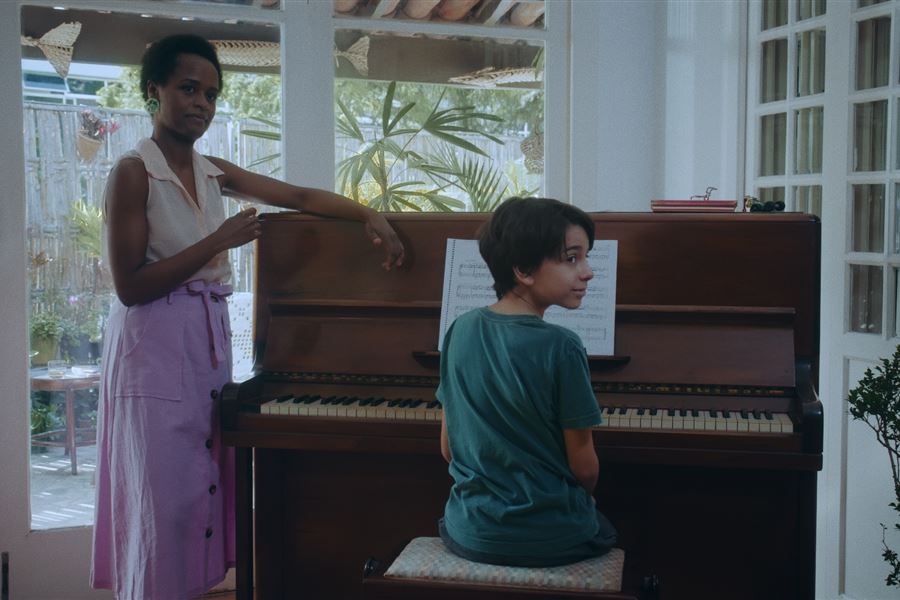
Sunday Morning. Hluboký ponor na malé ploše
Ve svém předchozím textu jsem se detailněji věnoval snímku Haulout sourozenecké dvojice Evgenie a Maxima Arbugaevovoých, prvnímu ze dvou pro mě nejpozoruhodnějších krátkých filmů letošního festivalu Berlinale. Nyní na řadu přichází Sunday Morning Brazilce Bruna Ribeira, který byl za své dílo oceněn prestižním Stříbrným lvem – Cenou poroty sekce Berlinale Shorts.
Dobrodružství uvnitř
Gabriele, mladé černošské klavíristce, se blíží důležité vystoupení, což s sebou přináší řadu pochybností o vlastní dostatečnosti. Zároveň přichází také den prvního výročí smrti její matky. V tomto psychicky vypjatém období vyplouvají na povrch vzpomínky, touhy i nejistoty. Přítomnost se prolíná s minulostí, sny s realitou a Gabriela sedí u klavíru a hraje a hraje…
Z naznačeného obsahu je zjevné, že problémy, kterými se tvůrce zaobírá, nemusí být na první pohled plně patrné, a je tak vyžadována maximální divácká vstřícnost, až spoluúčast. Spíše než odvyprávěním souvislého příběhu je výsledkem citlivý ponor do světa hlavní hrdinky, v rámci něhož se nakonec můžeme dopracovat k vlastní emocionální odezvě.
Nekonvenční pojetí je patrné okamžitě. Po úvodních titulcích se nestává dominantním smyslem diváka zrak, jak bychom jistě očekávali, nýbrž sluch. Po obligátních zahajovacích logách produkčních společností a názvu filmu, pod kterými již slyšíme diegetické zvuky číhosi zasedání ke klavíru a následné první tóny, nepřichází obraz, ale dalších téměř dvacet vteřin černé, podkreslované hranou skladbou. Hudba bude zastupovat důležitou roli, na její význam jako by bylo tímto upozorňováno. Půjde o neoddělitelnou součást sledovaného světa, což je následně stvrzeno i „vytouženým“ prvním záběrem. Ten trvá téměř tři a půl minuty, z čehož se celé tři jedná o statický celek, zabírající hlavní hrdinku, otočenou k nám zády, hrající na klavír ve svém pokoji. Dostáváme se tak téměř do roviny jakéhosi dokumentárního záznamu, v němž je nám předkládána nepřikrášlená (pro oko nepříliš atraktivní) realita.
Poté, co Gabriela dohrává, přichází „šok“. „Jsi v pořádku?“ ozývá se cizí hlas z prostoru mimo rám. Kdosi byl celou dobu přítomen, hrdinka se otáčí. (S trochou nadsázky lze moment přirovnat k odzbrojujícímu zjevení mrožů v Haulout.) Postupné dávkování informací spolu s pomalým rozjezdem vyprávění a minimalizovanou formou přichystalo půdu pro překvapení. Gabriela vstává a míří k nahému partnerovi ležícímu na gauči; kamera s ní po třech minutách statického záběru švenkuje. Dokud hrála, byla sama ve svém „extatickém“ světě, jakmile však tóny dozněly, je zde prostor i pro ostatní a tuto změnu reflektuje právě i pohyb kamery. Od úvodních vteřin je tak exponován filmový svět především jako nelehce proniknutelný vnitřní – s hudbou spjatý – prostor hlavní hrdinky, na nějž se musí divák poctivě naladit.
Gabriela muži vypráví svůj sen o matce a jejím tichém domě, dále pak upřesňuje, že zítra půjde o den prvního výročí její smrti. Stále jde tedy pravděpodobně o nezacelenou ránu. Zmínka o snu má vzhledem k následnému dění funkci legitimizace „posunutých“ výjevů v rámci vyprávění; nejasnost hranic je ve filmu jakýmsi jednotícím prvkem. Závěrem rozhovoru se dozvídáme i o blížícím se klavírním vystoupení a strachu z neúspěchu. Nad těmito rozdanými kartami – hudba, matka, sen a blížící se koncert (k němuž už v rámci syžetu nedochází) – je následně bez jasného vyznění preludováno; jednotlivé vrstvy, emoce a scény se vrství přes sebe a my se spolu s hrdinkou ocitáme ve zvláštním, subjektivním čase.
Sama se sebou
V další scéně se svět sice vnějškově rozšiřuje, hrdinku sledujeme při výuce klavíru, vyzněním je však opětovné zacyklení do sebe sama a podtržení předchozího. Jednak opakujícím se formálním pojetím – vidíme Gabrielu, dohlížející na hrajícího chlapce, v „plochém“ celku zezadu, tedy obdobně jako v minulém obraze; a následně pak i obsahově – poté, co žák skladbu dokončí, se oba dva podívají mimo rám. Tam byl i tentokrát po celou dobu kdosi přítomen, a sice chlapcova matka, skrz kterou tak dochází k připomenutí zemřelé matky Gabriely. Oproti všem předchozím, často i desítky vteřin trvajícím záběrům, je tento velice krátký, a působí více znakově – zpřítomnění Mateřství.
Následuje noční scéna, v níž hrdinka plave sama v bazénu. Rytmus pokračuje v proměně – i toto dění sledujeme v krátkém záběru, a můžeme tak nabývat tušení přelomu v celkově konvenčnější vyprávění. Jako by čas mimo hru na klavír plynul „normálně“. Ribeiro však tentokrát diváka znejišťuje jiným, nečekaným způsobem: Hrdinka vylézá z vody a hledí kamsi na druhou stranu bazénu. Následuje její hlediskový záběr, v němž vidíme záhadnou černošku s pohledem upřeným jejím směrem. To vše za doprovodu nediegetického hučivého zvuku, který spolu se záhadností výjevu generuje hororové pnutí (obdobně jako v Haulout před zjevením mrožů). Tajemná žena už se navíc nikdy znovu neobjeví. Divák zůstává sám se svou nejistotou a musí si klást otázky po smyslu viděného. Šlo o představu? Má žena cokoliv společného se zemřelou matkou? Záhrobní atmosféra výjevu by tomu odpovídala.
Rozostřenost vyprávění je následně umocněna prolínačkou (umožňující trochu staromilsky interpretovat následné dění jako sen) a přechodem do ještě nejasnější scény. Jsme v potemnělé místnosti, kde Gabriela zasedá ke klavíru a začíná hrát. Záběr je – jak jinak než – dlouhý, mající přes tři minuty a statický. Poté, co hrdinka dohrává, přichází její pohled mimo rám. Postup z reality se opakuje i ve snu. Tentokrát byla přítomná starší černošská dáma (jiná než ve scéně předchozí), která se bez sebemenší reakce s přísným pohledem zvedá a opouští sál. Ostatní židle jsou prázdné.
Doplňme si sami
Vzhledem k informacím, které (ne)máme k dispozici, nám ani tentokrát nezbývá než se pokusit vniknout do scény rozumově a přijít s vlastní interpretací. Jde o hrdinčinu ve snu zhmotněnou úzkost z blížícího se vystoupení? Je žena, která opustila místnost, její matka, jíž se Gabriela nikdy nemohla zavděčit, ačkoliv bylo její hraní dokonalé (tak jako nám právě předvedla)? Přivedla ji ke hraní matka? Věnuje se hudbě kvůli ní, myslí na ni u klavíru pokaždé, i když je už rok po smrti? Zatleskala jí matka někdy?
Zaplňování prázdných míst má za následek větší divácký ponor – samozřejmě za předpokladu, že na danou hru přistoupíme. Ne všichni budou mít o podobný proces zájem. Touto neustálou nutností doplňovat a interpretovat, neboť nic jiného nám nezbývá (nejedná se o dílo, které by uchvátilo nablýskaným zevnějškem či akčností děje), se pak chtě nechtě stáváme součástí dění, ocitáme se v Gabrielině kůži.
Druhý den – na výročí matčiny smrti – přijíždí hrdinka do klidného přímořského městečka. Po procházce ulicemi přichází k jednomu z domů, bere klíče z květináče, odemyká a vstupuje. Prochází prostorem, po chvíli se zastavuje a kouká do další z místností. V následném hlediskovém záběru vidíme u stolku malou holčičku, která už se po zbytek stopáže znovu neobjeví. Jedná se o rodný dům, který byl zmíněn v úvodu jako součást snu? Je holčičkou sama Gabriela?
Hrdinka pak přichází ke starým klávesám a začíná hrát. Oproti předchozímu statickému snímání v širších záběrech sledujeme nyní detail její tváře. Prožitek a bytí ve svém vlastním světě proto tentokrát působí naléhavěji. Když hrdinka končí, na základě předchozích zkušeností očekáváme, že i zde bude kdosi vyčkávat mimo rám. Gabriela poslouchá doznívající tóny a zahledí se vzhůru do světla, dopadajícího na její tvář oknem. Dívá se do nebes na matku? Zvládne ono velké blížící se vystoupení bez její podpory? Zatímco scéna „noční můry“ s přísnou ženou, odcházející ze sálu, naznačovala možnou nezdravost vztahu, z posledního záběru sálá spíše smířlivost, vděk a pozitivní emoce.
Film na žádnou z otázek neodpovídá, je otevřeným tvarem provokujícím diváka k zamyšlení. Vzhledem k tomuto téměř matematicky působícímu motivu (dlouhé hraní a následné odkouknutí mimo rám) může Sunday Morning fungovat i jako jakýsi prázdný vzorec k dosazení vlastních hodnot, čímž dá připomenout např. filmy Roberta Bressona. Hudba může s matčiným odchodem souviset na mnoho způsobů. Neuspokojivost, co se nakládání s informacemi týká, je tak trochu paradoxně největší předností snímku, neboť diváka „zapojuje do hry“, nutí ho vstoupit do hrdinčina stavu na pomezí reality a snu, a probouzí tak i jeho vlastní empatii.
Styčné plochy s Haulout
Skrze „close-reading“ obou – značně odlišných – kraťasů, které mě na letošním Berlinale zaujaly nejvíce, jsem byl schopen odhalit styčné plochy, čímž (pro sebe) zároveň odkrývám i důvody vlastní fascinace. Mimo konkrétních podobností v textu již zmíněných (moment překvapení, hororový výjev umocňující subjektivní prožitek hlavní postavy), můžeme dále mluvit i o pomalém temporytmu, postupném a ne vždy uspokojivém dávkování informací či o dokumentárních pasážích (zde objektivně zaznamenané hraní celých skladeb). Toto vše však směřuje k ústřednímu bodu obou filmů – k hlavní postavě a především k umožnění soustředěného ponoru do její situace.
Co se týká Haulout, jde o ponor více „primární“, založený na všeobecně srozumitelných prožitcích (izolovanost, základní lidské potřeby), u Sunday Morning musíme pracovat jaksi naopak, mnohé si domýšlíme, pátráme po dění za obrazy a z nejasných rozumových stimulů konstruujeme mozaiku hrdinčina stavu. Intenzivním zaměřením na jednu hlavní postavu jsou nám ale v obou případech zprostředkovány silné emoce, ať už skrze přímo viděné nebo vlastní empatii. Pro tuto schopnost nenechat diváka chladným jsou v mých očích obě díla krátkými velkofilmy.

Haulout. Krátký velkofilm z letošního Berlinale
Z krátkých filmů uvedených v únoru na berlínském festivalu v sekci Berlinale Shorts považuji za nejpozoruhodnější dvě zdánlivě nesourodá díla. Dokument Haulout, zprostředkovávající podoby výzkumu na Sibiři, od sourozenců Evgenie a Maxima Arbugaevových, a Cenou poroty vyznamenané psychologické drama Sunday Morning režiséra Bruna Ribeira, jemuž se věnuji samostatně v jiném textu.
Dobrodružství v čukotské pustině
Sourozenci a režiséři Evgenia s Maximem Arbugaevovi, tvůrci dokumentu Haulout, původně pocházejí z Tiksi, malého jakutského městečka o 5000 obyvatelích, nacházejícím se vzdušnou čarou přes 4300 kilometrů od Moskvy v oblasti ruské Arktidy, tedy na území severně od polárního kruhu. Na takovém území se pak rozkládá i část poloostrova Čukotka, jež je dějištěm jejich prvního společně natočeného snímku.
Spjatost s prostředím je z díla zřejmá a i díky ní je výsledek divácky atraktivní. Arbugaevovi, vědomi si exotiky, jež rodná oblast skýtá, totiž zprostředkovávají nevídané přírodní výjevy v dramaturgicky promyšlené struktuře, blížící se spíše narativnímu vyprávění, jaké známe z hraných filmů. To se týká především budování napětí a diváckého očekávání skrze postupné dávkování informací, navozování identifikace s blíže nespecifikovaným hlavním hrdinou a v neposlední řadě i závěrečné „pointy“, která retrospektivně ovlivní vše do té doby viděné.
Snímek také sází na silný moment překvapení, což je pro dokument poměrně atypické. Tuto skutečnost tvůrci při odhlédnutí od samotné stavby díla umocňují i tím, že o obsahu předem neprozrazují víc než naprosté minimum informací, ať už jde o plakát, propagační fotografie, trailer či skromně znějící synopsi: V pusté oblasti ruské Arktidy vyčkává v chatě muž, aby mohl pozorovat přírodní událost, která se zde každý rok odehrává. Oteplování oceánů si však vybírá svou daň.
Bohužel, bez vyzrazení onoho překvapení nelze o filmu cokoliv komplexnějšího napsat, dovolím si zde tudíž trochu paradoxně od následujících řádků odradit a všemi deseti doporučím Haulout nejprve zhlédnout.
Dokument, či hraný film?
Ocitáme se na místě, kam člověk nepatří: pobřeží bez vegetace, rezavý vrak vyvržené lodi, sychravo, skučící vítr a hlasitý šum ledového moře. Intenzivní atmosféra nehostinného místa, které je uvedeno titulkem Čukotka, sibiřská Arktida. Zpoza vraku se pak náhle objeví člověk. Ve velkých celcích působí oproti obklopující přírodě nepatrně; to se následně ukáže jako předzvěst hlavního tématu filmu, tvor versus příroda.
Neznámý muž zpočátku putuje nehostinným prostředím bez zjevného cíle. Do rekordéru si následně poznamenává: „7. září. Hustá mlha, zatím je nevidím.“ Na první pohled nenápadný moment okamžitě vzbuzuje vzhledem k dosavadnímu (ne)dění silná divácká očekávání. Koho muž vyhlíží? Jde o klasický vypravěčský háček, podněcující zájem o to, co má přijít. Vezmeme-li navíc v potaz skutečnost, že téměř všechny záběry jsou bezchybně komponované (režírované), vzniká dojem hraného filmu.
Přestože dokumentární žánr již dávno překročil předsudek reportážního tvaru plného mluvících hlav, v případě Haulout je velice složité definovat hranice. Nejasnost je mimo zmíněnou preciznost vizuální stránky způsobena i specifickým nakládáním s hrdinou. Ten není portrétovanou osobou, ani průvodcovskou autoritou předkládající informace. Je jakýmsi osamělým romantikem, který bloudí sibiřskou pustinou, kohosi vyhlíží a ukrývá se před nevlídnými podmínkami ve staré ošlehané chatě uprostřed ničeho. S jakožto jedinou (lidskou) postavou s ním tak situaci můžeme od prvních vteřin automaticky spoluprožívat.
Sám se sto tisíci
Zlom v dění přichází po páté minutě (která poměrově přibližně odpovídá obvyklému bodu obratu u filmů s celovečerní stopáží). Muž se v noci probouzí za zlověstných, těžko identifikovatelných zvuků zvenčí, vstává z postele a rozchází se k východu. Ruční kamera je rázem dynamická a kontrastuje s dosavadním dojmem statičnosti, čímž je ve spolupůsobení se zmiňovaným háčkem šponováno napětí na maximum, téměř jako v žánrové kinematografii. Průchod chatou se odehrává v reálném čase, střih absentuje a kvůli tmě nemáme možnost zorientovat se v prostředí, což ztotožnění s hrdinou umocňuje. Pak konečně přichází onen ohromující-překvapivý výjev: skrze jeden z vchodů vidíme spolu s hrdinou nekonečný zástup řvoucích šavlozubých mrožů, obklopujících stavení.
Výjimečnost následujícího, dvě minuty trvajícího záběru spočívá v maximálním naplnění (překonání) očekávání; budované napětí se přetavuje v odzbrojující výjev. Na intenzitě zároveň nabírá i ono šrotování, co se sledovaného tvaru týče. Údernost dokumentární „objektivity“ dané chvíle je totiž pečlivě přichystána stylizovanou formou. Například mroží řev byl jistě slyšet od prvního momentu přiblížení k chatě, ve filmu je však jasněji rozpoznatelný, až když zvířata z bezprostřední blízkosti spatříme na vlastní oči; do té doby jde spíše o jakýsi hororový (ne)diegetický sound design.
Tímto momentem současně získáváme více informací o našem „tajemném“ hrdinovi. Zvířecího obklíčení se neděsí, naopak se s fascinací v očích přibližuje na dosah ruky. Jde tedy o člověka se situací obeznámeného, který se rozhodl v hnízdišti mrožů bádat. Tento poznatek může znít poněkud banálně, pravdou však je, že film samotný hrdinovo pozadí jakkoliv neexponuje. Principem průběžného dávkování informací funkčně udržuje pozornost.
Následujícího dne pak přichází další nezapomenutelný obraz. Záběr z dronu, který prostředí okolo chaty snímá z dostatečné výšky, aby bylo možné vidět co nejvíce z mrožího tažení; to vše za podkresu mužova komentáře do rekordéru, nyní (konečně) plnícího funkci pomyslného vypravěčova voice-overu. „Pobřeží je plné. Okolo 95 000 mrožů. Dalších 6 000 ve vodě. Moře je úplně bez ledu.“ V těchto momentech tvar nabývá na dokumentárnosti.
Ta je však vzápětí opět narušena, když se film místo rozvíjení informací uchyluje k zobrazování „mrtvého času“. Muž ze starých vajglů, uchovávaných ve velké skleněné nádobě, doluje zbytky tabáku a balí z nich novou cigaretu. Nepřerušovaný záběr trvá téměř minutu, přestože jasnější sdělení absentuje; funguje proto opět spíše identifikačně, spoluprožíváme nudu, čas, kdy není co dělat, vyčkávání, zatímco obklopující hordy mrožů řvou za okny. Takové momenty jsou v druhé polovině stopáže stále častější (muž spí, večeří), a na mysl se tak znovu vkrádá otázka po tom, co vlastně sledujeme.
Problém nás všech
Zvířata jsou rázem v druhém plánu a cítíme spíše mužovu osamělost. V jiném momentě nám zase jeho namodralá kůže ve tváři přibližuje jistě extrémní teplotní podmínky. Dochází tak k obohacení „rozumové“ identifikace (jediný člověk ve filmu, „hlediskový záběr“ z dalekohledu, voice-over nahrávky) jakousi prvotně-lidskou identifikací na univerzálně srozumitelné úrovni základních prožitků (zima, nuda, hlad, samota). Modř mužovy tváře je navíc doprovázena stékající slzou – možná je na vině vítr, možná smutek nad stavem planety. Globální oteplování má totiž za důsledek i úbytek ledu na daném území, putující mroži si tak nemohou odpočinout na krách a na pevninu často doputují v zoufalém stavu. Vyplašení si pak způsobují četná zranění, někteří dokonce umírají.
Po důsledně navozeném ztotožnění s člověkem přichází nečekaná identifikace i se zvířaty. Muž spí na posteli a kamera v detailu sleduje jeho složené ruce, ze kterých je poté střiženo na obdobně složené ploutve mrožů; výsledným dojmem je jakási vzájemnost. Podobně řešena je také jedna z dalších scén, v níž hrdina nachází uvnitř chaty osamocené mládě. Oba tvorové po sobě pokukují, přičemž kamera jejich setkání zabírá v duchu naprosté rovnocennosti formou záběr-protizáběr. S tímto zdůrazňováním sounáležitosti skrze záběrování jako by přicházelo sdělení, že globální oteplování je přeci problémem všech bytostí na planetě. Zármutek nad situací je následně zintenzivňován zkoumáním uhynulých jedinců, zanechaných na břehu poté, co stotisícová masa území opouští. O jiném osamoceném mláděti je zase hrdinou mluveno „lidskou terminologií“ jako o sirotkovi.
Dokumentární tečka
Chatu závěrem přikrývá sníh a stejně jako z území odtáhla zvířata, odchází nakonec i muž. Díky občasnému zvukovému zpřítomnění jeho záznamů tušíme, že pobyt trval přibližně dva měsíce. Hrdina jde krajinou, míjí mrtvá mroží těla, později osamí. Obdobně jako Haulout začal, tak i končí. Člověk ve velkém celku prochází krajinou. Malý tvor (tvorové) versus mocná příroda.
Přes obraz je následně vložen text, pomyslná dokumentární tečka, sdělující důležité skutečnosti o právě zhlédnutém. Bezejmenným hrdinou byl Maxim Chakilev, mořský biolog, dlouhá léta studující migraci mrožů. Obrovské počty přítomných zvířat jsou pak negativním důsledkem měnícího se klimatu. Absence ledu nutí mrože zdržovat se delší čas na pevnině, kde si jsou vzájemně nebezpeční. Roku 2020, kdy byl materiál natáčen, jich na místě zůstalo přes 600 zemřelých – doposud nejvyšší zaznamenané číslo. Film, který celou dobu kladl důraz na čistě filmové vyprávění, sdělující vše potřebné silou obrazů, tak závěrem v apelativním duchu udeří i objektivními fakty, čímž emocionální účinek ještě umocňuje.
Sourozenci Arbugaevovi předložili divákům nekonvenční tvar, využívající prostředků typických pro narativní kinematografii (specifické navozování identifikace, budování napětí, promyšlená a významotvorná filmová řeč), který může připomínat např. dokumentární tvorbu Wernera Herzoga. Diváky nezahlcují přívalem informací; emoce přicházejí skrze působivost obrazů a ztotožnění s hrdinou, hlubokým ponorem do jeho situace. Úchvatnost přírodního jevu je zužitkována k poukázání na jednu z největších hrozeb současnosti, a výsledek tak s člověkem zůstává dlouho po zhlédnutí. Pro své zpracování a téma může film slavit úspěch na environmentální konferenci, stejně jako u diváků hrané tvorby.
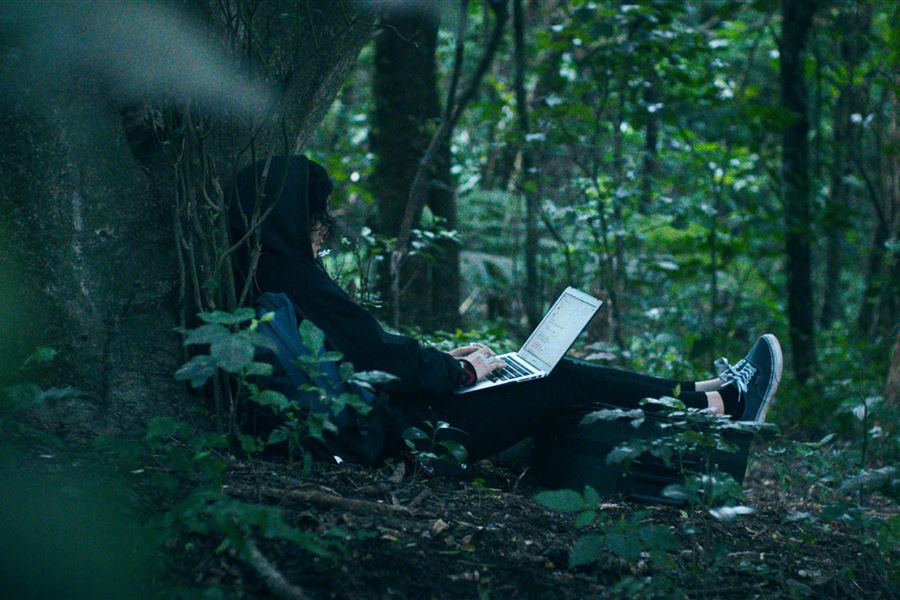
Millie Lies Low aneb Strastiplný závod s vlastním instagramovým profilem
Jedním z filmů, které mě na letošním 72. ročníku festivalu Berlinale nejvíce zaujaly, bylo novozélandské komediální drama Millie Lies Low debutující režisérky Michelle Savill, uvedené v sekci Generation 14plus. Snímek, který může na první pohled působit jako oddechová záležitost pro teenagery, určitou vypravěčskou lehkostí skutečně vyniká, zároveň však nabízí i hlubší podněty.
Hlavní hrdinkou je čerstvá absolventka architektury Millie, která má z Wellingtonu, hlavního města Nového Zélandu, odcestovat na prestižní stáž do New Yorku. Přípravy vrcholí, billboardy po městě zdobí reklamy na architektonická studia s její tváří a vše zdánlivě jede ve správných kolejích, dokud Millie těsně před odletem nepostihne uvnitř letadla nečekaná panická ataka, kvůli které svou rodnou zemi na poslední chvíli neopouští. O jejím selhání se ale za žádnou cenu nesmí nikdo nic dozvědět! Millie začíná ve spěchu shánět peníze na nové, extrémně drahé letenky a skrze sociální sítě přesvědčuje známé a všechny své followers, že do New Yorku ve skutečnosti úspěšně doletěla a začíná tam novou životní etapu. Závod o udržení se o krok v předstihu před pravdou a za záchranou všeho, co se ještě zachránit dá, je odstartován.
Zástupkyně mladé generace
Již z nastíněné výchozí situace je jasné, že Millie je nejednoznačnou a chybující postavou, která se pro zachování své (internetové) image dostává do rozporuplných situací, v nichž by se sám divák s největší pravděpodobností nikdy neocitnul. To vytváří určitý distanc, umožňující se nad jejím počínáním bavit a pozorovat ho s nadhledem. Upnutost na sociální sítě a vlastní sebeprezentaci sledujeme s lehkým opovržením, speciálně pak v momentech, kdy vidíme, že Millie pozitivní odezva na „nafejkované“ fotomontáže z New Yorku kouzlí úsměv na rtech, přičemž není plně jasné, zda ji více těší skutečnost, že její podvod prozatím prochází, či popularita u sledujících. Jako by snad bylo důležitější, co se odehrává ve světě internetu, než skutečná životní situace, což trefně poukazuje na jedno z palčivých témat současnosti.
Dlouhou dobu nám navíc není odhaleno příliš informací z pozadí celé této newyorské mise, absentuje hlubší vykreslení motivací, a to včetně toho, proč Millie tolik nechce, aby kdokoliv z jejího okolí (včetně přítele, matky i nejlepší kamarádky) zjistil, že ve skutečnosti neopustila Nový Zéland. Pro tuto nekonkrétnost se Millie – v kontrastu s jejími konkrétními, „distanc-vyvolávajícími“ činy – stává pomyslnou univerzální zástupkyní mladé generace, okolím tlačenou k výsledkům a bojující s vlastními nejistotami a psychickými problémy. Jde tak o „ideální“ postavu k identifikaci, čemuž dopomáhá i filmová řeč, o níž se rozepíšu níže.
Millie Lies Low umožňuje s hlavní postavou nesoucítit (sami bychom se do podobné maskovací taškařice za pochybných motivací zřejmě nepustili) i soucítit zároveň (Millie rozumíme jako člověku bojujícímu s vlastní nedokonalostí), díky čemuž snímek drží pohromadě, v komediálních polohách vyvolává smích a v dramatičtějších zase potřebný soucit spolu s dalšími emocemi.
Nepřikrášlená realita
Zásadní je pak v tomto ohledu i realistické pojetí snímku, v němž není pro humor přichystávána půda skrze ztřeštěnou komediální nadsázku či stylizaci fikčního světa. Vše pramení ze situací samotných, případně ze srážek kontrastů, především pak z (ne)naplněných očekávání spjatých s Millieinou „hvězdností“ (případně očekávanou nepřítomností v rodné zemi) ve spojení s její skutečnou, tíživou situací. Realistického dojmu je dosahováno vedle civilního herectví také často až dokumentárně působící formou (zapříčiněnou pravděpodobně i nižším rozpočtem), místy připomínající styl vážných sociálních dramat.
Zmiňovaná identifikace s hrdinkou je navozována od počátečních vteřin, a to se samozřejmou lehkostí právě skrze styl. Hned první, minutu trvající záběr je jakousi ukázkou celkového nastavení. Sledujeme v něm Millie a její panickou ataku uvnitř letadla. Za okamžik se má vzlétnout, hrdinka si však uvědomuje, že musí za každou cenu ven; z prostřední sedačky přelézá cizího člověka vedle sebe, prchá uličkou k nouzovému východu, zkouší ho otevřít, načež je zpacifikována posádkou. Dynamická ruční kamera začíná na polodetailu Millieiny rozrušené tváře, poté se spolu s ní zvedá, míří k východu a z bezprostřední blízkosti snímá i tahanici s personálem.
První vteřiny tedy sledujeme poměrně intenzivní výjev, při němž jsou v druhém plánu přirozeně zachycováni i ostatní, pokojně sedící cestující, čímž se k hlavnímu dění vytváří kontrast, a je tak udávána celková humorně-dramatická nálada, kterou si snímek udržuje po celou zbylou stopáž. Díky absenci střihu, nestylizovanému zvuku a detailnímu snímání hrdinčiny tváře můžeme navíc nabýt pocitu, jako bychom úvodní situaci spoluprožívali. Vtahování do děje je obecně dopomáháno i omezenou perspektivou; jako diváci jsme přítomni pouze výjevům, jimž je přítomna i Millie, a nezískáváme tak oproti ní pomyslnou převahu ve vědění.
Dvojí život
Principu srážky kontextů, z nichž pramení humor, je využíváno v průběhu celého snímku. Často i uvnitř jediného záběru. Na příklad ihned poté, co je Millie vysazena z letadla, sledujeme, jak před odletovou branou nervózně přemýšlí, co dál, a s nasazenou kapucí sedí v žalostném rozpoložení pod velkým reklamním billboardem, na němž je zachycena její usměvavá tvář. Získáváme tak informaci o jejím „schizofrenickém“ světě, rozděleném na dvě úrovně: vyšší-mediální a nižší-pozemskou. Podobné srážky je využito téměř vzápětí, kdy je z Millieina detailu po předstíraně radostném hovoru s kamarádkou, v němž tvrdí, že cesta do New Yorku probíhá podle plánu, střiženo na „uzemňující“ celek, v němž hrdinku vidíme zamračenou svačit u wellingtonských kontejnerů.
Divák si tak tento způsob vyprávění osvojuje hned od úvodních scén. Význam rozporů mezi prezentovaným příběhem a realitou je pak často zpřítomňován i skrze sociálně sítě hrdinky, které jako by boj na dvou frontách s železnou pravidelností připomínaly. Tento opakující se motiv je dalším z funkčních prostředků generujících humor.
Čím víc se však celá šlamastika vyvíjí a zašmodrchává, tím víc se začínají objevovat i tušené temnější tóny. Millie řeší poměrně komplikovaný vztah s matkou, stále bolavou ztrátu otce, následně dokonce odhaluje šokující nevěru svého přítele se svou nejlepší kamarádkou. Tyto momenty a Millieiny reakce na ně hrdinku zplastičťují, a oproti výchozímu „univerzálnímu“ nadefinování se z ní tak průběhem událostí stává komplexní postava z masa a kostí, která přijímá zodpovědnost a uvědomuje si důležitost vlastní autentičnosti. Režisérka i v těchto těžkých chvílích nezapomíná dění odlehčovat, a stejně jako ve skutečném životě se tak depresivní stavy mísí s usměvavými momenty a záblesky zlepšení, díky čemuž film nepřichází o svoji vypravěčskou lehkost.
Méně může být více
Obsah je navíc v perfektním souladu s již zmíněnou nevyumělkovaností filmového stylu, který umocňuje autenticitu zobrazovaného. Řešení mizanscény se nehlásí o jakoukoliv speciální pozornost; prostředí i herecké výkony působí přirozeně a nezdůrazňují „štáb za kamerou“. Příběh se odehrává ve všední realitě, která se ničím neodlišuje od skutečného světa tak, jak ho sami známe. O divácký zájem se navíc výrazně neucházejí ani další složky filmové řeči. Statické obrazy se střídají s dokumentárně působící ruční kamerou, a to v návaznosti na dění, které zůstává v popředí pozornosti. Nejčastější velikostí záběru je polodetail, zprostředkovávající mimiku postav a umožňující setrvávat po většinu času na pomyslný dosah ruky.
Závěrem pak Millie nedochází happy endu v klasickém slova smyslu; zastírací manévry nevyšly, do New Yorku se neodlétá. Zároveň si ale možná vůbec poprvé přiznává, co ve skutečnosti cítí, a dochází cenných uvědomění – jak důležitá je vlastní autenticita, nalezení sebe sama a svoboda nic nepředstírat. Čím víc se Millie blíží tomuto stavu, tím více mizí i kontrasty a jejich humorné srážky. Hrdinka přestává bojovat za svou image, díky čemuž se již není s čím srážet.
Stejně jako film začal dlouhým „ztotožňujícím“ záběrem, podobně jím i končí: Millie spolu s kamerou, zabírající její tvář, odchází z wellingtonského letiště dlouhým tmavým podchodem a s postupně se klubajícím úsměvem na rtech vstupuje do světla, sžita sama se sebou. Není sice hvězdou New Yorku, její život tím ale nekončí. Naopak, v určitém smyslu je možná šťastnější, než kdy byla.
Pro vše výše popsané je v mých očích prvotina Michelle Savill jakýmsi prototypem kvalitního mainstreamu. Umně kloubí humorné i vážnější polohy, je divácky přístupná a všeobecně srozumitelná, zároveň však nemá být pouhopouhou zábavou, nepostrádá přesah a o současném světě a lidech přináší divákům sdělení. Film je dále cenný i pro svůj „skromný charakter“; rozpočet jistě nebyl příliš vysoký, na plátně se neobjevují známí herci, díky silné výchozí situaci a jejímu důkladnému vytěžení však vznikla kvalitní podívaná, která by mohla být stejně tak dobře natočena i v Čechách.
Vojtěch Novotný

Audiovizuální sauna: Jak se dělá festival?
Jak se dělá festival? Položil si otázku jeden z účastníků workshopu Aleš Klíma.
Je lepší rozsvítit malou svíčku, než proklínat temnotu
Ať už je výše uvedený citát připisován komukoliv, berme ho jako hypotézu. Svíčkou se v našem případě myslí festival, Temnotou pak místo jeho konání. Úkolem eseje bude ověřit – potvrdit či vyvrátit její platnost vztaženou k tématu. Tím je pořádání malého festivalu (v maximální délce tří dnů) o lidských právech v Teplicích.
Nejprve by bylo vhodné zjistit, s jakou úrovní Temnoty máme tu čest. Komparovat ji ovšem nepůjde snadno. Může to znít neuvěřitelně, ale žádný Index Temnoty v současnosti neexistuje (stav k 17.1.2022). Nezbývá mi tedy nic jiného, než se o podobný index pokusit sám.
Na pomoc si vezmu centrální mozek Česka – Český statistický úřad. Zpracovat a vyhodnotit data z něj, esej bych neodevzdal pravděpodobně nikdy. Proto jejich zpracování nechám na odbornících – společnosti Obce v datech. Ne všechna data jsou však pro nás užitečná. Příkladem za všechny může být index kapacity mateřských škol. Řekněme, že pro pořádání festivalu není tento ukazatel relevantní. A takových je většina. Výčet těch podstatných nebude vyčerpávající. Jde o:
Index kvalitních středních škol 146. v ČR (9. v Ústeckém kraji)
Index sounáležitosti 149. v ČR (10. v Ústeckém kraji)
Index zájmu o obecní a krajské volby 194. v ČR (12. v Ústeckém kraji)
Zprůměrováním těchto tří ukazatelů pak vzniká výsledná známka Indexu Temnoty. To Teplice řadí na 163. místo z 206. sledovaných obcí v České republice. Pro lepší představu; pokud by nejlépe umístěné město dostalo známku 1 a město na konci seznamu 10, Teplice by si po zaokrouhlení odnesli známku 8,1. Dělat závěry je pak z důvodu přesnosti samozřejmě lepší z většího datasetu. Ambicí výzkumu by mělo být výsledek zasadit do širšího kontextu a pokusit se naznačit varianty budoucího vývoje. První sběr a vyhodnocení dat proběhlo v roce 2018, tj. máme k dispozici čtyři ročníky a tím pádem čtyři datasety.
Prognóza v intervalu spolehlivosti 95 % nám nabízí dvě hraniční hodnoty a samozřejmě prognózu. Dolní hranice spolehlivosti (=nejlepší pravděpodobné umístění Teplic na Indexu Temnoty pro příští rok) je po zaokrouhlení 117. místo (známka 6,1) mezi 206 městy. Na horní hranici spolehlivosti je to po zaokrouhlení 173. místo. (známka 8,6). A konečně prognóza pro příští rok slibuje posun Teplic na 145. místo a známku 7,3. Obecně lze tedy říci, že se umístění Teplic na Indexu Temnoty v průběhu let zlepšuje (jedinou výjimku představuje rok 2021, kdy došlo oproti roku předešlému ke zhoršení), ale co to pro nás a pro ověření hypotézy vlastně znamená? Je tedy lepší rozsvítit svíčku než proklínat temnotu? Před konečným verdiktem je třeba se podívat na druhou proměnou, tedy samotný festival.
Index Temnoty nám jasně ukázal, že hodnocení Teplic je hluboko pod průměrem. 163. místo mezi ostatními sledovanými městy není uspokojivé. Pojďme se blíže podívat na festival a jeho dosah.
Jak již bylo zmíněno, festival by byl krátký (maximálně třídenní) a jeho tématem by nebyla lidská práva obecně, ale nějaký konkrétní případ jejich porušování či minimálně omezování a nejlépe geograficky co nejblíže regionu střední Evropy. Naštěstí pro nás, Úřad Vysokého komisaře OSN pro lidská práva nelení – naopak každý rok vydává rozsáhlé, zhruba pětisetstránkové výroční zprávy. Pokud by to nestačilo, rozsahem výrazně skromnější výroční výzvy potenciální výběr ještě rozšíří. Vybrat si tedy konkrétní případ porušování lidských práv je jako vybírat si, na který zápas fotbalových Teplic se vypravit. Spíše než omezený výběr vám bude hrozit rozhodovací paralýza. Tolik dobrých možností a jen jedna možnost volby!
Formou by se jednalo o přednášky lidí, kteří se konkrétní problematice věnují. Záleželo by samozřejmě na zvoleném tématu, s největší pravděpodobností by však šlo o následující: UNHRCR, IOM, DEMAS, Amnesty International, Frank Bold doplněné semi-akademickými organizacemi jako AMO, Centrum pro lidská práva a demokracii a UNCE.
Nezbývá než se vrhnout na cílovou skupinu. Tady je situace jasná; po zralé úvaze (maďarsky érett megfontolás alapján) jsem usoudil, že bude nejsnazší zaměřit se na mladší publikum, konkrétně na studenty. V celých Teplicích střední školy navštěvuje (zdráhám se napsat studuje) celých 3 586. Fantastické číslo, že? Má to ale háček. Nejen, že výše zmíněný Index kvality středních škol nedopadl pro Teplice zrovna lichotivě, problém existuje i při bližším pohledu. Na Hotelové, Obchodní a Střední průmyslové škole v Teplicích, která je do počtu studentů největší (k minulému roku jich zde studovalo 1 250), dopadly například minulé studentské volby následovně:
1. Severočeši.cz
2. Úsvit s Blokem proti islamizaci + Ilegálním migrantům NE – peníze raději pro naše děti 3. SPD
Nebudu chodit kolem horké kaše, politika (zájem o ní) a lidská práva jdou ruku v ruce a díky této úvaze vychází jako potenciální návštěvníci festivalu studenti gymnázia. Pro přehlednost; gymnázium je v Teplicích jedno. Studentů naštěstí nemá málo, celých 680. Pokud by návštěvnost jedné přednášky měla maximální kapacitu 20 míst, znamená to nalákat necelá tři procenta studentů školy.
Poslední záležitostí k řešení by měl být termín festivalu. Vzhledem k faktu, že cílovou skupinou jsou studenti, musíme se podívat na školní rok. Ten si následně rozdělíme na čtyři části. Jde o (A) září–listopad, (B) prosinec-únor, (C) březen-květen a poslední a nejmenší část připadá na (D) červen a začátek letních prázdnin.
V části (A) je největší komplikací výročí Sametové revoluce, které se s naším festivalem tematicky částečně kryje. V části (D) pak považuji za problémový konec školního roku v kombinaci s pouliční pijatikou s názvem Zahájení lázeňské sezóny. Zbývá tedy část (B) a (C), ze kterých bych si z důvodu absence dlouhých prázdnin (jarní a vánoční) vybral možnost (C) a tedy pořádání festivalu mezi březnem a květnem.
Proměnné; Temnotu i Svíčku máme popsané. A platí tedy hypotéza, že je lepší rozsvítit malou svíčku, než proklínat temnotu? Po důkladné analýze a zevrubném popisu si troufnu tvrdit, že ano. A proč? Jak se ukázalo, Index Temnoty vykázal hodnotu 8,1 - to je temnota taková, že by se dala krájet. Festival je pak svým rozsahem malý, ona malá svíčka v hypotéze mu, řekl bych, odpovídá perfektně. A právě kombinace velké tmy a malé svíčky je klíčová.
Člověk zavřený po dlouhou dobu ve tmě taky nemůže jen tak z rozmaru vylézt ven na přímé světlo. Musí se postupně aklimatizovat. V Teplicích temnota trvá dlouho, malý festival o lidských právech jim snad do budoucna pomůže zvyknout si i na větší dávky světla; řekněme stolní lampičky. Tím se doufejme postupně zvedne i Index Temnoty. Zatím ale bude muset stačit plápolající knot strčený do parafínu.

Festival ELBE DOCK přivítá pokračování Audiovizuální sauny
Mezinárodní filmový festival ELBE DOCK přivítá pokračování veřejných seminářů a přednášek s názvem Audiovizuální sauna projektu Kritický pařník. Jedná se o Semaine de la Critique počesku - ve festivalové zkratce TroGoBer.
Tři naši studenti umělecké kritiky: Tereza Bonaventurová, Radka Hoffmanová a Vojtěch Novotný pod vedením zkušeného filmového kritika Pavla Sladkého vybrali celkem 16 filmů ze tří světových festivalů: V norském Tromsu, švédském Göteborgu a německém Berlíně v roce 2022. Osobně je navštívili společně s projektovým manažerem Filipem Kršiakem a v první fázi vybrali shortlist celkem 30 filmů. Z nich pak oslovili, vyjednali a získali 16 z nich, ke kterým připravili anotace, odborné úvody a sepíší a zveřejní umělecké kritiky v rámci tohoto roku.
PROGRAM:
The Beta Test
#hraný film
Kino Kavalírka, PRAHA
Pátek 13. 5. 2022 - 22:15
Délka trvání: 94 min
původní název: The Beta Test
režie: Jim Cummings, PJ McCabe
země: USA, Velká Británie
rok: 2021
délka: 91 min
jazyk: anglicky + anglické titulky
Fialová obálka s tajemnou pozvánkou k nezávaznému sexu ve schránce hollywoodského agenta stačí k naprostému narušení jeho „dokonalého“ života. Šest týdnů před svatbou se dostává do frenetického víru pátrání a losangeleských konspirací a s každou další indicií se neuroticky řítí k naprostému šílenství. Jim Cummings se v tomto vzrušujícím satiro-dramedy-horor-thrilleru noří do prohnilých útrob současného Hollywoodu a coby novodobý Woody Allen na ketaminu povyšuje neuroticko-excentrické herectví na zcela novou úroveň.
______
My Night
#hraný film
Kino Kavalírka, PRAHA
Sobota 14. 5. 2022 - 22:15
Délka trvání: 87 min
původní název: Ma nuit
režie: Antoinette Boulat
země: Francie, Belgie
rok: 2021
délka: 87 min
jazyk: francouzsky + anglické titulky
Celovečerní debut francouzské režisérky Antoinette Boulat zachycuje průběh jedné letní pařížské noci. Osmnáctiletá Marion odchází na výročí úmrtí své sestry z domu s jasným cílem – na nic nemyslet. To se jí bohužel příliš nedaří, i přes poflakování s kamarády je myslí stále kdesi jinde. Na své cestě nocí následně potkává svobodomyslného Alexe. Ten se stává průvodcem do dalšího dne, když Marion nabídne tolik potřebný pocit stability.
____
Berlinale Shorts
Kino Kavalírka, PRAHA
Neděle 15. 5. 2022 - 20:00
délka trvání: 66 min
Haulout (2022, r. Evgenia Arbugaeva & Maxim Arbugaev)
Haulout, sledující výzkumníka na území Ruské Arktidy, diváky nadchne silou a opojností svých záběrů.
Starfuckers (2022, r. Antonio Marziale)
Z provokativních Starfuckers dýchne temnota odvrácené strany Hollywoodu.
Sunday Morning (2022, r. Bruno Ribeiro)
A na závěr citlivé drama Sunday Morning, vyznamenané cenou berlínské poroty, které zapůsobí pečlivým vyobrazením rozostřeného světa mladé klavíristky.
____
Never Rarely Sometimes Always
Kino Kavalírka, PRAHA
Neděle 15. 5. 2022 22:00
délka trvání: 101 min
původní název: Never Rarely Sometimes Always
režie: Eliza Hittman
země: USA, Velká Británie
rok: 2020
délka: 100 min
jazyk: anglicky + české titulky
Teenagerka Autumn podniká za doprovodu své sestřenice Skylar tajnou výpravu z Pensylvánie do New Yorku. Nejedná se však o žádný bezstarostný výlet, Autumn nemíří za zábavou, nýbrž za dostupnou a legální interrupcí. Komplikace pak na sebe nenechávají dlouho čekat. Americká režisérka Eliza Hittman ve svém díle, oceněném velkou cenou poroty na festivalu Berlinale, zdůrazňuje hodnotu odvahy, soucitu a přátelství.
___
Zero Fucks Given
#hraný film
Kino Hraničář, ÚSTÍ NAD LABEM
Středa 18. 5. 2022 - 19:00
Délka trvání : 115 min
původní název: Rien à foutre
režie: Julie Lecoustre, Emmanuel Marre
země: Francie, Belgie
rok: 2021
délka: 115 min
jazyk: anglicky, francouzsky + anglické titulky
Cassandra, mladá letuška v nízkonákladové letecké společnosti, tráví své dny prací, večírky v cílových destinacích a bezcílnou komunikací na Tinderu. Na rozdíl od svých kolegyň netouží po kariérním růstu a ničemu ve svém životě nepřikládá přílišnou důležitost. Zero Fucks Given debutující režisérské dvojice Julie Lecoustre a Emmanuela Marreho je citlivou studií charakteru v kontextu prostředí nedostatečně ohodnocené práce ve velké korporaci.
__
Medusa
#hraný film
Kino Hraničář, Ústí nad Labem
Středa 18. 5. 2022 - 21:15
Délka trvání: 127 min
původní název: Medusa
režie: Anita Rocha da Silveira
země: Brazílie
rok: 2021
délka: 127 min
jazyk: portugalsky + anglické titulky
Eklektický mix žánrů v neonových odstínech. V ulicích neznámého brazilského města dochází k pravidelným útokům na ženské obyvatelstvo. Gang v bílých maskách využívá ve jménu evangelizace fyzického násilí a nutí napadené ženy k doznání hříchů. Jednoho dne se však na scestí ocitá i Mariana, oddaná členka gangu. Medusa svižně proplouvá mezi hororem, muzikálem a parodií v dystopickém prostředí, které nemá od skutečné brazilské současnosti zase tolik daleko.
___
Welcome to Luxor
#dokumentární film
Kino Hraničář, Ústí nad Labem
Čtvrtek 19. 5. 2022 - 11:30
Délka trvání: 62 min
původní název: Welcome to Luxor
režie: Malin Skjöld
země: Švédsko
rok: 2022
délka: 62 min
jazyk: anglicky + anglické titulky
Nenápadný sociálně-antropologický experiment zkoumá křehký svět expatek usazených v egyptském Luxoru a zachycuje jejich každodenní drobné konflikty. S okolním prostředím, místními návyky, se sebou navzájem a především se sebou samými. Neustálé štěbetání pavlačových drben však zároveň odkrývá obecnější a důležitá témata kulturní apropriace a násilného importu vlastních představ do jiného prostředí.
__
The Island
#animovaný film
Kino Hraničář, Ústí nad Labem
Čtvrtek 19. 5. 2022 - 17:30
Délka trvání: 85 min
původní název: The Island
režie: Anca Damian
země: Rumunsko, Belgie, Francie
rok: 2021
délka: 85 min
jazyk: anglicky
Pestrobarevný animovaný muzikál The Island ukazuje, jak by asi vypadala psychedelická halucinace Robinsona Crusoe, pokud by to byl stárnoucí hipster s kompulzivní potřebou pomáhat tonoucím uprchlíkům. Surrealistická jízda plná symbolismu, repetetivních rýmů a pop-kulturních odkazů vás vezme na vesele imaginativní výpravu za těmi nejhoršími problémy současného světa.
__
Disorder Shorts
GEH8
Sobota 21. 5. 2022 - 16:00
Délka trvání: 81 min
New Abnormal (2021, dir. Sorayos Prapapan)
Znuděný mladík v kostýmu ledního medvěda při kontrole teploty v metru. Úředníci ve skafandrech nahánějící muže bez domova před opuštěnou tovární halou. Vodní děla zastrašující demonstranty a obří gumové kačenky. Běžné výjevy z abnormálního života. Režisér Sorayos Prapapan ve svém krátkém filmu New Abnormal kriticky i s humorem zkoumá thajskou reakci na celosvětovou pandemii koronaviru.
Fence (2021, r. Hilke Rönnfeldt)
Kontroverzní plot mezi Dánskem a Německem, oddělující prasata na farmách od divokých prasat přenášejících viry, se Ebbě vkrádá do snů a nutí ji přetřásat jak hranice reálné, tak i hranice reality a dokonce i vlastní vztah s přítelkyní.
Hemale Education (2021, dir. Frøydis Fossli Moe)
Mladíci v těsných stříbrných slipech, přísné ženy v růžových kostýmcích. Jen pár kuliček hrášku denně, kobliha jako ultimátní trest a cvičení, cvičení, cvičení. Vyhrocená vize radikálního matriarchátu norské režisérky Frøydis Fossli Moe ukazuje odpornou převahu jednoho pohlaví nad druhým. Extrémní, absurdní a úmornou. Ne však nutně nepodobnou té, kterou ženy v reálném světě prožívají běžně.
Scum Mutation (2021, dir. Ov)
Experimentální animovaný snímek plně využívající expresivní jazyk současného umění zpracovává téma posttraumatické stresové poruchy a osobních i kolektivních traumat. Je zoufalým, agresivním i posilujícím výkřikem proti současným formám útlaku.
Gym Party (2021, dir. Sif Lina Lambæk)
První večírky, první lásky, první zvracení do klína. Dospívání je dost náročná záležitost sama o sobě. Sally navíc všechny tyto radosti puberty prožívá ve stínu své alkoholické matky, ve kterou se sveřepě nechce proměnit. Dánský snímek Gym Party přináší komplexní, alkoholem nabitý příběh o dospívání prosycený magickým realismem, úzkostí teenagerů a euforickou párty náladou.
___
Klondike
#hraný film
GEH8
Sobota 21. 5. 2022 - 18:00
Délka trvání: 100 min
původní název: Klondike
režie: Maryna Horbač
země: Ukrajina, Turecko
rok: 2022
délka: 100 min
jazyk: ukrajinsky + anglické titulky
Manželé Irka a Tolik, očekávající brzký příchod potomka, žijí v Doněcké oblasti na východě Ukrajiny. Je červenec 2014 a na nedaleké hranici s Ruskem probíhají boje. Pár by se válčením nejraději zabýval co nejméně, zbloudilá střela však zasáhne jejich dům a strhne jednu ze zdí. Tím se odkrývá pohled na okolní krajinu, která se postupně stává válečným dějištěm. Režisérka Maryna Horbač umně propojuje osobní a politickou rovinu příběhu, a dává tak vzniknout intenzivní podívané, která vzhledem k současnému dění nabývá na naléhavost.
.
.
.
TroGoBer – výběr z festivalů: norský Tromsø IFF, švédský Göteborg FF a německé Berlinale
Projekce probíhá v rámci projektu Kritický pařník. Projekt byl podpořen Fondy EHP a Norska.

Prosincová sauna je za námi!
Čtvrtá a poslední edice Audiovizuální sauny proběhla 5. prosince 2021 prostřednictvím online přenosu z Kina Kavalírka.
První prosincový víkend jsme prožili ve znamení umění a kultury. V rámci Audiovizuální sauny, která já součástí projektu Kritický pařník, měli diváci možnost zhlédnout čtyři online přednášky na téma kritika současného výtvarného umění a festivalů. Na konci setkání proběhl také online workshop, ve kterém se účastníci pod vedením lektorů věnovali koncepcím vlastních festivalů a přehlídek.
Dopolední blok zahájila Eva Skopalová se svou přednáškou Krize (pl.) nejen výtvarné kritiky. Tento příspěvek vznikl ve spolupráci s Cenou Věry Jirousové, která každoročně uděluje ocenění začínajícím i etablovaným výtvarným kritikům. V jakém je stavu kritika a co k tomuto stavu vedlo? S jakým neduhy a problémy se musí vypořádávat a co je to sedmihlavá hydra výtvarné kritiky? To vše se dozvíte ve videu níže.
Sledovat Krize (pl.) nejen výtvarné
Viktor Čech navázal s příspěvkem Kritik versus kurátor, v rámci kterého tento etablovaný kritik, laureát Ceny Věry Jirousové, a kurátor současného umění reflektoval svojí dosavadní praxi a pozici na výtvarné scéně. Kde stojí jeden a kde druhý? Dá se s tímto povoláním v Česku uživit? A co to znamená být nezávislým kurátorem/kritikem?
Sledovat Kritik versus kurátor
Po polední pauze jsme se přesunuli k druhému tématu, a tím byli festivaly. Ondřej Kazík, programový ředitel festivalu Academia Film Olomouc ve své přednášce Festival není místo, ale stav mysli motivoval diváky, aby se stali součástí festivalového dění. Jak najít a naplňovat poslání festivalu, ukazuje na příkladech z festivalu AFO. Co je festival? Na co musí člověk nesmí zapomenout, když přichází s vlastním nápadem? Odpovědi najdete níže!
Sledovat Festival není místo, ale stav mysli
Program manager Signal Festivalu Mario Kunovský ve své masterclass nazvané Festival pro všechny? osvětlil fungování jednoho z největších festivalů umění a designu u nás. Kdo vše je potřeba k organizaci akce, která v posledních letech překračuje půlmiliónovou návštěvnost? Jak probíhá sestavování programu a výběr umělců? A jak se přizpůsobit s formátem festivalu dnešní digitální a covidové době?
Sledovat Festival pro všechny?
V závěru dne se přihlášení zájemci zúčastnili workshopu Jak se dělá festival? Pod vedením lektorů z předchozích dvou přednášek si vyzkoušeli tvorbu koncepcí vlastních festivalů a přehlídek. Atmosféra i kvalita nápadů byla výjimečná a tak se těšíme, až o nějaké akci, která prošla naší festivalovou dílnou, uslyšíme. Těšíme se na vás v dalším roce s dalšími aktivitami projektu Kritický pařník.
Projekt Kritický pařník je podpořen Fondy EHP a Norska

KRITIKA | WandaVision
Seriál WandaVision (2021), historicky první marvelovský počin točený přednostně pro streamovací platformu Disney+, vstoupil do rozsáhlého filmového vesmíru těsně po bouřlivých událostech snímku Avengers: Endgame(2019), v němž došlo k vyvrcholení jedenáctileté éry fikčního univerza. Podobně jako jeho předchůdci, i WandaVision v sobě nese typicky marvelovský otisk, ale vedle precizně vykonstruovaných emocionálních scén ubírá na množství akce, marně se zkouší vypořádat s překvapivě experimentální stylovou formou a představuje superhrdinku, která se kvůli svému elitářskému a amorálnímu chování stává velmi špatným etickým vzorem.
Racionalizace experimentálního stylu
Pro správné pochopení jednoho z hlavních argumentů této kritiky je nejprve nutné objasnit již výše tematizovaný „experimentální“ styl seriálu WandaVision. Jeho forma by totiž nemohla být nazvána nekonvenční v tom pravém slova smyslu, ale tradicím se vymyká zejména v kontextu ostatních 23 filmů marvelovského vesmíru. Pro drtivou většinu snímků je nejpřednější příběh, a proto často využívají styl, který zamýšlené vyznění děje maximálně podpoří, a jakékoli snahy o nekonvenční snímání nebo narativní experimenty jdou stranou. Pro seriál WandaVisionje samozřejmě příběh taky velmi důležitý, tvůrci se však dokázali od klasického Marvelu odpoutat a do vyprávění zakomponovali styl amerických sitcomů 50. až nultých let.
Idea formálního návratu do minulosti je velmi funkční, jelikož podporuje jedny z předních cílů seriálu – pobavit a odreagovat. Postavy Wanda a Vision hravě a vtipně proplouvají jednotlivými dekádami a zejména díky záměrně přehnaným hereckým gestům Elizabeth Olsenové a Paula Bettanyho (hlavně v epizodách předstírajících 50. a 60. léta) umocňují odlehčenou náladu zdánlivě bezchybného světa. Křečovitá estetika raných sitcomů má však ještě za cíl poukázat na pokřivenost fikčního světa WandaVision, který absolutně nezapadá do marvelovského univerza – Vision by v něm měl být vlivem událostí filmu Avengers: Infinity War (2018) již po smrti, zde se ale objevuje zcela živý a zdravý.
Problém tedy nastává při snaze racionalizovat experimentální formu WandaVision – to je nepochybně v seriálu potřeba, jelikož jedním z předních rysů Marvelu je jeho snaha navodit pocit každodennosti. Tedy navodit dojem, že úchvatné události ve filmech by se do jisté míry mohly stát i v našem „obyčejném“ světě – nyní jsme ale svědky příběhu, který nenuceně a na první pohled nelogicky přechází mezi dekádami, což si uvnitř fikčního vesmíru vyžaduje racionální vysvětlení.
Relativně brzy se v seriálu dozvídáme, že sitcomovou iluzi stvořila samotná Wanda, jelikož těsně po traumatizujících událostech filmu Avengers: Endgame utekla do malého odlehlého městečka, kolem kterého vytvořila neprůchozí a neviditelnou stěnu, čímž se izolovala od problémů okolního světa. Díky svým čarodějnickým superschopnostem přivedla svého milovaného Visiona zpět k životu a uvnitř separovaného mikrosvěta de facto stvořila iluzi starých sitcomů, v nichž nachází uklidnění. K tomuto zjištění se dostáváme hlavně díky postavám z okolního světa, které fenomén izolovaného městečka začínají zkoumat – vědci si však s problémem nevědí rady podobně jako scénáristé seriálu WandaVision, kteří vymýšlejí absurdně vykonstruované fráze a snaží se jevy racionalizovat.
Logická stránka sitcomového světa se rozpadá ale hlavně kvůli samotnému přechodu mezi dekádami. Wanda se od zbytku světa oddělila za účelem žít v poklidu obklopena lidmi, které miluje, ale pravidelný až strojový posun od 50. let k 60. a dále se však pojí i s neodvratným střetem se současností a s Wandiným selháním. Proto je na místě zcela jednoduchá otázka – proč by protagonistka odsoudila sama sebe k neúspěchu? Proč by nechtěla raději zůstat pouze v jednom období, v němž by měla zaručený klid? Na to samozřejmě seriál neodpovídá, a proto toto divácké zjištění může vést k poměrně drsnému rozčarování.
Elitářské a amorální chování superhrdinů
Nejzávažnějším problémem seriálu WandaVision ale není jeho nelogická struktura a didaktická snaha všechno racionalizovat, ale spíše jeho zacházení s hlavní postavou. Jak bylo nastíněno výše, protagonistka se po traumatických událostech izoluje od okolního světa, což se ovšem pojí i s tím (a to je třeba opravdu jasně zdůraznit), že během toho drží v zajetí celé město a tisíce lidí v něm. Obyvatele navíc proti jejich vlastní vůli Wanda očaruje a nutí je hrát v jejím smyšleném sitcomu. Hlavní postava, ke které bezesporu vzhlíží mnoho diváků a divaček, se tak dostává do velmi krutého postavení tyranky.
Wandino chování se postavy ve vnějším světě i autoři seriálu snaží omlouvat její bolestí ze ztráty Visiona. Je také velmi zřejmé, že obhajob (a s nimi spojeného výsostného postavení) se Wandě dostává jednoduše kvůli tomu, že je superhrdinkou, a ne pouze „normální“ ženou. Jakákoli obrana protagonistky je zde ovšem naprosto lichá, jelikož superhrdinské schopnosti z postav nedělají nadlidi v morálním slova smyslu. Je také velmi překvapivé, že takto pokřivené a obhajované amorální jednání se objevuje v seriálu, který se odehrává ve stejném fikčním světě jako Captain America: Občanská válka (2016), jehož ústředním tématem bylo právě odsouzení neoprávněného elitářského chování superhrdinů.
Na elitářství hlavní hrdinky je ovšem nejhorší to, že se opakovaně vyhýbá jakékoli mravní a trestní odpovědnosti a velmi sebestředně řeší spíš svou vlastní bolest, než aby litovala všeho, co svými činy zavinila, a snažila se to odčinit. Ambivalence fiktivních postav (tedy zobrazování jak dobrých, tak špatných vlastností) je samozřejmě žádoucí, protože drobné chyby z nich dělají pochopitelnější hrdiny a je snazší se s nimi identifikovat. Zde se proto nabízí otázka – máme s Wandou sympatizovat na základě jejího zcela amorálního tyranského chování? Měli bychom stejně jako protagonistka unikat před odpovědností? A je zrovna Wanda správným vzorem pro mladé publikum, které superhrdinské filmy a seriály konzumuje?
Seriál na chvilkové odreagování
Seriál WandaVision má mnoho neomluvitelných problémů jak z logické, tak z etické stránky. Přesto je však potřeba vyzdvihnout alespoň snahu vnést do jinak velmi konvenčního filmového světa svěží nádech mírného formálního experimentu. Takové inovace se však v již velmi rozsáhlém univerzu těžko dají obhájit, na což také seriál doplácí. Společně s hravým humorem a sympatickým projevem hlavních herců vtipně parodujícím jednotlivá sitcomová období se WandaVision stává příjemným zpestřením, které sice při hlubším zamyšlení naprosto selhává, ke chvilkovému odreagování však zcela postačí.
WandaVision
Tvůrce: Jac Schaeffer
Režie: Matt Shakman
Scénář: Jac Schaeffer, Megan McDonnell, Gretchen Enders, Bobak Esfarjani, Peter Cameron, Mackenzie Dohr, Chuck Hayward, Cameron Squires, Laura Donney
Kamera: Jess Hall
Hudba: Christophe Beck
Hrají: Elizabeth Olsen, Paul Bettany, Kat Dennings, Teyonah Parris, Randall Park, Kathryn Hahn, Fred Melamed, Debra Jo Rupp, Jolene Purdy, David Lengel, Ithamar Enriquez, Victoria Blade, Amos Glick, Emma Caulfield Ford a další
USA, 2021, 9 epizod (5 hod. 30 min.)
WandaVision na 25fps
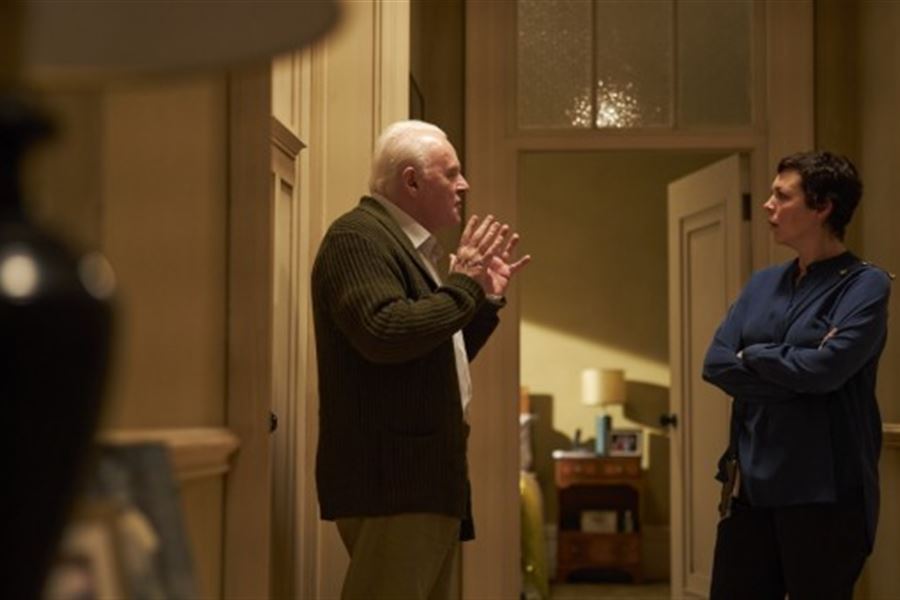
KRITIKA | The Father
Občas z prehnanej obozretnosti ľuďom neveríme. Niekedy vybehneme z bytu lebo musíme rýchlo niečo urobiť ale v momente, kedy preletíme zárubňou dverí, už nevieme, čo to bolo. Denne míňame také množstvo tvárí, že je bez šance si všetky zapamätať. Čas plynie rýchlo a tak sa nám niektoré udalosti, mesiace, roky zlievajú do jedného ako vodové farby na výkrese. Nič neobvyklé. Na svete sú však milióny ľudí, ktorí veria čoraz menej, pochybujú čoraz viac a ich spomienky pripomínajú črepy roztriešteného zrkadla. Nešťastie z toho celého sa niekedy mení na hnev, ktorým reagujú na všetkých a na všetko. Kto je tomu na vine? Alzheimerova choroba.
Práve úskaliam tejto neurodegeneratívnej choroby, ktorá sa vplíži do životov najčastejšie dôchodcom, sa vo svojom filmovom debute venuje francúzsky dramatik, divadelný režisér a scenárista Florian Zeller. The Father je filmové prevedenie Zellerovej divadelnej hry s rovnakým názvom. Hádže svetlo na problematiku obtiažnosti života s duševnou poruchou a zároveň na život v starobe, čím otvára hneď dve spoločensky významné témy.
Oko filmovej kamery detailne zachytáva život dôchodcu trpiaceho demenciou. V necelých sto minútach dáva divákovi jedinečnú možnosť nahliadnuť na svet očami psychicky chorého, starého človeka. Bez zbytočného sentimentu, či drámy poodhaľuje tajomstvá zmätenej mysle ľudí s Alzheimerovou chorobu, ktorá doteraz nie je vedecky dostatočne prebádaná a nejestvuje na ňu liek.
Hlavná postava, temperamentný osemdesiatnik žije so svojou dcérou Anne. Ako človeka ho divák spoznáva už v čase, kedy trpí nevyliečiteľnou Alzheimerovou chorobou. Keďže scenár nie je zbytočne zaťažený príbehmi z minulosti, ostáva vo filme dostatok priestoru na komplexnejšie zobrazenie samotnej choroby. Tá je charakteristická nie len stratou pamäte ale aj paranojou, frustráciou, či zmätenosťou. Pre celkové vyznenie filmu je dôležité, že predostiera všetky tieto aspekty a vyhýba sa tak povrchnému zobrazeniu starého zábudlivého človeka, s ktorým sa táto choroba najčastejšie spája.
Anthony sa od začiatku filmu snaží okolie presvedčiť, že je sebestačný a opatrovateľky, ktoré mu dcéra vybavuje zakaždým svojou nevrlosťou odoženie. Presvedčiť sa však snaží nie len dcéru Annu ale aj seba samého. Práve to, že si podvedome uvedomuje ako sa mu svet stráca v hmle v ňom vyvoláva hnev a podnecuje agresívne správanie, ktoré je najvýraznejším prejavom prežívaného smútku a bolesti.
Dej sa odohráva prevažne v byte jeho dcéry Anny. Nábytok a to ako je rozložení sa počas scén nečakane mení. Občas sa v byte zjaví cudzí muž, vraj dcérin manžel. Tvorcovia sledujúcim explicitne nepredostrú, ktoré z obrazov sú realita, čím posilňujú ich puto s hlavným hrdinom. Práve nejasnou dejovou linkou diváka dostávajú do role psychicky chorého človeka. Tak komu skutočne patrí ten byt?
Anthony je pevne presvedčený, že je jeho. Žije v ňom roky a teraz ho oň chce obrať vlastná dcéra. Paranoidné myšlienky sú pre Alzheimerovu chorobu typické. Anthony Annu neustále z niečoho upodozrieva, častuje ju urážkami a kritikou. Hnev zriedka pretne nečakaný lúč lichôtok ako keď počas búrky na chvíľu vyjde slnko. Presne tak búrlivo to vyzerá v Anthonyho hlave.
Každé dieťa túži po rodičovskom uznaní
Trpí nie len on. Vo filme je načrtnutá aj téma rodinných vzťahov a puta rodiča s dieťaťom. Anna obetuje svojmu starnúcemu otcovi všetok voľný čas. Snaží sa mu vyhovieť, zavďačiť sa a o to väčšiu bolesť pociťuje, keď ju otec obviňuje z čoraz väčších absurdít. Zmena scény. Otec Annu zrazu chváli ako dobre vyzerá. Šťastie v jej očiach zračí, ako veľmi túži po láske a uznaní svojho otca. Divák z nej cíti aké ťažké je žiť s vedomím, že ste tá menej obľúbená dcéra. A to jej Anthony servíruje veľmi explicitne a pravidelne. Lucy, svoje druhé dieťa, ktoré tragicky zomrelo opisuje len v superlatívoch. Ba priam bez autocenzúry Anne pod chvíľou šplechne do tváre, že Lucy má radšej. Je škoda, že má tak veľa práce, že sa za ním nemôže zastaviť. Anna ostáva nedocenená. Svedčí o tom každá jedna vráska, ktorá sa jej pri rozhovore s nechápavým a zatvrdnutým otcom ešte väčšmi zarýva do čela.
Čím dlhšie film trvá, tým je divák zamotanejší. Tak koho je byt? Ktorá je Anna? Prečo sa v byte občas na niekoľko minút mihnú nové tváre? Stupňujúca sa frustrácia Anthonyho presakuje cez filmové plátna a vpíja sa do každého sledujúceho. Presne taká je demencia, progresívne ochorenie mozgu, z ktorého sa nedá vymotať. To, ako sa s každou minútou všetko viac a viac zamotáva, tvorí veľmi realistický a pochopiteľný obraz vývoja, respektíve úpadku chorého. Vo filme je tento chodníček veľmi nenútene a podarene načrtnutý.
Metafory ako nenahraditeľná ingrediencia filmu
The Father nabáda diváka k premýšľaniu, prebúdza v ňom fantáziu. Metafory skryté v jednotlivých scénach si každý interpretuje po svojom, podľa toho, čo on sám prežil či prežíva. Anthony neustále kontroluje, či má hodinky. Skrýva ich na tajné miesta v byte, následne zabúda kam. Sú pre neho oporným bodom. Cíti, že sa v realite stráca, nerozumie jej a ani neverí. Jediné, na čo sa spolieha, je čas. Ten ho ukotvuje, dodáva mu aspoň aký taký pocit istoty. Alebo kontroluje koľko času mu ešte zostáva?
Metaforou je aj listnatý strom, ktorý na jeseň opadá. Staroba je jeseň života a Anthony, ako sám povedal, je konár listnatého stromu v jeseni. Bez lístia. Scéna v závere filmu, kedy to povie ošetrovateľke v domove, je veľmi hladko prepojená s úplne posledným obrazom parku. Šuštiace stromy plné sýto zeleného lístia.
Zellerovi sa veľmi dobre podarilo vtiahnuť nás divákov do zmätočného sveta starnúceho, chorého človeka. Hnev na neúprosný osud, na seba samého aj na svet projektuje Anthony väčšinu času na svoju dcéru. Veď práve ona s ním trávi najviac času. Niekedy je ale dôchodca láskavý, vďačný a práve preto ho nezatracujeme, nehneváme sa na neho. Vďaka týmto scénam vieme pochopiť, že jediné, čo chce je bezpečie a pokoj. Skryto po ňom volá počas celého filmu a vygraduje to v záverečných scénach kedy sa s plačom domáha svojej matky. Veď práve matka je symbolom bezpečia.
Čas na zamyslenie, čo ak skončíme rovnako?
Film The Father je bez pochýb dráma avšak veľmi netypická. Takmer celý čas sme v jednom byte s dvojicou postáv, ktoré dopĺňa zopár, povedala by som, prízrakov minulosti. Nie je v ňom dôležitá akcia, no napriek tomu musíte držať pozornosť celý čas. Je pomalý ale ak len na chvíľu prestanete vnímať čo sa deje, stratíte sa. Teda skôr sa zamotáte ešte hlbšie.
Duševnému zdraviu sa vo svete filmu vymedzuje čoraz väčší priestor. Stále však dominujú choroby u mladších ľudí. S tými sa predsa len vie stotožniť väčšia časť publika než s osemdesiatnikom, ktorému rapídne ubúdajú sily. Florian Zeller nás svojim filmom prinútil zamyslieť sa nad budúcnosťou, pripustiť si, že osud Anthonyho môže byť veľmi ľahko aj ten náš. Podľa výskumov Alzheimrovej spoločnosti bolo v roku 2019 len vo Veľkej Británii viac než 850 tisíc ľudí s demenciou. To predstavuje každého štrnásteho človeka vo veku aspoň 65 rokov. Liek zatiaľ nie je a predikcie hovoria, že čísla budú narastať.
The Father na 25fps

KRITIKA | Vít Klusák
Vít Klusák v současné době platí za pravděpodobně nejznámějšího českého dokumentaristu nové generace filmařů. Studium na FAMU ukončil v r. 2004 – rok poté, co společně s Filipem Remundou založili společnost Hypermarket Film. Jeho tvorba se rozprostírá na více než dvacetileté ploše. Vybudoval si unikátní konfrontační styl, typický osobitým humorem a osobní přítomností ve svém díle.
Už v prvním ročníku KDT FAMU začal Klusák zostra. V obou dostupných studentských filmech kombinuje dokumentární pasáže s hranými. Koncipovaná reportáž Digestive (2000), rekonstrukce události z otevření prvního českého McDonaldu, během které skupinka lidí manifestativně pozvracela podlahu, je drzá a nekonvenční. Role režiséra a jeho osobního názoru je zde zatím minimální, divák jen slyší Klusákův hlas. Zato do dalšího výrazného snímku, stylizovaného portrétu Ocet (2001), už autor zasahuje zhusta. Celý snímek stojí na premise, že jeho otec – hudební skladatel Emil Viklický – nesvolil k natáčení dokumentárního portrétu, a tak Klusák napsal inzerát do novin a na natáčení začal hledat někoho vzhledově podobného. Výsledkem je portrét bez portrétovaného. Klusák prozkoumává různé možnosti toho, jak o svém otci zjistit co nejvíce. Složenka psaná Viklického rukou podstoupí grafologický rozbor, odpadky poukáží na stravovací zvyky, skrze herce v divadle je zkoumáno Viklického libreto. Zatímco Digestive vznikl pod vedením televizních dokumentaristů Rudolfa Adlera a Martina Vadase, Ocet již vedla dvojice Pavel Koutecký a Karel Vachek. Klusák chtěl pod Vachkovým vlivem překročit hranice a dělat dokument jinak než ostatní. Ve filmu se doptává protagonistů, snaží se z nich dostat kýženou odpověď, povzbuzuje je, koriguje, mluví do kamery, sděluje své názory…
Magisterské studium zakončili Klusák s Remundou vskutku stylově. S velkým rozpočtem 19 milionů korun naplánovali výstavbu nákupního centra, jež nikdy nemělo vzniknout. Dnes již legendární Český sen (2004) vznikl v atmosféře referenda o vstupu do Evropské unie. Autoři umně propojili principy dokumentu, reklamní tvorby a reality-show. Úspěšný dokument je společenskou patologií, zároveň ale nechává vidět za oponu reklamního marketingu a manipulace s člověkem. Přítomnost autorů ve filmu je zásadní – jsou zde totiž hlavními postavami, strůjci celého nápadu, falešnými manažery nového obchodu. Vystupují sami za sebe, ale přesto hrají role. Působí jako filmaři s jasnou vizí, kteří přesně vědí, čeho chtějí dosáhnout. O fiktivním hypermarketu se psalo v zahraničních médiích The Times, The Guardian, The Economist či Variety, několik reportáží odvysílalo i BBC. Pomyslným pokračováním v kategorii společenské patologie byl Český mír (2010), v němž tvůrci sledují diskuzi nad tématem amerického radaru v Brdech. Snímek opět slouží jako důvěryhodný portrét soudobé společnosti, avšak oproti Českému snu se sem mnohem více dostávají politické otázky. Zajímavé je, že autoři do filmu téměř nevstupují, což se zčásti podepisuje na nižší intenzitě filmového zážitku. Čistě observační dokument je na druhou stranu veden silnou a napínavou linkou, která se nepoměr snaží vyrovnat.
Podobně dramaticky funguje první televizní film cyklu Český žurnál s názvem Život a smrt v Tanvaldu (2013), jenž je v podstatě kriminálkou s otevřeným koncem. Klusák a Remunda se mění v detektivy, kteří se snaží dopátrat pravdy v otázce smrti mladého Roma, zastřeleného bílým občanem Tanvaldu (údajně z důvodu sebeobrany). Jako detektivové procházejí městem, zkoumají jeho povahu a náladu v něm, baví se s obyvateli a také s oběma stranami konfliktu – pozůstalými a samotným střelcem. Snad nejzajímavější scénou je hádka Klusáka a Remundy, v níž diskutují o dokumentaristické etice a uvědomují si, že tento film je na hraně. Ze stejného cyklu pak vyniká dvojice dokumentů s přednostně politickou tématikou: Spřízněni přímou volbou (2013) o první přímé volbě prezidenta a Matrix AB (2015), reportážní portrét Andreje Babiše. Prostor je dáván oběma stranám a vzniká tak víceméně objektivní svědectví, pokud odhlédneme od skutečnosti, že Klusák na svých sociálních sítích často uveřejňuje angažované osobní názory. K Zemanovi a Babišovi, protagonistům obou dokumentů, se staví negativně.
Po inscenovaném portrétu neonacisty Svět podle Daliborka (2017) přišly Klusákovy snímky V síti (2020) a 13 minut (2021), které platí za osvětové filmy. Doprovázela je velká kampaň, propojená jak s obsáhlými doprovodnými materiály pro školy, tak vzdělávacími debatami a panelovými diskuzemi. V síti je nejnavštěvovanějším českým dokumentem v historii. Klusák s režisérkou a scenáristkou Barborou Chalupovou se v něm věnovali tématice sexuálních predátorů – v ateliérech postavili tři dětské pokojíčky, kde nechali telefonovat herečky v roli dvanáctiletých dívek s náhodnými muži na internetu. Vznikly tři verze: od dvanácti, od patnácti a od osmnácti let. V síti mělo nejen velký ohlas u diváků, ale také u kritiky. A co je zásadní – několik predátorů dostalo do vězení. Nejnovějších 13 minut se pak věnuje řidičům, kteří překračují povolenou rychlost. Klusák zde na viníky nehod nahlíží z různých perspektiv a propojuje prosté dokumentování s inscenovanými scénami z místa činu. Navíc k oběma osvětovým filmům vznikly původní písně a klipy. V síti doprovodil kontroverzní klip Je doma máma? s Tomášem Klusem v roli úchyla, druhý snímek pak energická Jediná vteřina Barbory Polákové a Kata. Tím autor navázal na předchozí spolupráci s Polákovou – v zimě 2020 totiž natočil klip ke coververzi Nafrněné, kde tematizoval domácí násilí.
Za více než dvacet let aktivní filmařiny se Klusákův styl nijak zásadně neproměnil, pouze nabyl profesionálního zázemí. Typickými znaky jeho díla jsou: společností (a autorem) rezonující téma, kombinování dokumentárních a hraných/rekonstruovaných záběrů, osobitý humor, cit pro gradaci a pointu a hlavně citelná přítomnost sugestivní režie, která konfrontuje, diskutuje, klade otázky, nutí k odpovědi a přemlouvá. Mnoho z filmů se pohybuje na hranici filmařské etiky: podvodný hypermarket Český sen stál miliony z našich daní, Svět podle Daliborka zneužívá omezenost hlavního hrdiny ve svůj prospěch, plnoleté herečky V síti mužům přes kamery lžou, že jim je dvanáct let. Možná právě proto, že Vít Klusák překračuje běžné etické hranice a natáčí živelným a angažovaným způsobem, dokáže tak zaujmout a ovlivnit široké masy diváků. Jeho přítomnost navíc přispívá tomu, že se s ním dokáže divák identifikovat. Na druhou stranu může být samostatný Klusák pro někoho nesledovatelnou figurou. Těžko říct, jestli je zapojování sebe samotného nějakou obsesí, nebo jen pokračováním vachkovské tradice. V každém případě je ale prvkem důležitým a v takové šíři ojedinělým. Klusákovy filmy tak působí dojmem, že režisér má všechno pod palcem a nic mu neunikne.
Vít Klusák na 25fps

KRITIKA | Pose
Jsou tomu již bezmála tři roky, co jsme na televizních obrazovkách stanice FX poprvé vstoupili na extravagantní bály newyorské LGBTQ+ scény na sklonku 80. let. Ryan Murphy se teď spolu s Bradem Falchukem a Stevenem Canalsem vrátil s třetí a závěrečnou řadou, v níž se bály a opulence pomalu vytrácí a v popředí číhá smrt v podobě zuřící epidemie AIDS. Přestože seriál rozjímá nad minulostí, která pro osoby s menšinovou sexuální orientací rozhodně nebyla růžová, Murphy ji pro nás (i pro sebe) narůžovo nabarví.
Pose (2018-2021) je série, která představuje významný milník pro reprezentaci LGBTQ+ komunity na televizních obrazovkách. Zaměřuje se totiž na ty největší vyvrhely ze všech – černošské trans ženy, pro něž je na konci 80. let jediným útočištěm rodina („House“) složená ze stejných outsiderů jako jsou ony samy, a jediným místem, kam zapadají, jsou velké bály, na nichž mezi sebou jednotlivé rodiny soupeří v rozličných kategoriích. Tématem ballroomové kultury a útrapami, které zažívají transgender osoby, které jsou už jen pro svoji odlišnou barvu kůže ostrakizovány společností, se zabývala především první série. Ta sledovala mladou ženu Blancu, kterak se musí vyrovnat s diagnózou AIDS, jež se na konci 80. let rovnala rozsudku smrti. Aby za sebou zanechala odkaz, rozhodne se založit vlastní rodinu – ujme se mladých gayů, transgender žen a jedinců z jiných marginalizovaných skupin bez domova a poskytne jim nový domov, zatímco společně soutěží na bálech – jediném místě, kde jsou i přes svou odlišnost vítáni a kde je jejich jinakost oslavována. Ve druhé sérii už se do popředí dostala problematika epidemie AIDS, která je hlavním tahounem a všudypřítomnou hrozbou i v sérii závěrečné.
Seriál v sobě napříč sériemi snoubí autenticitu, campovou estetiku vlastní Murphyho a Falchukově seriálové tvorbě a čistou fikci, a nejinak je tomu i ve třetí sezóně. Autenticita pramení především z vlivu dokumentárního filmu Paris is Burning režisérky Jennie Livingstonové z roku 1990 sledující právě newyorskou ballroom kulturu z přelomu 80. a 90. let. Některé postavy v seriálu (jmenovitě například Candy, Pray Tell nebo Elektra) mají svůj předobraz v reálných osobnostech vystupujících v dokumentu. Vyprávění autentických příběhů akcentuje i casting – do hlavních rolí byly obsazeny transgender herečky Mj Rodriguez, Dominique Jackson, Indya Moore a Angelica Ross, které útrapy a příkoří, jež musejí jejich postavy zažívat, mnohdy nemusely hrát. A není také náhodou, že Jennie Livingstonová spolupracovala po bezmála třiceti letech od vzniku dokumentu při psaní scénáře jako konzultantka.
Největší sílu má seriál právě na bálech, které v sobě nejlépe kombinují autenticitu a camp – zobrazují svět neproniknutelný lidem zvenčí, ale o nic méně fascinující, extravagantní a plný barev, tance, voguingu a sounáležitosti. Tak jako Madonna v roce 1990 svým klipem Vogue obrátila pozornost k LGBTQ+ komunitě a voguing se z malých bálů přesunul do mainstreamu, dnes na fenomén ballroom kultury v moderně aktualizované podobě navazuje reality show ověnčená 19 cenami Emmy RuPaul’s Drag Race. A možná i mainstreamová popularita této franšízy motivovala Murphyho potřebu vrátit se zpět ke kořenům tohoto fenoménu a napomohla diváckému úspěchu Pose.
Závěrečná série nicméně opouští opulentní bály, záplavu barev a oslavu jinakosti, podobně jako se fenomén ballroomu na newyorské scéně pomalu vyčerpal, a zaměřuje se na šeď a černotu všudypřítomné smrti v důsledku epidemie AIDS, která byla v polovině 90. let ve Spojených státech na samotném vrcholu. Právě zde autenticita jaksi ustupuje do pozadí, přestože seriál neopomíjí ony stovky tisíc obětí, které si epidemie i vinou liknavého přístupu široké veřejnosti vyžádala, jejich utrpení však nepojmenovává prostřednictvím hlavních postav. Ty stojí uprostřed tohoto marasmu plného beznaděje, strachu ze smrti a nekonečné šňůry pohřbů uvnitř komunity, přesto jim Murphy nedokáže upřít šťastný konec. Jedinou výjimkou je Pray Tell, na jehož odchod ovšem seriál diváka připravuje celou sérii a jehož představitel Billy Porter tráví na obrazovce nejvíce času, aby byl jeho příběh dopsán do poslední tečky. Ke všem ostatním postavám přistupuje Murphy až mateřsky ochranářsky a každá z nich nakonec míří k pohádkovému konci – Elektra se vypracuje jako úspěšná a bohatá podnikatelka, Angel se stává matkou na plný úvazek, zatímco Blanca díky experimentální léčbě přemůže smrtící virus a pracuje jako zdravotní sestra.
Potřeba reinterpretovat historii Murphyho zlákala už v jeho dřívějším projektu Hollywood (2020), minisérii, která – podobně jako Tarantinovo Tenkrát v Hollywoodu (2019) – fungovala jako eskapistický a až naivně zidealizovaný pohled na období poválečného Hollywoodu. Místo plné pozlátka a splněných snů, které ze své podstaty vybízí k idealizaci a vytváření mýtů, navíc časově vzdálené více než 7 dekád, Murphy vyměnil za poměrně nedávné období, které sám zažil a jehož dozvuky pociťujeme dodnes i my, kdy se dříve tabuizovaná nebo okrajová témata častěji dostávají do diskurzu populární kultury.
Otázkou zůstává, proč vyměnit autenticitu za fikci? Proč dopřát svým postavám vytoužený happy end, navzdory temné a bezútěšné situaci, v níž se nachází? Murphy neodložil autenticitu stranou, tedy alespoň ne úplně. Protestní akce organizace ACT UP, sypání popela obětí epidemie na trávník starosty New Yorku, stejně jako rutinní účast na pohřbech a smrt uvnitř komunity jsou věci, s nimiž se LGBTQ+ lidé v polovině 90. let denně potýkali. Autenticita je ovšem narušena tím, že se tato katastrofa většině hlavních postav vyhne, a tak zůstávají „jen“ stovky tisíc bezejmenných obětí, s nimiž se ovšem můžeme identifikovat maximálně skrze postavu Pray Tella (případně Cubbyho). Opačným směrem se rozhodl vydat britský seriálový tvůrce Russel T Davies v letošní minisérii Byl by to hřích z produkce Channel 4, která rovněž tematizovala hrůzy epidemie AIDS, tentokrát v prostředí Londýna. V ní mají oběti moru gayů konkrétní tvář a jméno a skrze subjektivní pohled vypravěče, kterým je hlavní hrdina Ritchie, dosahuje seriál osobitější perspektivy (protože umožňuje ztotožnění s postavami a jejich utrpením) a posiluje tak emocionální dopad místy hraničící s citovým vydíráním.
Oproti tomu je Pose až pohádkovým příběhem s poselstvím plným naděje. Možná ale únik z šedivé a ponuré reality do nablýskaných barevných sálů plných dragu, extravagance a opulence potřebujeme víc než depresivní skutečnost. A možná jej potřebuje i sám Murphy, který se stejně jako Blanca s Elektrou octl v 90. letech v oku tornáda zákeřné nemoci a byl svědkem tolika zmařených a předčasně ukončených životů mladých lidí. I přes jistou schematičnost a závěr, který se nevyhne několika klišé, se jedná o sérii se silně osobním vkladem, která zůstává věrná murphyovsko-falchukovské estetice a šíří pozitivní poselství o sebepřijetí a sounáležitosti mezi „vyvrhely“ společnosti. Ve svém závěru tak jde především o jakési vyrovnání se se ztrátou, smrtí a temnými oblaky minulosti, které ovšem terapeuticky protrhnou paprsky naděje s vyhlídkou lepších, růžovějších zítřků.
Pose
Tvůrci: Brad Falchuk, Ryan Murphy, Steven Canals
Režie: Ryan Murphy, Nelson Cragg, Gwyneth Horder-Payton, Silas Howard, Tina Mabry, Janet Mock, Steven Canals, Jennie Livingston, Billy Porter
Scénář: Brad Falchuk, Ryan Murphy, Janet Mock, Our Lady J, Steven Canals
Kamera: Nelson Cragg, Simon Dennis, Andrei Bowden-Schwartz
Hudba: Mac Quayle
Hrají: Mj Rodriguez, Ryan Jamaal Swain, Indya Moore, Evan Peters, Kate Mara, Dominique Jackson, Billy Porter, Angelica Ross, Angel Bismark Curiel, Dyllón Burnside, Charlayne Woodard, James van der Beek a další
USA, 2018-2021, 3 sezóny, 26 epizod (24 hod. 50 min.)
Pose na 25fps

KRITIKA | Bydlet proti všem
Tmavá chodba, špinavé steny, rozbité dvere. Chlapec sa zabáva s plastovou flašou s nápisom Coca-Cola medzi tým, ako jeho rodičia nakladajú svoje skromné vlastníctvo do dodávky. Kam presťahovať deväťdesiat ľudí, ktorí zo dňa na deň stratili strechu nad hlavou a ako zmeniť súčasný systém tak aby sa to neopakovalo? Režisér Tomáš Hlaváček vo filme Bydlet proti všem túto otázku rozvrstvuje a observačne reportážnym štýlom sleduje snahu Martina Freuda z hnutia Žít Brno zmeniť systém “z vnútra”. Ten naráža na odpor v podobe politickej hry o moc, ktorá svoju stratégiu zakladá na populizme a vytváraním dojmologických vzorcov, tak ako na odpor občanov nevedomky ukazujúcich svoj strach a hlboko zarytý rasizmus.
Dej celého filmu sa odohráva v Brne, ktoré ako prvé v republike prebralo a zahájilo implementáciu nizozemského projektu Rapid-Rehousing. Pomocou jedného z hlavných , Martina Freuda, sa zoznamujeme s pripravovaným projektom riešenia zabydlovania nízkopríjmových rodín, ktoré sú najviac ohrozených generačnou chudobou. Rodiny, ktoré každý deň bojujú o udržanie si stabilného bývania sa stávajú jednoduchým terčom biznisu s chudobou. Tento biznis sa stáva kľúčovým momentom, na ktorom je vystavaný celý dej filmu, od krízového momentu vysťahovania niekoľkých rodín zo dňa na deň a jeho následného riešenia, ktoré sa stáva rozporom medzi pravicovými a ľavicovými politikami mesta Brno, ale aj samotnými občanmi. Sledujeme nespočetné zasadania a presviedčanie zastupiteľov mestských častí o pridelenie neobsadených mestských bytov do pilotného projektu, debaty v televízii, vystúpenia pred verejnosťou a neustále dokazovanie lživosti opozície či zjednodušovania situácie a prekrúcania faktov. Cez druhú postavu, sociálneho pracovníka Honza Milotu sa dostávame priamo do terénu a sledujeme praktickú implementáciu projektu cez všetky jeho fázy – mapovanie súčasnej exploatácie predražených ubytovní v neľudských podmienkach na život, následného losovania náhodne vybraných rodín, ktoré boli vyhodnotené sociálnymi pracovníkmi ako rizikové, až po ich úspešné presťahovanie a ich zabydlovania medzi novými nedôverčivými susedmi.
Dej, zachytený reportážnym štýlom, cez mnohosť situácií a rozhovorov, prelínané ustavujúcimi zábermi na pohľady obytných častí mesta s ľahkosťou prepája linky dvoch hlavných hrdinov sa narácia stáva vysoko komunikatívnou cez každý jeden obraz. Množstvo informácií však diváka nezahlcuje a dynamika oboch liniek, ktoré nám na jednej strane ukazujú náročný byrokratický proces a na druhej jeho reálne dopady divákovy dopomáhajú pri uchopení komplexnej témy s jeho mnohými vrstvami. Monotónne statické obrazy dlhých zasadnutí zaberajúcich debaty sediacich zastupiteľov striedajú expresívne zábery z ubytovní v dezolátnom stave.
Pri zaberaní tak expresívnych obrazov môže skrsnúť myšlienka, nakoľko je potreba zachytávať nahotu chudoby v jej najzraniteľnejších momentoch. Tomáš Hlaváček sa však vyhýba hraniu na divákove emocie a precízne zaberá len to, čo divákovi poskytuje stežijné informácie pre pochopenie závažnosti absencie zákona o bývaní. Nechce a nesnaží sa v divákovi vyvolať ľútosť, ale cez problematiku sociálneho bývania a jeho spoločenského vnímania nastavuje zrkadlo celej českej spoločnosti, ktorá si myslí, že rasizmus sa prejavuje len fyzickým násilím.
Ani v dramatizácii výstavby filmového snímku neskĺza k jednoduchej zápletke, ktorá by mala šťastné a jednoduché rozuzlenie a v divákovi by vytvorila na konci snímku falošný pocit uspokojenia z uzatvorenia príbehu. Namiesto zjednodušovania siaha po jasnej linke vzostupu a pádu politických jednaní motivovaných skutočným presvedčením a túžbou hlavných hrdinov dokázať, že aktívnym prístupom občanov i uplatňovania sociálnej spravodlivosti dokážeme docieliť zmenu, v ktorú veríme. Cieľom dokumentu a jeho protagonistov nie je len zobrazenie zdanlivo bezvýchodiskovej situácie, ale iskra nádeje, že i cez neslávny koniec projektu v Brne, sa do podobných aktivít vrhli i v iných, otvorenejších mestách.
Bydlet proti všem
Režie: Tomáš Hlaváček
Kamera: Tomáš Hlaváček, Petra Hlaváčková
Střih: Tomáš Hlaváček, Varvara Šatunova
Hudba: Simo Hakalisto, Andrej Nechaj, Martin Bukáček
Produkce: Vít Janeček, Tomáš Hlaváček
CZ, SK, 2021, 97 min.
Bydlet proti všem na 25fps

Prosincová Audiovizuální sauna
Audiovizuální sauna se vrací první prosincový víkend s on-line přednáškami a workshopem.
Čtvrtá edice projektu Audiovizuální sauna se uskuteční v neděli 5. prosince a prostřednictvím on-line přenosu se zaměří hned na dvě témata.
Prvním z témat je kritika současného výtvarného umění. Kritička a teoretička Eva Skopalová se ve své přednášce Krize (pl.) nejen výtvarného umění zaměří na uměleckou kritiku v kontextu současných globálních krizí, ale také na její pozici v rámci lokální i mezinárodní umělecké scény.
Svou dosavadní praxi bude reflektovat Viktor Čech v příspěvku s názvem Kritik versus kurátor. Jakým způsobem se liší uvažování kritika a kurátora? Kam sahají pravomoce obou postav, jaký má dosah slovo či činy každého z nich a mohou se navzájem diskvalifikovat?
Druhým tématem jsou festivaly. Programový ředitel festivalu Academia Film Olomouc Ondřej Kazík se ve své přednášce trefně pojmenované Festival není místo, ale stav mysli zamýšlí nad smyslem festivalů. Jak najít poslání pro festival? A proč je důležité stanovit si cíle? Přednáška představí důležité strategické kroky a příklady z festivalové praxe.
Festival pro všechny? Je jím právě Signal Festival? Na to se zaměří program manager festivalu Mario Kunovský. Signal již 9 let úspěšně vstupuje do veřejného prostoru a přibližuje tak umění a design široké veřejnosti. V posledních ročnících přenesli formát festivalu do 21. století prostřednictvím virtuální a rozšířené reality.
Festivalový blok vyvrcholí workshopem Jak se dělá festival? Účastníci si budou moct pod vedením lektorů Ondřeje Kazíka a Mario Kunovského vytvořit koncepci vlastního festivalu, tvořit vizi, hledat cíle. Díky znalostem z přednášek budou schopni argumentovat konkrétní dramaturgická a produkční rozhodnutí a propojovat tak teorii s praxí.
Workshop je určen omezenému počtu účastníků a je nutné se na něj předem registrovat. Pro všechny přihlášené je povinná účast na předchozích dvou přednáškách. Registrovat se můžou ZDE.
Harmonogram
10:00 – Eva Skopalová: Krize (pl.) nejen výtvarné kritiky
11:30 – Viktor Čech: Kritik versus kurátor
14:00 – Ondřej Kazík: Festival není místo, ale stav mysli
15:30 – Mario Kunovský: Festival pro všechny?
17:00 – Workshop: Jak se dělá festival?
Jak se zapojit?
Všechny přednášky budou vysílány prostřednictvím platformy Facebook Live v události a na facebookové stránce Kina Kavalírka. Workshop je uzavřený – po registraci vám bude zaslán link k připojení.
Dotazy
Případné dotazy směřuj na vykon@elbedock.cz.

AKCE | Workshop: Jak se dělá festival?
Uzavřený workshop pro přihlášené účastníky
Jak se dělá festival? Jak se dělá dnes? Vyzkoušej si vytvořit koncepci vlastního festivalu pod vedením zkušených lektorů.
Kdy a kde?
5. prosince v 17:00 on-line.
Co Tě čeká?
V tomto workshopu si můžeš vyzkoušet vytvořit koncepci vlastního filmového nebo audiovizuálního festivalu. Pod vedením lektorů budeš dělat praktická i dramaturgická rozhodnutí, tvořit vizi. Workshop podpoří tvé kritické myšlení a propojí dramaturgický/kurátorský přístup k uměleckým dílům s komplexním produkčním uvažováním. Výsledky budeš prezentovat před lektory a dalšími účastníky modelem ďáblův advokát, který bude mít za cíl kritickými argumenty vizi zlepšovat a konkretizovat. Výslednou podobu pak odevzdáš formou psaného textu.
Jak se zapojit?
Workshop je určen omezenému počtu účastníků a je nutné se na něj předem registrovat. Po registraci Ti bude zaslán link k připojení. Pro všechny přihlášené je povinná účast na přednáškách Festival není místo, ale stav mysli a Festival pro všechny?
Registrace
Registrovat se můžeš přes formulář ZDE.
Dotazy
Případné dotazy směřuj na vykon@elbedock.cz.

AKCE | Festival pro všechny?
Masterclass Signal Festivalu
Jak přiblížit umění a design široké veřejnosti? Signal Festivalu se v posledních letech podařilo úspěšně vstupovat do veřejného prostoru a tím přibližovat umění a design široké veřejnosti. V době covidové navíc přivedli formát festivalu do 21. století a vytvářeli obsahy ve virtuální a rozšířené realitě a snažili se akci co nejvíce přiblížit ideji udržitelnosti. Jak se jim to podařilo? Jakým výzvám musí festivaly v současnosti čelit?
Signal Festival
Signal je festival digitální a kreativní kultury. Za 9 let v Praze přivítal více než 3 miliony diváků. Program je tvořen renomovanými zahraničními i českými umělci z oblasti light designu, vizuálního a digitálního umění, umělé inteligence, ale i konceptuálního umění. Festival rád vzdělává sebe i návštěvníky. Spojuje historické kulisy milované Prahy s nejnovějšími technologiemi a současnými společenskými tématy. Signal Festival je jedním z největších producentů současného umění u nás. Podporuje nejmladší české tvůrce, stál u vzniku více než sedmdesáti originálních instalací, které byly vytvořeny speciálně pro festival. Pořádá doprovodné programy pro děti, odbornou veřejnost i studenty. Spolupracuje s celou řadou zahraničních festivalů a kulturních institucí.
Kdy a kde?
5. prosince v 15:30 on-line.
Jak se zapojit?
Všechny přednášky budou vysílány prostřednictvím platformy Facebook Live v události a na facebookové stránce Kina Kavalírka.
Dotazy
Případné dotazy směřuj na vykon@elbedock.cz.

AKCE | Festival není místo, ale stav mysli.
Masterclass Ondřeje Kazíka
Jak najít poslání festivalu? Filmové festivaly jsou místa setkávání, oslavy umění i neopakovatelné rituály moderní kultury. Proč si při organizaci festivalu definovat poslání a cíle festivalu? Proč děláme to, co děláme? Jaký má vůbec filmový festival smysl? Je festival víc, než filmové projekce a večerní party? Přednáška představí důležité strategické kroky a příklady z festivalové praxe. Mezinárodní festival populárně-vědeckých filmů AFO (Academia Film Olomouc) pořádá Univerzita Palackého v Olomouci již od roku 1966. Nejstarší festival vědeckých filmů v Evropě se v průběhu posledních dvaceti let proměnil z komorní akce v zásadní mezinárodní filmovou událost a výrazně přispěl k rozšíření a popularizaci tohoto filmového žánru. Hledání cílových skupin, vnitřní motivace týmu, komunikace značky festivalu, to vše se odvíjí od jasně definovaného poslání a konkrétních cílů. O fascinujících setkáních filmu a vědy promluví programový ředitel festivalu AFO Ondřej Kazík.
Ondřej Kazík
Absolvoval obory Kulturní antropologie a Filmové vědy na FF UP v Olomouci. Podílel se na organizaci kulturní platformy Pastiche Filmz, z.s. jako programový vedoucí filmového klubu. Od roku 2015 působí jako dramaturg na mezinárodním festivalu populárně-vědeckých filmů Academia Film Olomouc (AFO). V současné době zde pracuje na pozici vedoucího programu a studuje doktorské studium na Katedře divadelních a filmových studií Univerzity Palackého v Olomouci, kde se věnuje výzkumu současné distribuce dokumentárního filmu.
Kdy a kde?
5. prosince ve 14:00 on-line.
Jak se zapojit?
Všechny přednášky budou vysílány prostřednictvím platformy Facebook Live v události a na facebookové stránce Kina Kavalírka.
Dotazy
Případné dotazy směřuj na vykon@elbedock.cz.

AKCE | Kritik versus kurátor
Masterclass Viktora Čecha
Jakým způsobem se liší uvažování kritika a kurátora? Jedná se o obory stojící na opačných koncích procesu vystavování současného umění? Jakým nástrahám je vystaven odborník působící jak v oblasti výtvarné kritiky, tak kurátorství? Ať už kritika nebo kurátorství, oba obory mají jistě jedno společné – interpretují, a tak svým způsobem používají podobné myšlenkové postupy. Kam však sahají pravomoce obou postav, jaký má dosah slovo či činy každého z nich a mohou se navzájem diskvalifikovat? Viktor Čech je příkladem kritika-kurátora, který se v masterclass nazvané Kritik versus kurátor zaměří na reflexi své dosavadní praxe. Poodhalí teoretické procesy spojené s oběma profesními rolemi a jejich podobami v kontextu české umělecké scény.
Viktor Čech
Je nezávislý kritik, kurátor a teoretik současného umění. Studoval dějiny umění na Filozofické fakultě Univerzity Karlovy a doktorát na Fakultě umění a designu UJEP. Přednášel výtvarnou didaktiku na Pedagogické fakultě Univerzity Karlovy. Od roku 2005 připravil řadu výstavních a kurátorských projektů, zaměřených na různá témata současného umění. V roce 2019 se stal laureátem Ceny Věry Jirousové v kategorii etablovaných kritiků a za přínos oboru. V současnosti se zabývá vztahem mezi výtvarným uměním a choreografií a tancem.
Kdy a kde?
5. prosince v 11:30 on-line.
Jak se zapojit?
Všechny přednášky budou vysílány prostřednictvím platformy Facebook Live v události a na facebookové stránce Kina Kavalírka.
Dotazy
Případné dotazy směřuj na vykon@elbedock.cz.

AKCE | Krize (pl.) nejen výtvarné kritiky
Masterclass Evy Skopalové ve spolupráci s Cenou Věry Jirousové
Když se výtvarný kritik a historik umění, Arthur C. Danto, v roce 1997 zamýšlel nad uměním po konci umění, získala umělecká kritika v jeho argumentaci výsadní pozici – ale je tomu skutečně tak i po bezmála čtvrt století? Můžeme psát o umění, když planeta hoří? Můžeme psát o umění, když všechny výstavy byly uzavřeny nebo zrušeny? A můžeme psát o umění, když nás tato profese neuživí? A vůbec, jak a o čem či o kom můžeme psát, abychom se nedostali do střetu zájmů? Otázky, na které hledáme odpovědi jsou lokálně podmíněné, ale současně je to nastavení mezinárodní umělecké scény, se kterou tuto úzkost z textů sdílíme. Letos problematiku například otevřela editorka britského měsíčníku Art Monthly, Patricia Bickers, v knize The Ends of Art Criticism, stejně jako Brad Haylock & Megan Patty ve sborníku Art Writing in Crisis. Ve svém příspěvku se proto Eva Skopalová bude věnovat jejich reflexi a pozici krize v našem lokálním kontextu.
Eva Skopalová
Studovala dějiny umění na Filozofické fakultě Univerzity Karlovy v Praze a teorii a historii moderního a současného umění na UMPRUM v Praze. Je předsedkyní spolku Ceny Věry Jirousové, která je každý rok udílena etablovaným i mladým začínajícím kritikům. V současnosti působí jako kurátorka Sbírky moderního a současného umění Národní galerie v Praze.
Kdy a kde?
5. prosince v 10:00 on-line.
Jak se zapojit?
Všechny přednášky budou vysílány prostřednictvím platformy Facebook Live v události a na facebookové stránce Kina Kavalírka.
Dotazy
Případné dotazy směřuj na vykon@elbedock.cz.
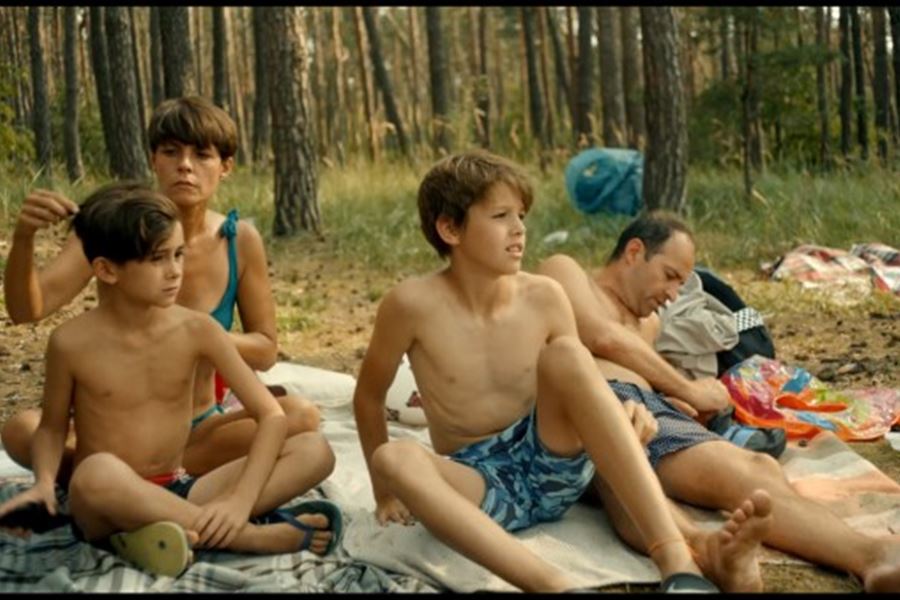
Anatomie českého odpoledne – daň za lhostejnost
„Já jsem tam nebyl, takže bych nechtěl dávat nějaký soudy. Jenom jsem portrétoval Čechy tak, jak je vnímám.“[1] uvádí v medailonku nominací na Českého lva režisér Adam Martinec. Jeho studentský snímek Anatomie českého odpoledne získal hned dvě ocenění v rámci 28. ročníku cen Českého lva, a to v kategorii Nejlepší krátký film a Cena Magnesia za nejlepší studentský film.[2] Anatomie českého odpoledne také sklidila úspěch v rámci Ceny české filmové kritiky, kde taktéž vyhrála v kategorii Nejlepší krátký film. [3]
Režisér na 25 minutách analyzuje prvky patologického chování návštěvníků koupaliště. Divákovi servíruje symfonii zmnožených perspektiv, kdy každá scéna začíná a končí s jiným aktérem. Kamera postavy sleduje a navozuje tak pocit, jako by si problémy mezi sebou přehazovaly. Zoufalé prosby maminky, zda někdo neviděl její ztracené syny jemně narušují vulgárnost prostupující všemi kouty koupaliště. Není však schopna nezájem a neochotu masy přehlušit. Neslušnost, přehazování viny na někoho jiného, zamlčení vlastního pochybení a ignorace se stávají hlavními tématy filmu. Do hledání dvou malých chlapců se kromě policie zapojují pouze zaměstnanci rekreačního střediska. S rozvíjející se intenzitou pátrání, stoupající nervozitou ze strany plavčíka, majitele a pokladní, vnímáme houstnoucí dusnou atmosféru horkého dne, který se pomalu jistě proměňuje v tragédii. Záběry návštěvníků, dětí skákajících ve vodě, telefonující paní, nám však v kontrastu ukazují laxnost a vědomé přehlížení hlášení z amplionu. Implicitně tak zde vyvstává česká formulka to se mě netýká, nemám to zapotřebí. Nehas, co tě nepálí. Avšak i zaměstnanci představují čecháčkovský zlom v narativu, kdy se snaží ve změti pochybení, najít prostor pro své vlastní alibi. A jaká je tedy daň za lhostejnost? Režisér se těžkého tématu zhošťuje po hrabalovsku a tím dostává film specifický nádech českého tragikomična. Banální situace, humorné promluvy typu „dopiju a jedu“, tu narážejí na ty tragické. Ryze observační pohled na jednotlivé klíčové postavy a jejich charakterový vývoj poukazuje na patrnou inspiraci českou novou vlnou.
Kromě hlavní pátrací linie odehrávající se na břehu, je možné sledovat ještě vedlejší linii dětí pohybujících se v lese, později i ve vodě. Do poslední chvíle nás tato linie příběhu fungující na velmi jednoduchém principu nechává v napětí.
Závěr filmu odkrývá celkovou deziluzi jak návštěvníků postávajících na břehu jezera, tak postavy plavčíka, kterému dochází, že zábava zachránce bez trička, popíjející u stánku pivo, právě skončila. A to velkou odpovědností a tragédií, která se již nesmí opakovat. Kolektivní odpovědnost a vina se zde projevuje skrze anonymitu, která je v závěru odkryta. Svižná úvodní scéna, podkreslená písní Malá dáma od populární české kapely Kabáti, anonymizuje dav příchozích návštěvníků tím, že vidíme pouze jejich spodní část těla. Symbolika typického čecháčkovství střední třídy je zde předložena skrze obuv – sandále, ponožky, tenisky, nateklé kotníky starších dam, igelitové a plážové tašky. Anonymita a kolektivní odpovědnost pokračuje ve scéně, kde přes rozostřená těla postávajících návštěvníků, vidíme zlomový moment snímku. Závěr filmu nám již tento bezejmenný dav odkrývá, vidíme jednotlivé postavy, které mlčky se sklopenou hlavou opouštějí rekreační středisko. Mohli jsme něco udělat? Tuto ponurou atmosféru naruší postarší pár, který překáží sanitce v cestě a tváří se, jako by se nic nestalo. Nehas, co tě nepálí.
Anatomie českého odpoledne tedy trefně odkazuje ke svému názvu, pitvě malého českého člověka. Jedno parné odpoledne, kdy si každý chce užítjen svoji volnou chvíli versus vážná událost, která postupně odkrývá tragické prvky v rozkolu společnosti. Ve filmu, kde nesmí chybět pivní břich, tak Martinec bravurně vykresluje portrét češství, takový, který byste cizinci jako medailonek ukázat nechtěli.
Anatomie českého odpoledne
Česká republika, 2020
Délka: 22 minut
Režie: Adam Martinec
Scénář: Adam Martinec
Kamera: David Hofmann
Produkce: Matěj Paclík
Hrají: Jakub Špalek, Simona Peková, Jiří Šeda, Matouš Borecký, Adam Kyznár
[1] ČESKÝ LEV, ČFTA. 28. Český lev – nominace – nejlepší krátký film. Youtube [online]. Český lev – ČFTA, 2021 [cit. 2021-5-7]. Dostupné z: https://www.youtube.com/watch?v=ElIon6O_H54
[2] ČESKÝ LEV, ČFTA. Výsledky 28. ročníku cen Český lev [online]. In: . 7.3. 2021 [cit. 2021-5-7]. Dostupné z: https://www.ceskylev.cz/cz/novinky/vysledky-28-rocniku-cen-cesky-lev
[3] Ceny české filmové kritiky 2020. In: Sdružení českých filmových kritiků [online]. [cit. 2021-5-7]. Dostupné z: http://filmovakritika.cz/ceny-ceske-filmove-kritiky-2020/
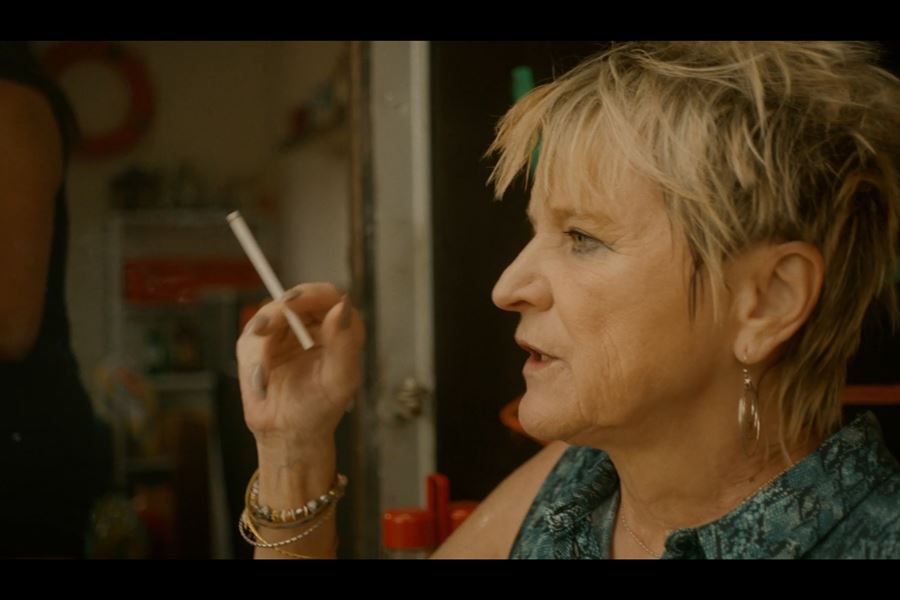
KRITIKA | Ešte jedno pivo!
Anatomie českého odpoledne, krátkometrážna dráma v réžii študenta FAMU Adama Martince, je už druhý film, ktorým vzbudil pozornosť. Jeho predchádzajúci snímok Cukr a Sůl z roku 2018 bol nominovaný na cenu Magnesia litera za študentský film, ale až Anatomie českého odpoledne túto nomináciu v roku 2020 premenila a na konto sa pridalo aj ocenenie Českého lva za Najlepší krátky film. Martinec sa inšpiruje výraznými tvorcami česko-slovenskej novej vlny, no už v porovnaní jeho dvoch krátkych filmoch, môžeme vidieť posun k vlastnému filmovému štýlu a tematizovaniu filozofických otázok v konfrontácii s bežným, až banálnym ľudským chovaním. Anatómia – náuka o tvare a stavbe organizmu sa v tomto snímku stáva neúprosným pohľadom na českú spoločnosť a stereotypy, ktoré o sebe samých Česi majú. Nezostáva však len v tejto rovine, ale tematizuje aj otázku viny, náhody a všednosti.
Film predstavuje každému veľmi známu udalosť – víkendovú pohodu na jazere, ktorá sa v zlomku okamihu môže premeniť na tragédiu. Rodiny a kamaráti sa schádzajú na parkovisku, vyberajú nafukovačky, pivká a svačiny. Sandále, krátke nohavice, pocit plastových plaviek pod oblečením a klobúk na hlave. Pohoda sa mieša s nevrlými dialógmi medzi protagonistami a potiacou sa pokladníčkou zasadenou do atmosféry klasického post-sovietskeho interiéru. Banalitu vyruší až hlas matky, ktorá hľadá dvoch stratených chlapcov. Tento hlas je však upozadený laxnosťou okolia – o nič predsa nejde, je to deň ako každý iný, preto ani kamera nezaberá to, čo sa v danej chvíli zdá byť nepodstatné.
Od začiatku snímku plynule prechádzame medzi niekoľkými hlavnými postavami. Dlhé pomalé zábery, ktoré sa premiestňujú z postavy na postavu a pomáhajú budovať pokojnú atmosféru dotvárajúcu všednosť bežného popoludnia pri vode a upriamujú našu pozornosť na ich správanie. Hlas matky sa k nám dostáva druhýkrát, pri zaberaní plavčíka v strednom veku, bez trička a s pupkom, ktorý bol vyrušený pri pití svojho piva. Na otázku, či nevidel dvoch stratených chlapcov, odpovedá:„Kde? Vevodě?“ K odmietaniu závažnosti celej situácie prispieva vedúci celého zariadenia, ktorý podotýka, že sa to predsa deje každý deň. Konflikt – hľadanie stratených chlapcov, nezobrazuje akciu, volanie polície, prehľadávanie lesov, miesto toho sa divákovi postupne odhaľuje psychológia jednotlivca, ktorý sám nevie, čo presne má robiť a vždy si myslí, že aktivitu vyvinie niekto iný. Pretože on si musí dopiť svoj kelímok piva.
Režisér a scenárista v jednej osobe si miesto dramatizácie príbehu vyberá zobrazovanie konania jednotlivých postáv a premenu ich laxného postoju pod ťahom stále vážnejšej situácie a pomaly sa končiaceho dňa. Stupňujúce sa napätie pozorujeme cez vnútorné rozpory, ktoré prežíva jednotlivec pod nátlakom okolia a vlastného vedomia. Stereotypy ako neustále sťažovanie sa, pitie piva, fajčenie cigarety a určité pohodárstvo, sa postupne premieňa i na osobnú drámu a bezbrannosť každého z nich. Strach a pocit viny plavčíka na konci snímku nám odhaľuje neistotu nejednoznačných situácií, kde sa formuje vina medzi jednotlivcom a kolektívom. Tá sa však uzatvorí keď jeho „otrlý“ nadriadený, ktorý žiadnu vinu neprijíma, prehlási: „Hovno, tam je to napsaný. Na vlastné nebezpečí.“
Martinec týmto snímkom nastavuje zrkadlo súčasnej českej spoločnosti, v ktorej panuje vulgárnosť i na tých najvyšších miestach. Robí to ale s veľkou dávkou rešpektu a pokory, nikoho neuráža, ani neobviňuje – vnímavo pozoruje a s trpkosťou vnáša do charakterov svojich postáv správanie, ktoré vidí v bežnom živote. A týmto jednoduchým spôsobom i prepája a uzatvára Anatomii českého odpoledne – zobrazením hašteriacej sa bežnej českej rodiny, ktorej sa žiadna tragédia nedotkla – a preto na konci snímku otec posiela svojho malého syna kúpiť ešte jedno pivko, kým nezapadne slnko a ich pohoda na rozprestretej deke neskončí.
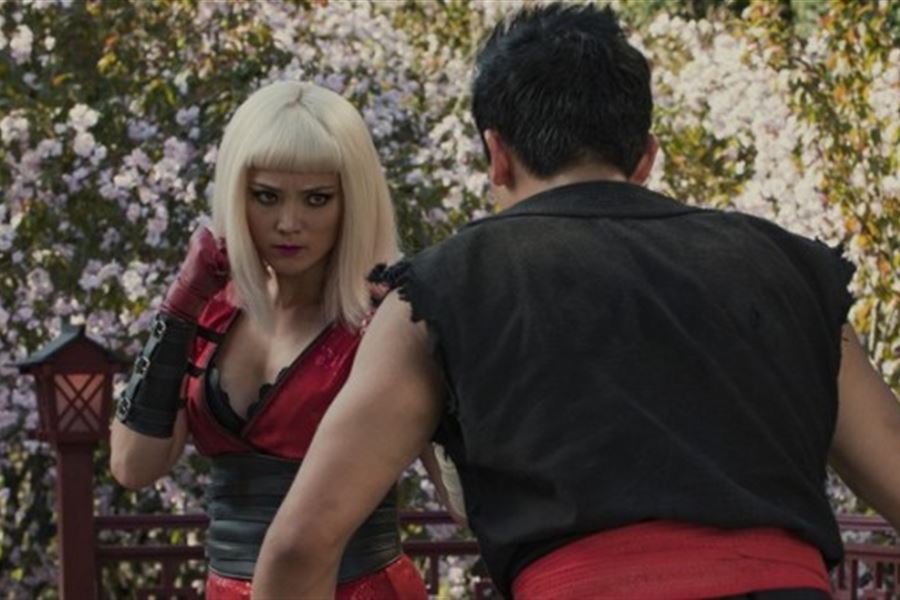
KRITIKA | Archetypy ako kontexty v audiovizuálnom umení
Príspevok sa venuje analýze vybraných diel, ktoré súvisia s prejavom archetypu*. Teória archetypov je spojená s Dr. Carlom Gustavom Jungom a jeho užšou teóriou o archetypálnych vzoroch − (matka, tieň, maska, anima/animus, ja)*. Text podrobnejšie rozoberá príklad zo svetovej kinematografie – film 8 ½ od talianskeho režiséra Federica Felliniho. Esej sa venuje aj aktuálnym seriálom, ktoré sú vysielané na populárnych streamovacích platformách – Black Mirror (od r. 2015 na Netflixe) a Euphoria (od r. 2019 na HBO).
Tieto príklady sú audiovizuálne diela, ktorých obsahom sú prejavy archetypov predovšetkým v súčasných pohyblivých obrazoch. Esej sa snaží načrtnúť analýzu takých pohyblivých obrazov, v ktorých sa dnes v toku digitálnych médií môžeme stretnúť s prítomnosťou archetypov. Dokázať, že tieto archetypálne pravzorce plynulo prešli zo sveta fyzického do sveta nových obrazových súvislostí, ktoré sú založené na princípe technických obrazov. Tieto nové technické obrazy definuje teoretik nových médií Vilém Flusser ako technoimagináciu.
Súčasná česká filozofka, teoretička a historička filozofie prof. Hana Hogenová v rozhovore pre Petra Horkého uvádza dôvod prečo je dôležité poznanie teórie archetypov C. G. Junga takto: ,,Myslím, že poznanie Jungových archetypov pomôže človeku orientovať sa v dnešnej dobe. Je to súčasťou ľudskej kolektívnej duše, je to niečo, čo vidíme na sebe, na ľuďoch každý deň.“[1]
Pri štúdiu dejín umení sa stretávame s kontextmi, ktoré súvisia so psychoanalýzou a Sigmundom Freudom, ktorý bol spojený hlavne so surrealizmom.[2]
Prejavy umenia, ktoré sú spojené so psychológiou v oblasti analytickej psychológie* sú menej známe ako tie, ktoré sú spojené so psychoanalýzou*. Aj napriek tomu, však nájdeme synchrónne diela, ktoré vychádzajú alebo sú inšpirované teóriami o analytickej psychológii či konkrétnejšie teóriou o archetypoch podľa C.G. Junga. Príklady môžeme nájsť predovšetkým vo výtvarnom umení, a to médiu maľby (Mark Rothko, Jackson Pollock), taktiež vo filmovom umení založenom na princípe pohyblivého obrazu alebo v iných médiách. Čo ale o umení hovorí samotný Jung, zakladateľ analytickej psychológie?
Na jednej strane Jung tvrdí, že umenie a z neho plynúce umelecké zážitky sú vždy tak trochu neúplné no na druhej strane, pridáva silu umeniu v konfrontácií s kultúrou, s ktorou umenie súvisí, pretože umenie súvisí s kultúrou, ktorá dáva znaky národu a epochám. Niekedy dáva umeniu formu sna, inokedy súvisí so psychoanalýzou. Umelecké dielo nie je len prízrakom ale skutočným javom.[3]
Filmové umenie ovplyvnili teórie o archetypálnych vzoroch. Medzi formát zo svetovej kinematografie môžeme radiť film 8 ½ z roku 1963 od talianskeho režiséra Federica Felliniho.
Fellini začal študovať Junga a uvedomil si nový tvorivý potenciál. Pustil sa do výroby 8 ½. Pre neho sny a fantázie predstavovali spôsob, ako získať prístup k imaginatívnemu svetu väčšieho významu. Režisér sa zoznámil s teóriou individualizácie Junga, ako aj s predstavou kolektívneho nevedomia a archetypov. Kolektívne nevedomie sa týka fragmentov skrytých poznatkov, ktoré sú zdieľané ľuďmi a patria do najhlbšej časti psychiky. Vo filme 8 ½ sa môžeme stretnúť s prejavom mnohých archetypov napr. matky, hrdinu, animy, stareny, tieňa. Vo vzťahu k hĺbkam Guidovho individuálneho nevedomia, k jeho tieňu. Je zrejmé, že sledujeme dôležitú scénu, ktorá má introspektívny podtext. Odohráva sa počas iného sna, tentokrát v prostredí cintorína. Anima – nevedomá ženská stránka muža, ktorá presahuje individuálnu psychiku človeka.[4]
Archetyp múdreho starca – večnej otcovskej mužskosti. Prítomnosť členov štábu vo sne môže poznamenať Guidov sentiment neúspechu voči jeho otcovi, pretože Conocchia a producent sú tiež sklamaní z Guidovho šupinatého postoja k natočeniu jeho filmu.[5]
Vo svojej autobiografickej knihe Frederico Fellini filmuje píše: „Chcem sa pokúsiť o akúsi psychoanalýzu, ktorá určite podráždi nijakého psychoanalytika. Mám dojem, že hojnosť určite poukazuje na akýsi nedostatok matiek.“
Fellini ďalej opodstatňuje prepojenie medzi archetypom matky v talianskej kultúre a o matke a jej symboloch.[6]
Vilém Flusser, český teoretik nových médií definoval tézu o tkz. technoimaginácií, v ktorej objasňuje to, že medzi prvé technické obrazy patrí fotografia. Fotografia ako odtlačok reality. Fotografia ako prostriedok tvorenia obrazov, ktoré je možné duplikovať. Z fotografie sa vyvinuli ďalšie média (pohyblivý obraz) a tieto nové technické médiá sa podľa Flussera budú vyvíjať do nekonečna.[7]
Je zrejmé, že archetypy ako subjekty sa plynulo preniesli do objektu – internetu a online digitálneho prostredia. Ich reprezentácia a interpretácia dnes našla uplatnenie v toku reklamných obrazov, pomocou ktorých sa Nás marketingový stratégovia snažia simulovať a nahodiť predstavu a to takú, akú chcú o tom, aby sme sa v konkrétnom výrobku či služby našli.
Preto, je dôležité rozlišovať nielen symboly ale aj symptómy. To, aby sme rozpoznali symptómy si vyžaduje tréning analytického a kritického myslenia vo vzťahu objekt a subjekt.
Objekt a subjekt – vzťah počítač a človek. Objekt a subjekt vzťah človeka prepojeného na technoimagináciu – nové média využívajú technické obrazy. Podrobnejšie o vzťahoch medzi objektom a subjektom teda konfrontáciách človek – internet, počítač sa môžeme dočítať v textoch od etablovaného kanadského teoretika nových médií a komunikácie Marka Postera.[8]
Známy anglický seriál s názvom Black Mirror hovorí vo svojich epizódach o možnostiach novej budúcnosti. Interpretuje známe javy z každodenných situácií a ponúka akúsi interpretáciu možnej skutočnosti v blízkej budúcnosti človeka prepojeného na technológie a technológie prepojenej na ľudí. Upozorňuje na temné stránky, ktoré sa môžu a už sa aj stavajú prítomné v živote v súčasnosti.
Spojenie medzi archetypom masky či skôr avatarov* – nových podôb a identít, ktoré je možné tvoriť alebo používať na základe počítačového softvéru či iných nových technológií ako virtuálna realita etc. Vzťah anima – animus. Otázniky nad temnými stránkami technologických výdobytkov. Aj to sú nosné situácie, s ktorými sa môžeme stretnúť v piatej časti prvej epizódy – Black Mirror s názvom Striking Vipers.
Striking Vipers – pomenovanie dostala táto časť, nakoľko vychádza z hry Tekken 3. PlayStation hra pôvodne používaná na hracej konzole PlayStation 2, v ktorej ide o súboj dvoch užívateľmi vybraných avatarov – postáv, ktoré spolu zápasia v rôznych prednastavených prostrediach.[9]
Hlavnými protagonistami epizódy Striking Vipers su Karl a Danny, ktorí ako 20-ročný najlepší kamaráti spoločne hrávali playstation hru Tekken. Tak, ako plynie doba a s ňou nové technologické vymoženosti, hra Tekken 3 si našla svoje vylepšenie vo VR.
Karl daruje Dannymu túto vylepšenú verziu hry Tekken 3 a spoločne objavujú vo večerných hodinách príťažlivosť nie len technickej vymoženosti preniesť sa do hry, v ktorej spolu bojujú, ale aj vyberajú svoje podoby tzv. avatarov. Karl na seba berie podobu animy – ženy. Ide o blondínu ázijského typu. Danny sa necháva v podobe muža. Sexuálna príťažlivosť na seba v simulovanom prostredi nenechá čakať a začne sa medzi nimi vyvíjať príťažlivosť s ňou spojený sexuálny pomer a s ním aj vzťah.
Po čase sú obidvaja zmätení a rozhodnú sa overiť si, či sú skutočne stotožnení so svojimi fantáziami aj v reálnom svete. Stretnú sa a bozkom chcú zistiť, či k sebe majú príťažlivosť, či city aj v ich vlastných fyzických telách reprezentujúcich sa ako mužov sú reálne. V závere nám dej nedáva jasné východisko o tom, či tomu tak je alebo nie je. Situáciu sa rozhodli riešiť tak, že toto stretnutie vo VR hre budú realizovať raz ročne.[10]
Karl a Danny v tomto smere priali svoj tieň a rozhodli sa s ním vyrovnať – rozprávať a vysporiadať sa s ním. Tento jav definuje C. G Jung, ako proces cez ktorý musíme prejsť, aby sme sa dostali k svojmu self (ja). To dosiahneme vtedy ak zhodíme masku (personu) a otvoríme sa rozhovoru s našími temnými stránkami.
Je zrejmé, že identita virtuálna a identita reálna sú dve možnosti, v ktorých sa dá interpretovať samého seba. Online média lákajú nastaviť si personu tak, aby vyhovovala hladine super ega. Nové instantné vylepšenia fotografií – technických obrazov pomocou filtrov, AR modifikácií či iných podporných aplikácií ponúkajú možnosti jednoducho a rýchlo interpretovat reálu ľudskú tvár do nových podôb a vnúknuť tak predstavu o tom, čo je reálne. Problematika tkvie v tom, že po čase už ani nebudeme vedieť definovať to, čo je reálne a to čo je len virtuálne.
Odvážne tvrdenie ponúka Jaron Lanier ,,Virtuálna realita začína podobne ako iné médium, napríklad televízia, počítače či písané jazyky, akonáhle však dosiahneme istý stupeň využitia, prestáva byť médiom a stáva sa jednoducho ďalšou realitou, ktorú môžeme obývať.[11] Ďalším z prejavov konfrontujúcim sa s archetypom, v tomto prípade s archetypom matky, je príklad zo súčasnej seriálovej série – Euphoria. Seriál, ktorý je dostupný na známej streamovacej službe HBO.
Hlavnými persónami sú Rue a Jules. Jules aj v reálnom živote nosí formu ženy – animy (transgender). Dejová línia pripomína klasický americký naratív stredoškolských dievčat hľadajúcich svoje miesto v spoločnosti, svoju identitu, seba sa (self). Oproti iným typickým príbehovým líniám je však do veľkej miery v seriáli zastúpené temno. Tieň v podobe záujmu o drogy, kontroverzné sexuálne praktiky, najčastejšie v kombinácii oboch.[12]
Psychoanalytička voľným rozprávaním zisťuje príbehy o Jules, jej dospievaní, strate a hľadaní sa. O vzťahu s Rue. Scéna, ktorá je viac ako signifikantná v prepojení na archetyp matky nastáva, keď Jules spomína ako rada chodila k moru v blízkosti domu starých rodičov.
Jules: „Ale potom myslím na prekrásne myšlienky, myslím na niečo ako océan. Myslím, že chcem byť tak krásna ako oceán, pretože oceán je silný. Moja stará mama žila pri oceáne, keď tam žila, navštevovala som ju, chodila som do oceánu, zatvorila som oči a iba som plávala a plávala a nezáležalo mi, kde som plávala, niekedy ma to úplne odnieslo. Niekedy sa modlím k oceánu. Byť trans je pre mňa ako náboženstvo, je to moje, patrí to mne. Cítim, že chcem byť nažive.“[13]
Táto citácia nám ponúka pohľad do psyché jednej z hlavných postáv seriálu Euphoria – Jules, ktorá sa týmto výrokom otvorila psychologičke a poskytla jej možnosť danú problematiku analyzovať a riešiť.
Divákovi uvedenému do problematiky a kontextu Jungových archetypálnych vzorov je hneď zrejmé, že more symbolizuje hľadanie matky. Analytička preto obracia v pokračovaní deja pozornosť na matku Jules, kde vidí potenciálne rozlúštenie toho, prečo sa Jules správa tak, ako sa správa a vyhľadáva nekomfortné situácie. Jules vlastne celú dobu hľadá svoju matku a jej prítomnosť.
Vývoj nových médií so sebou priniesol istú problematiku. Žijeme v dobe, kedy reálny čas premietame do toku pohyblivých obrazov, ktorých obsahom sú naše tváre na ktoré mapujeme iné podoby. Tieto podoby tkz. avatarov sa stali našou súčasťou v reprezentácií nášho self (ja). Fenomén tekutej doby, však nezebezpečil návod ako rozpoznávať symboly a symptómy vizuálnych dát. Kontexty analytickej psychológie či konkretnejšie Jungovej teórie o archetypoch sú prítomné tak, ako v svete fyzickom aj v svete virtuálnom, čo dokazuje prípadová štúdia vybraných audiovizuálnych ukážok. Otázky, ktoré sa otvárajú v kontexte reprezentácie archetypov v simulakrách tvorených tvorcami reklám o tom, do akej miery falšujú skutočnosti, sa otvárajú pri kritickom prehodnotení v momente pozastavenia sa nad tým, čo vlastne okolo seba vidíme. Do akej miery sa my sami skrývame za nové podoby našich alter identít. Masky sa vynárajú na čo deň v toku médií na sociálnych sieťach v kontexte archetypu maska. Reprezentáciu tieňa nájdeme v našich neprejavených túžbach, záujmu o tvorbu a zdieľanie hoaxov a rozšíreným záujmom o sexistické obrazy. Anima a animus sa so sebou bijú navzájom v modifikovaných identitách virtuálnych charakterov. Matka je vyhľadávaná prostredníctvom filmových médií, zobrazuje sa ako more, oceán, príroda alebo kostol. Tak, ako sa vyvíjajú sa nové média a s nimi aj nové technické obrazy, vyvíja sa aj väčší dôraz na kritické prehodnocovanie. Analytiku médií, ktoré prijímame prostredníctvom technologických zariadení. Dôraz by mal smerovať na rozpoznávanie symbolov aj symptómov v objekte – internete vo vzťahu subjektu – pozorovateľovi médií. Dôvodom je dôkladnejšie uchopenie významov, ktoré sú nám v toku digitálnych médií servírované na čo deň.
Euphoria
Black Mirror
[1] HORKÝ, Peter Život je dar, za který se také musí platit In: Youtube (online). Cit. (05.05. 2021). Dostupné na:
https://www.youtube.com/watch?v=WpkCWKJ8Qqo Kanál uživateľa Petra Horkého 30:00 – 31:40
[2] HODGE, Susie.Proč je to umění, 100 moděrních děl od Mucha po street art. In: Predmety a hračky Praha: Slovart 2014 223 s. ISBN 978-80-7391-876-7 str.15.
[3] WOJTKOWSKI, Sylwester. Jung’s Art complex (online). Cit. (08.05.2021). Dostupné na:
https://aras.org/sites/default/files/docs/00028Wojtkowski.pdf str. 3-4.
* Archetyp – praobraz, univerzálny motív, symbol, ktorý tu bol stále
* Archetypy – podrobnejšie o archetypoch (matka, maska, tieň, anima-animus) a ich jednotlivých charakteristikách píše Mária Puškárová vo svojej knihe Múdry starec
* Analytická psychológia je v slovníku psychológie definovaná takto: Teória osobnosti, ktorá obsahuje časť psychológie Sigmunda Freuda, ale minimalizuje sexuálne motívy a maximalizuje individuálne faktory. Psychika sa interpretuje predovšetkým v zmysle filozofických hodnôt, prvotných obrazov a symbolov a snahy o sebarealizáciu. Predmetom života je podľa Jungovej filozofie – dosiahnutie tvorivej rovnováhy medzi všetkými silami.
* Zakladatel psychoanalýzy je moravský rodák Sigmund Freud (1856 – 1939). Ve Vídni Freud vystudoval neurologii a psychiatrii. Jako lékař se věnoval zejména hysterii. Ve Francii se seznámil s hypnózou a hypnotickou sugescí jako metodou léčení hysterie. potlačenými vzpomínkami. Pomocí hypnózy lze od nemocného získat informaci o vzniku jeho symptomů, přitom tyto informace pacient v bdělém stavu nedovede podat vůbec nebo jen nedokonale.
[4] HAYES, Mark Psychoanalysis & the Films of Federico Fellini (online) Cit. (08.05.2021) dostupné online: https://digitalcommons.pace.edu/cgi/viewcontent.cgi?referer=https://www.google.com/&httpsredir=1&article=1011&context=honorscollege_theses str. 7.
[5] SANTORO, Nunzio The realm of the irrational in Fellini’s 8 and 1/2, as a source of artistic inspiration (online) cit. (08.05.2021) dostupné online:
https://medium.com/@santoronunzio58/the-domain-of-the-irrational-in-fellinis-8-and-1-2-as-a-source-of-artistic-inspiration-2355fb3a80af
[6] FELLINI, Federico Federico Fellini filmuje Zurich : Diogenes AG, 1980. 179 s ISBN: 61-716-86 str. 88-89.
[7] FLUSSER, Vilém Moc obrazu; výber filosofických textu z 80. a 90. let In: Náčrt teorie technoimaginace Praha: OSVU Praha, 1996. 60s. str. 21 dostupné online na tomto internetovom odkaze: https://monoskop.org/images/8/86/Flusser_Vilem_Moc_obrazu_pp_16-60.pdf
[8] VENKATESH, Alladi The Mode of Information and the Cultures of the Internet-A Conversation with Mark Poster (online) Cit. (08.05.2021) dostupné online: https://www.researchgate.net/publication/261630214_The_mode_of_information_and_the_cultures_of_the_i
[9] TAKKEN 3 PlayStation Classic In:story (online) Cit.( 09.05.2021) dostupné online: https://asia.playstation.com/content/dam/pscom/japan-asia/playstation-classic/manuals/pdf/b17-tekken-3-en.pdf
*Avatary – slovo avatar je odvodené od slova zo sanskritského jazyka označuje vtelenie Boha do inej bytosti. V oblasti IT sa avatarom mení forma, ktorou je nejaká osoba prezentovaná v digitálnom prostredí. str. 178 -Chatfield. Tom. Digitální svět 50 myšlenek, které musíte znát In: Avatary
[10] JENNIFER, OUELLETTE, Black Mirror is back for S5, but it might be running out of fresh ideas (online) Cit. (09.05.2021) dostupné online: https://arstechnica.com/gaming/2019/06/review-black-mirror-s5-doesnt-quite-capture-the-magic-of-earlier-seasons/
[11] MURÍN, Michal – CSERES, Jozef Od analágového k digitálnemu… Nové pohľady na nové umenia v audiovizuálnom veku In: Virtuálna realita ako sen a ako technológia Banská Bystrica : Fakulta výtvarných umení, Akadémia umení v Banskej Bystrici, 2010. ISBN 80-89078-78-3 str. 179.
[12] VÁVRA, Radovan Môže im patriť svet, oni aj tak nezvládajú žiť. Tento seriál šokuje (online) Cit.(09.05.2021) dostupné na: https://oserialoch.pravda.sk/drama/clanok/518366-moze-im-patrit-svet-oni-aj-tak-nezvladaju-zit-v-mladom-veku-tento-serial-sokuje/ e/
[13] NASSAR, Adham : Beautiful as the ocean – Euphoria (2021) Special E02 In: Youtube [online]. 24 Jan 2021 [cit.2021-05-05]. Dostupné z: https://www.youtube.com/watch?v=oXo-JgFycPA
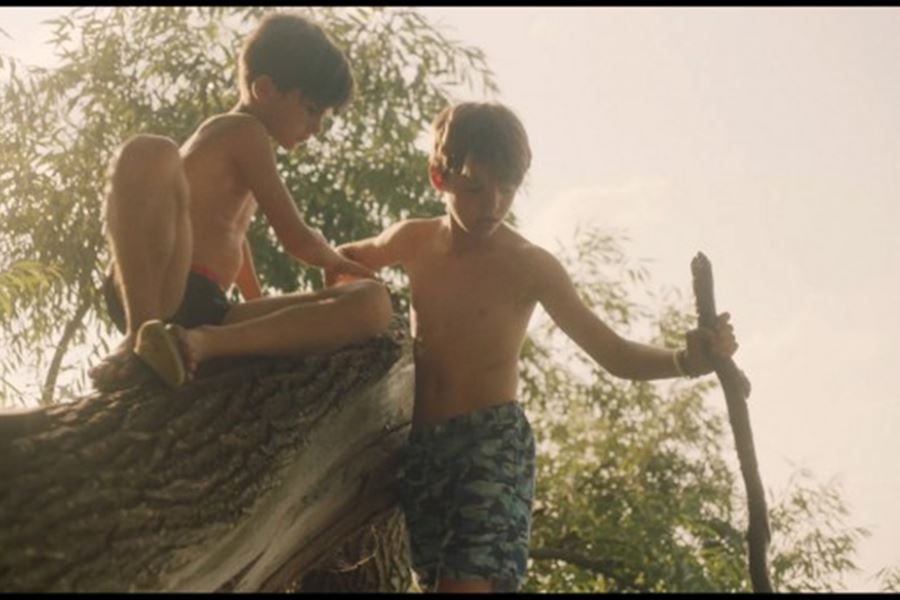
KRITIKA | Anatomie českého odpoledne nabízí „čecháčkovství“ v celé jeho kráse
Přestože měl student katedry režie pražské FAMU Adam Martinec úspěch již se svým debutovým krátkým filmem Cukr a sůl, až jeho absolventský „kraťas“ Anatomie českého odpoledne, vytvořený za pomoci Státního fondu kinematografie, mu přinesl ocenění Ceny české filmové kritiky nebo Českého lva. Pro svou druhotinu hledal inspiraci nejen v reálném příběhu, ale i v textech Bohumila Hrabala, který stejně jako Martinec, skvěle dokázal zachytit rysy české nátury.
Krnovský rodák zaujal již svým debutem z roku 2018 Cukr a sůl, který se promítal na festivalu v San Sebastianu a okouzlil i diváky v Karlových Varech. Snímek byl nominovaný na Českého lva v kategorii Cena Magnesia za nejlepší studentskou práci, tu však Martinec získal až se svým absolventským filmem bakalářského studia na FAMU Anatomie českého odpoledne, stejně jako historicky první cenu za nejlepší krátký film.
Podobně jako v předchozím snímku se i v Anatomii českého odpoledne autor zaobírá „normálními“ lidmi, kteří představují všechny možné stereotypy, jež si jen u Čechů dovedeme představit. Tentokrát se nicméně inspiroval skutečným příběhem dvou vietnamských chlapců, kteří se v roce 2018 utopili v jezeře Lhota kousek od Prahy. Média se kauzou zabývala především kvůli xenofobním obviněním vůči zaměstnancům areálu nebo jejich neochotě chlapce hledat.
Martinec příběh otevírá příjezdem manželského páru s dvěma chlapci do areálu neidentifikovaného koupaliště. Hned na úvod se setkáváme s nervózní a nevrlou pokladní Věrou, která nemá drobné, nebo návštěvníky, kteří se řídí heslem náš zákazník, náš pán. Byl by to další z obyčejných horkých letních dnů, kdyby se nezačali pohřešovat dva chlapci. Plavčík Jarda tak začíná hochy hledat, jenže bez úspěchu. Do toho na zaměstnance areálu pod vedením svérázného majitele Dalibora začínají tlačit rekreanti. Na místo přijíždějí hasiči a policisté a všichni netrpělivě čekají, kdy se děti najdou.
Ve filmu Martinec opět zkombinoval spojení profesionálních herců a neherců, čímž dodal snímku na autenticitě. Dosáhl toho ale především díky emotivním výkonům Jakuba Špalka v roli plavčíka a Simony Pekové jako pokladní, kteří dokázali diváka vtáhnout do děje i s pomocí velmi přirozených dialogů, ve kterých se autor nebojí ani vulgárních výrazů. Právě v dialozích tkví síla filmu.
Komickou stránku filmu vytváří hra se stereotypy, ve kterých může divák najít sám sebe nebo někoho ze svého okolí. Ať už je to stěžování na horko („Vedro jak v prdeli, já se potím jak zvíře.“) nebo dotazů manželek či partnerů, jestli něco nezapomněli doma.
Režisér stereotypy nevytváří jenom pomocí dialogů, ale i pomocí záběrů na jednotlivé postavy a jejich oblečení. Hlavní aktéři vypadají tak, jak si jen můžeme představit zaměstnance postsocialistického českého rekreačního areálu. Úsměvným upozorněním je detail na obuv návštěvníků cestou do areálu, které doprovází skladba Malá dáma od skupiny Kabát, jenž se řadí mezi populární hity rádií a „správných“ českých rockerů. Vždyť i s touto písni reprezentovali naši zemi v roce 2007 na Eurovizi. Kromě této dominantní skladby z úvodu ale hudba hraje jenom ilustrační roli a není výraznou součástí filmu.
Snímek poukazuje na typické „čecháčkovství“, kdy jenom kritizujeme, snahu ke změně ale nevynaložíme. Věta „Víte vy vůbec, že se vám tam ztratili nějaký dvě děti?“ je jenom malá sonda do způsobu jednání návštěvníků s vystresovanými zaměstnanci. Když ale evidentně zákazníka vyzvou, aby šel také pomoct s pátráním, odvětí jen nevěřícně: „Já bych je měl jít hledat?“ Právě prostřednictvím podobných dialogů odkrývá nezájem většiny lidí, kteří si ve snímku jenom chtěli odškrtnout položku o projevení zájmu.
Martinec si s divákem ale po celou dobu filmu jenom hraje. Jelikož snímek otevírá manželský pár s dvěma chlapci podobného věku jako jsou ti hledaní, předpokládáme, že se pohřešují právě tito chlapci. Navíc je v průběhu filmu vidíme, jak si hrají v areálu. Může se tedy zdát, že sledujeme cestu k neštěstí nebo naopak k veselému konci. Druhou možnost ale můžeme vyloučit v okamžiku, kdy chlapce hledá jiná žena, než jsme viděli na začátku...
Režiséru a scenáristovi Adamu Martincovi se opravdu povedla věrohodná sonda do české nátury. Jak autor prozradil, sám název snímku Anatomie českého odpoledne měl odkazovat na studii jednotlivých postav a rozpitvání jejích rozhodnutí. Vhled do jednání a pocitů se Martincovi podařilo dosáhnout skrze dialogy, a i vhodným výběrem klíčových situací. Sázka na stereotypy a jednání v kritických situacích se ukázala být šikovnou volbou, stejně jako inspirace skutečným příběhem, který měl široké mediální pokrytí. Autorovi se tak ocenění dostalo zaslouženě a můžeme se jenom těšit na jeho magisterský celovečerní film, kterým by nás měl zavést na „správnou“ českou zabijačku.
Země: Česká republika
Rok: 2020
Délka: 22 minut
Režie: Adam Martinec
Scénář: Adam Martinec
Kamera: David Hofmann
Produkce: Matěj Paclík
Hrají: Jakub Špalek, Simona Peková, Jiří Šeda, Matouš Borecký, Adam Kyznár

KRITIKA | Zachycení české nátury
Můžeme věřit v osud, ale ne až do takové míry, která by nás zbavila zodpovědnosti za náš vlastní život a jednání v něm. Naše chování by nemělo vycházet ze zažitých vzorců chování, za které bychom se později mohli schovat, nebo které by nás mohly dokonce omlouvat. Tím bychom vlastně mohli tvrdit: nad svým osudem ani životem nemám moc. Kde jsou tedy hranice v pojetí předurčenosti, jestli nějaké vůbec existují? S tímto tématem pracuje režisér Adam Martinec ve snímku Anatomie českého odpoledne, kde nám skrze charaktery postav ukazuje různé postoje k banálním situacím v kontrastu s tragickými.
Banalitu letního odpoledne u vody naruší ztráta dvou malých dětí. Výchozím bodem snímku jsou postoje jedinců k oné situaci. V moci postav nebylo situaci změnit, ale mohly změnit své chování a jednání. Adam Martinec na tomto snímku demonstruje svůj pohled na českou náturu a její chování: „Anatomie českého odpoledne je podle mě portrét češství. […] Hulvátství se dneska stává normou. To byl asi impuls, a že slušnost už není platidlem.“
Krátký studentský snímek Anatomie českého odpoledne Adama Martince byl oceněn Českým lvem, Cenou Magnesie za nejlepší studentský film, také uspěl na Cenách české filmové kritiky a v neposlední řadě vyhrál cenu v kategorii Nejlepší film na studentském festivalu FAMUFEST. Můžeme zaznamenat i jeho předchozí úspěch s krátkým filmem Cukr a sůl, který se rovněž objevil v nominacích za nejlepší studentský film.
Režisér snímku nám nabízí pohled třetí nezaujaté osoby, která může sama zhodnotit celou situaci. Pomalé jízdy kamery nejen umožňují přemýšlet o vykresleném češství na pozadí dramatické situace, ale také podněcují k nestrannému pozorování. Zároveň mohou vyvolávat až iritující pocity, a to především ve scénách, kdy by jen málo z nás jednalo s chladnou hlavou. Protagonisté se sice k vnějším okolnostem staví lhostejně, ale i přesto se nějakým způsobem niterně dotýká každého z nich. Můžeme si toho všimnout v posledním záběru při odchodu z koupaliště, která je v rozporu s úvodní sekvencí. Hádky mezi rodiči a ignorování dětí se změní v pochopení a starostlivost rodičů.
Martinec ve filmu Anatomie českého odpoledne dokázal perfektně pracovat se stupňováním napětí a vulgárního projevu. Ve filmu je kladen důraz na typické české buranství, naproti tomu k dětskému světu poznání a zvídavosti. České apatické povahy jsou pod vedením Adama Martince, spolu s perfektním zpracováním dialogů, divácky naprosto uvěřitelné. Kupříkladu hned v úvodní scéně, kdy se rodiče dvou malých dětí hádají o zapomenuté svačině nebo dialogy mezi zaměstnanci koupaliště a návštěvníky. Charaktery postav však nejsou nadsazené. K hlubší spekulaci nad pojetím filmu nás může přivést práce s kamerou. Svým plynutím připomíná proud života, který pozoruje neviditelná přítomnost diváka, jehož nezaujatý pohled na situaci dává filmu nový význam.
Anatomie českého odpoledne nabádá k přemýšlení o daru života. Film je plný protipólů, které jsou dobře známé nám všem z běžného života. Kontrast mezi životem a smrtí, lidským a božským, vlídností a neochotou. Navzdory všem úskalím je člověk schopen dojít k uvědomění, a to i ve chvíli, kdy je pouze apatickým pozorovatelem. Pasivní reakce ze strany přihlížejícího však neznamenají i pasivní pocity uvnitř něj. Ať už ve smyslu pozitivním nebo negativním.
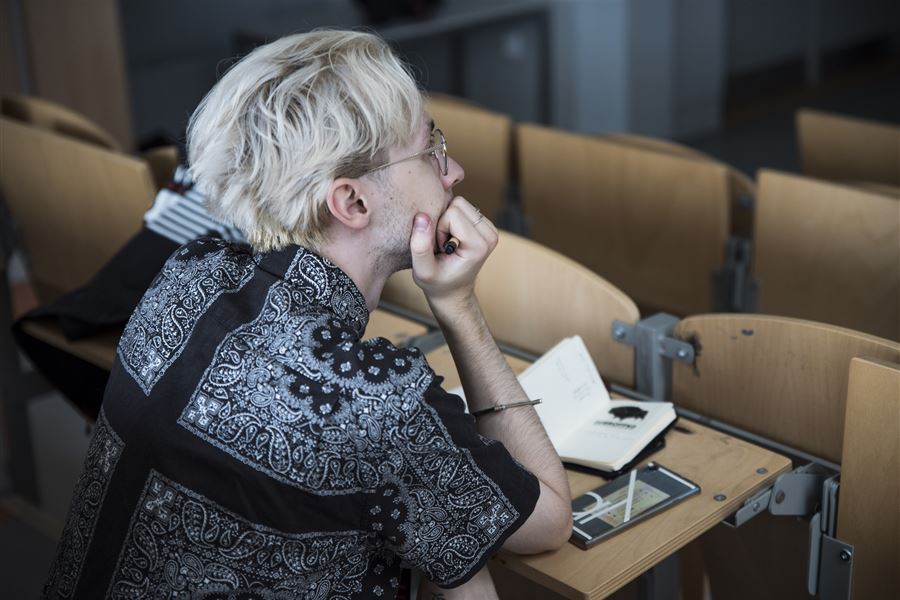
AKCE┃Jak napsat dobrou filmovou recenzi či kritiku?
Tvůrčí workshop pro přihlášené účastníky.
Jak napsat dobrou filmovou recenzi či kritiku? A jaký je mezi nimi vlastně rozdíl? Připravili jsme program během kterého si účastníci osvojí praktické nástroje a rady k úspěšné umělecké analýze.
Jak workshop probíhá?
Tvůrčí workshop probíhá zdarma online dne 25. 4. 2021. Pro účast na workshopu je nutné absolvovat čtyři masterclasses a úvodní debatu Co je to audiovize? v termínu 22.– 24. 4. 2021.
Co vás čeká?
Na konkrétních filmech si ukážeme, čeho se při psaní držet a čeho se vyvarovat. Následně si každý z účastníků zvolí vlastní dílo k recenzi a samostatně ho rozpracuje. Lektoři se vám budou věnovat i po skončení nedělního workshopu a pomohou dotáhnout texty do podoby, kterou publikujeme na webu Audiovizuální sauny a ve vybraných filmových online magazínech.
Lektoři
Klára Feikusová a Vojtěch Rynda
Registrace
Registrace byla uzavřena.
Dotazy
Případné dotazy směřujte na barbora@krutonfilm.cz.
Klára Feikusová
Klára získala magisterský titul v oborech Televizní a rozhlasová studia a Filmová studia na Univerzitě Palackého. Zde momentálně studuje v rámci doktorského programu, přičemž se zaměřuje na televizní studia. Odborně se zabývá cinematizací televize, televizní estetikou a konvergencí médií. Dále se zajímá o hororový žánr a reprezentaci minorit ve filmu a v televizi. Klára také spoluorganizuje sekci Hot TV na Letní filmové škole a v minulosti pracovala na festivalech Academia film Olomouc, Ozvěny Mezipater a další. Je redaktorkou online magazínu 25fps.
Vojtěch Rynda
Nepovažuje se za kritika, nýbrž za konzumenta a publicistu. Začal v minulém století psát o kultuře, protože tušil, že tak bude mít přístup k filmům a hudbě zdarma. Strávil řadu let na volné noze, kdy přispíval do Lidových novin, Reflexu, měsíčníku Time In, webu dokina.cz a v jednu dobu dokonce psal o filmu pro „protilehlé“ magazíny Elle i Maxim zároveň. Necelé tři roky působil v redakci Lidových novin, sedm let byl redaktorem časopisu Týden, kde několik let kulturní rubriku i vedl. Při hodnocení filmů je pro něj zásadní sledovat (ne)naplňování žánrových schémat a/nebo unikátnost autorské vize.
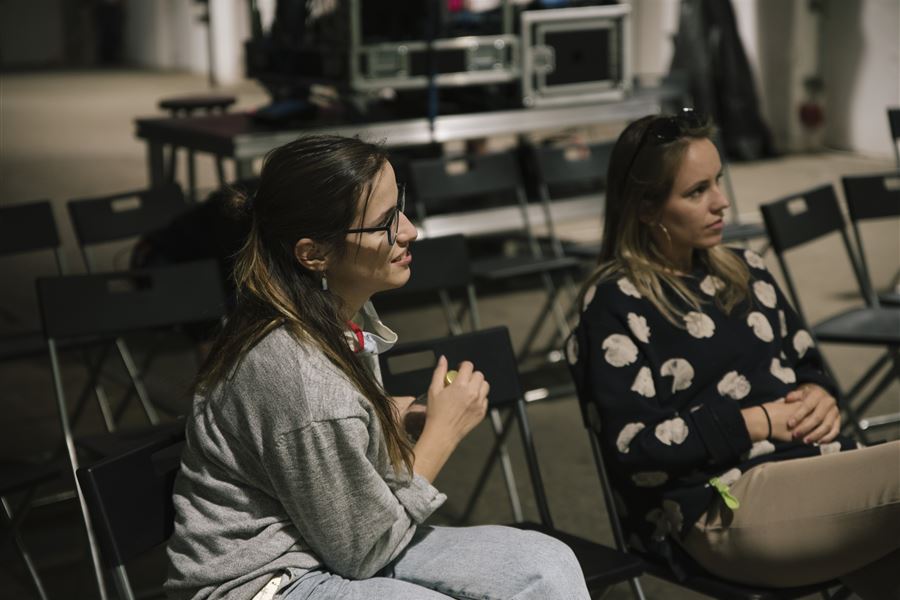
AKCE┃O experimentu v umění a kritice
Jak se psaní do filmového časopisu liší od psaní seminární práce nebo odborného textu? Masterclass Marie Meixnerové.
Ve vyčleněných 90 minutách pohovoří především o své praxi v časopise 25fps, na jehož chodu se podílí od roku 2008 (nejprve jako garantka rubriky Televizní formy /2009-2011/, nyní garantka rubriky věnované experimentálnímu filmu, novým médiím a audiovizuálnímu výtvarnému umění /2011-současnost/). O tom, jak funguje filmový časopis, co obnáší praxe editora, jazykového korektora, garanta konkrétní rubriky nebo překladatele. Také o tom, jak pro takový (nebo úplně jiný) časopis psát, jaké formáty textů nabízí, a praktické rady, jak k psaní textů přistupovat a čeho se vyvarovat.
SLEDUJTE ZDE!
Marie Meixnerová
Marie Meixnerová svou práci dělí mezi kurátorství, teorii, kritiku a vlastní tvorbu. Ve své badatelské i kurátorské činnosti se dlouhodobě zabývá komunikačními a interpretačními strategiemi internetového umění, dějinami a teorií pohyblivého obrazu a projevy animace v širším slova smyslu, zejména ve vztahu k digitálnímu umění nebo divákovi. Své teoretické i kritické výstupy pravidelně publikuje v rámci internetových platforem i odborných periodik či konferencí. Je kurátorkou Přehlídky filmové animace a současného umění – PAF Olomouc a prosazuje se i jako internetová a konceptuální umělkyně. Působí jako kurátorka ve ScreenSaverGallery, Galerii XY, Vitríně Deniska a Galerii Monitor. Zaštiťuje rubriku zaměřenou na experimentální film, nová média a výtvarné umění Filmového časopisu 25fps. Vyučuje kurátorství internetového umění v rámci teorie interaktivních médií na Filozofické fakultě Masarykovy univerzity v Brně a je vedoucí Galerie XY v Olomouci.

AKCE┃Jak psát o genderu, videu a o hudbě
Co nám může kritická analýza populární hudby říci o naší společnosti? Masterclass Anny Oravcové.
Co nám může kritická analýza populární hudby říci o naší společnosti? Masterclass Anny Oravcové.
SLEDUJTE ZDE!
Anna Oravcová
Anna Oravcová k hip hopu a rapu přistupuje ze všech možných stran a úhlů. Je organizátorkou akce Freestyle Mondays v Cross Clubu a soutěže End of the Weak a má svou vlastní show Street Cypher na Radiu SPIN 96,2. Také učí na University of New York in Prague a kulturu rapu a hip hopu reflektuje na akademické úrovni. Její výzkum i publicistická činnost se mimo jiné soustředí na genderový aspekt populární hudby a obraz žen v rapu i prosazování českých rapperek na scéně.

AKCE┃Jak psát o hrách nejen pro hráče
Jak souvisí Fortnite s proměnou sociálního života mladých lidí a co říká Cyberpunk 2077 o současné politice? Masterclass Ondřeje Trhoně.
Videoherní žurnalistika se u nás z největší části zaměřuje stále na čtenáře, pro které je hraní her významný koníček a součást identity. Videohry jsou dnes ale médium, které zasahuje do života všech. Podíváme se za hranice českého herního psaní, do médií, které se na hry dívají ve společenském kontextu - nejen jako kratochvíle nebo stroje za peníze. Ukážeme si tipy, jak psát herní kritiku tak, aby si ji přečetla i vaše babička - tedy pokud už Skyrim nehraje.
SLEDUJTE ZDE!
Ondřej Trhoň
Ondřej Trhoň je kulturní a převážně videoherní publicista, který dlouhodobě spolupracuje s Radiem Wave, filmovým měsíčníkem Cinepur, ČT Art nebo A2. Je šéfredaktorem literárního webu revue Prostor, přednáší na Studiích nových médií FF UK, podílí se na vývoji a marketingu videoher ve studiu Charles Games a vydává nezávislý časopis Dýpt.

AKCE┃Jak najít svůj tvůrčí styl?
O stylu filmově-kritického psaní. Masterclass Ondřeje Pavlíka.
Masterclass představí styl filmově-kritického psaní, který se zakládá na syntéze různých přístupů: analytického, interpretačního nebo impresionistického. Zároveň poukáže na důležitost, kterou kromě stylů a přístupů hraje kritikovo vlastní rozpoložení či naladění. Masterclass také poodhalí zákonitosti a zvyklosti filmově-kritické praxe vycházející ze zkušenosti s tuzemskými filmovými časopisy (Cinepur, Film a doba, A2) nebo rozhlasovými pořady (ČRo Vltava, Radio R).
SLEDUJTE ZDE!
Ondřej Pavlík
Ondřej Pavlík je filmový kritik a publicista. V současnosti působí jako doktorand na Ústavu filmu a audiovizuální kultury v Brně, kde se věnuje výzkumu české filmové kritiky v kontextu digitálních médií. Je redaktorem časopisu pro moderní cinefily Cinepur a externě spolupracuje s magazíny Film a doba nebo A2. Na platformě Substack provozuje svůj blog Tisíc a jeden film. Jako dramaturg spolupracuje s filmovými festivaly KVIFF či LFŠ.

AKCE┃Co je to audiovize?
Úvodní setkání hostů, kteří v dalších dnech povedou své masterclasses. Moderuje Pavel Sladký.
SLEDUJTE ZDE!
Pavel Sladký
Pavel Sladký je jedním z nejzkušenějších moderátorů a publicistů v českém filmovém světě. O literatuře a filmu píše pro Aktuálně.cz, Cinepur nebo Film a dobu. Jeho moderátorská kariéra je spojena především s Českým rozhlasem. Na Vltavě připravuje vybrané díly pořadu Akcent, dříve spolu s Šárkou Gmiterkovou vedl pořad Reflexe: Film! Na zpravodajských stanicích recenzuje filmové novinky, na ČRo Radio Wave vysílá magazín o cestování Casablanca. Spolupracuje jako lektor a moderátor besed a masterclasses s mnohými českými filmovými festivaly, např. s MFF Karlovy Vary, Letní filmovou školou, Ji.hlavou nebo projektem Cinergy. V současnosti stojí za podcastem filmového časopisu Film a doba a letos vydal knihu Film jsou tajné dveře do reality, která je úvodem do tvorby a základních témat deseti zásadních filmařek a filmařů současnosti.
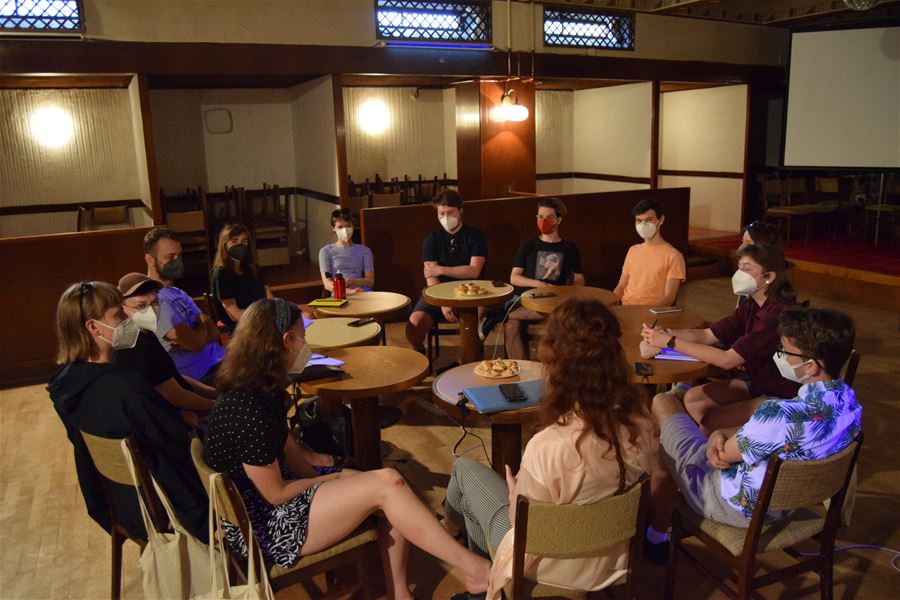
AKCE┃Workshop filmové kritiky
Uzavřený workshop filmové kritiky pro přihlášené účastníky.
Jak napsat kvalitní filmovou recenzi? Inspiruj se přednáškou o poťouchlé kritice, vytvoř si vlastní kritické alter ego a v jeho duchu vytvoř stylizovaný text. Anebo právě naopak seriózní akademickou kritiku. Procesem vás provede přední česká kulturní publicistka Táňa Zabloudilová.
Co Tě čeká?
Workshop Ti poskytne praktické nástroje a rady k úspěšné tvorbě umělecké kritiky. Na konkrétních příkladech si společně ukážeme, čeho se držet a čeho se vyvarovat. Lektorka se Tvému textu bude věnovat i po skončení nedělního workshopu a pomůže ti ho dotáhnout do finální podoby, kterou budeme publikovat na webu Audiovizuální sauny a ve vybraných filmových online magazínech.
Jak se zapojit?
Workshop je určen omezenému počtu účastníků a je nutné se na něj předem registrovat. Pro všechny přihlášené je povinná účast na celém programu Audiovizuální sauny (tedy na přednášce i obou debatách).
Registrace
Registrace byla uzavřena.
Dotazy
Případné dotazy směřuj na jana@krutonfilm.cz.
Táňa Zabloudilová
Táňa Zabloudilová patří mezi přední české televizní publicisty. V současné době působí jako dramaturgyně brněnského festivalu Serial Killer a podcastová dramaturgyně Českého rozhlasu (podcast Moje terapie a Moje terapie II). Zároveň přispívá do řady médií, mimo jiné do Aktuálně.cz, Artzóny nebo Finmagu. Je také moderátorkou a redaktorkou internetového deníku Alarm.cz, kde se kromě recenzí televizní tvorby věnuje také tématům bydlení a urbanismu.
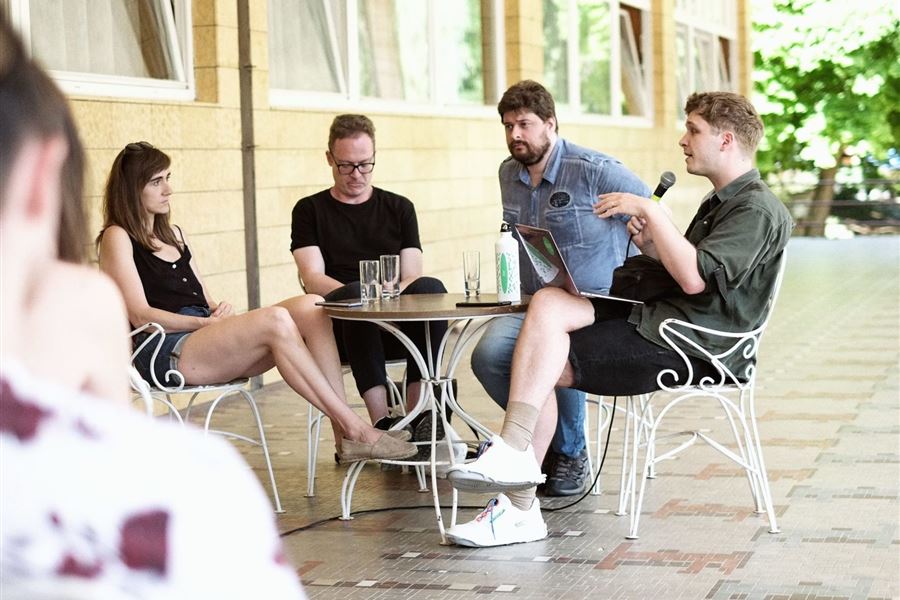
AKCE┃Film jsem zatím neviděl, ale dávám odpad
Debata o rozdílech mezi recenzemi filmových fanoušků a kritikami profesionálních publicistů.
Jak se liší pohledy kritiků a fanoušků na kinematografickou kvalitu? Jak se podle nich pozná dobrý film a jaká kritéria jim přijdou podstatná při jeho hodnocení? Stírá dnešní doba rozdíl mezi oběma přístupy? A mohou se navzájem obohatit?
Podobnými otázkami se bude zabývat debata mezi profesionálními kritiky Ondřejem Pavlíkem (Cinepur, A2) a Táňou Zabloudilovou (Český rozhlas, A2larm, Aktuálně.cz, Artzóna a další) a vedoucím fanouškovského popkulturního portálu NerdFix Markem Čabákem. Moderuje Vít Svoboda.
SLEDUJTE ZDE!
Ondřej Pavlík
Ondřej Pavlík je filmový kritik a publicista. V současnosti působí jako doktorand na Ústavu filmu a audiovizuální kultury v Brně, kde se věnuje výzkumu české filmové kritiky v kontextu digitálních médií. Je redaktorem časopisu pro moderní cinefily Cinepur a externě spolupracuje s magazíny Film a doba nebo A2. Na platformě Substack provozuje svůj blog Tisíc a jeden film. Jako dramaturg spolupracuje s filmovými festivaly KVIFF či LFŠ.
Táňa Zabloudilová
Táňa Zabloudilová patří mezi přední české televizní publicisty. V současné době působí jako dramaturgyně brněnského festivalu Serial Killer a podcastová dramaturgyně Českého rozhlasu (podcast Moje terapie a Moje terapie II). Zároveň přispívá do řady médií, mimo jiné do Aktuálně.cz, Artzóny nebo Finmagu. Je také moderátorkou a redaktorkou internetového deníku Alarm.cz, kde se kromě recenzí televizní tvorby věnuje také tématům bydlení a urbanismu.
Marek Čabák
Slovenský internetový publicista a šéfredaktor geekovského serveru Nerdfix.cz se podílí také na herním pořadu Indian. Dlouhodobě se zabývá herní žurnalistikou a popkulturou - filmy, seriály, žánrovými knihami i komiksy.
Vít Svoboda
Vít Svoboda působí jako moderátor a redaktor na Radiu Wave a píše pro zpravodajský web iRozhlas.cz. Jeho hlas můžete znát z podcastů Vize z krize, Karaoke nebo třeba z dokumentárně-reportážní série Po sametu, který se věnoval příběhům, jež v posledních třiceti letech formovaly naši společnost. Má rád halušky a koledy.
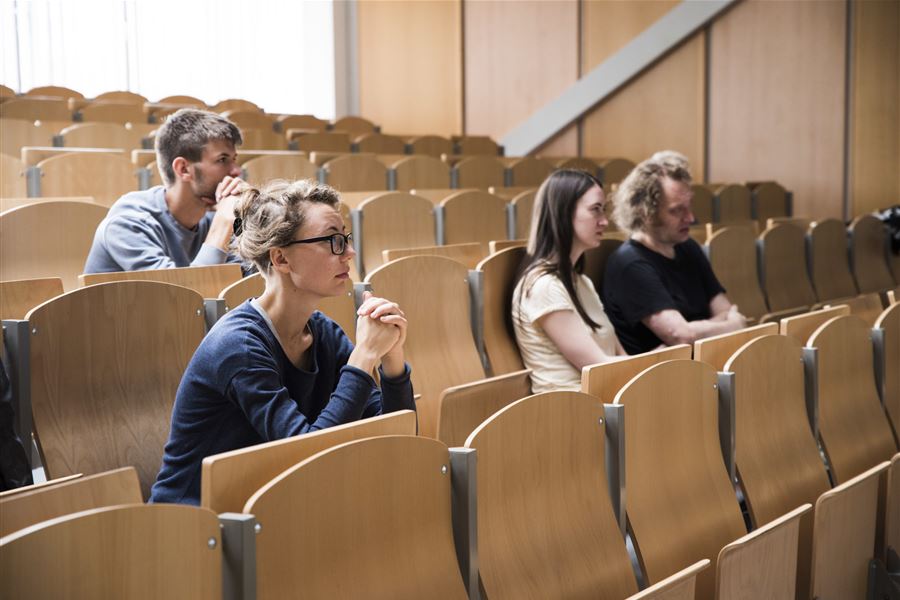
AKCE┃Poťouchlost v české filmové kritice
Přednáška filmového kritika Ondřeje Pavlíka o specifickém žánru "poťouchlé kritiky."
Co mají společného nechvalně proslulý uživatel verbal z ČSFD a moderátoři rozhlasového pořadu Čelisti? A co to znamená, když o filmové reflexi řekneme, že je poťouchlá? V přednášce se zaměříme na jeden z nejvýraznějších rétorických stylů současné české filmové kritiky, který je okázale performativní, výstřední a groteskně komediální. A přestože se jeho představitelé prezentují jako výrazné a nenapodobitelné individuality, ve skutečnosti mají překvapivě mnoho společného.
Přednáška Ondřeje Pavlíka nastíní charakteristické rysy poťouchlé kritiky a vysvětlí, kde se vzala a proč se jí tak dobře daří právě v podmínkách dnešní digitální éry. Mimo jiné tak vyjde najevo, že ačkoli se poťouchlí kritici často vymezují vůči jakékoli normalitě, ve skutečnosti dokonale ztělesňují principy pozdně kapitalistického mediálního provozu a jsou jejich excesivním sebereflexivním odrazem.
SLEDUJTE ZDE!
Ondřej Pavlík
Ondřej Pavlík je filmový kritik a publicista. V současnosti působí jako doktorand na Ústavu filmu a audiovizuální kultury v Brně, kde se věnuje výzkumu české filmové kritiky v kontextu digitálních médií. Je redaktorem časopisu pro moderní cinefily Cinepur a externě spolupracuje s magazíny Film a doba nebo A2. Na platformě Substack provozuje svůj blog Tisíc a jeden film. Jako dramaturg spolupracuje s filmovými festivaly KVIFF či LFŠ.

AKCE┃Proč hodnotíme umění?
Jaký smysl mají ceny v umění? A blíží se jejich konec? Debata kurátorky a teoretičky umění Evy Skopalové s hudebním publicistou Karlem Veselým.
Eva Skopalová
Eva Skopalová je kurátorka a teoretička výtvarného umění. Vystudovala dějiny umění na Filozofické fakultě Univerzity Karlovy a teorii a historii moderního a současného umění na UMPRUM v Praze. Absolvovala také stipendijní pobyty na L‘École des hautes études en sciences sociales v Paříži a na Newyorské univerzitě. Věnuje se metodologii dějin umění, zabývá se především problematikou nelineárního času, jehož perspektivy ohledává skrze výstavy i výtvarnou kritiku. Od letošního roku působí jako předsedkyně Ceny Věry Jirousové, určené jak začínajícím, tak již etablovaným kritičkám a kritikům výtvarného umění.
Karel Veselý
Karel veselý je hudební publicista a autor či spoluautor několika úspěšných publikací. Absolvoval obor anglistika a filozofie na Filozofické fakultě Masarykovy Univerzity a pracoval jako učitel a překladatel. Spolupracuje s Radiem Wave, působí v redakci časopisu Full Moon, píše pro A2, Salon Práva nebo online portály A2larm a Aktualne.cz. Mimo jiné vydal knihu mapující dějiny afroamerické hudební tvorby Hudba ohně, mystifikační román Bomba Funk a podílel se na knihách Planeta Nippon, Kmeny nebo Made in Japan. V loňském roce publikoval společně s Milošem Hrochem knihu Všechny kočky jsou šedé, zabývající se paralelními dějinami populární hudby.

Červnová Audiovizuální sauna
Druhá edice Audiovizuální sauny se uskutečnila během posledního červnového víkendu v rámci multižánrového festivalu Luhovaný Vincent v Luhačovicích.
V duchu našeho hesla Čteš to po sobě?! jsme si s našimi účastníky, hostkami a hosty povídali o kritickém myšlení a psaní nejen o filmu nebo o vývoji umělecké kritiky v době internetové. A ve třech dnech zalitých sluncem jsme toho viděli opravdu mnoho!
Program červnové Audiovizuální sauny otevřela páteční debata s názvem Proč hodnotíme umění?, ve které kurátorka a teoretička umění Eva Skopalová a hudební publicista a autor několika úspěšných publikací Karel Veselý diskutovali o proměňujícím se významu uměleckých cen. Oba hosté, kteří se sami aktivně podílejí na udílení cen, se shodli, že konkurenční prostředí umění nijak zvlášť nesvědčí - přesto však mají různá ocenění pro tvůrce často zásadní význam.
Sledovat Proč hodnotíme umění?
V sobotní přednášce Ondřeje Pavlíka nazvané Poťouchlost v české filmové kritice představil filmový publicista a doktorand brněnského Ústavu filmu a audiovizuální kultury svůj výzkum na téma české filmové kritiky v kontextu digitálních médií. Dozvěděli jsme se mimo jiné odkud vyvěrá současný trend silně performativní a nekorektní kritiky, který se přelévá z internetových fór do veřejného prostoru, a jakou roli v něm hraje krize maskulinity.
Sledovat Poťouchlost v české filmové kritice.
Odpoledne se téma rozdílů mezi fanouškovskou a “seriózní” kritikou přeneslo do debaty s titulem Film jsem neviděl, ale dávám odpad, ve které Ondřej Pavlík spolu s kulturní publicistkou Táňou Zabloudilovou a šéfredaktorem serveru NerdFix Markem Čabákem porovnávali své názory na stav současné kritiky, existenci objektivity, a užitečnost “lidového hlasu,” posuzujícího filmy na internetových fórech. Oběma debatami provázel moderátor Vít Svoboda.
Sledovat Film jsem neviděl, ale dávám odpad.
Program završil nedělní Workshop filmové kritiky vedený Táňou Zabloudilovou. V něm dvanáct účastníků Audiovizuální sauny spolu s lektorkou diskutovali o svém vztahu k umělecké kritice, svých zkušenostech s psaním o filmu a o možnostech i bariérách, se kterými se na své cestě potkávají. Každý z účastníků také pod vedením lektorky pracuje na tvorbě vlastní umělecké kritiky, kterou budeme publikovat na našem webu a ve vybraných online filmových magazínech.
Skvělého zázemí se nám dostalo v Luhačovicích na přátelském a inspirativním festivalu LUHOvaný Vincent! Moc děkujeme našim hostům, účastníkům i organizátorům festivalu a přinášíme několik fotek z místa činu.
!!! Třetí Audiovizuální sauna, která se uskuteční na festivalu ELBE DOCK na konci září 2021, už je v procesu příprav. Budeme se na vás těšit !!!

Some new article
Event, qui blatenimil mi, omnimpe riaspid eribus, voleste officia ecest, eum fuga. Ut voluptate expelesci blature intiber iamusani volorio. Ipientiberum sant. Ad eum volenturit endictur molo et rehendam, omnitate veles eatinvel eum faccabo. Nequate coribus in pore nectem fuga. Cum laborendi re nimi, cusandamus inctae. Genturia iusam eserest ad quam, sunt et rent, cuptatquam eiur, quibus.
Bus int aut magnisquo beatempor aliqui dolori denis solorio. Oreptatium volorit eturi dolor aut dolupta cor simagna tectio commolo ritestrum re vernatem. Por a nonse nis ilictat. Perum laut utatium elenecte volupta invelest odi volorem porecae quia conseribus volupta aspit essitas sequatem eatia deruptatis excest essectint eum invene simus delestis sincto maio. Unte andandi utature comniatur? Qui qui sam inventem que que pelicium anit as reicae sunt.
sdgsdgdfgdfg


Přečti si co napsali účastníci workshopu o oceňovaném filmu Anatomie českého odpoledne
Event, qui blatenimil mi, omnimpe riaspid eribus, voleste officia ecest, eum fuga. Ut voluptate expelesci blature intiber iamusani volorio. Ipientiberum sant. Ad eum volenturit endictur molo et rehendam, omnitate veles eatinvel eum faccabo. Nequate coribus in pore nectem fuga. Cum laborendi re nimi, cusandamus inctae. Genturia iusam eserest ad quam, sunt et rent, cuptatquam eiur, quibus.
Bus int aut magnisquo beatempor aliqui dolori denis solorio. Oreptatium volorit eturi dolor aut dolupta cor simagna tectio commolo ritestrum re vernatem. Por a nonse nis ilictat. Perum laut utatium elenecte volupta invelest odi volorem porecae quia conseribus volupta aspit essitas sequatem eatia deruptatis excest essectint eum invene simus delestis sincto maio. Unte andandi utature comniatur? Qui qui sam inventem que que pelicium anit as reicae sunt.
Popisek fotky
Nequate coribus in pore nectem fuga. Cum laborendi re nimi, cusandamus inctae. Genturia iusam eserest ad quam, sunt et rent, cuptatquam eiur, quibus.
Bus int aut magnisquo beatempor aliqui dolori denis solorio. Oreptatium volorit eturi dolor aut dolupta cor simagna tectio commolo ritestrum re vernatem. Por a nonse nis ilictat.
00.00.2021
Tomáš Holeš
65 min.
veškerý text, kretý zde chcete mít



